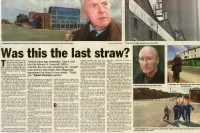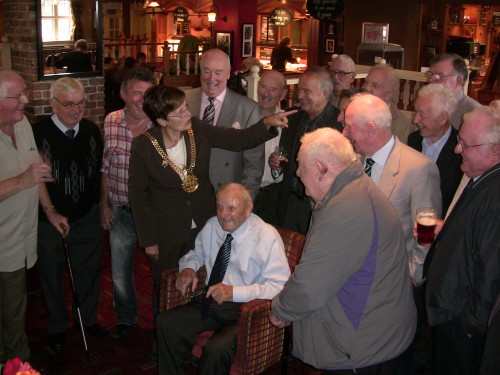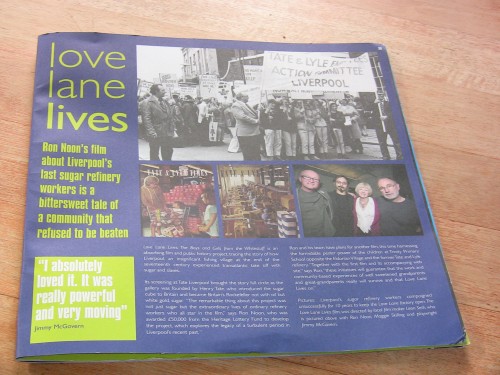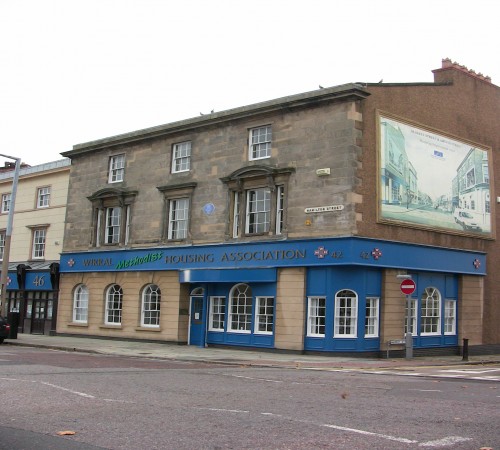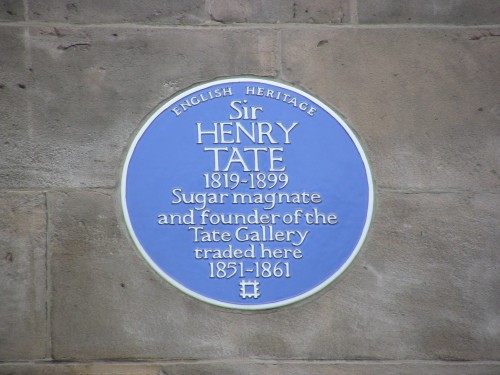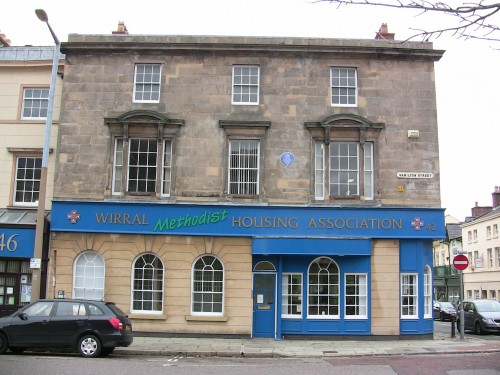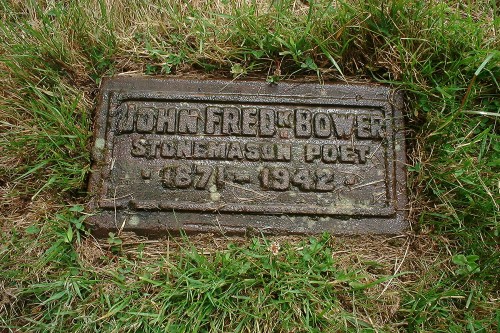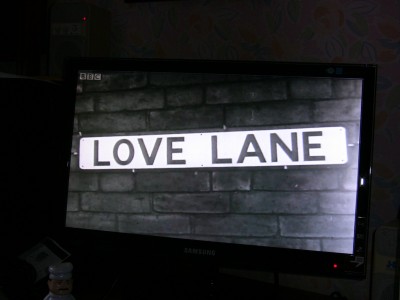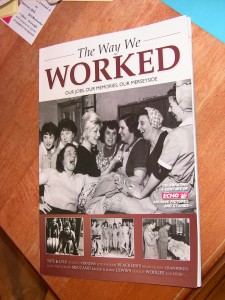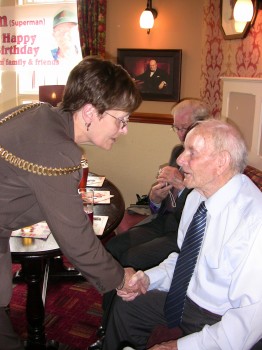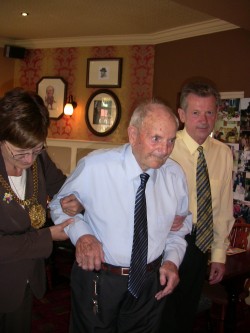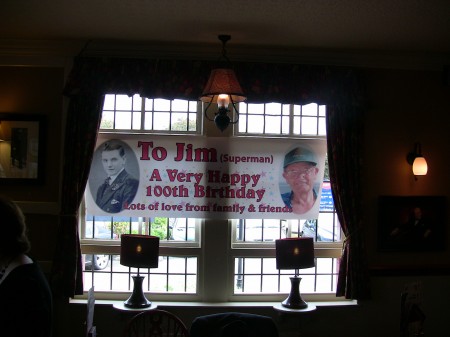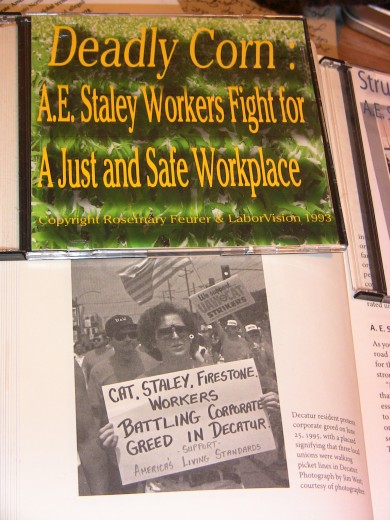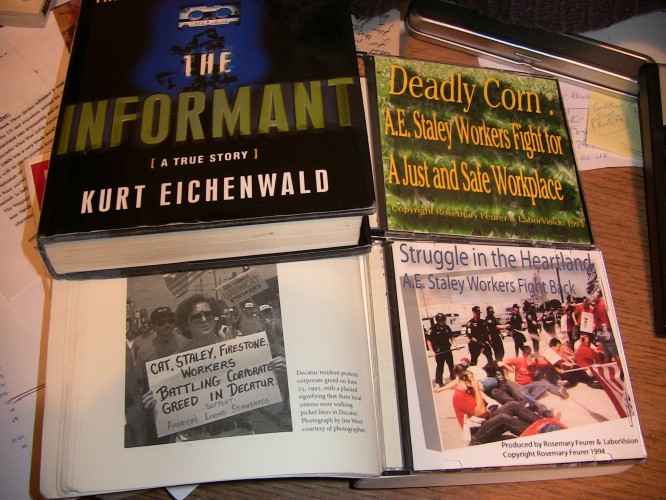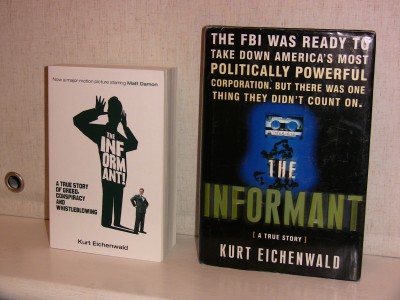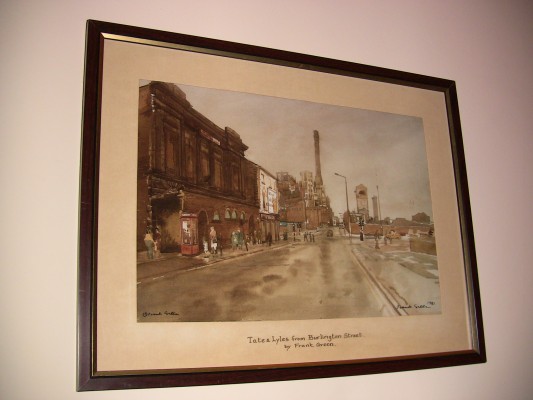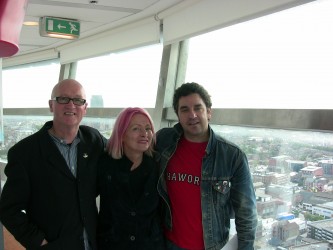Love Lane Lives
The history of sugar in Liverpool and the effects of the closure of the Tate & Lyle sugar refinery, Love Lane
20 years ago today was 8th June 2001: I’d written this ESSAY for a SUMMER SCHOOL
Written by Ron Noon at 09:54 on Tuesday, June 08th 2021
The Boys and Girls from the Whitestuff
“I have come to the conclusion that there is nothing economically rational about the sugar business.” J.B.Bunker (President of the Holly Sugar Corporation. 27.2.1978.)
This is a bitter sweet story stretching back at least six hundred years and traversing strange latitudes and thousands of miles. From Liverpool, the former eighteenth century slave capital, and 19 home of the Beatles, across the Atlantic to Decatur Illinois, a sleepy mid west town 175 miles south of the Windy City and original home of the Chicago Bears, the sugar chain extends due east back to Spike Lee’s hometown in Brooklyn, New York. The skeins of interconnectedness in this chronicle of globalisation are very much associated with sucrose, a simple taken for granted commodity with an infamous history, lucidly indicted in 1944 by the Oxford scholar and former Prime Minister of Trinidad, Dr Eric Williams. “Strange that an article so sweet and necessary for human existence should have occasioned such crimes and bloodshed.”
The terrifying images of transatlantic trade in human cargo and the African diaspora that decanted millions to the New World provide cruel evidence of slavery as the indispensable handmaid of the sugar industry. This together with proof of Liverpool’s lubricating role as a “slave city first”, is a potent reminder of the politics and power of sugar, a far from “natural” product, that the industry are loath to admit, mankind was able to do without for millennia. The Bible was a land of milk and honey not sugar and spice but subsequently there has been no other food which has rivalled this simple carbohydrate, (C12 H22 011) “in its influence on human affairs”. To the “food faddists” it is an “empty calorie” and “granulated scourge”, not the “crystallised sunlight” of photosynthesis and school misinformation packs. For me it is the most telling metaphor for capitalism and capitalist commodity production and Cuban anthropologist Fernando Ortez aptly described it in 1947 as “capitalism’s favoured child”.
Nature was patently unaware of commerce when Columbus on his second Antilles voyage in 1493 transferred sugar cane from the Portuguese islands off the coast of Africa to the Island of Hispaniola, now divided into Haiti and the Dominican Republic. What is perceived in the travel brochures depicting the Greater and Lesser Antilles as indigenous flora and fauna was five hundred years earlier distinctively novel. The French food writer Maguelonne Toussaint-Samat in evoking Turgenev’s “genius of hunger”, reminds us that “the practice of hunting and gathering, the consumption of salt and cereals, the discovery of stock breeding and wine, the use of spices, sugar, potatoes, proteins, have all been stages along the way, each in turn shaking the known world to its foundations”. In that se marks the beginnings of Europe as “the monstrous shaper of world history”, with aggressive colonial expansion and global movements of people, plants and diseases to configure the following centuries.
Columbus’s epochal inauguration of sugar cane time and “the sugar standard”, rocked that new world so much that by the late seventeenth century the Dutch found it hard to resist the lure of “white gold” in Surinam in South America, and negotiated with the English Duke of York, stewardship over what is now the most expensive real estate in the Cosmos. It was obviously a commodity worth fighting over and in 1763 following the 7 Years War Britain negotiated a Peace Treaty that came glaringly close to repeating the earlier Dutch mistake with its initial preference for the French sugar islands of Guadeloupe and Martinique over the whole of what is now Canada! How many picketing Domino refinery workers earlier on this year with strike funds and accident cover dwindling, would have had the appetite for such historical reflexivity, as the bitter winds from the East River smacked into their marrow, and life continued pretty much as usual over the Williamsburg Bridge in the big sugar cube of old New Amsterdam?
The main commercial source for the European and North American sugar refineries before the nineteenth century and Napoleon’s sponsorship of the ugly mangel wurzel sugar beet, was the majestic sugar cane, a reed which the Greek naturalist, Pliny the Elder claimed “produced honey without the intervention of the bees”! No bees but millions of Africans were needed in the Americas to cultivate this quintessential slave crop and agri-business. It far exceeded other exotic tropical produce such as coffee, tobacco and cotton in the rigours of its cultivation and even today as the tall and aesthetically pleasing reed sways in the tropical breezes, it is described as a backbreaking “hunger crop”, emblematic of the plight of many Third world countries. It is not much use in its “natural” state, and the industrial demands of rapidly milling and processing the cane into raw sugar has been a predominantly third world activity before shipment to Metropolitan port refineries for the final high value added processes. These refineries are the “temples of applied science” sponsored by capitalism’s profitable synthesis of machine and man rather than nature’s photosynthesising laboratories.
Now in its seventh century of global expansion and in its indirect uses very much part of the “natural” architecture of processed and fast foods, sugar makes the products of Bill Gates seem pre-pubescent. In the twenty first century it is obviously not the only kid on the sugar and sweetener block, but perhaps miserably from the perspective of a new breed of anti-saccharites and “sugar busters”, most people think the only thing that matters about sugar and sweeteners, is that they taste sweet. Sweetness is the last thing that can be said about its history and the industry that produces not only sugar but its first main biotech breakthrough, High Fructose Corn Syrup, widely used in the lucrative soft drinks market. Nor does syrupiness explain the aggressive human resources management of global sugar giant, Tate & Lyle. In June 1993, it locked out 760 of its employees in Decatur in a dispute which lasted thirty months but achieved company objectives of “downsizing” the union and re-scheduling work shifts to conform to the company calendar rather than the more natural work rhythms that had made family and social life predictable. More recently at the 143 year old Brooklyn refinery, there in the shadow of the Williamsburg Bridge, a twenty month battle with the union was initiated by management demands to lay off 100 workers and sub-contract work and ended in March this year with defeat for the strikers.
The London based transnational was founded in Liverpool by Henry Tate a wealthy nineteenth century entrepreneur and philanthropist, sixty five years after Britain abandoned the Slave Trade. It operates in five continents and over fifty countries and first broke into the profitably protected North American sugar market with a leveraged buy out of the Decatur based corn syrup producer A.E.Staley in 1988. The fact that the Chicago Bears started out as a company sponsored team named the Decatur Staleys, coached by the legendary George Halas was less important than HFCS. The subsequent acquisitions made by “Tates” (the term of endearment/estrangement to its former Liverpool workers) included Domino Sugar, (cane) and until recent sales and divestments, Great Western, (beet). The company have manifestly undergone a corporate transplant from the paternalistic days of yore. From rationalisation and closure of their mother plant in Liverpool Love Lane in 1981 when significantly there was neither a Tate nor a Lyle on the board, to “downsizing” in the “War Zone” of Decatur and strike breaking in New York, Tates has belied not only that anodyne adjective, sweet, but its once proudly held reputation as an exemplary family firm. Generations of former employees perceived it as deliberately encouraging a friendly “company spirit” and viewed it as “a good firm to work for”.
The act of matricide in the love starved Lane was hardly the best cue for evoking late eighteenth century images of Liverpool’s “maidens and ladies” perambulating down a country walk overlooking stunning views of the Mersey, the Welsh mountains and sailing ships going in and out of the river except to reflect on the recurring theme of exploitation and how it was slave tainted produce, that unbeknown to those ladies filled the holds of the ships they viewed on their afternoon walks. Henry Tate’s sugar dynasty was founded long after the end of the slave trade and his philanthropy and dedication to the arts is some indicator of a paternalistic reputation which survived vicariously even after the end of sugar cane time in 1981. The company at least ensured that there was a Christmas Party for the Tates pensioners held in Liverpool’s Britannia Adelphi Hotel, initially each year but then “biennially”, agreeably catering for the associational needs and seasonal festivities of the old boys and girls from the whitestuff.
Unhappily at the end of last Millennium the ex-refinery workers, many of whom never secured another job when the prominent Liverpool landmark was pulled down, were delivered the devastating news that “because of the need to continually review and reduce costs”, the bunting and streamers that were going up in the hotels magnificent banqueting hall, would sadly commemorate the last ever company sponsored Christmas party. December 2nd 1999 was the former Tates employees last supper and the sadness of the occasion was visibly reflected in the comments made to local reporters. This is no ordinary local history because Liverpool as a port city has been a barometer since the eighteenth century, of national and international trends, playing a central role in that earlier phase of European mercantile expansion that generated the displacement and scattering of millions of brutalised Africans. Social relations and decision making have never stopped at the Pier Head and Liverpool’s economic reach was emphatically global a couple of hundred years before the “isation” was tagged on to the G word.
Part of the identity legacy of Henry Tate the former grocer and populari of sugar cubes is not just the company that bears his name but impressive artefacts of his private philanthropy. In Liverpool he left an imposing Unitarian Church in Ullet Road, a former hospital in the city centre called the Hanneman building and the striking red brick of Liverpool University’s Tate Hall. (A university built on sugar?) In London he financed an impressive public library in Brixton and more famously inspired the Tate Gallery and Tate Modern which interpolate his donations to the arts and culture. Part of his bequeathal, albeit unintentional is sadly a scrooge like and soulless global corporation. In the absence of ghostly interviewing techniques I can only hazard the suggestion that the meanness of spirit which resulted in the junking of Christmas in his former sugar capital, and recent trade union bashing in the economic capital of the free world, has caused the creator of this formidable sugar dynasty to turn in his grave.
Five hundred yards up from the impressive Liverpool waterfront is the splendid town hall whose corridors are still adorned by busts of blackamoors and elephants. It was built in the late eighteenth century when powerful slave trade interests were coming up against popular agitation to end the evil trade. “Beyond doubt it was the slave trade which raised Liverpool from a struggling port to one of the richest and most prosperous trading centres in the world.” That comment by historian Ramsay Muir and extracts from an Election pamphlet in 1790, sum up the influence and command of the slave trade interest. “If you have any regard for your God; If you have any regard for your King; If you have any regard for your country; If you have any regard for your native town and its prosperity…Vote for General Tarleton who so ably supported the African trade and the commercial interests of Liverpool…The Church and Slave Trade forever.” A few years later a drunken actor was cruelly booed by an audience of rich merchants inside Liverpool’s Theatre Royal. George Cooke’s response as he coruscated off stage, was scathing. “I have not come here to be insulted by a set of wretches, every brick of whose infernal town is cemented with an African’s blood.” In Britain’s “Gateway to Empire”, and richest of nineteenth century provincial cities, it is chastening to reflect that with one of the oldest indigenous black populations in Britain, it is not just thespian echoes that resonate in its outstanding civic buildings.
Liverpool’s infamous history as the capital of the slave trade may have belatedly been addressed but twenty years after the disturbances and riots that erupted in Lodge Lane and Liverpool 8 in July 1981, Black people’s long standing inequality in this city has still to be positively remedied. Students, including a large number of African American students attending Liverpool University’s three week Summer School on Liverpool’s Black roots, will have opportunities this June to plug the past into the present and debate these issues and the legacy of slavery. They will experience a powerful evocation of that infamous trade by visiting the Transatlantic Slave Gallery down at the Albert Dock, adjacent to the Museum of Liverpool Life and the Tate Gallery. Significantly the benefactor’s name provides a reminder, twenty years after the closure of Love Lane, that there are skeletons in the company cupboard which demand more forensic examination than provided here. The sugar links stretching across from Love Lane and Lodge Lane to the Workers Memorial Viaduct in Decatur and the Willamsburg Bridge, New York, provide evidence for a reality check on “Tate & Lyle in the Community” and the Pensioners corporate campaign to bring back Christmas for December 2001. Bob Bannister one of the pensioners asked “would it spoil some vast eternal plan if these Christmas get-togethers were to continue every two years, after all in ten or fifteen years most of us will have left for greener pastures”?
Planters in the AnteBellum South once used the threat of deportation to Cuba as an instrument for disciplining their slaves and although to some it may appear hyperbolic, one of the course themes at the Summer School was influenced by a saying used by planters in Cuba which almost transcends metaphor and figurative language. “Con, sange, se hace azucar.” Sugar has been made with blood, and it has been shed in a variety of different and protracted ways, even in rich first world countries. In Liverpool, Decatur, and even in the Big Sugar Cube of New York, the damage to the health and safety and general morale of “sugar workers” caused by rationalisations, downsizing, union busting and “lean production” methods, has devastated families and communities. Nevertheless it is Third world producers who are more systematically and regularly short changed.
Twenty years ago, when the European Community put forward proposals to cut the structural sugar beet surplus they were opposed by Margaret Thatchers Government, and the writing was clearly on the wall for Love Lane, Henry Tate’s spiritual home. The city which was renowned for the Merseybeat in the 60s was the victim of the sugar beet and a soulless global corporation with no apparent local loyalties. The community blight and lengthening dole queue in Liverpool was not unrelated to the riots and disturbances a few months later but even this was eclipsed by the exacerbation of abject poverty and hunger in the Third World cane producing countries. The World Development Movement presciently summed up what is still very much the issue today. “A rich country’s sugar policy – who it buys its sugar from and how it pays for it - is a vital litmus test of its proclaimed benevolence towards the poor world.” Precisely but the reality is a continuing pattern of dependency and neo-colonial relations manifesting itself in the sweat and blood of “half slaves” and migrant labourers, cultivating sugar cane in parts of the Caribbean and South America today. What a chastening reminder this ought to be of how a unique commodity demands more than just history lessons.
Ron Noon 8.6.2001
I had a NERVE!
Written by Ron Noon at 13:07 on Friday, April 30th 2021
90 days of Sweet FA?
(When Ron Noon started his research about Liverpool’s sugar refinery workers, the only thing that mattered about sugar was that it was sweet. But that is the last thing to be said about the history of the ‘white stuff’.)
At the beginning of this year, a history teacher sent Tate & Lyle a 90-day redundancy party letter! It noted that ‘next Sunday, January 22nd, will be the 25th anniversary of the issuing of 90 day redundancy notices to 1500 refinery workers at Henry Tate’s mother plant in Liverpool’s Love Lane’.The teacher claimed that his brief went ‘beyond historical themes’ and made ‘a request on behalf of the Tate’s Liverpool pensioners, the late Peter Leacy, Tony McGann of the Eldonians, Alan Bleasdale, Jimmy McGovern, Brian Reade, Jack Jones, and Tony Benn, that Tate & Lyle plc finance a reunion of the former Love Lane employees, either on or close to April 22nd, the fateful day a quarter of a century ago when after 109 years of operation on the romantically named site, sugar cane time came to an abrupt end in Liverpool’.
Some big names were on that letter, but how many of them were aware that this simple taken for granted everyday commodity was, according to Cuban anthropologist, Fernando Ortiz, “capitalism’s favoured child”?
Sugar has a long and terrible history, including the striking chapter in which an insignificant fishing village - eclipsed for centuries by neighbouring Chester - was dramatically re-awakened by ‘sugar and slaves’: by exotic tropical cane from Barbados and the African slaves used to supply Europe’s seemingly insatiable appetite for sweetness. Mankind did without it for millennia because there is no biological need for an achingly addictive fix in pure sucrose form. Market driven societies nurture want rather than need and wealth not health has been the driver behind the story of Capitalism and its sweet-toothed child.
Sugar is now into its sixth century of global expansion, and in this new millennium, non-food uses such as bio-fuel, the ‘energy cane’ or ethanol used to drive cars in Brazil. could make the products of Bill Gates seem pre-pubescent.
The letter did not go into detail about that infamous trade, emphasising only how ‘our famous port city’s history is inextricably linked with the politics and power of sugar, and of a once prominent landmark just north of the city centre, where the world’s biggest sugar dynasty was established in 1872’. Whatever the reasons for the act of matricide in 1981, when the spate of rationalisations and unemployment had Liverpool tagged as the ‘Bermuda Triangle of British Capitalism’, there was no discernible sentiment about leaving a big hole in the Vauxhall community, because there was neither a Tate nor a Lyle left on the board of what had once been a ‘family firm’!
So was it sentiment or sensitivity to bad PR that prompted the Director of Corporate Communications and Deputy Company Secretary, to write back and inform me that the company were prepared ‘to make a significant contribution towards the holding of a party’? They did commit financially, and on Friday April 28th at the Eldonian Village Hall, 250 boys and girls from the white stuff had a brilliant reunion party. Many more would have attended if they could have secured a ticket, but the man from Tate & Lyle is kindly prepared to allow monies over from the first bash to be targeted for pensioners who could not get beyond the bouncers on the 28th!
For those who did manage to get scarce tickets, the event was like Uncle Sugar coming “home” to the now world famous Eldonian site, the community housing phoenix that has risen from the ashes of the now not so comically misnamed, Love Lane.
Page printed from: http://www.catalystmedia.org.uk/issues/nerve9/sweet_fa.php
That led onto what was our best achievement, the documentary film that was first shown at the TATE in late November 2007: https://vimeo.com/2299068
Viva Paddy Shennan, former Chief Feature writer of THE ECHO
Written by Ron Noon at 13:22 on Wednesday, April 28th 2021
First of all here is a short extract from a very long letter to Paddy.
“Hi Paddy, I wanted to write to you about whether you might be interested in doing a feature on Liverpool Tates Pensioners and the imminent 25th anniversary of the end of Sugar Cane Time in Liverpool Love Lane? There are various dimensions to this story and the very obvious one culminates in a party reunion of the old boys and girls from the white stuff at the Eldonian Village Hall on the 28th April.
That bash will be financed by a FTSE 100 company not registered as a charitable organisation, but which has effectively been “shamed” into reactivating its former philanthropic reputation. For a number of years I have vaingloriously tried to “bring back Christmas for the Tates Pensioners” but this time the letter sent off to the Sugar Giant down in Sugar Quay, had Jimmy McGovern, Alan Bleasdale, Jack Jones, Tony Benn, Brian Reade and Tony McGann’s names on it. I’ve been an irritant to Tates for a while, because of the nature of my corporate watch on them, but a few letters in the Guardian about “subsidy junkies” were for them containable. It was the famous scouse names and that of Wedgy Benn’s that alerted Tates to the dangers of a possible PR implosion “if” they ignored this “reasoned” request for a 25th anniversary do. It reminded them we were serious and so we now have a committee of boys from the whitestuff (and an Evertonian lecturer) organising how to spend £12,500 pounds on a party!
(There’s a letter from Jack Jones attached to this which I’m made up about and which I’ll read it out on the 28th. There’s also attached the “victory” letter I received from Tates as well as the letter that started off my “party” research in December 1999.The one with Mr Cube in the bottom left hand corner.)
I don’t want to bore you with too many details Paddy, especially after Saturday’s game, but here’s a bit of background to the the 25th anniversary of the closure of Love Lane on April 22nd 1981…
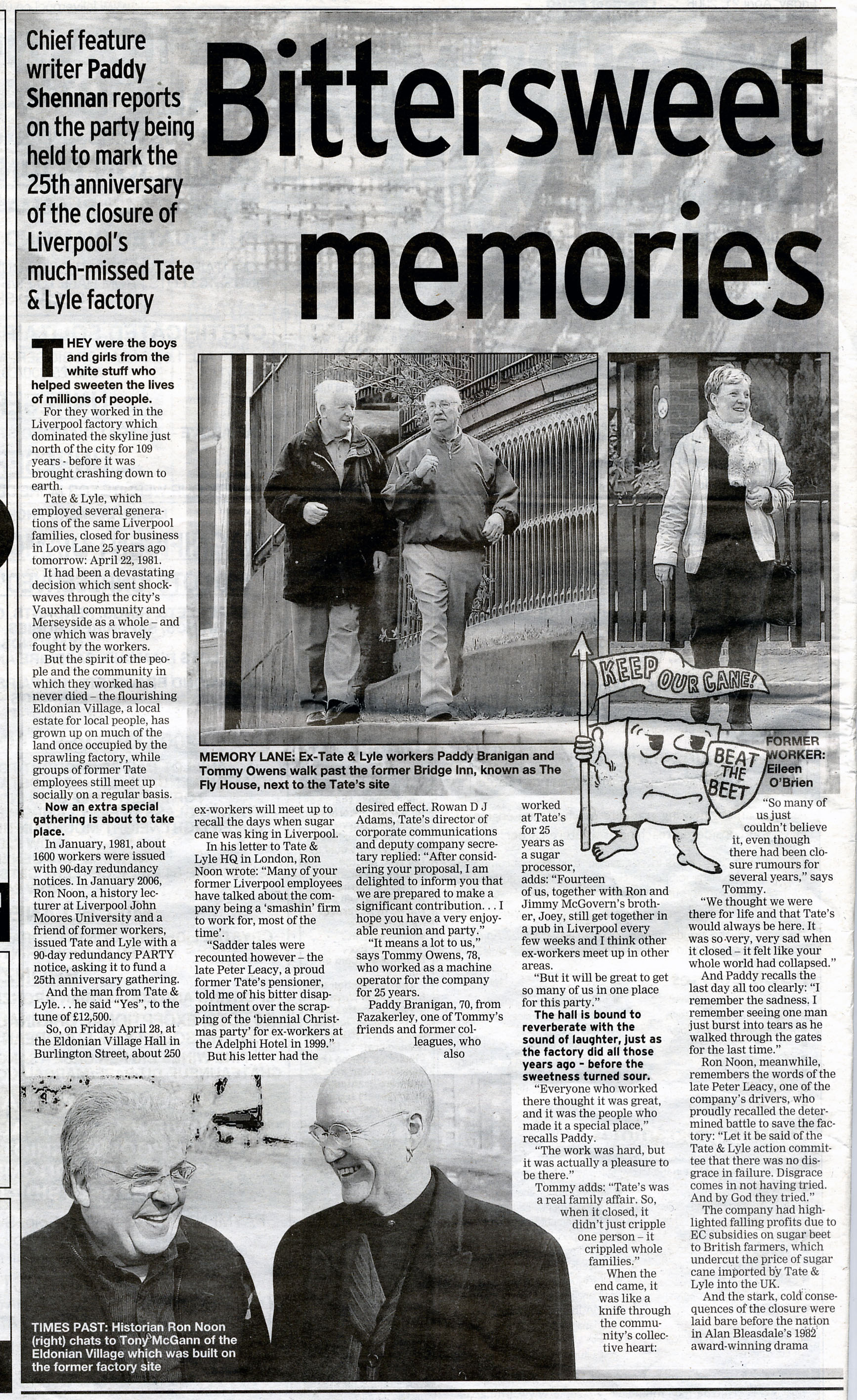
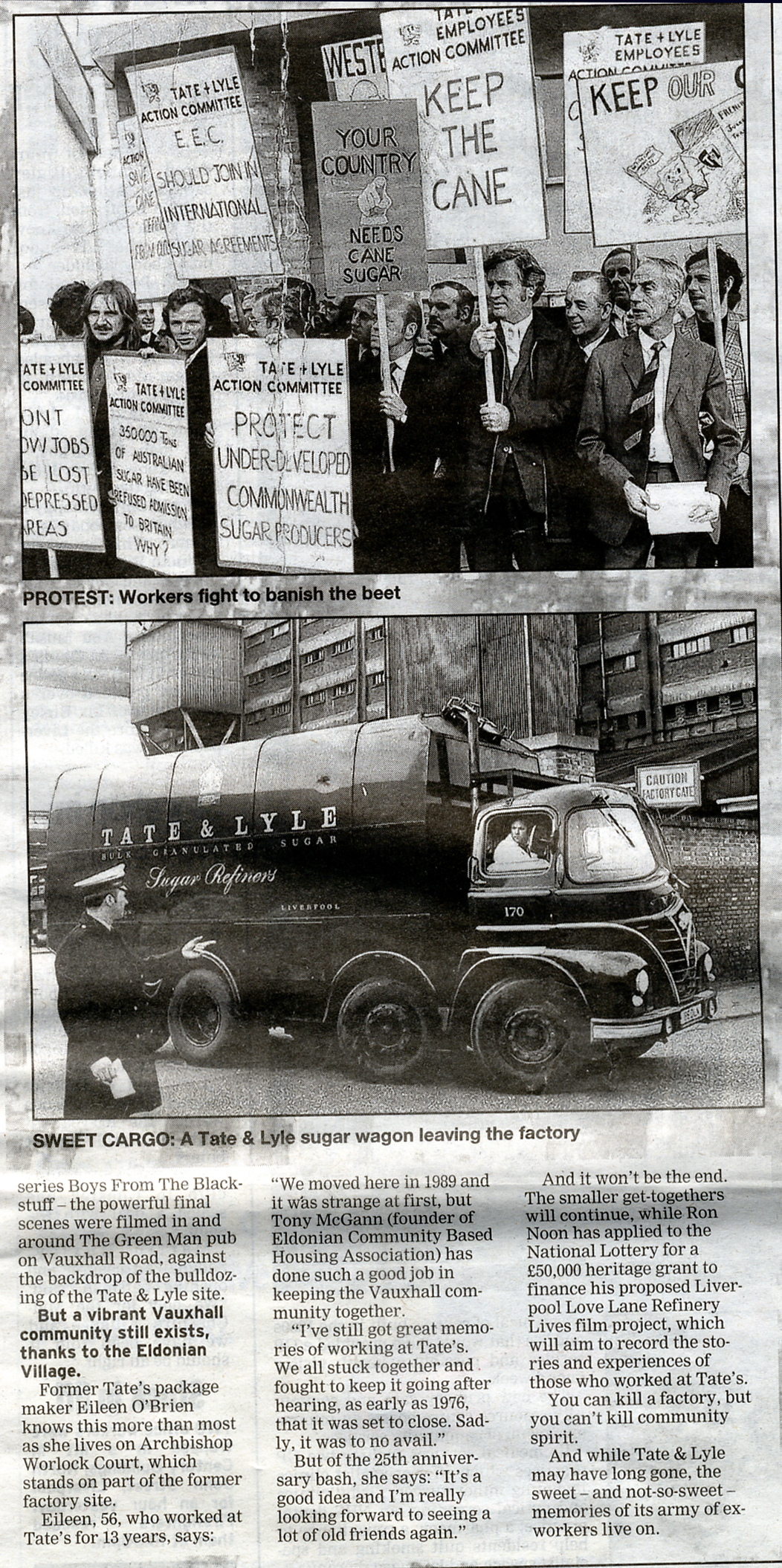
Does letter writing really count?
Written by Ron Noon at 12:21 on Wednesday, April 28th 2021
THE 90 DAY REDUNDANCY PARTY LETTER
19.01.2006
Dear Mr Ferguson,
I am a history teacher from Liverpool and next Sunday, January 22nd, will be the 25th anniversary of the issuing of 90 day redundancy notices to 1500 refinery workers at Henry Tate’s mother plant, Liverpool Love Lane. It is not exactly the kind of historical fact that is studied on the National Curriculum but it has a real resonance here on Merseyside, where the surviving “boys and girls from the whitestuff” look back nostalgically to the days when they helped sweeten the nations breakfast tables.
For me the only thing that mattered about sugar when I started to research Liverpool’s refinery workers, was that it was sweet, but that is the last thing that can be said about the history of the “white stuff”. Far be it for me to give the Chief Executive of a Sugar Giant a history lesson in sugar, especially when you are married to a lady with impeccable historical credentials, but my brief goes beyond historical themes. (COMENT I did a search on the web and found out that he was married to a professional historian!)
It is to make a request on behalf of the Tates Liverpool pensioners, the late Peter Leacy, Tony McGann of the Eldonians, Alan Bleasdale, Jimmy McGovern, Brian Reade, Jack Jones, and Tony Benn, that Tate & Lyle plc finance a reunion of the former Love Lane employees, either on or after April 22nd, the fateful day a quarter of a century ago when after 109 years of operation on the romantically named site, sugar cane time came to an abrupt end in Liverpool.
Our famous port city’s history is inextricably linked up with the politics and power of sugar and of a once prominent landmark, just north of the city centre, where the world’s biggest sugar dynasty was established in 1872. Facts like that were relayed to me by so many of your former Liverpool employees in friendly interviews where many talked about “family spirit” and the company being a “smashin’ firm to work for, most of the time”!
Sadder tales were recounted however, and Mr Leacy, a proud former Tates pensioner visitor, told me of his bitter disappointment over the scrapping of the “biennial Christmas party” at the Britannia Adelphi Hotel, in December 1999 and of the disappointing responses to a letter he sent your predecessor, Larry Pillard, in January 2001.
Mr Leacy’s letter was written three weeks before the 20th anniversary of the issuing of the 90 days redundancy notices, and requested a final party bash! “The month of April…calls to mind the end of sugar refining at Love Lane factory in Liverpool, and your board of directors may wish to mark or commemorate the event to acknowledge the contribution that the many thousands of sugar workers made in over one hundred years to the well being, the prosperity, and the success of Tate and Lyle…May I therefore prevail on your good self, and your fellow directors to stage a final, one-off, never-to-be-forgotten farewell to Love Lane party at the very place of so many happy T&L get-togethers…the Adelphi Hotel in the City of Liverpool, on or near the date in April 2001. May I?”
He was then informed by Mr John Walker acting on the CEOs behalf, that because the company was having difficult times, reflected in a low share price, “I don’t think we could justify the kind of expenditure that such a party would require”. We hope sincerely that is no longer the case, especially given the lead your company took in the Footsie 100 just before Christmas last year.
Mr Leacy also described to me a cameo scene from the “last supper” on Lime St in December 1999 which I hope informs your response to this letter. “Mr Richard Springford, the ‘human resources’ supremo from T&L London, for whom I had worked during my southern sojourn, was appointed to deliver the final address of welcome and farewell at the Adelphi. I was annoyed when no senior staff person or ex Love Lane personnel bothered to reply either in gratitude for past Christmas dinners or to express regret at the ending of them. So I introduced Mr Springford to my old T&GWU shop steward, Bob Bannister who asked a very valid question…… ‘Would it spoil some vast eternal plan if these Christmas get-togethers were to continue every two years, after all in ten or fifteen years most of us will have left for greener pastures?’.”
Precisely! Sadly Mr Leacy passed away last June. So having discussed a number of options and after talking to his twin nieces, Sheila Sullivan and Councillor Sharon Sullivan, the course of action that has the backing and support of the names I quoted earlier, is to formally issue this 90 DAY REDUNDANCY PARTY NOTICE!
Yours sincerely,
Ron Noon
............................
Here is the other letter I wrote in 2006 that was sent to LIVERPOOL MPs urging their support for our worthy cause. I initially pay homage to PETER LEACY, a lovely man and another Tate & Lyle scribe:
“When the ‘decline and fall’ of Liverpool is eventually written, let it be said of the Tate & Lyle Action Committee that there was no disgrace in failure. Disgrace comes in not having tried. And by God they tried.”
That comment in a letter written by Peter Leacy, one of the company’s transport drivers, and published in the Liverpool Echo, summed up a struggle that had actually lasted over 3000 days and culminated in “glorious defeat”. It helped inspire me to write letters in an attempt to get Tate & Lyle to finance “a final bash” for surviving employees of Love Lane. They deserved it. Peter Leacy deserved it. There would be no disgrace in failure but forgetting to try would I thought be unforgivable!
Dear MP ...
I am writing this letter to ask for your support in what Tony McGann and a number of other prominent Liverpudlians think is a very worth while cause. Saturday April 22nd will be the 25th anniversary of the closure of Tate & Lyle’s Love Lane sugar refinery, and the surviving boys and girls from the Whitestuff, the very workers who gave such loyalty and dedicated service, unquestionably deserve a memorable reunion bash, hopefully financed by the Sugar Giant that started its corporate life in Liverpool.
In January I sent a letter to Iain Ferguson, the CEO of Tate & Lyle, that requested “on behalf of the Tates Liverpool pensioners, the late Peter Leacy, Tony McGann of the Eldonians, Alan Bleasdale, Jimmy McGovern, Brian Reade, Jack Jones, and Tony Benn, that Tate & Lyle plc finance a reunion of the former Love Lane employees, either on or after April 22nd, the fateful day a quarter of a century ago when after 109 years of operation on the romantically named site, sugar cane time came to an abrupt end in Liverpool”.
I received a reply from the Director of Corporate Communications and Deputy Company Secretary, dated February 2nd , which informed me that Mr Ferguson is “currently abroad on business” but “we are currently considering the proposal set out in your letter and will revert to you with an answer as soon as possible”. Unhappily that is too late for Peter Leacy, a proud former Tates pensioner visitor who initiated a similar request five years ago. He told me of his bitter disappointment over the scrapping of the “biennial Christmas party” at the Britannia Adelphi Hotel, in December 1999 and of the disappointing responses to a letter he sent to Ferguson’s predecessor, Larry Pillard, in January 2001.
Peter’s letter was written before the 20th anniversary of the issuing of the 90 days redundancy notices on January 22nd, and requested a final party bash! “The month of April…calls to mind the end of sugar refining at Love Lane factory in Liverpool, and your board of directors may wish to mark or commemorate the event to acknowledge the contribution that the many thousands of sugar workers made in over one hundred years to the well being, the prosperity, and the success of Tate and Lyle…May I therefore prevail on your good self, and your fellow directors to stage a final, one-off, never-to-be-forgotten farewell to Love Lane party at the very place of so many happy T&L get-togethers…the Adelphi Hotel in the City of Liverpool, on or near the date in April 2001. May I?”
He was then informed by Mr John Walker acting on the CEOs behalf, that because the company was having difficult times, reflected in a low share price, “I don’t think we could justify the kind of expenditure that such a party would require”. In 2006 we know that is no longer the case, especially given that the company is back in the Footsie 100 with sales of its no calorie Splenda doing splendidly.
Mr Leacy also described a cameo scene from the “last supper” on Lime St in December 1999: “Mr Richard Springford, the ‘human resources’ supremo from T&L London, for whom I had worked during my southern sojourn, was appointed to deliver the final address of welcome and farewell at the Adelphi. I was annoyed when no senior staff person or ex Love Lane personnel bothered to reply either in gratitude for past Christmas dinners or to express regret at the ending of them. So I introduced Mr Springford to my old T&GWU shop steward, Bob Bannister who asked a very valid question…… ‘Would it spoil some vast eternal plan if these Christmas get-togethers were to continue every two years, after all in ten or fifteen years most of us will have left for greener pastures?’.”
That is precisely what this is all about and that piece was included in my letter to Tates CEO in January, along with this conclusion: “Sadly Mr Leacy passed away last June. So having discussed a number of options and after talking to his twin nieces, Sheila Sullivan and Councillor Sharon Sullivan, the course of action that has the backing and support of the names I quoted earlier, is to formally issue this 90 DAY REDUNDANCY PARTY NOTICE!”
So hopefully now with the names of those who backed the original “90 DAY RPN letter” and the imprimatur of Liverpool MPs, and a petition, we will ensure that the Liverpool Tates pensioners, the men and women who over many years sweetened the nation’s breakfast tables, get their own memorable anniversary bash in 2006.
Yours sincerely
Ron Noon
TODAY IS THE 40TH ANNIVERSARY OF THE CLOSURE OF LIVERPOOL LOVE LANE REFINERY. 22/04/1981
Written by Ron Noon at 05:07 on Thursday, April 22nd 2021
This POEM was written by one of the BOYS FROM THE WHITESTUFF who had long left the Lane when on this historic day forty years ago Liverpool Love Lane Refinery was closed down. Such is the strength of community and camaraderie that Joe continued to meet up with his Tate’s mates and I was fortunate enough to be welcomed as an “associate member” at the regular PUNCH & JUDY get together drinks. A lovely man who has lost so many of his refinery pals Joe’s poem helps us all to remember LOVE LANE LIVES. Thanks Joe
Sweet Memories
(By Joe Liasides)
I will try to recall some memories
When I worked at Tate & Lyle,
A place where people seemed so happy
And always had a smile
I started in the “Handy Gang”
A temporary more or less,
We would be sent to “clean up”
If there had been a mess.
I then went to the warehouse
To deliver on W.Two,
We did a double day shift with a “nutty crew”.
We rushed around with our wooden trucks
Sometimes it was almost insane,
Loading the wagons with different produce
From the sugar cane.
I was moved around again
To Fairies for a while,
The name of the building was Fairie
But it belonged to Tate & Lyle.
I worked on the machine called the Goka
Cube sugar it used to make,
And the bloke in charge of the said machine
Was a ringer for Charlie Drake.
Then after a while I moved again
To the Recovery House I came,
I have still not recovered
As they were all completely insane.
The shifts and conditions they worked in
Were really sometimes dire,
But they always had a laugh and a joke
Something I had to admire.
With doms and cards and practical jokes
I joined in with this nutty crew,
Nights out at the Barracks with guitars playing
Set up by Tom Donague.
With Bobo and Poynton arguing
Who had the biggest nose,
We all thought it was a dead heat
But no-one would ever disclose.
But with Byrne ‘o’ and Brannigan on the loose
You had to be alert,
You would either get water bombed where you sat
Or something stuck to your shirt.
In between the games and the practical jokes
These men worked day and night,
They knew their job, they done it well
To get their product right
The girls that worked at Tate & Lyle
They were a “feisty” lot,
You would never go alone in a lift with them
Because you would come out showing all you’d got.
Alas I had to leave Tate & Lyle
And so with much regret,
A new job I started and though broken hearted
For people I’ll never forget
Then I heard the refinery was closing
A great note of sadness did ring,
I thought of the families and friends who still worked there
And the hardship and sorrow it would bring
It was a sad day when it closed down
To not hear that old refrain,
Tate & Lyle, Love Lane Liverpool
Ever, Ever, Again
The Eldonian Village now stands there
A new part of Merseyside
We may have lost our workplace
But we never lost our pride.
...................................
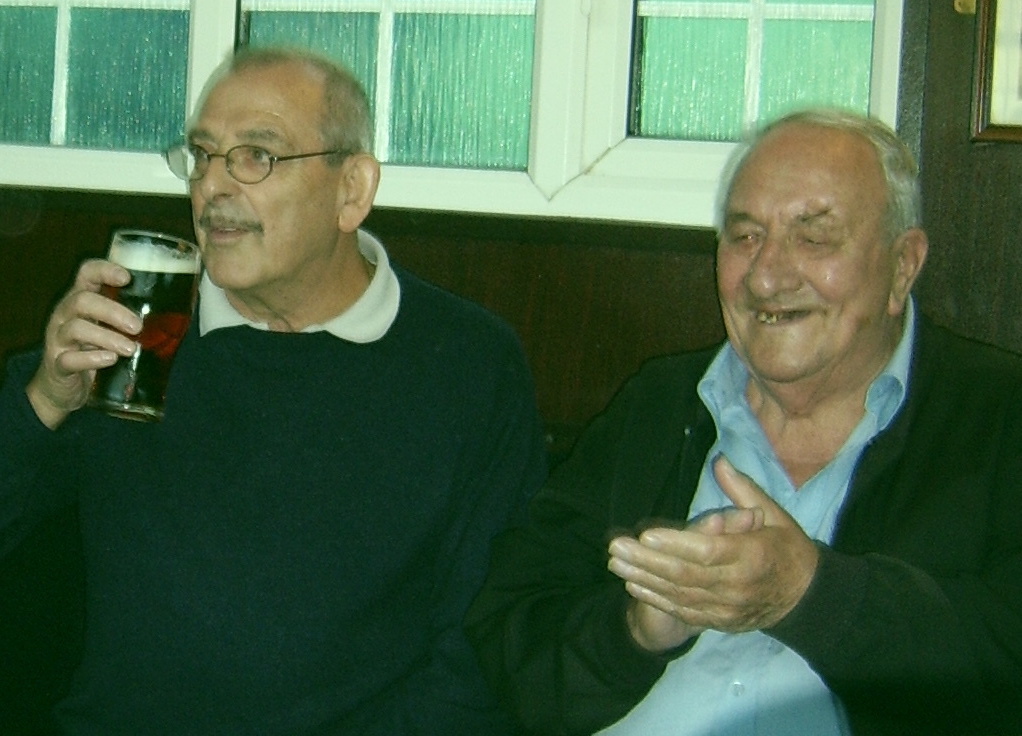
Joe and Albert Tod Sloane in the Punch and Judy.
A 2006 ESSAY written FOR MY GLOBAL CITY students.
Written by Ron Noon at 06:45 on Monday, March 01st 2021
In the last blog about the merger of Tate & Lyle on 27th February 1921 I emphasised the essentially contested nature of “history” and why studying history is decidedly “not about developing the memory at the expense of the intelligence”! There is always a subjective element that enters into the reading and writing of “histories” hence the importance of selection and interpretation. The Top down approach to history (a history of the British peoples with the majority of them left out) was being asserted by a certain knight of the realm in the late 1980s early 1990s in relation to the NATIONAL CURRICULUM. He raised a question about it in the House of “Commons” at Prime Ministers Question Time.
“Is my right honourable friend aware that there is considerable concern about the teaching of history in our schools today? Instead of teaching what are vaguely called themes why can we not go back to the Good old days when we learned dates by heart and learned the names of the kings and queens of England, and of our great statesmen and warriors and of our battles and of the glorious deeds of our past.” Sir John Stokes
“As usual my honourable friend is absolutely right. This is the subject of a very very vigorous debate as to what children should be taught in History. I agree with him. Most of us are expected to learn from experience of history, and we can’t do that unless we know it. They should know the great landmarks of British history and should be taught them at school. I agree totally with my honourable friend.” The Right Honourable Margaret Thatcher.
Dates are important and this “exchange” took place on the 29th of March 1990.
I have been keenly aware of supreme ironies ever since I asked my Ninny Molly O’Brien (a wonderful shawl wearing, snuff taking, endearingly loveable and feisty woman) what she thought of Winston Churchill. That “irony” I need to elaborate on in a later blog but the irony in relation to the exchanges above at PM Question Time 31 years ago is surely that this was a Tory Government deeply committed to ending nationalisation in industry promoting the nationalisation of history teaching!
IN 1981 she had washed her hands of a Merseyside in Crisis, refusing to meet the delegates of the CONGRESS OF MERSEYSIDE seeking discussions to help avert the closure of LOVE LANE refinery and the result was disastrous.
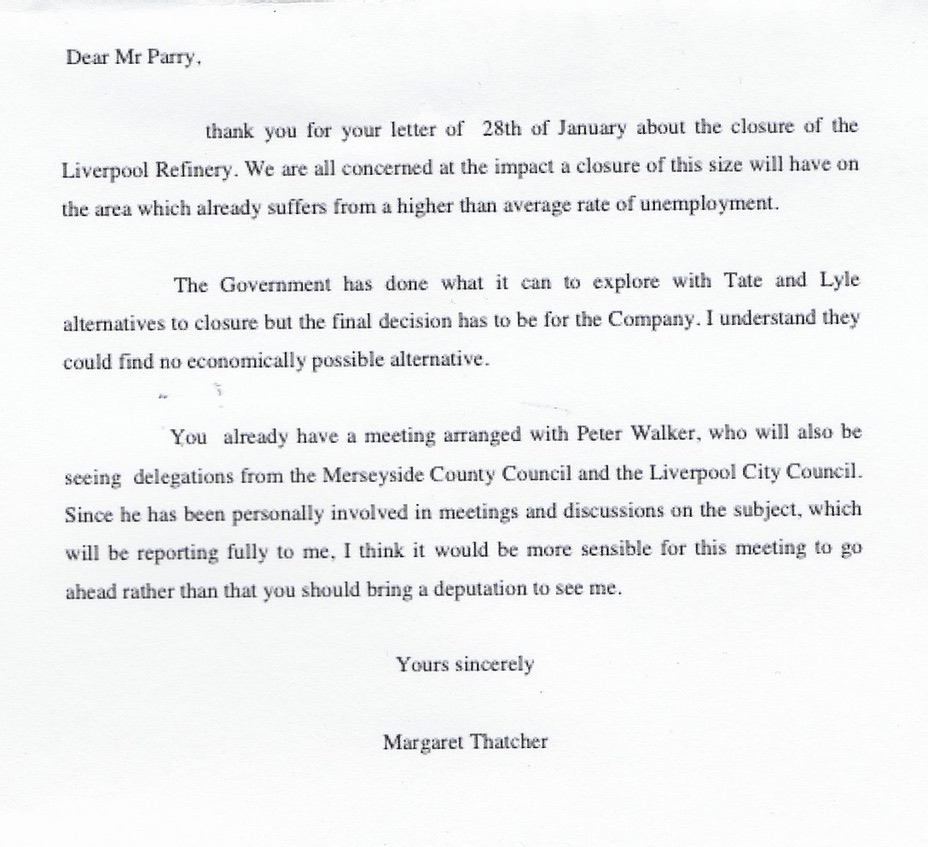
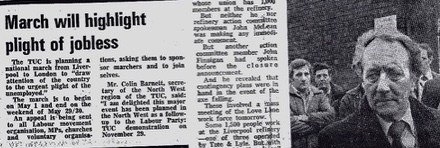
Here’s more from a People’s History, a bottom up not top down version of the background to all this.
THE LEAVING OF LIVERPOOL
In 1981 an act of matricide was perpetrated when Tate & Lyle’s oldest and comically misnamed Love Lane sugar cane refinery was junked. The internecine sugar wars between beet and cane sparked off by British entry into the EEC appeared to have been the main cause of this and throughout the 1970s the amount of refining capacity was far in excess of the amount of raw cane allowed into the country under the new arrangements. A valiant ten year struggle by the Workers Action Committee, local MPs and church leaders, to keep open this prominent Liverpool landmark ended in defeat when the refinery officially closed on the 22nd of April 1981. For over a century the refinery had dominated physically and economically the Vauxhall and Scotland road communities, just north of the city centre. The other port refineries that purged and processed the raw cane imported by Tates from largely African, Caribbean and Pacific countries, were in Silvertown London, and Greenock Scotland. Despite the general problems facing the industry they were regarded by Tates management as more economically viable than Love Lane.
In 1976 five years after the first rumours of closure leaked out, it was obvious that the greatest disadvantage in closing Love Lane would be social not economic. “The loss of 2,000 jobs near the city centre would be more than the end of a business enterprise - it would obliterate community.” That widespread view, expressed by the Liverpool Daily Post on its Business pages, failed however to influence Tate’s management decision making. Paying lip service to it did, and “imposed” plant “rationalisations” followed by the introduction of 12 hour shifts, brought the labour force down to just under 1600 by 1981. The fact that the British government was vigorously opposed to belated EEC proposals in 1980 to reduce beet quotas was ominous for Love Lane. Now the tidy arithmetic of overcapacity in the port refineries, (300,000 tonnes was almost exactly what Love Lane was then producing), was exacerbated by a British Sugar Corporation, hitherto hampered by the weather and poor crop returns, now reaching record output figures and squeezing sugar cane outlets even tighter. Given the much greater refining margin afforded sugar beet, Tates could not win in any price wars. What ensued was an increasingly aggressive market share exercise by BSC, undercutting Tates, especially with larger buyers such as supermarkets. An Economist magazine article estimated the refining margin advantage of beet over cane at £20 per tonne. That was in the month that the closure of Love Lane was announced
Entry into the EEC and the Government’s signal failure to negotiate an adequate refining margin for partially processed raw cane, had been a persistent handicap. Previously it had been the UK Treasury but now it was Brussels that fixed the refining margin at a much higher level for the raw beet grower and refiner. Beet imports and increased production from BSC compounded these difficulties. The problems of joining the EEC and securing supplies hitherto easily catered for under the Commonwealth Sugar Agreement, had been dramatically overshadowed by the great sugar shortage and crisis of 1974 when prices went through the roof. Poor crops in the USSR in 1971 and then Cuba in 1972 meant the former buying increased quantities from the “free market” to meet its own requirements. World stocks were reduced and steeply rising prices and feverish speculative activity “brought chaos to the market, especially the special (preferential) arrangements”. Prices reached a short lived peak of £650 a tonne when even garages used sugar to lure “sweet toothed” motorists to their pumps. Inevitably consumption would level off and the premium on autarky and increasing production was primed by these extraordinary prices of 1974-75.
Autarkic means the pronounced desire for self sufficiency (we discussed this a couple of weeks back when we reviewed the Economist article from 1937!) and as Tony Hannah pointed out “sugar is one of the most autarkic of soft commodities”. The situation today is that “among countries with a significant capability of agricultural production, only New Zealand, Norway and the Republic of Korea are not producers of some quantity of sugar”. In 1974-1975 this resulted in a panic overreaction amongst governments, which unmistakably contributed to a number of negative long term consequences including not just a boost to the developing High Fructose Corn Syrup (HFCS) industries in America and Japan, but also the conviction that the world sugar economy was entering into a phase of permanent deficit. Increased support prices in the EEC and innumerable expansion programmes elsewhere lay the seeds of oversupply and plunging prices, soon after.
The beet lobby interest, so strong in Europe and particularly in France, trenchantly insisted on a massive expansion, which the commissioners willingly agreed to. They did so by increasing the tonnage which each country could grow, and as suggested above the raising of support prices. In Britain a Government White paper published in 1975, “Food from our own Resources”, gave BSC the green light to expand and to complete the processing of raw sugar in its own sugar beet factories by building on more “white ends”. The construction of white end capacity, meant that the refining and granulating of raw sugars which BSC had previously sent to Tates was now increasingly done “in house”. That erosion and eventual loss of supplies of raw sugar, compounded the problem of overcapacity in cane sugar refineries like Liverpool which historically had handled both cane and beet supplies. Another cruelly ironic fact was that once the panic of 1974/75 died down, Europeans were actually found to be eating much less sugar. That contraction in demand and the search for other sweeteners such as High Fructose Corn Syrup, (HFCS) was to take place alongside the building up of a “costly and embarrassing sugar mountain”. So when BSC eventually started to reach its generous EEC quotas in the late 70s the threat to the jobs of those in the cane sugar Port Refineries was acute.
The Death of the Tate & Lyle company spirit in the era of “Mad C.A.P.” disease
A leader article in the Economist at the time of the Liverpool closure announcement in January 1981 spotlighted “the problems created, because the European Economic Community has rejected the economics of comparative advantage in agriculture”. The World Development Movement, (WDM) had used another important economic argument eight years earlier, by warning that “if production costs are compared…not in terms of money but by looking at what the land and labour in each country could produce if they were put to their most profitable other uses…then beet production, because of the far greater opportunities available to resources in rich countries is substantially more costly”. The “opportunity cost” was considerable and the EEC’s sugar policy meant that sugar beet producers were paid nearly three times the world sugar price in the late 70s, which inevitably encouraged them to overproduce.
This global misallocation of resources was compounded by the further misuse of EEC taxpayers money then used to subsidise the export of these huge surpluses. “Dumping” them onto the “free” world sugar market had a disproportionately deflationary effect on the prices which third world countries were so much more dependent on, than in the protected and regulated markets of Europe and North America. The conclusion is inescapable. “The EEC’s Sugar regime is fundamentally contradictory in the way in which it relates to the developing country cane producers. On the one hand it gives preferential trade to a handful of countries under the Sugar Protocol of the Lome Convention. On the other hand, in failing to exercise restraint over its own production of sugar beet, it has contributed directly to chronically low world market prices for sugar which have led to considerable hardship for many Third World Producers.”
Merseyside by the early eighties was suffering a similar if obviously milder version of the damage to Third World sugar cane countries caused by the economic madness of the EECs Common Agricultural Policy. Accelerated job losses in other sectors of employment in the late 70s had suggested that the “Bermuda Triangle of British Capitalism” was in Merseyside. So tragically the city which had been renowned internationally in the 1960s for the sound of the Mersey Beat and the Beatles, was by the early 1980s, ostensibly Britain’s first internal “Third world” victim of the sugar beet. The EEC was however only one factor in the decline of Love Lane, a factor nonetheless which was skilfully and cynically magnified by management, to divert attention from their own reasons for wanting rid of the mother plant.
The skill and the cynicism was not necessarily that of local management, but the local roots of this Sugar Giant meant that the parent company were able to project a company spirit very different to that of the other MNCs grafted onto the local economy post 1945. Phillipe Chalmin described the birth of that remarkable “company spirit” in the inter-war years. “On the whole the working conditions did not stand out against the norm.. were it not for the constant promotion of a ‘family-like company spirit’ (supported by numerous social and sporting activities encouraged among Tate & Lyle’s employees). On the long term this policy paid off, securing for the company the loyalty of many an employee…Tate & Lyle thus evolved. ..towards the most typical form of paternalism.” Generations of Tates employees, were very effectively “socialised” into accepting, relatively uncritically this perception of a soulful and paternalistic company. “It was a good company to work for” was the constant refrain of so many of its employees.
Arguably in Liverpool where casualism and insecurity were endemic, that feeling was even stronger. The recruitment policy of the old Tates had been that children followed parents into the employ of the company and “parallel to the Tate & Lyle dynasties, dynasties of employees emerged and sometimes three generations would be working at the same time for Tate & Lyle”. That selective recruitment policy aside, the firm’s ability to contrive and sustain the image of paternalism was achieved with very little expenditure in terms of actual effort. Indeed the culture of opposition that manifested itself amongst other groups of Liverpool workers in that era of company closures and rationalisations, did not manifest itself at Love Lane and its long established local roots meant that Tates effectively were able to project a company ethos very different to that of the other Multi-nationals that had operated branch plants on Merseyside post 1945. Down to the mid 1970s especially, it was an impressive and effective piece of local theatre.
Long service employment meant that in the 70s while the company was clearly not recruiting labour of all ages the consequence was “a seriously ageing labour force”. The Vauxhall Community Development Project surveyed the age structure at the plant in 1973 and noted that over half were aged 45 years or more “and now each year a couple of hundred of the total labour force are presented with their long service retirement clock”. The most significant effect of rationalisations and job cuts was irreparable damage to the local community. This euphemistically named natural wastage was “another word for redundancy by proxy”. It meant that “you won’t be thrown out of work, but it means that your child or your neighbour, or your neighbour’s neighbour, won’t get a job when he wants one. And since job movement is something of a chain reaction it means that your own job chances will be that much slimmer at the end of the chain.”
The VCDP reported a typical example: “My father worked here for forty four years. He retired when he was 58 with bronchitis, and died when he was 60. The furthest he ever went was to bed because he was tired, it was so hard here. You know we were born and bred for Tate’s.” Job prospects for older workers whose expertise and experience was very particular to sugar refining were very gloomy. Through family and home commitments they had less propensity to move elsewhere in search of work, and long term unemployment was the sickening reality for so many “sweet fighters” like Albert E Sloane. One of the sweeteners on the company pill of rationalisation was the offer to create new work in related though diversified new products, including even proposals for a sugar based detergent factory. The workers action committee on the basis of “half a loaf is better than none” were prepared to go along with job cuts as long as some form of presence was kept on the historic site. For a time it seemed as though a “job for job” policy was being pursued, but when TALRES (Tate & Lyle Research) went into partnership with an American chemical company to build a detergent plant it was on a green field site eight miles away from Love Lane.
Those stark facts made it all the more nauseating to reflect back on the warmly persuasive references that were so often made about “Tate’s”, the local firm that for over 100 years had been well known for job security and paternalism. At one time no doubt it had reflected pride and perhaps the knowledge that Love Lane had been set up by the dynamic entrepreneur and former grocer Henry Tate in 1872, six years before he decided to build Silvertown in South London. The mother plant had been built on what had been a “des res” site where rich merchants once lived, and where their wives and daughters had perambulated along the “charmingly named Love Lane, Ladies Walk and Maidens’ Green”, glimpsing as they did eye catching views of the river. This rural idyll coincided with the opprobrious trade in human cargo that George Cooke railed against, but pre-dated the construction of the Leeds Liverpool canal and the general processes of industrialisation and urbanisation which transformed the enchanting landscape of Love Lane into coal yards, brick fields and glue factories. During the nineteenth century a political essayist was to unintentionally emphasise the obstacles to “gender solidarity” when he referred to middle class “ladies” and “mere biological females”. By 1870 the residential requirements of the Victorian middle class and their daughters had changed more dramatically than that of their working class sisters. The former habitat of ladies was left with only the charming name which a 100 years later was thought to have been dreamed up by someone on the popular TV show, “The Comedians”!
“You have no idea how massive Love Lane refinery was. It was a city on its own. Huge and like Topsy it had just growd over a hundred years.” That was the pertinent description provided by John Maclean, a former maintenance fitter, popular scribe, and secretary of both the Love Lane workers action committee, and the national Port Refineries Committee. Another former Tates employee, J A Watson, a company chemist and historian of the family, represented its scale and magnitude in this way. “For 109 years travellers approaching Liverpool by train from the North, knew they were near when they passed the refinery with its prominent sign: firstly Henry Tate & Sons and then Tate & Lyle Ltd. Soon however the refinery and its sign will be gone: just another seemingly permanent landmark that has vanished.”
The local firm had clearly exported its success elsewhere, and despite claims that its real heart would always continue to beat in Love Lane, by 1981 this was the most expendable plant. The destruction of the original site used by Love Lane ladies was of far less consequence than the demise of the “blue turbaned” biological females from Chisenhale, Eldon and Burly streets who had been employed in the packing sections of the refinery. Renowned for their famous headgear and distinctive trousered uniform, their “perambulations” around the packin’ and over “the bridge on the River Kwai”, (the canal separated the male process workers from the predominantly female packers), was of course historically much more significant in the collective memory of the blighted community. So you can close a city down. The destruction of that Liverpool landmark and the hole it left in the community, graphically illustrated what a prescient nineteenth century political economist and contemporary of Henry Tate, had consistently warned about. “All that’s solid eventually melts into air.”
From ‘bone char’ to Portfolio consciousness
Subjective and objective realities are often in “disagreement” and it was increasingly apparent to informed observers in the 1970s that a new chapter in Tates’ history had opened up long before the history of sugar refining in Liverpool came to an end. Symptomatic of this was the appointment of outsiders to key positions in the firm. In 1978 Lord Jellicoe took over from John Lyle to become the first Chairman appointed from outside the families. This was a trend which had been discernible for some time however. Where once pride and pragmatism had dictated that executives should all go through the “sugar mill” so as to familiarise themselves with the firm’s essential “core” refinery activities, a new breed of professionals and accountants without “bone char” in their “blood” were looking elsewhere to exploit markets and opportunities in services and trading.
Diversification out of sugar refining in the UK was a strategy Tates had planned and prepared for years before Britain joined the EEC in 1973. From the early 1960s a number of directors realised that refining was no longer the “cash cow” it had once been. Despite opposition from some of the old guard “sugar mill” directors, the acquisition in 1965 of United Molasses, with its world wide network of activities and distribution points, opened up new horizons and new directions. It also completed another symbolic “local/global” dimension because UM had been founded by a “Liverpool Dane” with an attraction to molasses, Michael Kroyer Kielberg. He had arrived in Liverpool in 1907 at the age of 25 as “a quiet soberly dressed young Dane…about to apply for a job with a modest firm of cattle-feed importers”. The firm not only took him on but within three years made him a partner. “Now Kielberg became fascinated by molasses” and a global dynasty was formed.
The movement away from the increasingly anachronistic image of Tate’s as an “imperial sugar company” was accelerated by this new venture. The policy of vertical integration along the sugar chain and the acquisition of sugar plantations in Jamaica and Trinidad had been a successful response back in the 1930s to increasing autarky in world trade and stifled opportunities in the home market. “The firm was more a ‘last comer’ than a first mover in its decision to invest in plantations…The company, which was Britain’s leading sugar refiner, had tried to invest in the emergent British beet sugar industry, but had been forced out by the emergence of a quasi-state monopoly. The initial investments in the West Indies were motivated by the desire to employ resources released from the unsuccessful beet sugar venture.” Thirty years later the sugar and real world had moved on and dismantling the imperialist legacy was not only economically but clearly politically opportune for Tates. This move from direct plantation production and “tradition” was a clear recognition that the UM flag was the banner for the future.
The historic by-product of sugar production, used by the fermentation and livestock feed industries was molasses and UM was the world leader. Molasses is the dark treacly stuff left over when it is no longer economic to extract sugar from cane or sugar beet. To the aficionado the essential difference between the cane and the beet was that “rumbullion” or “rum” can only be produced satisfactorily from molasses extracted from the tropical plant! Furthermore unrefined cane molasses contains some important minerals such as iron, zinc, chromium, and small quantities of magnesium, calcium and potassium. This is not enough to fill the “empty calorie” but certainly enough to differentiate it from that extracted from beet. UM was much more than just rum and “brown sugar”. The extensive storage, loading and unloading equipment, spread over a vast geographical area, meant that the international molasses economy was dominated by a few players. Not many could afford to operate on such a scale. UM certainly did and was also an international trading firm with its own shipping lines. When Tates took it over the organisation effectively metamorphosed to become ‘a real multi-national’.
Changing commercial and economic realities meant that throughout the 1970s Tates was spreading its tentacles much further a-field, along and even outside the sugar chain. Amusingly this included an ill timed, ill judged venture into manufacturing skateboards in 1977! Generally though, it exploited, trading, shipping, consultancy, engineering and research know-how, and operated much more, as Phillipe Chalmin argues, like a “multi-national of the tertiary sector”. Given that the best years for “the heavy economy” of refining appeared to be over, there was clearly an added incentive to develop trading, consultancy and services without spelling out precisely its implications for Tates’ oldest refinery site. The process of paring down the heavy economy at home would severely test and ultimately find wanting the Tate & Lyle company spirit. Nevertheless even when the Port of Liverpool was being rapidly run down and rationalisations were eliminating jobs in adjacent inner city areas, the notion of “a job for life” with Tates was still part of the collective folklore.
An in-house brochure published in 1977 described the organisation as a specialist in trading and service areas. “Tate & Lyle’s mission is to develop a complete commodity processing, trading and handling service, to meet its own needs and those of third parties.” Indeed more money was actually made in the 70s from the ability of Tate & Lyle’s traders than on “the classical industrial margins”. As Hannah Wright pointed out “if a player not only trades in sugar, but also grows it, ships it and refines it, then his prospects in the game are considerably enhanced”. To that extent the adverse consequences of EEC entry for sugar cane refineries, has to be related to the logic of these wider adjustments and new directions. The often intense “politicking” around EEC questions and the related sugar diplomacy clearly posed a challenge to Tates but never at any time did it seriously portend a mortal blow to its newer profit centres. Despite a denial that “transfer pricing” was practised within the group they certainly “practised a very sophisticated fiscal policy”. Down to 1976 when trading was reorganised and “Albion Ltd” was dissolved, “profits made by the Bermuda subsidiary” of the Canadian subsidiary Redpath, “were reinvested to buy ships rented to a British subsidiary”! They were also clearly able to use the complexities of European politics and sugar diplomacy to camouflage their real strategic intent and interests.
Tate & Lyle PLc: The “soulless global corporation”
“Tate & Lyle was a multinational before the word was invented.”
The appointment of Lord Jellicoe in 1978 as Chief Executive, was very much at the expense of Saxon Tate, the “family” man who had been expected to take control when John Lyle stood down as Chairman. Jellicoe was an outsider who had only been on the board for four years whereas Saxon Tate had served a long and profitable apprenticeship with the Canadian subsidiary Redpath Sugars. From 1972 he had “for all intents and purposes” run the Tate & Lyle group. The introduction of modern methods of management and “the first touch of professionalism from within the board” was directly attributed to his regime. Consequently the consolation job of Group Managing Director, albeit under a son of the “victor” of the naval battle of Jutland, seemed scant reward for such endeavours. The fates seemed to be conspiring against Saxon Tate when in June 1980 he was given the honorary post of Vice Chairman. It was a poignant moment when his executive functions were all stripped away. An even crueller irony was to follow, with the appointment of the Canadian, Neil Shaw as Group Managing Director. This was clearly a reminder if one were still needed that a new day had indeed dawned for the sugar multi-national.
The first time Shaw had taken over from Saxon Tate was at Redpath when both their stars were in the ascendant, but the former subaltern now overshadowed not only the old Etonian, Oxbridge educated, former Life Guards officer, but also the “family spirit” as well. Along with Saxon Tate, the ideological baggage of tradition and paternalism was rapidly shunted to the sidelines. The following year Lord Jellicoe, as Chairman of a Board of Directors “on which there was, symbolically, neither a Tate nor a Lyle”, made the announcement that Love Lane was to close. “Thus the history of sugar refining in Liverpool was to come to an end at the beginning of 1981, after over 150 years of ‘good and loyal services’, owing to the ‘treachery’ committed by a firm which had been born there a little over a century earlier.”
Increasingly global perspectives meant that there was a corresponding withering away of national or local roots or loyalties. Much of that was evident before Neil Shaw took over as Group Managing Director, but under him the metamorphosis from what Chalmin describes as a “family and moral community” into a financial community was completed. Shaw had first been appointed to the Board in 1975 but by the mid 1980s he would assume an unprecedented position of power as the company’s first ever Chairman and Chief Executive. Some argue that it would be more accurate to describe Tates as an embryonic “supra-national” corporation where arguably “the nation of the corporate headquarters, let alone the towns where corporate production is based is of declining significance”. This concept of the rootless firm without national identity, searching the world for low wages and union free environments is not without some substance but most multi-nationals are still locked by culture, tradition and staff into one nationality. The British based Tate and Lyle has witnessed a number of organisational shifts over the last thirty years which have severely compromised its historic “paternalistic” image. The end of sugar cane time in Liverpool and the blighting of an inner city community was the most dramatic consequence of that change, and was emblematic of the “soulless global corporation” that Henry Tate, the entrepreneur and philanthropist had unintentionally bequeathed to the world.
Have a look at my Love Lane Refinery Lives essay in NWLH journal September 2007
P.S. If you’ve shown such great patience and stamina to get right down to here, that was the nudge to the students on GLOBAL CITY.
Date Night: The Tates & Lyles yoked together in a Feb 27 1921 MARRIAGE.
Written by Ron Noon at 14:01 on Saturday, February 27th 2021
“On 27th February 1921, the British sugar world was appraised of the most important news…of its structures’ evolution: a merger was about to take place between the firms Henry Tate and Sons and Abram Lyle and Sons.” Phillipe Chalmin. The Making of a Sugar Giant:Tate & Lyle 1859 to 1989.
History used to get a bad name because it was associated in too many people’s minds with dates and memorising them, rather than the more challenging and intellectually challenging task of interpretation and analysis of WHY those dates were significant. INTERPRETATION and selection are very much part of the DNA of REAL History and that’s why it was, always will be a vitally important subject, one that is perennially contested and fought over.
“History is the lie that historians agree upon” opined Voltaire in the Oyster circa 1958 (Fact or Lie?) It’s not a verifiable fact but bias and subjectivity and where we come from and are patterned, shaped and “socialised”, enters into everything that “we” opine upon. (FACT: Anyone who ever used the OPINE word in Croccy where I grew up would not have survived the Oyster and after after a disconsolate walk up Middle Way to the Lobster would have sprinted out to catch a 14c down to the Pier Head, hopefully to get back to the Wirral.)
SOME PUNDITS would say that history was/is about developing the memory at the expense of the intelligence”! If that were the case I must be getting more and more intelligent as I travel through this last of the Summer Wine phase of my life as a teacher of History. (That is decidedly subject to selection and interpretation of EVIDENCE. “Facts are sacred, opinion is free.” A DEAD but erudite editor of the MANCHESTER GUARDIAN.)
A KEY POINT is that “a people without a past is a people disposessed”. Yes IT IS. It’s also a source of NATIONAL MYTH MAKING. Would you trust the present incumbent of No. 10 with his views of BRITISH HISTORY? Would you have trusted the incumbent of 10 Downing Street 31 years ago at Prime Ministers Question Time when she replied to this pompous chap?
“Is my right honourable friend aware that there is considerable concern about the teaching of history in our schools today? Instead of teaching what are vaguely called themes why can we not go back to the Good old days when we learned dates by heart and learned the names of the kings and queens of England, and of our great statesmen and warriors and of our battles and of the glorious deeds of our past.” Sir John Stokes
“As usual my honourable friend is absolutely right. This is the subject of a very very vigorous debate as to what children should be taught in History. I agree with him. Most of us are expected to learn from experience of history, and we can’t do that unless we know it. They should know the great landmarks of British history and should be taught them at school. I agree totally with my honourable friend.” The Right Honourable Margaret Thatcher.
WHAT ARE THE GREAT LANDMARKS OF BRITISH HISTORY?
Tongue in Cheek answer! THE CONGRESS OF MERSEYSIDE circa 1981.
The Congress of Merseyside The comment column in The Echo on February 3rd coined this phrase to describe the convening of a Special Conference, to fight the closure announcement, adding that “this could well become an important milestone in the history of our community”.
But what if Mrs Thatcher refused to meet the delegation? She actually gave the request short shrift and referred it to the Minister of Agriculture, Peter Walker.
30th January 1981 was the day when Alfred Stocks the Chief Executive of the City of Liverpool wrote to the Prime Minister expressing the alarm felt by the City Council on hearing of the decision to close Love Lane, and then he followed that up with a second letter dated 2nd February. In that he reported a special meeting which had been convened in Liverpool at which there were representatives from all Merseyside District Councils, the leader of the Merseyside County Council, Members of Parliament and the European Parliament, the Bishop of Liverpool and the Archbishop of Liverpool, representatives from the Chamber of Commerce, the Mersey Docks and Harbour Company and the Trade Unions concerned. That was the Congress of Merseyside! Stocks was requesting a meeting of this far from ordinary deputation, with the Prime Minister.
Maggie’s own goal? It was to take the actual closure and the Toxteth riots in June to smuggle her into to the city.
TO BE CONTINUED…....
“We cannot reasonably expect any further special treatment.”
Written by Ron Noon at 09:54 on Friday, February 12th 2021
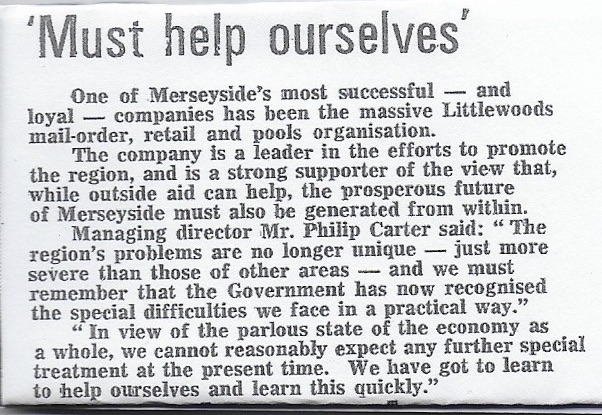
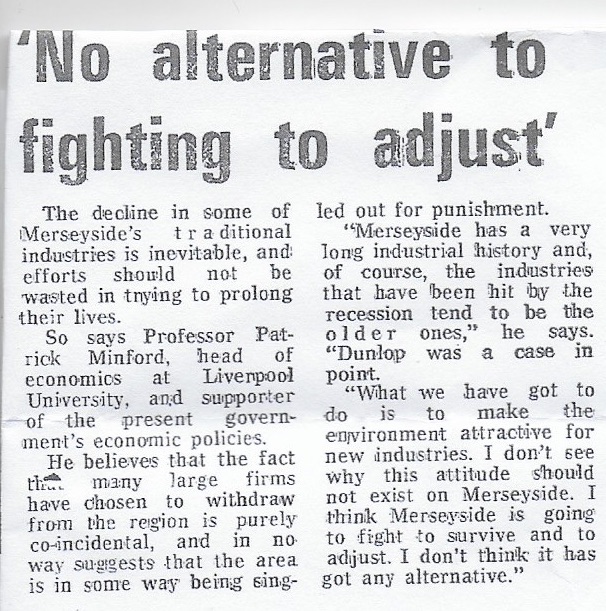
Context is key and the issuing of the 90 day redundancy notices on January 22nd 1981 galvanised not just the threatened refinery workers in Love Lane into fighting Tate & Lyle’s decision to junk Henry Tate’s mother plant. The Liverpool Echo described the mobilisation of a broader based “CONGRESS OF MERSEYSIDE” initiative to resist this massive rise in unemployment.
Behind the rhetorical phrase (Congress of Vienna in my old A level History notes was a conference of European ambassadors at the end of the French and Revolutionary war years in 1815) was substance. That was expressed in two letters from the City Chief Executive Officer:
:
30.1.81. Alfred Stocks CEO of the City of Liverpool wrote to the Prime Minister expressing the alarm felt by the City Council.
In a second letter dated the 2nd of February he reported on a special meeting which had been convened in Liverpool:
‘Congress of Merseyside’ - representatives from all Merseyside District Councils, the Leader of the Merseyside County Council, MPs and MEPs, the Bishop of Liverpool and the Archbishop of Liverpool, representatives from the Chamber of Commerce and the Mersey Docks and Harbour Company and the Trade Unions concerned.
The purpose of the second letter was to ask Margaret Thatcher to meet a broadly based delegation of commercial and religious leaders together with Trade Union officials and MPs in order to discuss the implications of closure and the possibility of avoiding it.
In its comment column of February 3rd the Echo named this the “Congress of Merseyside” adding that
“this could well become an important milestone in the history of our community. Here we see diverse interests coming together with a strong common purpose - to halt the wounding loss of jobs. The initial aim is to save the threatened jobs at T&L. The fight will be difficult and prolonged but a start has been made. Whitehall will get the message that Merseyside has taken enough blows. Tates could well prove the first of many battles. It is not difficult to identify other areas under threat. At the first whiff of danger our Watchdogs should be active.”
Woof! She was n’t having it: The request from Stocks got short shrift from Thatcher who refused to meet the delegation and referred it to Peter Walker the Minister of Agriculture and of course the company management. (Tories and Tates went together like bangers and mash and Peter Walker would end up on the board of Tate & Lyle.)
So forty years on from that rejection a brief reflection on my recent ECHO letter. (IRONY IN THE LANE 24/01/21) I was pleased it was published especially as I thought tha it was not going to be when on Friday and then Saturday it was nowhere to be found. BUT it was published on a SUNDAY and 40 years ago there was no SUNDAY ECHO and the Echo was published in Liverpool not Oldham!) Anyway that said The editors cuts were stark.
I had made explicit references to MERSEYSIDE IN CRISIS and the phrase doing the print rounds at that time, THE BERMUDA TRIANGLE OF BRITISH CAPITALISM. I’d also highlighted that this closure would mean more than the loss of another historic business enterprise on Merseyside and the obliteration of the Vauxhall community but that even the Daily Express response was to suggest that “whoever dreamed up that name” LOVE LANE “ought to be on the popular TV show ‘the Comedians’”. WHY LIVERPOOL?
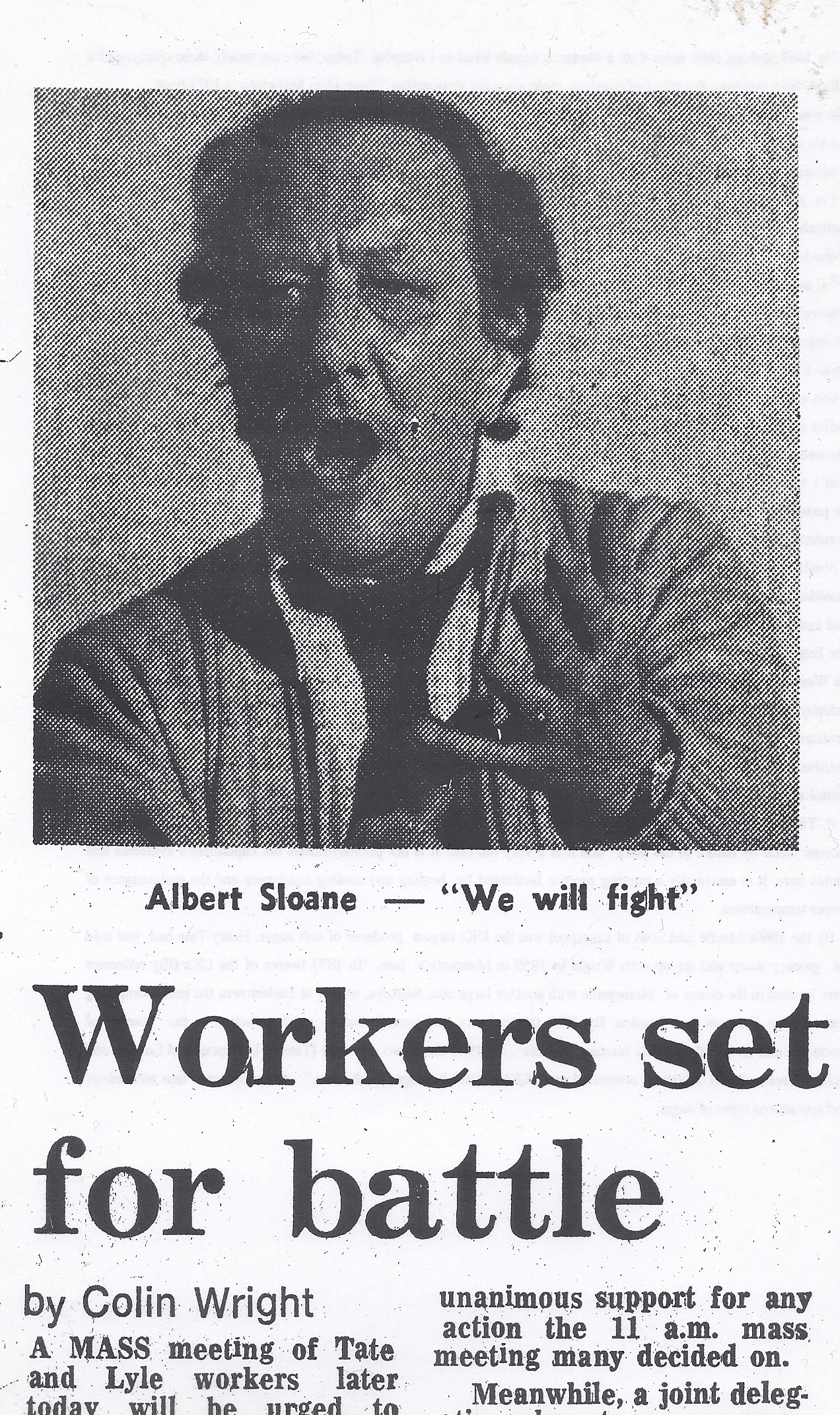
That’s a great picture of my feisty sugar mentor Albert E Sloane. “Tod Sloane” as he was known to the boys and girls from the whitestuff urged me to locate THE THATCHER LETTER to Bob Parry. Eventually I had a serendipitous success and here below is what Thatcher wrote to the MP for Scotland Exchange. “The Lady” wants nothing to do with the CONGRESS OF MERSEYSIDE.
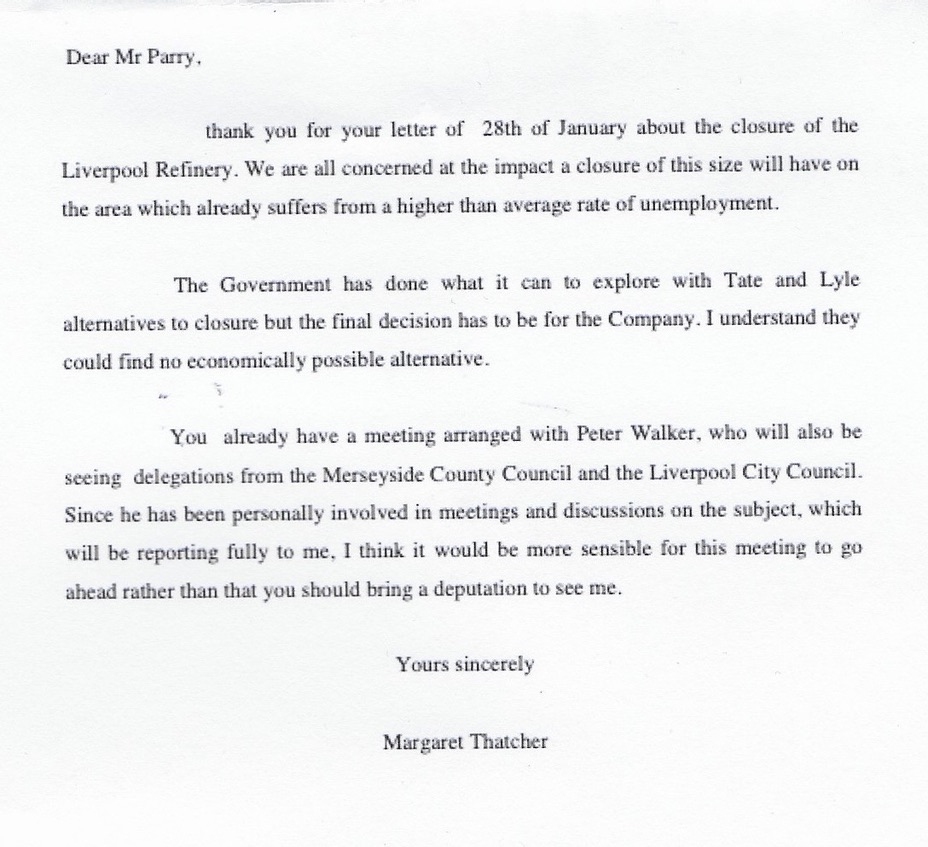
WRATH ON MERSEYSIDE - Both the Post and Echo gave the refusal wide coverage. David Alton MP for Edge Hill called it an insult to people of Merseyside and Sir Trevor Jones leader of the City Council said it was diabolical and blinkered.
Echo comment on 11th of February says it all:
“Mrs Thatcher’s refusal to see the Liverpool delegation over T&L is no doubt defensible in terms of Westminster protocol. But it will be interpreted as a cold insensitivity to the feelings of the whole community. The composition of the delegation including Church leaders reflected the deep concern over unemployment not just at T&L but throughout Merseyside. Mrs Thatcher’s policies have played a large part in creating the situation and she cannot brush aside the responsibility by referring protests to the management concerned. I don’t myself see delegations she told the Commons. The Premier should step down from this lofty position and if mere delegations are below her dignity then the City of Liverpool would offer her a warm welcome to see at first hand what is actually happening outside Whitehall.”
Food for thought. So back to who WE are. This was not self inflicted. There were structural, systemic reasons why the Merseyside economy was particularly vulnerable to branch plant closures and external decision making but the sloppy and self fulfilling tendency was to blame the crisis on MERSEYSIDE MILITANCY. It was a reversal of cause and effect and subsequently when the official Cabinet papers were released at the end of 2011 we found out about plans for Liverpool’s MANAGED DECLINE.
THE SCOTTY press did not have to wait that long. It knew then what HARD TIMES were and who were CULPABLE.
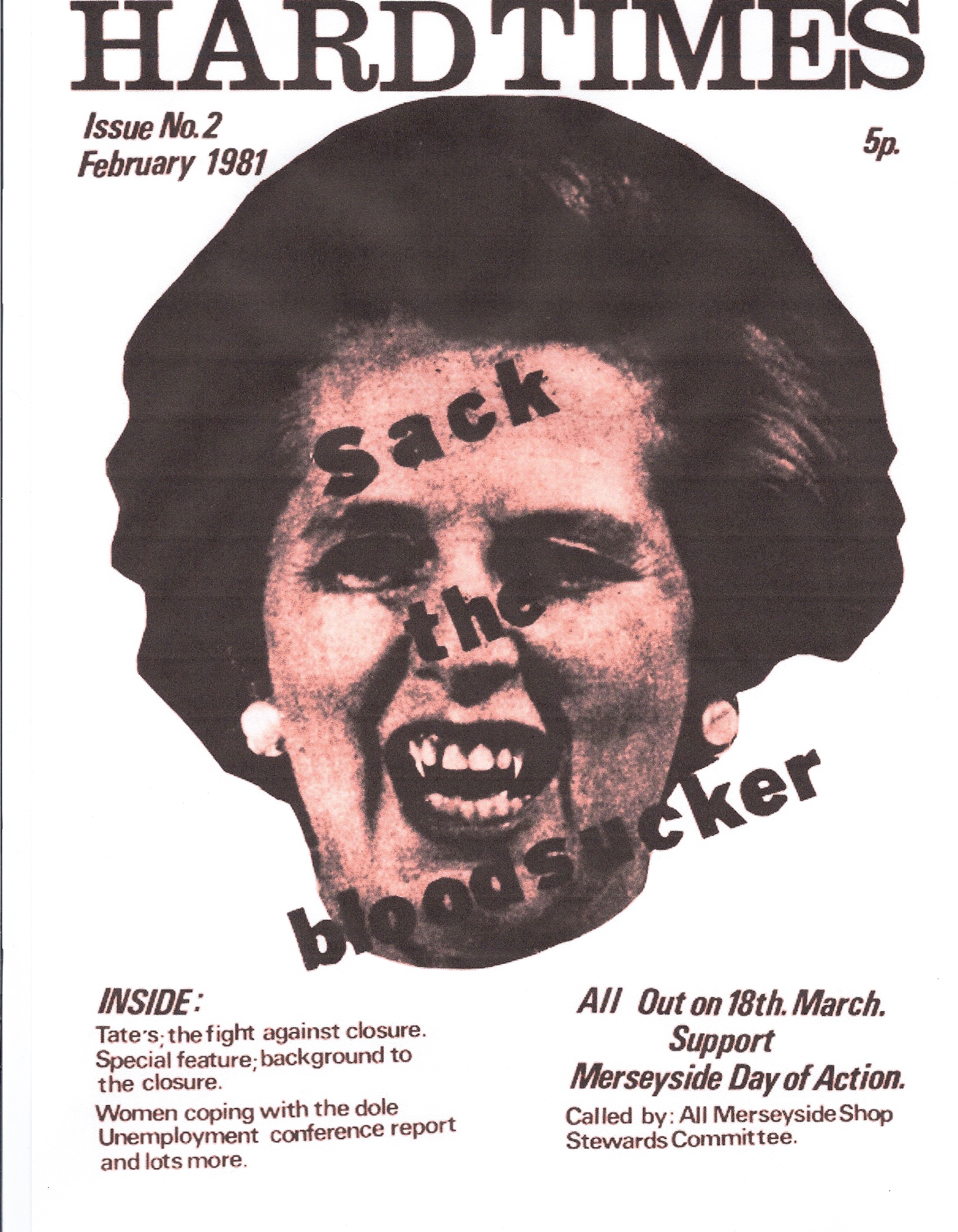
FINALLY as CONTEXT is key. HERE’S THE FULL PAGE VERSION.
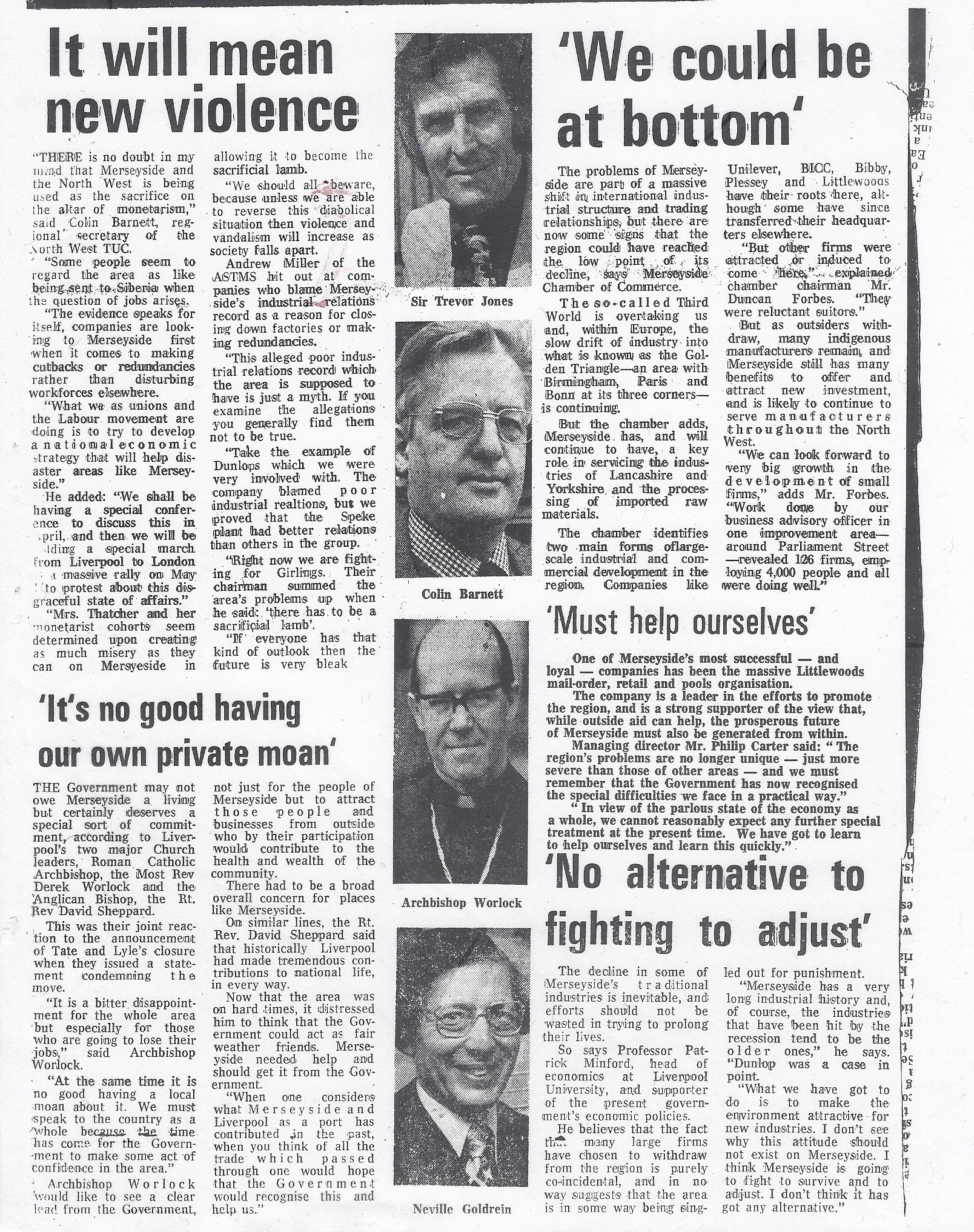
LIVERPOOL DAILY POST headline on 11th February 1981
Written by Ron Noon at 14:51 on Thursday, February 11th 2021
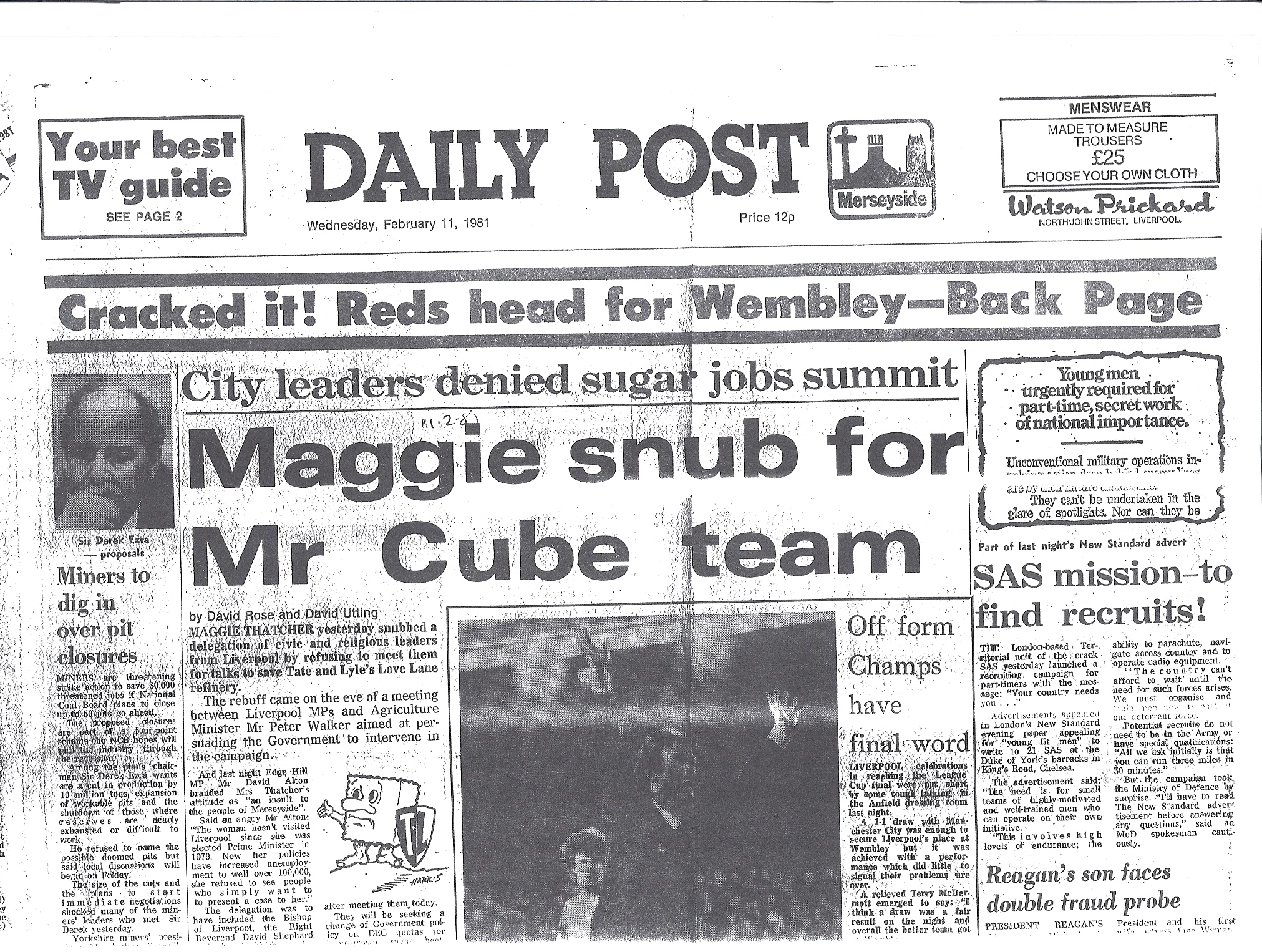
What a headline, especially when you relect on a PRIME MINISTER who quoted St. Francis of Assisi on the steps of 10 Downing St. when she came into power in 1979. There HAD been such a thing as SOCIETY Maggie Thatcher.
Am I biased? I’m a professional historian OR at least I was before I retired in 2010. Here’s a bit of reflexivity. I’m more determined to use more of the sources that Albert E Sloane and John Maclean my sweet fightin’ mentors accumulated in the struggle to keep the lane open. HOW DO YOU BLOG A NEWSPAPER HEADLINE?
Anyway the man who had first dibs on that rich archival source Albert and John put together was a TATES MAN by the name of Watson and his book came out in 1985. I’ve used the same sources and have not produced a BOOK yet but hopefully in the last of my summer wine I will do precisely that. It will have an obvious PARTIALITY and bias but it will always be in pursuit of KNOWLEDGE.
“Selection, subjectivity and interpretation enter into every aspect of the historical record because absolute objectivity is fantasy. Facts do not speak for themselves and an element of subjectivity and bias is intrinsic to placing AND prioritising facts in our written records. In “fact” it’s much more. Delineating the facts is a painstakingly forensic effort to minimise the subjective element in reconstructing REAL history.
“THE ONLY COMPLETELY UNBIASED HISTORIAN IS THE RECORDING ANGEL AND EVEN HE ACCORDING TO MARK TWAIN HAD OPINIONS WHICH TO SATAN WOULD APPEAR LIKE PREJUDICES.” Get my meaning!?
So here we GO on 11/02/2021, a day 40 years after the now deceased DAILY POST acknowledged ABOVE the head line news that REDS HEAD FOR WEMBLEY, with the now day old 21st Century news that BLUES HEAD FOR WEMBLEY!
“FACTS ARE SACRED, OPINION IS FREE.”
Albert was a Blue, John was a Red.
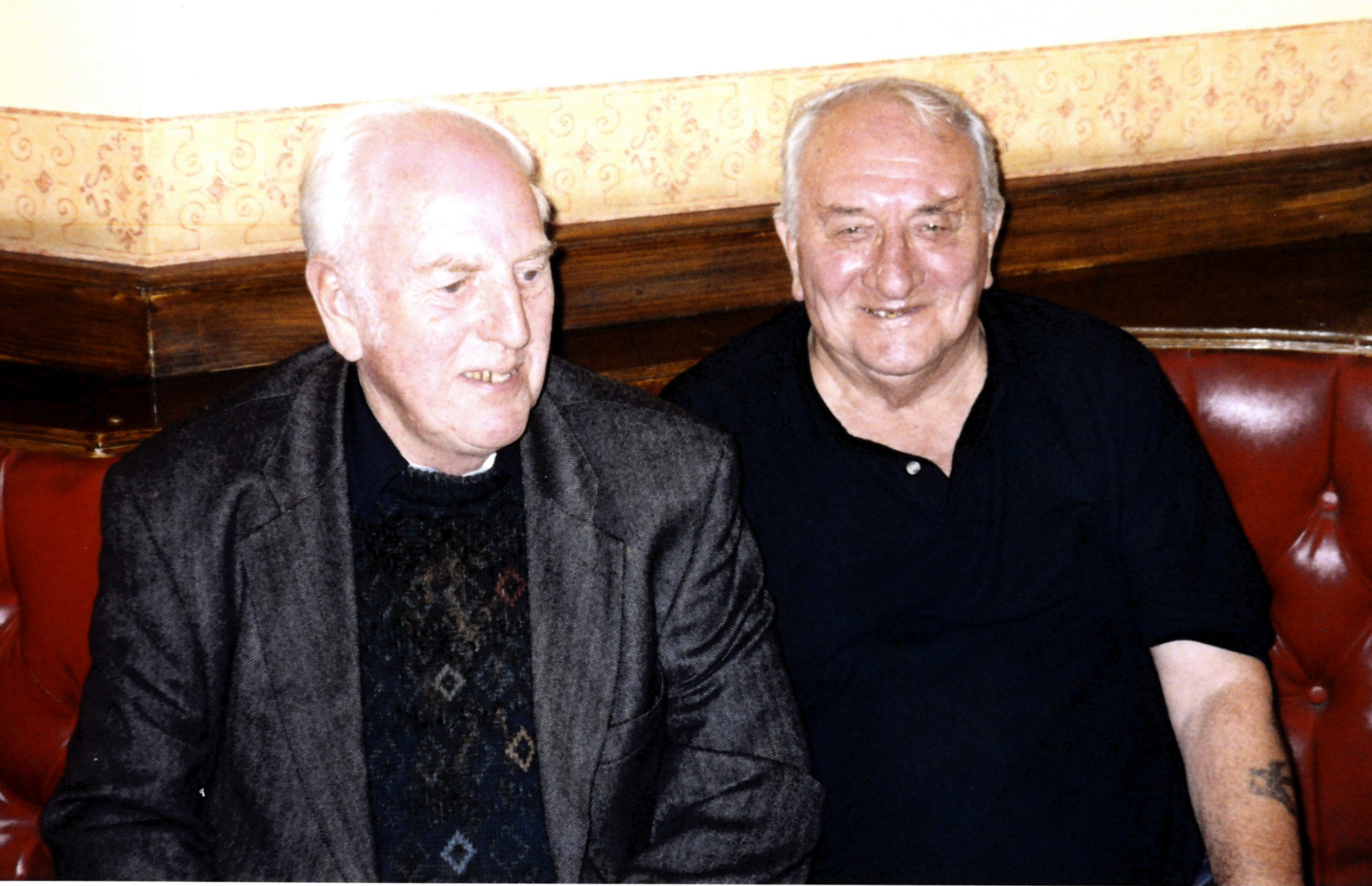
“Natural Wastage” and the Age Structure of Love Lane Liverpool Refinery
Written by Ron Noon at 14:06 on Sunday, February 07th 2021
“The dole queue on Merseyside, already one of the longest in Europe, is about to be stretched farther by the decision of Tate & Lyle to close its sugar refinery in Liverpool.” The Economist 31.1.1981
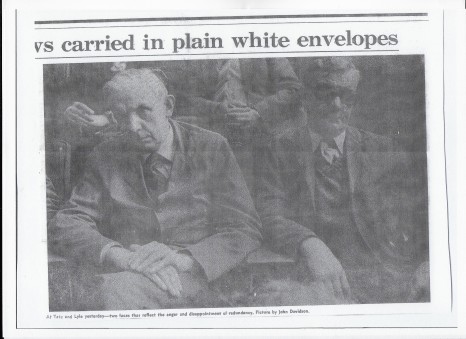
“Elderly workers get 90 day redundancy notices”
I remember Albert and John suggesting to me when I started looking through the voluminous documents they had accumulated over what was effectively a ten year struggle to try and keep the Lane open (the first rumour of closure was in 1971) they said to try and locate a document that was written by the City Planning Officer for the City Chief Executive, written a few days after the issuing of the 90 day redundancy notices. The documents were in no “order” so the eventual find was serendipitous but here’s part of what I transcribed which adds words to the picture above.
Age: Tate & Lyle have been in Liverpool for over 100 years and were well known for job security and paternalism, which has encouraged long service employment. The company has not recruited labour .of all ages over recent years and this has led to an overall increase in the age of the workforce. The Vauxhall Community Development Project (CDP) surveyed the age pattern of workers at the plant in 1973 and found that the average age of hourly paid workers (men and women)was 42years, and average length of service 14 years. Staff and management were even older with an average age of 44 years and service of 20 years. More than half the male process workers were aged 45 years or more. (See Figure 2). Consequently, the company has been able to reduce its workforce by natural wastage over recent years. However, it now means that the prospects of working again are gloomy for older workers, since they are at a disadvantage in the job market and through family.and home commitments have less propensity to move elsewhere in search of work. Long term unemployment is a serious possibility for older redundant workers; of 7,436 males aged 45 years and over registered as unemployed in the City in July 1980, 4,314 (58 per cent) had been out of work for more than a year.
That transcription is from the document I found entitled THE CLOSURE OF THE TATE & LYLE REFINERY, LOVE LANE LIVERPOOL, A BACKGROUND NOTE (CITY PLANNING OFFICER) It has the stamp of Liverpool Welfare Rights at the top right of the document and below is {Copy as submitted to Chief Executive 26.1.81]
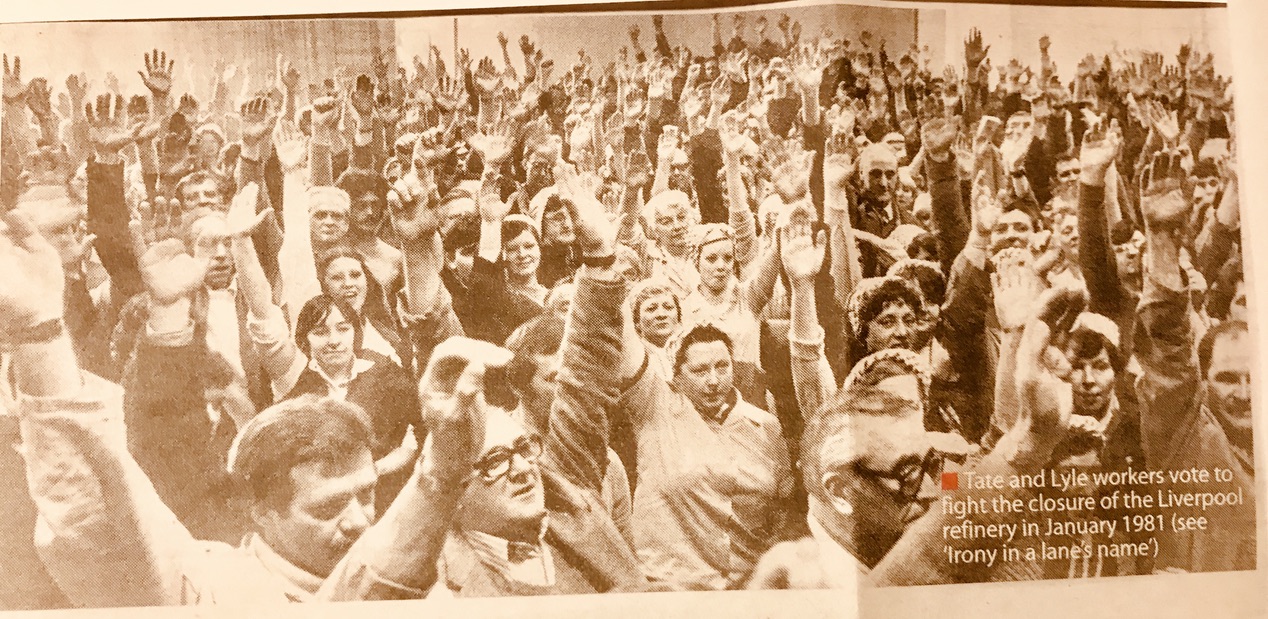
That picture of the Canteen meeting and raised hands was in the Echo then and two weeks back when my letter about the 90 day redundancy notices was published.
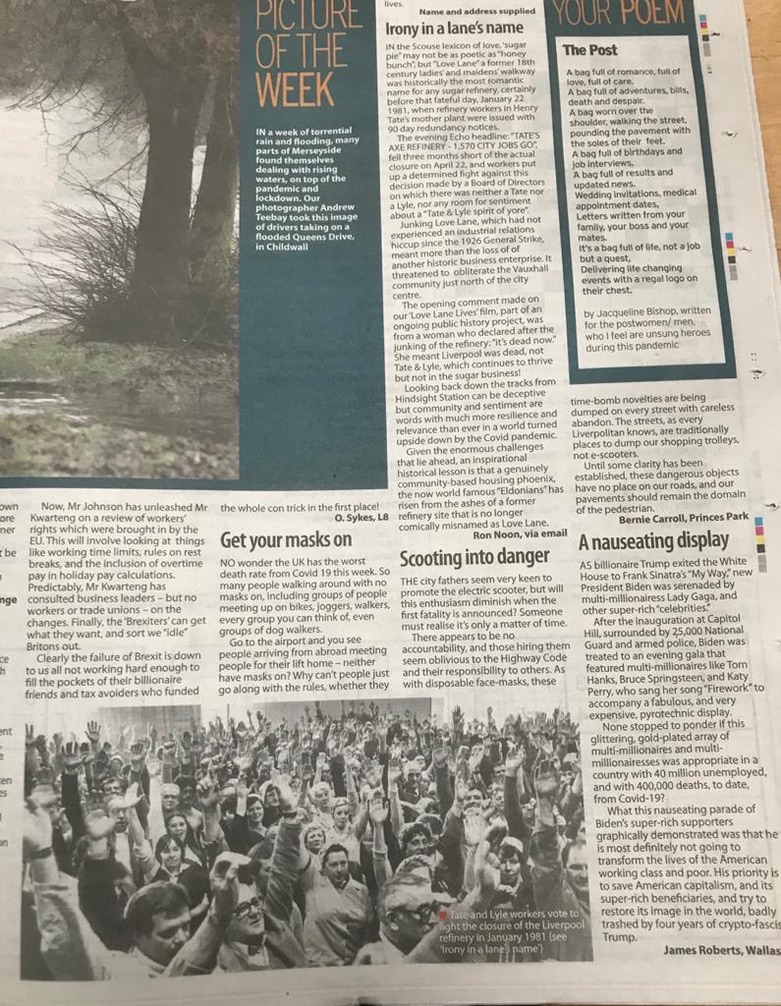
IRONY IN A LANE’S NAME
Written by Ron Noon at 14:22 on Sunday, January 24th 2021
THERE IS IRONY IN LOVE LANE’S NAME. There is irony in the fact that the only thing that mattered to me when I started my SUGAR PROJECT in 1994, mentored by Albert E Sloane and John Maclean the two leading sweet fighters in the 10 year struggle to keep the historic mother plant open, was that sugar was SWEET. THAT’S THE LAST THING I’D SAY ABOUT SUGAR NOW.
Anyway just a very short blog (historically the shortest of blogs I’ve ever done) but one that merits reflection on this historic weekend. LOVE LANE LIVES lives on and the stories of the extraordinary Girls and Boys from the Whitestuff will continue to ripple on.

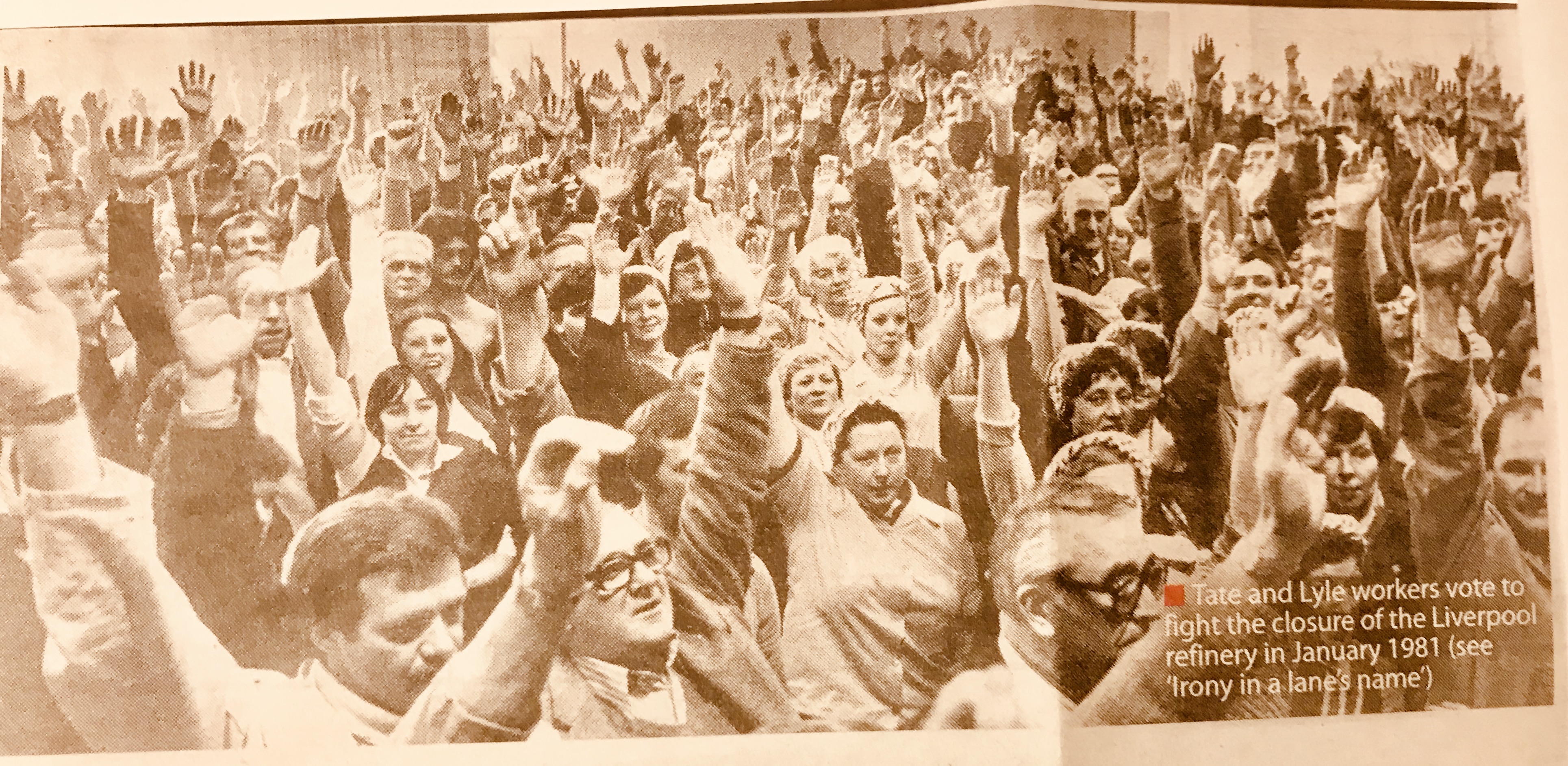
Today is the 40th anniversary of the issuing of the 90 day redundancy notices. REMEMBER BOB PARRY?
Written by Ron Noon at 14:24 on Friday, January 22nd 2021
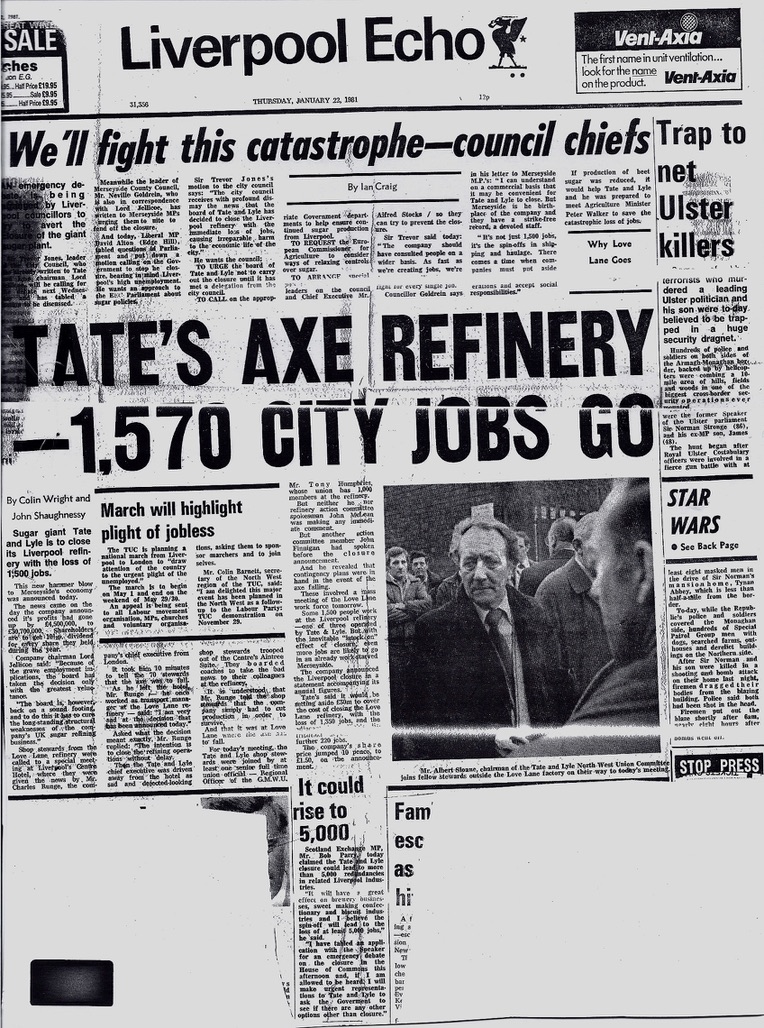 Earlier on this week I decided to compose and send a letter to the ECHO about this FRIDAY being the 40th anniversary of the issuing of the 90 day redundancy notices to the Tate & Lyle Refinery workers. There was nothing in it today and of course we don’t have an EVENING Echo published, and certainly not in Liverpool anymore, but this is what I wrote:
Earlier on this week I decided to compose and send a letter to the ECHO about this FRIDAY being the 40th anniversary of the issuing of the 90 day redundancy notices to the Tate & Lyle Refinery workers. There was nothing in it today and of course we don’t have an EVENING Echo published, and certainly not in Liverpool anymore, but this is what I wrote:
Dear sir,
in the Scouse lexicon of love, ‘sugar pie” may not be as poetic as “honey bunch” but “Love Lane” a former eighteenth century Ladies and Maidens walkway was historically the most romantic name for any sugar refinery, certainly before that fateful day, January 22nd 1981, when refinery workers in Henry Tate’s mother plant were issued with 90 day redundancy notices.
The evening Echo headline: “TATE’S AXE REFINERY - 1,570 CITY JOBS GO”, fell three months short of the actual closure on April 22nd, and workers put up a determined fight against this decision made by a Board of Directors on which there was neither a Tate nor a Lyle, nor any room for sentiment about a “Tate & Lyle spirit of yore”. Forty years ago the dramatic January announcement highlighted a Merseyside economy in Crisis, suffering disproportionately from factory closure after factory closure and aptly labelled the Bermuda Triangle of British Capitalism!
Adding to these mass redundancies by junking Love Lane which had not experienced an industrial relations hiccup since the 1926 General Strike, would mean more than the loss of of another historic business enterprise. It threatened to obliterate the Vauxhall community just north of the City Centre, prompting even the Daily Express to suggest that “whoever dreamed up that name” ought to be on the popular TV show “The Comedians”!
The opening comment made on our Love Lane Lives film, part of an ongoing public history project, was from a woman who declared after the junking of the refinery “it’s dead now”! She meant Liverpool was dead, not Tate & Lyle which continues to thrive but not in the sugar business!
Just as in 1981 when there was no room for sentiment on the Board of Tate & Lyle, history repeated itself in 2010 when their sugar business and portfolio of historic brands was sold off to an American company, ASR. Looking back down the tracks from Hindsight Station can be deceptive but community and sentiment are words with much more resilience and relevance than ever in a world turned upside down by the Covid pandemic. Given the enormous challenges that lie ahead an inspirational historical lesson is that a genuinely based community housing phoenix, the now world famous “Eldonians” has risen from the ashes of a former refinery site no longer comically misnamed as Love Lane.
Yours sincerely
Ron Noon
......................
I do intend to revive and revamp the site because my darling wife Gail would want that and another ‘EXTRAORDINARY ORDINARY person Albert E Sloane who was on the front page of the Echo 40 years ago showing his determination to FIGHT, would along with his great pal John Maclean, want that too. So little steps are being made this week because there is so much “unfinished business” to ensure that LOVE LANE LIVES do indeed live on and my wonderful wife Gail and family expect that from me.
The UNPUBLISHED LETTER was my first effort to break out, then COMMENTS I put on this afternoon on THE WEBSITE and now this third effort promoted by an email I’ve just opened from a lovely guy that I met last January around this time who was given HIS REDUNDANCY NOTICE on 22/01/1981
I’M SURE MIKE WILL not object to me reproducing what he wrote so here it is: “Hi Ron, hope you are well, 40 years ago today was my birthday. I was 19 and at Carlett Park College on the Wirral. I was there with other Tate & Lyle apprentices when I received my redundancy letter which I still have. 59 today. Where has that 40 years gone? Best wishes in these strange times. Mike Gorst.”
Happy Birthday Mike and Thanks for emailing me.
........................
So how many Remember Bob Parry?
Well 40 years ago TODAY, he stood up in the House of Commons “to ask leave to move the adjournment of the House, under Standing Order No 9”. That was designed to provoke a discussion of ‘the proposed closure of the Liverpool Tate and Lyle cane refinery”.
The speaker later ruled this out as not falling within the provisions of the Standing Order No 9, but that did not prevent Bob Parry from powerfully evoking the magnitude and seriousness of the decision that had been made by Tate & Lyle for Merseyside and for his Scotland Exchange constituency in particular.
“The loss of approximately 1,800 jobs is serious enough, but my constituency, in which the refinery is situated, has already one of the highest levels, if not the highest level of unemployment in the United Kingdom, certainly well above 50%”…The Tate & Lyle company, which made the announcement this morning about sacking these people and throwing them on the scrap heap, also announced that its profits had increased…This is the naked and vicious face of capitalism. It shows that the company has no consideration for human suffering or the degradation of people in the inner areas of Liverpool.”
That same day the London Stock Exchange reacted to the closure news and the mass job losses on Merseyside by increasing the value of the company shares by 12p!
Bob Parry targeted Peter Walker the Minister of Agriculture, noting his absence and unavailability and saying that he had a lot to answer for, having tried to ride two horses in the one race and always supporting the sugar beet lobby. (Remember the Sugar Wars were summed up pithily in the slogan, BEAT THE BEET, KEEP THE CANE! Remember also that the first rumours of closure were in 1971. That’s what Albert E Sloane told me and I have a recording of the interview with Albert which I’ll do a transcript on as we get this site and this project back to speed.) Back to Bob.
“It would be interesting if, some day, the right hon. Gentleman would tell us how much sugar beet he grows”.
Just after that comment he was reminded by the speaker that he ought not make the speech that he would make if his application were granted! (For Standing Order No.9 or Love Lane potion No. 9?)
Undeterred Bob pointed out the “right hon. Gentleman, according to the feelings of the workers in Liverpool, is a twister and has spoke in this House with a forked tongue”. Unsurprisingly Bob had to withdraw the twister tag but still maintained that “the Minister of Agriculture has sold these jobs in Liverpool down the river”.
From Catastrophic Cerebral Bleed to Covid 19: Gail and Ron and Love Lane Lives live on.
Written by Ron Noon at 16:37 on Thursday, May 07th 2020
THIS IS A BLOG DEDICATED TO MY DARLING WIFE GAIL who despite the gloomy prognosis of 5 years back is still alive and fighting. Viva my darling Gail.
This is what I wrote five years after the GENERAL ELECTION DAY May 7th 2015. It was not easy:
When I reflect back on the last five years of being my wife’s patient carer, one incontrovertible, inspiring fact drives me on, the sheer tenacity and determination of my darling Gail, mother of our Matty, Luke, Ben and Jessica and grandmother of our eight grandbairns, to LIVE! I know that Gail force better than anyone and why she will eventually get back to where she once belonged, the Noon family home in Allerton. In all of the time she has been away from Greenwood Road, a half decade that could be labelled “from catastrophic cerebral bleed to Covid 19” her indomitable fighting spirit has transcended adversity and near death situations! Catastrophic does not require elaboration and the totally random incredibly cruel stroke that hit Gail in our lovely home on the night of April 7th 2015 threatened to send her into oblivion. That stark prospect was what was relayed to one of our sons as I clung on desperately to hope, not knowing that the initial prognosis was dire. Luke was told his mum was unlikely to get through the night.
My gorgeous Gail our family jibber jabber does not speak. Imagine experiencing an intensely personal trauma and not being able to speak about it! My Gail was an infectiously entertaining conversationalist and then a wickedly cruel stroke deprived her of that capacity to talk, to express her thoughts and feelings in words! To me that’s “locked in” in a very scary diving bell reality that could so easily kill spirit and body. The brain baffles even the most sophisticated of neurologists as I have discovered in my speaking role as Gail’s patient carer over the last five years. I’ve been her non-verbal communications “translator”, Gail’s everyday reminder of whats going on in the family and in the lives of our dear friends. Visiting her every day, showing videos, pictures, cards, letters, playing our favourite songs and music and even reading Jane Austen novels and playing the Archers for Gail, was matched with a pragmatic determination to keep up and persevere with building links with the Walton Centre in Aintree about Gail’s “rehab potential”. We very nearly lost our Gail five years ago but she’s still “keepin’ on keepin’ on” so that’s why we continue to fight for THE FORCE, our family lodestar.
The recurring question making me feel nauseous on many occasions was pedantically posed throughout this trauma. From the Liverpool Royal’s Intensive care Unit, then High Dependency Unit, then the Walton Centre, an internationally acclaimed Centre of Excellence for Neuroscience out at Aintree, the constant refrain was “is this as good as it’s going to get”? Nah! Our Gail continued to baffle the gloomsters despite or maybe because of that much repeated question. I am convinced that is why with intense efforts to keep Planet Hope and Planet Reality in alignment, the eventual outcome was better than “this is as good as it’s going to get”. In April of last year the Walton Centre and Lipton ward came up trumps. Gail began a process of “decanulation” three years after a doctor had said to me that he feared that as long as she lived she would have a “traccy”. My Gail proved that she was not going to act out that role, not going to accept that fate. Towards the end of last year her tracheostomy was removed qualifying her to move away from an historic hospice in Crosby which specialised in palliative care to the more stimulating environment of a residential home close to our family home in South Liverpool.
My Gail is no more than a mile away but her residential home which proved to be far better than I ever could have hoped in terms of stimulus, loving care workers and walks in the nearby Clarke Gardens, has been locked down for two months. I can remember vividly walking Gail around Clarke Gardens, taking her into the Pub in The Park then returning to the Kingswood Manor on Wednesday 11th March. The decision had been made to lockdown and it was achingly agonising to grasp that when I left Gail that night I would not be able to do what had become the norm of just popping into the manor anytime I wanted. Not having to drive through to Crosby, sometimes indeed leaving the car in the road and walking a mile to KM was an enormous boost. We were making such progress and always reflection on when the summer came I could walk her back to our family home. LIFE IS WHAT HAPPENS WHEN YOU’RE BUSY MAKING OTHER PLANS.
Catastrophic cerebral bleed to Covid 19 is not just a label. It’s a massive challenge for my Gail and I, an even more important spur to keepin’ on keepin’ on. The aching agony of not being able to see feel or touch the one you love is the experience of so many other people like me. I’m not alone. It’s really painful. “We” in this sense are all in it together especially when you ache waiting for the face time video or phone call. That said when at 8pm tonight I opened our front door to join in with the other residents in our road to clap our heroes in the NHS I was much more alert and mindful of other key workers in what has bee very much a “subaltern sector” of social care and residential homes. The wonderful carers who suffer low pay, zero hour contracts and YET consistently and bravely go far beyond their “job definitions” and contract terms, deserve so much more than claps. Hypocritical and duplicitous government ministers sound FLATULENT after 10 years of implementing cuts and austerity measures. They have also deliberately emasculated the local authorities who have not got the resources to match and fund their knowledge of what is needed “locally”. Tory Government sound bite representations are at variance with the realities we live and experience. Ideologically inspired austerity and slashing of NHS resources has proved disastrous and the result has been a generalised unpreparedness for the magnitude of a pandemic that far transcends Flu.
So once again, Viva the NHS and the Social Care Sector and lets ensure that our heartfelt claps every Thursday at 8pm translate into more than another five years of insidious cuts and privatisations.
In 1945 A people’s war demanded a people’s peace and the building of that jewel in the crown of the Welfare State, the National Health Service in 1948.
So whether it is VE day 75 years ago or now in the era of Covid 19, there ought not to be a return to BUSINESS AS USUAL. To quote Andy Burhham the Manchester Metropolitan mayor we have to BUILD BACK BETTER. My Gail deserves nothing better.
So this is what I wrote FIVE YEARS AGO:
Vote for my Gail and the defence of the NHS
Written by Ron Noon at 05:55 on Thursday, May 07th 2015
“Homes, health education and social security, these are your birthright.” Nye Bevin.
There’s a myriad of issues that influence how we vote but as I stood in the Polling Station at Booker Avenue Junior School, there was decidedly only one, containing three logo letters that have been systematically and insidiously abused by this shameless ConDem Government. They symbolise our once universal public healthcare system, the NHS. It is that same NHS and it’s Liverpool Royal Hospital Intensive Care Unit with it’s wonderful doctors, nurses, cleaners and carers that has kept my beloved wife Gail alive this last month and given my family and friends some hope that she will eventually pull through from the totally random but potentially fatal stroke she suffered on the evening of April 7th.
All my teaching, all the public history research, all the sugar blogs and involvement with the boys and girls from the whitestuff, has been supported and lovingly encouraged by my Gail and our four wonderful children, Matthew, Luke, Ben and Jessica. It is only now that Gail is stable in the High Dependency Unit and after brilliant caring nurses have “dictated” that my visits are restricted to “official” visiting times, (ending my overnight stopovers with Gail) that I can write these words down. I hope that these little black markers on the screen convey some of the passion that my family feel for protecting an NHS that ought to remain as an example to the world, and cease to be threatened by the despicable privatised dreams of Lynton Crosby and his Tory party privateers.
Gail’s dad’s generation would ask “is this what we fought the war for” to see the jewel in the crown of the People’s Peace settlement, the National Health Service that cares for all citizens, when needed, free of charge, funded by taxes and national insurance, run like a supermarket after being invaded by for-profit corporations? Are those three wonderful letters, NHS to be reduced to a badge on Jeremy Hunt’s lapel? Small wonder that the aggressively acerbic playwright Dennis Potter declared after calling his cancer Rupert, (no friend of the owner of the SUN) that the trouble with words and letters is that you don’t always know whose mouths they’ve been in before!
NHS in the mouths of the Tories and Lynton Crosby that so called master of the political dark arts, the man behind the efforts to get this contemptible Government re-elected today, are merely modulations of sound that convey no meaning, no significant reality, NO HOPE. I’m sorry my Gail, but these privateers are farting through the wrong orifice, and that is why I theatrically asked at the Polling Station a couple of hours back whether I could register a proxy vote for you today? I did not elaborate about the fact that you are fighting for recovery in the High Dependency Unit in the Royal but I just wanted to say it was only because you were ill that you were not there with me. I knew when the young teller called his supervisor that it was patently not possible but I wanted an official response so that I could declare that my vote was always for you anyway. It would be a shared vote, like our shared lives, for the NHS that only Labour can defend from the venal Tory “souls” who only ever worship mammon.
Viva my Gail. Viva the NHS. Viva our friends and family on the BOYS AND GIRLS FROM THE WHITESTUFF site.
Vote for my Gail and the defence of the NHS.
REAL TIME IS 13.10 hrs
Visiting time starts 1400 hrs. I’ll tell Gail about this when I get into the Royal. We’ve got to talk and stimulate her back to full recovery. Labour represents decency and the protection of what she and I cherish, a just and fair society.
The Mr Cube General Election, February 23rd 1950
Written by Ron Noon at 17:10 on Sunday, February 23rd 2020
The weather when I woke up this morning was lousy but at least it brightened up later. Seventy years ago however on the 23rd of February 1950, “rain spread slowly eastwards…and by evening…was enveloping the whole country in a steady unrelenting downpour”. Weather in itself is hardly reason enough for 70th anniversary status but this was n’t just any other foul weather day. It was the day of the General Election called by Clem Attlee the previous month and unlike any previous or subsequent British General Election this one was decidedly also about sugar and in particular the psephological impact (statistical study of elections) of a campaigning sugar lump with squiggly arms and legs and a devastatingly effective repertoire of anti-socialist propaganda. This was the Mr Cube General Election and the unrelenting rain meant that there were sodden queues “outside town halls and schoolrooms all over Britain”. But when the polling stations closed for “the weary, wet tellers outside”, it was clear that this “had been a phenomenally heavy poll”.
Sugar! When Clem Attlee’s radical Labour government’s plans for nationalisation of sugar refining leaked out in early 1949, who except the Prime Minister could have guessed when Parliament would be prorogued and a General Election called? Who including Attlee could have imagined that a major influence on the eventual outcome of the election whenever it was called would be a cartoon sugar lump armed with the sword and shield of private enterprise, appearing for the first time in the Daily Express on July 28th 1949? He appeared on millions of Tate & Lyle (T&L) sugar packets advertising “Tate not State” and brazenly challenging electoral law and Inland Revenue regulations. His turbo charged public relations campaigning was aided by Aims of Industry (AOI) the “PR Storm Troopers” who helped organise a blitzkrieg of propaganda against this historic Labour Government.
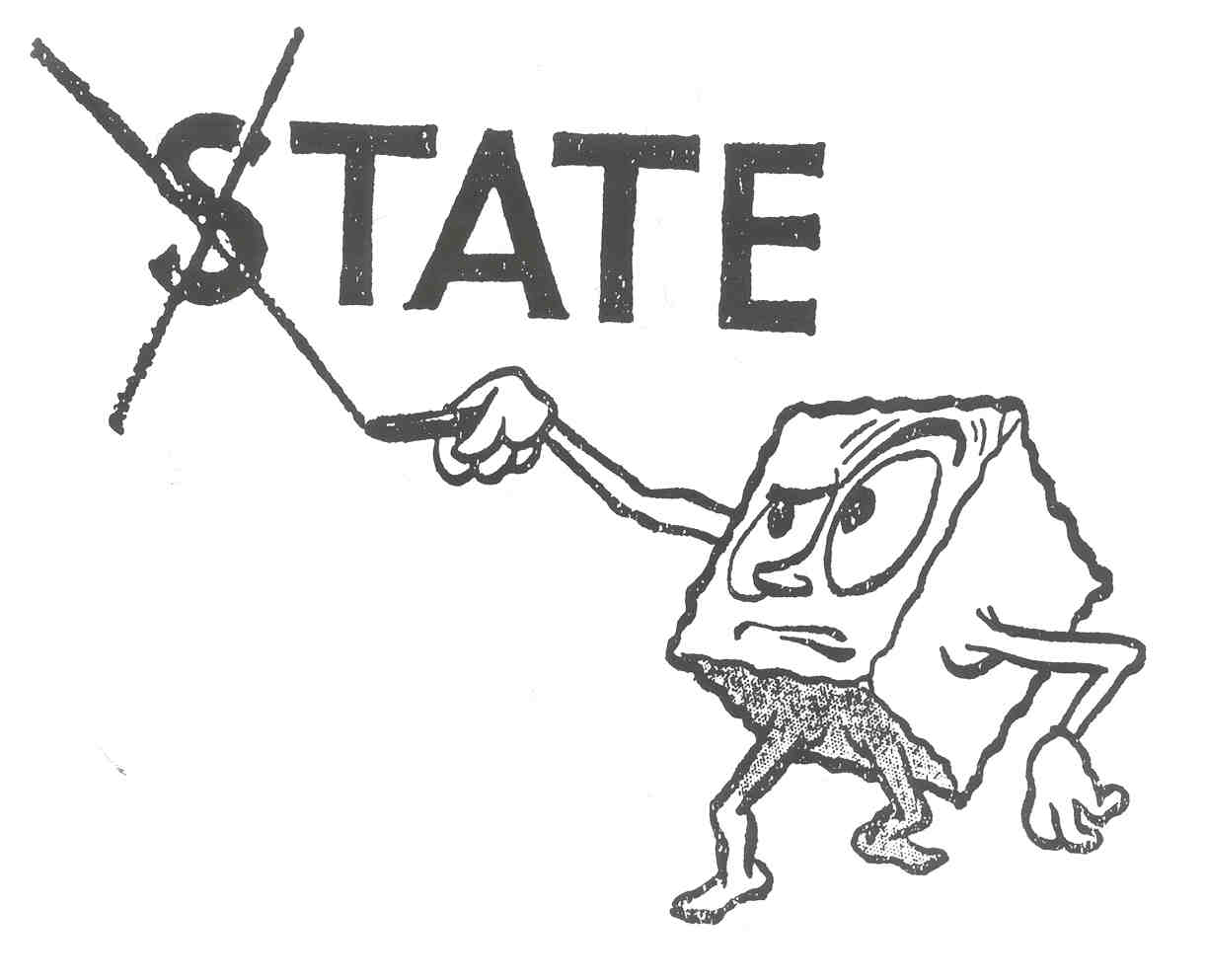
Because AOI were registered as an educational charity the material was also sent out to schools! AOI believed in free enterprise and had been set up in 1942 when HG Starley of Champion Sparking Plugs Ltd called a meeting of top industrialists and warned them to be prepared to launch an offensive against socialism. It was sustained by contributions and support materialising from a variety of lucrative sources including Associated Electrical Industries, Cortalds, Doulton, English Electric, Ford Motors, Handley Page, Imperial Chemical, Rolls Royce, the Cement Marketing Foundation and of course Tate & Lyle.
Aims of Industry was a non-profit making PR organisation selling private enterprise ideals, so being registered as an educational body was cunning to say the least! Together with another PR group, The Economic League, they persistently refuted Labour allegations that they were political. This actually helped secure admission of its speakers and films to schools, churches and even armed forces study groups! For right wing propaganda to be purveyed as a legitimate educational project was especially galling to Socialists desperately needing to win the battle for hearts and minds when common cause and common sacrifice was impossible to recreate as vindication for a post-war world of “unnecessarily” prolonged austerity and shortage. Sydney Finer writing in 1956 suggested that AOI and similar groups were only non-political “in the technical sense…that they are not affiliated to the Conservative Party nor do they subscribe to or receive subventions from it”. They were “Specialized Propoganda Organizations of private Capital”, unfettered, unlike Government, by the “constitutionalist” dilemma over what to advertise and its financing from a restricted and constantly scrutinised public purse. Politically active client companies like Tates were always able to deny their politics precisely because of the success of this combative propaganda. Peter Shore a Labour MP sagely observed the fact that “propaganda for free enterprise reaches the public in a most effective way, for it does not appear to be propaganda or to have any connection with politics”.
Mr Cube also proved a very adept friend of the Conservatives (Leonard Lyle T&L company president was a former Tory MP and close friend of Winston Churchill) and of course all their supporters in Fleet Street. The help of a largely Conservative press in bloodying Labour’s nose in February 1950 was recognized by Anthony Hugill, who like Peter Runge a T&L director working alongside him, was another shrewd strategist in the campaign. His gratitude was extended to Government adversaries as they were the ones responsible “to a very great extent for the sudden and overwhelming success of Mr Cube”! Some of their assertions “on sugar refining” and “election expenses” had informed the public “to an extent which we could never have achieved without their aid, and all of this without having to pay them any plugging money”! Hugill reminisced in Sugar and All That (1977) how the anti-nationalisation campaign was “not T&L’s nor Lord Lyle’s but Mr Cube’s”. His psephological excess was remarkable in an era devoid of electronic and instant communication media, when mass communication meant the press and “BBC steam radio”.
All of this was happening long before the Prorogation of Parliament was announced on January 11th 1950 and despite the command from Leonard Lyle that Mr Cube “must always be a knight in shining armour” never “a psalm singing little bugger” History’s most famous sugar lump proved precisely that especially to Labour Deputy Leader Herbert Morrison. (Peter Mandelson’s grandfather.) H G Nicholas the electoral historian argued that “few British general elections…have cast their shadows so long before” and even Attlee’s pronouncement provided an “unusually long notice of dissolution”. The Conservatives claimed that “it was timed to embarrass all the private champions of industries threatened with nationalisation” who could no longer insist that “their propaganda was ‘outside’ the election”. It would not deter Mr Cube.
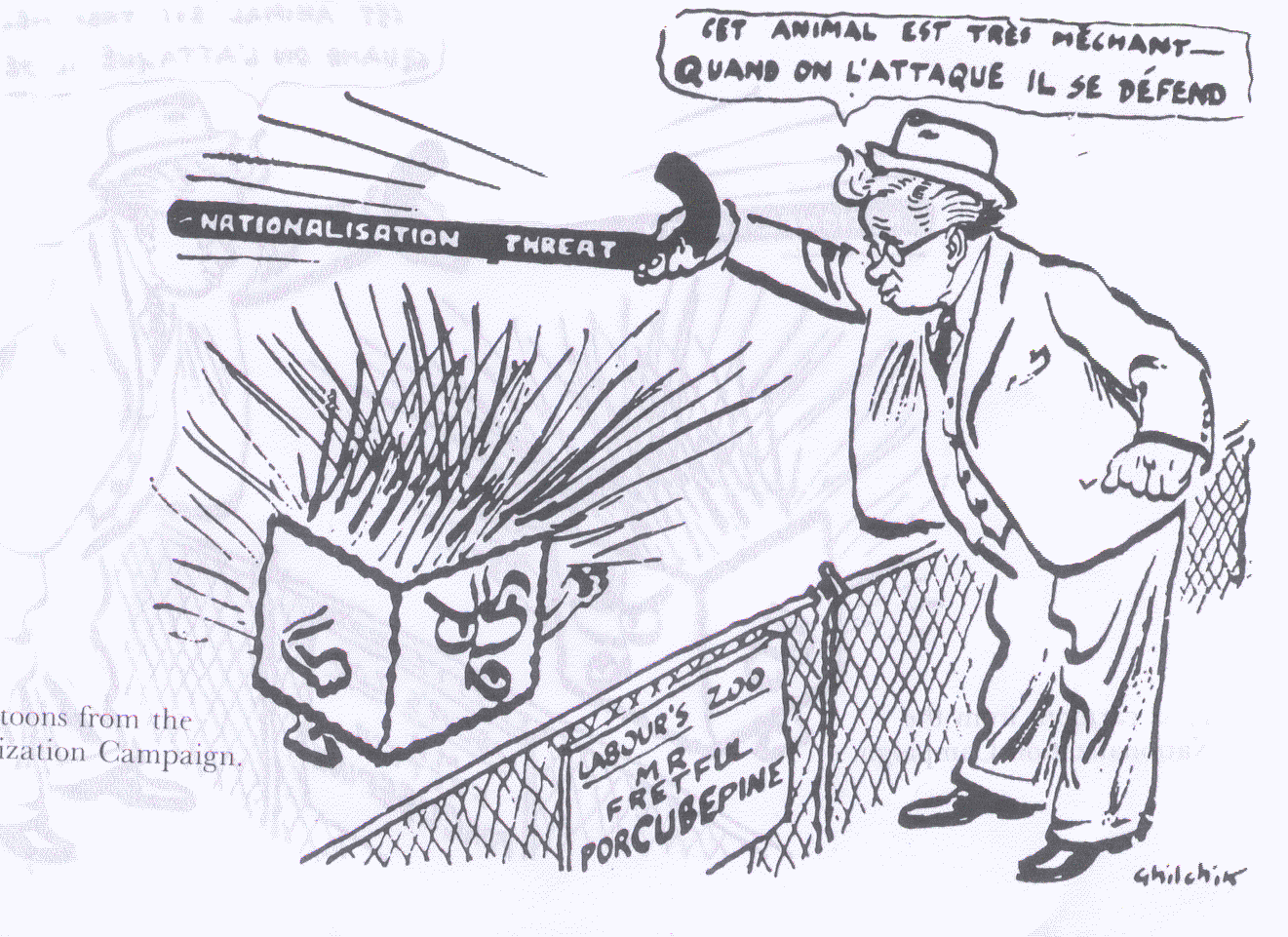
Those who waited up all night as the results came in included those in the Mr Cube campaign team. One of these was the man mentioned earlier, Anthony Hugill. He was a young Oxbridge engineer who had joined the Imperial Sugar Giant Tate & Lyle after the war, (awarded the Distinguished Service Cross, French Croix de Guerre, mentioned in dispatches). He recalled how “people sat up all night listening to the radio, cups of tea or glasses of something stronger at hand”. The Labour landslide of July 1945 seemed eons ago as the dream of a New Jerusalem was eclipsed by the everyday reality of austerity rationing, queuing and the conspicuous absence of the promised “sweet things in life”.
An excited Hugill was sat in the company boardroom with Peter Runge, a Tate & Lyle director who also figured prominently in“Mr Cube’s election campaigning”. There is however no mention in Sugar and All That, what they had in hand awaiting the dawn, but the Director’s exclamation, “by God we’re going to beat the buggers” does suggest a degree of alcohol induced over-optimism! Still a comeback from 186 in the first leg to 6, 70 yrs ago was a remarkable achievement for a Tory party that in 1945 had seemed in almost terminal decline.
Postscript:
AOI were dubbed an “underground Tory organisation” but this was technically incorrect. The Home Secretary Chuter Ede speaking in the House of Commons in December 1949 referred to a letter he had received from 48 Guilford Street, the Luton office of AOI which was “the side entrance to 58 Bute Street, a Tory Office”. A search for AOIs telephone number educed “the statement from directory inquiries that this organisation is not known to them” but “it is possible to obtain them by ringing Luton 4500 which is the same number as the Tory Office”! The Tories unlike Labour’s later problems with “deep entryist” Trotskyist organisations, left the side door open to covert friends.
Finally the famous political historian Peter Hennessy in NEVER AGAIN: BRITAIN 1945-51 provides sharp personal insight into the significance of Mr Cube. Nobody had perceived any problems with their sugar and syrup and all Labour’s manifesto did “was to stimulate a quite brilliant political advertising campaign” in which Mr Cube not only “brought political argument to every breakfast table in the land” but was “almost certainly my first encounter with politics”!
39th anniversary of issuing of 90 day redundancy notices for the girls and boys of LOVE LANE LIVES
Written by Ron Noon at 17:50 on Wednesday, January 22nd 2020
History is not just about the past! The past plugged into the present has the potential to remind us all HOW we arrived where we are NOW. In that sense good HISTORY is always present minded and it’s DYNAMIC is that constant dialogue between past and present. “Hindsight Station” is a concept/place I used/abused frequently with my students to remind them albeit in figurative language of not only how we got to where we are now but also to inform where we might go TOMORROW. History is not just about dates and “developing the memory at the expense of the intelligence” but analysing and interpreting options for a better future. THAT DEMANDS INTELLIGENCE.
Steady on Ron. This is a late night blog and it needs a little more direction in terms of what was ADVERTISED.
OK. Sorry about that trip the light fantastic intro, but I wanted to pace this blog very GENTLY given the incalculable PAIN and SUFFERING that the 90 day redundancy letters inflicted in that historic sugar land just north of Liverpool city centre. It’s always easier to forget than to remember recurring themes of avoidable community blight. Tate & Lyle put a big HOLE in that sugar land community and a key fact I discovered very early on in my research was that they were the biggest recipients of regional aid between 1975 and 1981, which they used a little bit to ‘pay’ for that hole in LIVERPOOL’S SUGARLAND. That said I can’t deny what so many people who’d worked down the Lane threw back at me as the BAMBER GASCOIGNE look a like university lecturer, about it being a “good firm to work for”. Tates’s had for a long time successfully projected themselves as a FAMILY FIRM. (There was neither a Tate nor a Lyle on the company board when the matricidal decision was taken.) Good analytical history is about testing and evaluating the REPRESENTATION/REALITY theme. Tate’s loved the PATERNALISM representation but was there really any evidence of that in the company decision to issue 90 DAY REDUNDANCY LETTERS to over 1500 Love Lane refinery workers on this day 39 years AGO?
FAST FORWARD in this DIALOGUE between past and present to JANUARY 20TH 2006 when I issued TATES with a 90 day Redundancy PARTY letter. I knew a lot more about SUGAR then and a great deal more about this soulless global corporation.
Dear Mr Ferguson,
I am a history teacher from Liverpool and next Sunday, January 22nd, will be the 25th anniversary of the issuing of 90 day redundancy notices to 1500 refinery workers at Henry Tate’s mother plant, Liverpool Love Lane. It is not exactly the kind of historical fact that is studied on the National Curriculum but it has a real resonance here on Merseyside, where the surviving “boys and girls from the whitestuff” look back nostalgically to the days when they helped sweeten the nations breakfast tables.
For me the only thing that mattered about sugar when I started to research Liverpool’s refinery workers, was that it was sweet, but that is the last thing that can be said about the history of the “white stuff”. Far be it for me to give you as the Chief Executive of a Sugar Giant known here as “Tates”, a history lesson, especially when you are married to a lady with impeccable historical credentials, but my brief goes beyond historical themes. It is to make a request on behalf of the Tates Liverpool pensioners, the late Peter Leacy, Tony McGann of the Eldonians, Alan Bleasdale, Jimmy McGovern, Brian Reade, Jack Jones, and Tony Benn, that Tate & Lyle plc finance a reunion of the former Love Lane employees, either on or after April 22nd, the fateful day a quarter of a century ago when after 109 years of operation on the romantically named site, sugar cane time came to an abrupt end in Liverpool.
Our famous port city’s history is inextricably linked up with the politics and power of sugar and of a once prominent landmark, just north of the city centre, where the world’s biggest sugar dynasty was established in 1872. Facts like that were relayed to me by so many of your former Liverpool employees in friendly interviews where many talked about “family spirit” and the company being a “smashin’ firm to work for, most of the time”. Sadder tales were recounted however, and Mr Leacy, a proud former Tates pensioner visitor, told me of his bitter disappointment over the scrapping of the “biennial Christmas party” at the Britannia Adelphi Hotel, in December 1999 and of the disappointing responses to a letter he sent your predecessor, Larry Pillard, in January 2001.
Mr Leacy’s letter was written three weeks before the 20th anniversary of the issuing of the 90 days redundancy notices, and requested a final party bash! “The month of April… calls to mind the end of sugar refining at Love Lane factory in Liverpool, and your board of directors may wish to mark or commemorate the event to acknowledge the contribution that the many thousands of sugar workers made in over one hundred years to the well being, the prosperity, and the success of Tate and Lyle…May I therefore prevail on your good self, and your fellow directors to stage a final, one-off, never-to-be-forgotten farewell to Love Lane party at the very place of so many happy T&L get-togethers…the Adelphi Hotel in the City of Liverpool, on or near the date in April 2001. May I?”
He was then informed by Mr John Walker acting on the CEOs behalf, that because the company was having difficult times, reflected in a low share price, “I don’t think we could justify the kind of expenditure that such a party would require”. We hope sincerely that is no longer the case, especially given the lead your company took in the Footsie 100 just before Christmas last year.
Mr Leacy also described to me a cameo scene from the “last supper” on Lime St in December 1999 which I hope informs your response to this letter. “Mr Richard Springford, the ‘human resources’ supremo from T&L London, for whom I had worked during my southern sojourn, was appointed to deliver the final address of welcome and farewell at the Adelphi. I was annoyed when no senior staff person or ex Love Lane personnel bothered to reply either in gratitude for past Christmas dinners or to express regret at the ending of them. So I introduced Mr Springford to my old T&GWU shop steward, Bob Bannister who asked a very valid question…... ‘Would it spoil some vast eternal plan if these Christmas get- togethers were to continue every two years, after all in ten or fifteen years most of us will have left for greener pastures?’.”
Precisely! Sadly Mr Leacy passed away last June. So having discussed a number of options and after talking to his twin nieces, Sheila Sullivan and Councillor Sharon Sullivan, the course of action that has the backing and support of the names I quoted earlier, is to formally issue you with this 90 DAY REDUNDANCY PARTY NOTICE!
Yours sincerely
Ron Noon
That letter prompted more than a response from Tate & Lyle and a reunion bash of the surviving girls and boys from the white-stuff was financed from their head office, with “our committee” firmly in charge of it’s organisation and publicity. Research and writing does matter.
OK guys, here’s the POSTSCRIPT.
I HOPE this conveys why HISTORY IS FAR TOO IMPORTANT TO BE LEFT TO PROFESSIONAL HISTORIANS.
We all have the gift to make our own history and what follows below is a great example of PRECISELY that.
There’s a lovely lady who I introduced myself to last Sunday, 20th January, to present with a birthday card from Gail and I. She was 106 years young and looked and sounded brilliant. It was a privilege to be with her and later on that day I met up with some of her lovely family. Today as a belated birthday treat she was taken out from Kingswood Manor, Woolton Road, South Liverpool, in a classic car. It made me put on my historians head gear to introspect not just in terms of my beloved Love Lane Lives project and the fact that today is exactly 39 years since over 1500 workers at Henry Tate’s mother plant were handed their 90 day redundancy notices, but also of the lovely lady’s birth year, 1914. I searched some of my files and re-discovered my notes for a talk I’d once given. It went like this:
On 3rd August 1914 Sir Edward Grey the British Foreign Secretary proclaimed: ‘The lamps are going out all over Europe, we shall not see them lit again in our lifetime’. His famous quote is a literary and figurative way of dramatising the crisis that would very soon plunge Europe into Total War and four bloody years of death and darkness.
Light provided by gas lamp in 1914 is bestowed by far more sophisticated means in our 21st Century but not knowing what tomorrow will bring, not knowing whether it will be brighter or darker, is our perennial human condition.
So in thinking back to August 1914 and his efforts to evoke the poetry of history I’m going to quote the famous historian G.M. Trevelyan. He was born in 1876 two years before EVERTON FOOTBALL CLUB (EFC) was born, a birth some, admittedly partisan blue noses, “myself decidedly so), would suggest was akin to a blazing star lighting up over the River Mersey.
He died in 1962, the year that the Beatles released LOVE ME DO but below is his inspirational insight into that constant dialogue between the past and the present. If you’ve never heard it before cherish it’s message as I certainly did when serendipitously I came across it as a young student:
“The poetry of history lies in the quasi-miraculous fact that once, on this earth, once, on this familiar spot of ground, walked other men and women, as actual as we are today, thinking their own thoughts, swayed by their own passions, but now all gone, one generation vanishing into another, gone as utterly as we ourselves shall shortly be gone, like ghosts at cockcrow.”
Like ghosts at cockcrow! Oh how I love that word and it’s unmistakably universal sound. It is the Dawn, it is daybreak, break of day, crack of dawn, sunrise, first light, first thing in the morning, early morning. It’s as irreversible as day following night. That’s COCKCROW and as a poem it’s feathered and beaked with HOPE.
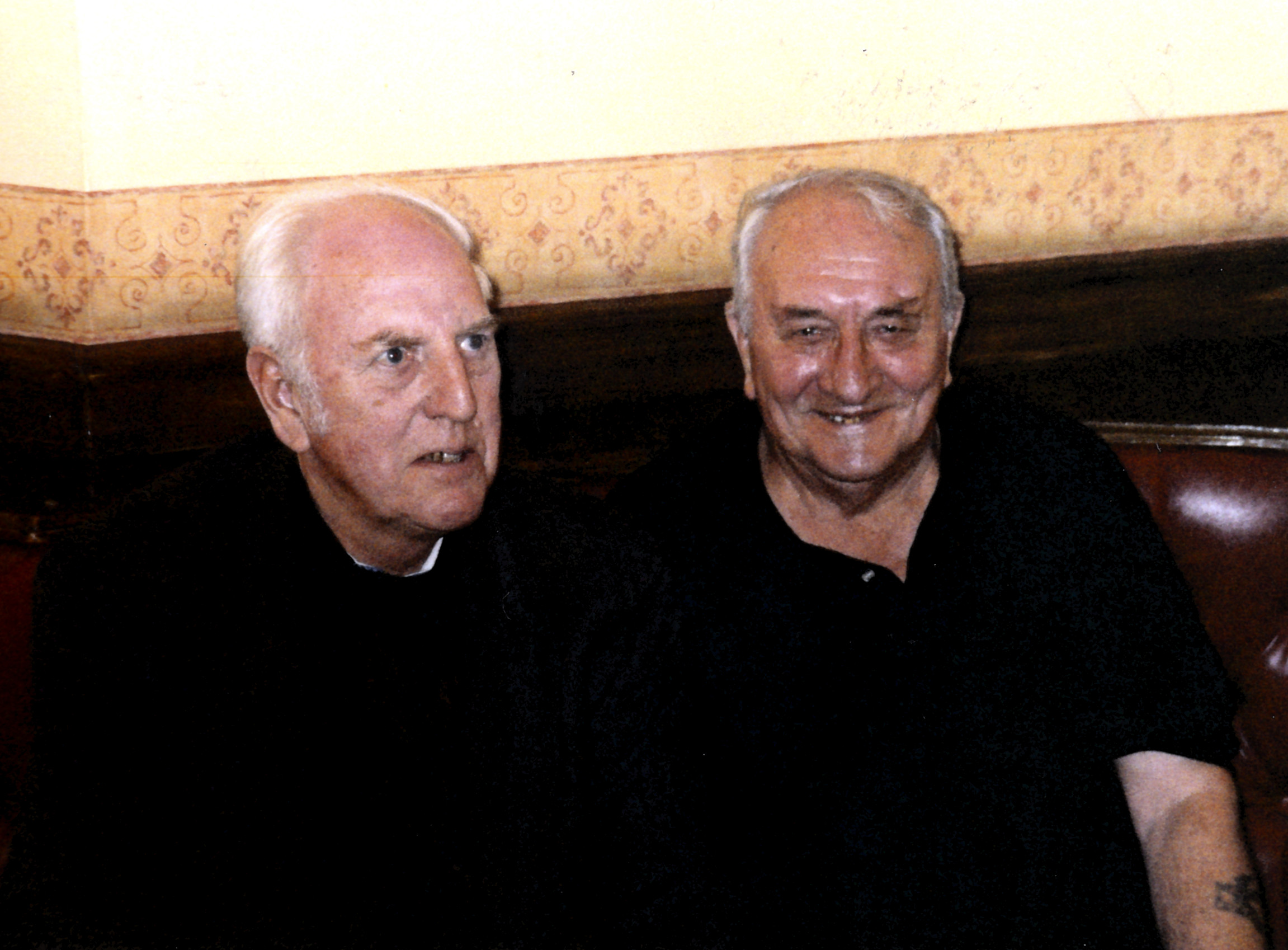
The 1999 story of a lump of sugar
Written by Ron Noon at 17:08 on Monday, December 02nd 2019
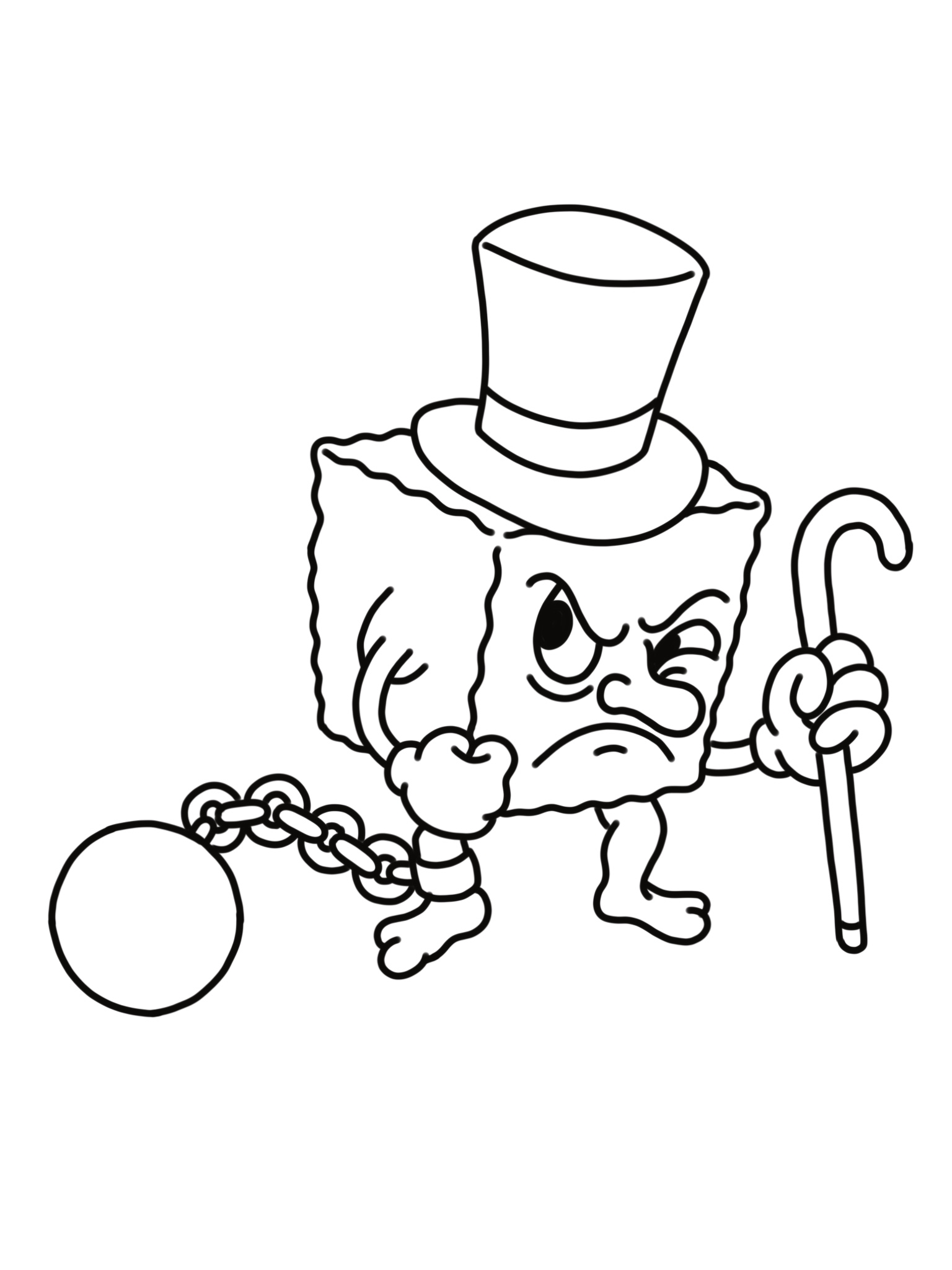
FACT OF THE DAY
It was 20 years ago today on a bitterly cold Thursday afternoon that the former Tate & Lyle workers from Love Lane had their last Christmas bash, beneath vivid streamers strung across the banqueting hall of the Adelphi Hotel. The boys and girls from the white stuff had refined and packed the bags which had sweetened the nations teas and breakfasts but sadly Tates’ “need to continually review and reduce costs” on the threshold of a new millennium, transformed Xmas into a last supper on Lime Street.
Sugar’s not just any old banal everyday commodity. It’s a perfectly legal, achingly addictive drug that like Elvis and sex is here there and everywhere and it’s a killer. Readers know I’m not sponsored by Tate & Lyle and that the only thing that had really mattered to me before I started working through the documents on the ten year struggle to keep Liverpool Love Lane refinery open was that it was sweet. I soon discovered that was the last thing to be said about it’s infamous history and August Cochin, summed this up brilliantly. “The story of a lump of sugar is a whole lesson in political economy, in politics and also in morality.” My summary section may appear as a crude paraphrase of that sweet gem but my objective is to underscore Cochin’s scholarship and it’s relevance to the political and public relations consequences of “Mr Cube”. Why was a Labour majority of 186 in 1945 reduced to 6 in February 1950? What did Mr Cube have to do with that?
As I mentioned in the last blog Mr Cube reached 70 years of age in July of this year. “He was no ordinary sugar lump and arguably the most famous of all the trillions and trillions of sucrose cubes ever produced. Animated by squiggle for arms and legs and the sword and shield of Free Enterprise Capitalism he took on and defeated” Clem Atlee’s plans for nationalising sugar refining. (Worse than a little bugger for this historic Labour Government.)
Sugar was both fact and metaphor for the sweet things in life that were conspicuously absent when children would suck carrots for sweetness. The post war period witnessed years of generalised austerity. That said compared with today, the austerity in Britain followed on a devastatingly damaging world war unlike the deliberate Con-Dem and Conservative political choices of this millennium! An attempt to de-ration sugar was made but it was a failure. This is what I wrote in an essay written in 2007:
A cameo of this early predilection towards the good life as the sweet life was the experiment in de-rationing sweets. When carrots were sucked by children as sweets, Pathe News recorded the events in April 1949 that were designed to “put the fun back into being young” with its film footage of tiny tots queuing in anticipation of sweet shops opening up with their de-rationed goodies.
“Tots mouths have watered a whole lifetime for this great day. For years they’ve been cheated by the hard facts of world economy, from the unrestricted orgies, once accepted as the birthright of every child. But now hundreds and thousands are back by the billions, sherbert and gobstoppers and aniseed balls, lollipops and chocolate bars. And now for the Tummy Ache of a lifetime.”
The anticipated epidemic of tots tummy aches was prevented by killjoy Food Minister John Strachey who did not build up sufficient stocks to meet the pent up demand and failed “to take into account considerations such as the present high cost and shortage of tobacco, the cut in our meat ration and our dull diet”. 33 The disappointing result was that unlike France, Holland, Belgium, Luxembourg, Poland, Switzerland and Eire, Labour Britain botched the experiment in assuaging dietary severity with sweets.
Fast forward to 1999. I wrote this not long after the Last Supper on Lime Street:
“Tate & Lyle’s metamorphosis from a family firm into the financial community of transnationals has inexorably witnessed a withering away of local roots and loyalties. Global perspectives and significant organisational and personnel shifts, have seriously compromised the Sugar Giant’s paternalistic image, at least in Liverpool. Up until this month though, the end of sugar cane time in April 1981, and the subsequent blighting of that inner city community, was viewed as the most dramatic consequence. But now it seems Henry Tate the wealthy entrepreneur and philanthropist, has unintentionally bequeathed to the world a soulless global corporation that scrapped Christmas in his former sugar capital. The company decision to continue the tradition of delivering a Christmas hamper to its non-executive employees was the last vestigial relic of what had once been a local family firm. But as the barman in the Beehive called out the very last orders from the partying but increasingly dejected looking pensioners from Tate’s, that token gesture looked about as substantial as the froth on my dear mate Albert’s pint of bitter.”
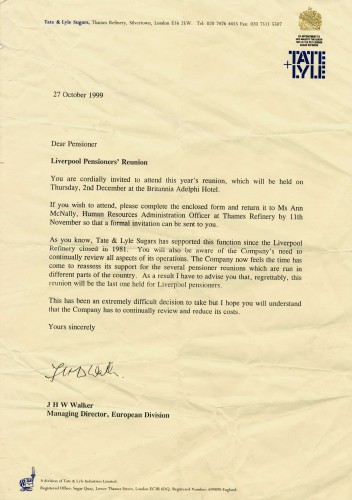

Cartoon drawn by Philip Bell
This whole episode totally transformed the priorities and approaches to my then five year old sugar project, galvanising me to organise a petition to “bring back the Christmas bash for the boys and girls from the whitestuff”, demanding, as it invariably would, much more detailed research into the Tate & Lyle champion of Free Enterprise and his Public Relations agent Aims of Industry. The initial addiction to a sugar lump with a prefix would eventually turn out to be very rewarding for our public history project but a lot of history had to be made first.
More to follow tomorrow:
20yrs today SGT. SUGAR & MR CUBE decided not to pay. The Pensioners Biennial Xmas party was junked!
Written by Ron Noon at 15:02 on Sunday, October 27th 2019

Those of you who read the last blog will half remember the opening question as to “how many people would read it and be genuinely interested in my fact of the day”? A few months ago on July 28th, a very wet and rainy day, Mr Cube reached 70 years of age. He was no ordinary sugar lump and arguably the most famous of all the trillions and trillions of sucrose cubes ever produced! Animated by squiggles for arms and legs and the sword and shield of Free Enterprise capitalism, he took on and defeated the “Socialist hydra” a couple of years after I was born!
He was a product of the fertile imagination of cartoonist Bobby St John Cooper and an “avatar” for the “verbally pugilistic” President of Tate & Lyle, Leonard Lyle, friend and close ally of Winston Churchill the leader of the Opposition who had a good deal to gain from successful campaigning against nationalisation. Journalists of the time referred to Lyle as LORD CUBE but it was Mr Cube who defeated Clem Atlee’s Labour Government’s plans for sugar refining. Indeed he helped to reduce a landslide majority of 186 to 6 on February 23rd 1950 another wet and rainy day.
Twenty years ago I had little knowledge of these FACTS and the fact that fifty years after his birth Mr Cube would appear on the letter from JH Walker to the Liverpool Pensioners pronouncing the scrapping of the biennial Christmas party. All the Liverpool Tates Pensioners were bitterly disappointed that December 2nd 1999 was to be their last ever Christmas reunion. My sugar research was immediately galvanised into a project involving much more than systematically working through the voluminous documents relating to the ten year struggle to prevent the closure of Henry Tate’s mother plant. Could I help my wonderful sugar mentors Albert E Sloane and John Maclean in a more practical way to revert that mean spirited, scrooge like decision? From October 27th 1999 I would be working very hard to do as much as I could to help in any campaigning. That required much more research outside of the Liverpool archives and outside of the Punch and Judy pub where I’d regularly meet up with Albert and John and their sweet fighting’ drinking friends.
It had been an ageing labour force in 1981 and many like Albert who had dedicated their working lives to Tates, would never secure employment again. That did not prevent them partying every Christmas reliving their memories and stories of working in the refinery and increasingly the friends that they were losing. That was when Tates financed an annual bash but then as John Maclean wryly commented “they decided that Christmas would only come round every two years. Each time even more absent friends meant that it got cheaper. We never thought that they’d scrap it altogether though”. Deja Vu! They’d never thought that the giant sugar refinery on the site of a former maidens and ladies walkway, which at one time employed over three thousand workers would be scrapped.
Unhappily on the threshold of a new Millennium the removal of company backing seemed to have irrevocably scuppered the vicarious but vitally important “associational” needs that the biennial Christmas bash made formal provision for. Was this the last supper on Lime Street? Not if I had my way. So as vainglorious, politically active thoughts about the intensely political product I’d been researching for the previous few years dominated my thinking, I embarked on detailed fact finding on Mr Cube. The present so often throws up fresh questions about the past and in 1999 I became an animated historian of history’s most infamous sugar lump. There was not very much that was easily available and accessible in the traditional literature for a sugar centric historian but that too was an issue which emphasised how the present throws up neglected questions about the past.
It was not the first time I’d looked into the chicaneries of Tate & Lyle because it was evident early on in my analysis of why Love Lane was junked that Tate & Lyle had metamorphosed from paternalistic family firm into a much more aggressive collective of multinationals where there was little room for sentiment and “reciprocity” in industrial relations matters. In the era of downsizing and so called “re-engineering” that gathered momentum in the late 80s and early 90s Tate & Lyle locked out workers in Decatur Illinois in a struggle that lasted for 33 months and which prompted me to fundraise for the workers in late 1995. Closer to home September 1995 was the start of the Lockout of Liverpool dockers. The dockers and Women on the Waterfront struggled valiantly and creatively into 1998 in the fight to preserve jobs and a proud heritage.
How can you be neutral about an intensely political product like sugar and a Politically Motivated Multinational like Tates? 1949 was the year of Mr Cube’s political birth and baptism despite the denials of Lord Lyle/Lord Cube that he was “non-political”. (It’s amazing how political non-political people can be and Tates PR advisors were Aims of Industry a right wing propagandist organisation that registered itself as an EDUCATIONAL body!) As a left wing public historian I was never going to be neutral in respect of where my sympathies and priorities for research lay. I was embarking on research which was going to take up a good deal of time and effort but which was vital to any efforts at corporate campaigning against a Sugar Giant that had proved that the representation of family firm was way past its sell by date. It was another Albert and John inspired struggle to plug the past into the present and achieve some results. All the pensioners were bitterly disappointed that the Biennial on December 2nd 1999 was to be the last reunion of the Liverpool Tates pensioners but Albert and John were going to support me in my plans to target 2001 which would/should have been the next Xmas Biennial. I delivered the petition below to Sugar Quay in London two years later but it was totally ignored by Larry Pillard the Chief Executive, and Harley Davidson loving American in charge of this soulless global transnational. The methods deployed in Decatur Illinois were deployed in the Domino Sugar Refinery in Brooklyn in 2000 and 2001 and New Yorkers were outraged. Little if any press publicity over here.
PETITION to BRING BACK CHRISTMAS FOR THE LIVERPOOL TATE’S PENSIONERS for December 2001
The Sugar Giant Tate & Lyle, because of their professed “need to continually review and reduce costs” ended the “biennial” Christmas Party for the Liverpool Tates pensioners at the end of 1999. This petition is part of a “corporate pensioners campaign” to bring it back, and to ensure that a Transnational that operates in five continents and fifty countries, and makes great play of TATE & LYLE IN THE COMMUNITY lives up to its claims, by catering for the “associational needs” of the original BOYS AND GIRLS FROM THE WHITESTUFF, many of whom devoted all their working lives to the company before it closed down in 1981. At “the last supper in the Adelphi”, December 3rd 1999, former Shop steward, Bob Bannister asked management a valid question, ‘Would it spoil some vast eternal plan if these Christmas get-togethers were to continue every two years, after all in ten or fifteen years most of us will have left for greener pastures?’
PLEASE SIGN YOUR NAME AND ADDRESS BELOW:
....
Ah well. Keep on keepin’ on is the mantra my family know too well. At least my notes and files were starting to bulge with some promise. Some tangible and very practical things could come out of what was becoming a living research project about Love Lane Lives. 20 years ago looking back down the tracks from Hindsight Station there were glimmers of hope about what I might put together about Tate & Lyle and the Mr Cube campaign. I loved the project and wanted Love Lane Lives to live as a community based project. 66 days before the start of a new millennium on October 27th 1999 how could anyone have foreseen a big petition to bring back Christmas materialising and that in 2006, 2007 and 2008 significant gains would be secured for the boys and girls from the whitestuff?
The graft comes first and what follows below may be boring to some but “facts are sacred, opinion is free”. Closer scrutiny of the genesis of Tate & Lyle required going back to the era of the GREAT WAR!
“The cliché that “The Great War” was a watershed is not clichéd enough in relation to the neglected world of sugar and sweeteners. Raw sugar supplies from the two main commercial sources, tropical sugar cane, and temperate sugar beet, became important munitions of war and “five years of ‘calm’ without competition…allowed refiners to amass a considerable war chest” but “above all, to initiate fruitful relations with the Government apparatus” which continued into the post-war years. One result was that the merger of the separate sugar dynasties of Henry Tate and Abraham Lyle in February 1921, actually had “the blessing of the Government”.
Mergers on this scale were uncommon and the International Sugar Journal warned that “the creation of something resembling a refining trust in this country must be condemned both from the point of view of the raw sugar producer and from that of the end-consumer and therefore trends in this direction should be followed closely”.
The synergy that Tates had with government was evidenced in 1928, when Winston Churchill, as Chancellor of the Exchequer announced budgetary alterations in sugar duties. This gave the British refineries, and Tate & Lyle in particular, effective protection from imports of foreign refined sugar and a comparative security zone for the remaining inter-war years. Their attempts to dominate the infant British sugar beet industry were to prove far less successful than the economic consequences of Mr Churchill’s 1928 budget for the sugar refining side of the industry. That was one of their most important battle victories and given its leadership, “logically it was Tate & Lyle that profited most from the results”.
Phillip Snowden was incensed and “practically accused Churchill of having been manipulated by the refiners” pointing out in the House of Commons budget debate, “that the value of the shares of the refining companies on the Stock Exchange had risen by 50% in six weeks”. The International Sugar Journal in January 1930 asserted that “there is now very little sugar being produced or refined in this country which is not under the control of Tate & Lyle”. A committee of enquiry on the sugar industry set up in 1934 under Ramsay McDonald’s National Government, came to the conclusion “that the arrangements made in 1928 were unduly favourable to the refining industry”.
Ironically the new company’s founding fathers, Henry Tate and Abraham Lyle, responded to intense competition from heavily subsidised Continental producers of sugar beet in the late nineteenth century, by “product differentiating” into cubes and syrup. Unlike other British refineries sacrificed on the altar of free trade, their companies were rejuvenated by that contest. The convenience of cubes to grocers and customers, confirmed not only Henry Tate’s background as a Liverpool grocer, but his refined business acumen for deploying modern technology and charging premium prices. The success of cubes without Mr Cube’s protective shield was arguably the making of what sympathetic company historian Phillipe Chalmin describes as a modern Sugar Giant!”
MORE TO FOLLOW
HISTORY TODAY published my first essay on a SUGAR LUMP in October 2001.
Written by Ron Noon at 15:47 on Sunday, July 28th 2019
In composing this short blog I wondered just how many people would read it and be genuinely interested in my fact of the day? Anyway here I vaingloriously go: History’s most famous sugar lump, the animated cartoon character Mr Cube has reached his three score and ten? 70 years of age on a very wet July 28th 2019.
So Happy Birthday “you psalm singing little bugger”! “Excuse me” responds the sensitive reader. Well by way of explanation, after Mr Cube’s first appearance in the Evening Standard on July 28th 1949 the command from the President of Tate & Lyle, the Imperial Sugar Giant threatened by Labour leader Clem Atlee’s plans to nationalise the sugar industry, was that this powerfully symbolic ally of the Tories and Fleet Street “must always be a knight in shining armour. He must never be a psalm singing little bugger”!
But the only sugar cube in history with a prefix, did become precisely that. A little bugger with prefix motives. In achieving them he was a brilliant success. Anti-nationalisation slogans like Tate not State, Dear, Dear, Dearer and so many other messages targeted at the “Socialist hydra” appeared on sugar packets daily and in a free press that gave Mr Cube free advertising reaching millions. Britain’s version of Asterix the Gaul helped reduce Labour’s massive 1945 majority to just 6 in the General Election of 1950. When the Tories returned to power in 1951, Mr Cube was a powerful illustrative ally of more than just Tate & Lyle in a climate of grey austerity, rationing “BBC steam radio” and absent digital data from Cambridge Analytica!
Anyway pun aside, that is why on this little bugger’s 70th birthday, I’d like to state an early priority in terms of resuming my blogs and my never ending loyalty to the boys and girls from the whitestuff. That has never changed and what we achieved in 2006, 2007 and 2008 was always intended to be a living and vibrant public history legacy. After four years of inactivity because of the devastating stroke my darling wife Gail suffered in April 2015 my family want me to pick up the sugar bowl and reactivate this site as well as doing everything I can as Gail’s patient carer. She want’s me to do it and so I will try to make a start by getting back some of this once “historic’ sites, freshness and relevance to our city and the wider “sugar world” of Love Lane Lives. The sooner the better.
A couple of years back I made a few statements of intent but now I have to match that with the reality of new blogs and new ideas and links. Not easy because composing this and writing late evening after a long but wonderfully enjoyable christening day for our eighth grandchild Florence, is very hard. I’ve obviously lost the knack and the confidence that I had when blogs were “saturated” with the accumulating knowledge from my sugar research and my passion for writing about the extraordinary ordinary lives of those boys and girls from the whitestuff, who worked at Henry Tate’s mother mother plant. Tonight’s writing is a step towards rekindling that dedication and enthusiasm and I promise those who are genuinely interested in my fact of TODAY that I will pick up at the very least later on this week the history of a lump of sugar that provides “a whole lesson in political economy, in politics and also in morality”.
My great sugar mentor Albert E Sloane had even more choice language to describe Mr Cube than Leonard Lyle.
Bitter sweet Social Science Foundations
Written by Ron Noon at 16:58 on Thursday, November 09th 2017
Bitter sweet Social Science Foundations (This is technically a Golden Oldie as it was written in August 2001!)
Towards the end of last century a social science foundation course, launched a Liverpool Polytechnic history lecturer into what was then a wonderfully dynamic Open University world tutoring on D103. It also put in place foundations for his twilight academic career as sugar historian and inveterate sugar buster. The October 2001 History Today essay, Goodbye Mr Cube will help realise some of that first claim, with a centre fold essay on “History’s most famous sugar lump”! Who are these odd guys? Well the bitter sweet talkin’ OU historian is this wannabe writer, but more importantly Mr Cube is the iconic cartoon character, “born in July 1949 in a climate of grey austerity, rationing and contentious nationalisation proposals” but who undoubtedly captured a big chunk of the public’s imagination declaiming Clem Atlee’s landslide Labour Government’s plans to nationalise sugar refining.
Despite ritual company representations of free enterprise and free competition the reality since 1921 was that refining in the UK was totally dominated by an Imperial sugar giant, Tate & Lyle. A war torn Britain that had fought the People’s war for a New Jerusalem could now be deprived of the much anticipated sweet things in life unless they supported Mr Cube’s mantra conspicuously displayed on sugar packets, “Tate not State”! This amazing icon of free enterprise and “Conservative freedom” appeared every day on the nation’s breakfast tables with teas and cereals and unsurprisingly Mr Cube became a big hit with housewives who had so stoically made many sacrifices for their families and loved ones. He became the industry’s champion and the company’s official logo.
Sadly today not only has D103 been replaced by DD100, but Tate & Lyle’s web page warns that the swashbuckling champion of private enterprise sugar, “looks forward to retirement from public engagements”. “Goodbye, Mr Cube” in History Today may well be the final lament to the cartoon figure once revered as Britain’s very own version of Asterix the Gaul!
Although seventeen months older than sweet fightin’ Mr Cube, my sugar bustin’ career began forty two years after he wreaked political embarrassment and electoral setback to the Labour Government in the February 1950 General Election. The 1945 landslide majority of 186 was cubed to six but the psephological consequences of Mr Cube and the sci-fi notion of an Open University were back in the distant future. Mr Cube was only seven months young at the time of his incredible success but my epiphany moment would be a long time in maturation, decidedly post cot, OU sponsored, and inspired by one of its international luminaries, Professor Doreen Massey. Initially it had little to do with the multinational sugar and sweetener group that now operates in five continents and over fifty countries.
Doreen’s coruscating World of Food Production exhorts the reader to go beyond common sense, and convinced many more than me that “behind simple taken for granted everyday commodities like sugar” there was “invariably a more complicated social story”. Contractually obliged to be at least ten cerebral minutes ahead of my class it was incumbent on me to dig deep, to unravel sugar’s nefarious history and introduce Billy (the Fireman) Baker’s group to this far from “natural” social story. The trade in human cargo from Africa to the sugar plantations of the Caribbean, and the development of huge refineries and temples of applied science in Liverpool and London was also a reminder of my own city’s nefarious history as Slave City first.
The mother plant in Henry Tate’s sugar dynasty, the comically misnamed Liverpool Love Lane refinery once a “ladies and maidens’ walk”, closed in 1981 signifying according to Block I “the end of a link – Jamaica-Liverpool – which was established right at the beginning of our story of food production”. The demise of that prominent Liverpool landmark left a hole in the community, a site of physical and emotional devastation that was seared into the national consciousness the following year in the closing scenes from Alan Bleasdale’s “Boys from the Blackstuff”.
Bulldozers smashed the guts out of the historic refinery that had been Henry Tate’s mother plant, as Chrissy, Logo and ‘gis a job’ Yosser walked disconsolately along its walls away from the manic pub redundancy party in the Green man public house! So when asked by ex Love Lane employees a few years after my first foray into OU teaching, to help them record their ten year struggle to keep the plant open, there was never any turning back. The story of the boys and girls from the Whitestuff demanded a more sugar centric approach to life and the social sciences than that contained in the blue books of D103 but it also opened up a “life changing” dimension with wonderful new friends who had worked down the Lane. Albert E Sloane and John Maclean who had been two of the leading activists in the campaigns were excellent mentors and they became magnificent friends.
From my first Summer School at Stirling in August 1992 right through to my last single transferable rant as module coordinator at Bath University in the Summer of ‘99 I bitter sweet talked my students. Even the stockbroker from Grantham in ’99 acknowledged that it was not just the perennial wars between the two commercial sources of supply, sugar cane and sugar beet, first world and third world growers, that was relevant, but the actual irrelevance nutritionally of a commodity which mankind had lived without for millennia. “Strange that an article so sweet and necessary for human existence should have occasioned such crimes and bloodshed.”
That lucid indictment by Eric Williams, Oxford Don and former Prime Minister of Trinidad contains only one debatable word about the commodity indelibly tainted by the blood of African slaves. “Necessary”? No. Indeed throughout its six centuries of global expansion the driver has been wealth not health and sugar is today very much part of the “natural architecture” of fast foods and processed profits. Montignac, the French food writer argues that every packet of the granulated scourge should carry a skull and crossbones, but like the tobacco industry thirty years ago powerful vested interests have a great deal to lose from public awareness. That is the real politics of arguably the most political of commodities. Mr Cube is history and hopefully soon recorded history so if there’s something strange in your neighbourhood food, “who ya gonna call” now? OU sugar busters? Ding Ding Ding Ding Ding!
Ron Noon August 31.2001
Vote for my Gail and the defence of the NHS
Written by Ron Noon at 05:55 on Thursday, May 07th 2015
“Homes, health education and social security, these are your birthright.” Nye Bevin.
There’s a myriad of issues that influence how we vote but as I stood in the Polling Station at Booker Avenue Junior School, there was decidedly only one, containing three logo letters that have been systematically and insidiously abused by this shameless ConDem Government. They symbolise our once universal public healthcare system, the NHS. It is that same NHS and it’s Liverpool Royal Hospital Intensive Care Unit with it’s wonderful doctors, nurses, cleaners and carers that has kept my beloved wife Gail alive this last month and given my family and friends some hope that she will eventually pull through from the totally random but potentially fatal stroke she suffered on the evening of April 7th.
All my teaching, all the public history research, all the sugar blogs and involvement with the boys and girls from the whitestuff, has been supported and lovingly encouraged by my Gail and our four wonderful children, Matthew, Luke, Ben and Jessica. It is only now that Gail is stable in the High Dependency Unit and after brilliant caring nurses have “dictated” that my visits are restricted to “official” visiting times, (ending my overnight stopovers with Gail) that I can write these words down. I hope that these little black markers on the screen convey some of the passion that my family feel for protecting an NHS that ought to remain as an example to the world, and cease to be threatened by the despicable privatised dreams of Lynton Crosby and his Tory party privateers.
Gail’s dad’s generation would ask “is this what we fought the war for” to see the jewel in the crown of the People’s Peace settlement, the National Health Service that cares for all citizens, when needed, free of charge, funded by taxes and national insurance, run like a supermarket after being invaded by for-profit corporations? Are those three wonderful letters, NHS to be reduced to a badge on Jeremy Hunt’s lapel? Small wonder that the aggressively acerbic playwright Dennis Potter declared after calling his cancer Rupert, (no friend of the owner of the SUN) that the trouble with words and letters is that you don’t always know whose mouths they’ve been in before!
NHS in the mouths of the Tories and Lynton Crosby that so called master of the political dark arts, the man behind the efforts to get this contemptible Government re-elected today, are merely modulations of sound that convey no meaning, no significant reality, NO HOPE. I’m sorry my Gail, but these privateers are farting through the wrong orifice, and that is why I theatrically asked at the Polling Station a couple of hours back whether I could register a proxy vote for you today? I did not elaborate about the fact that you are fighting for recovery in the High Dependency Unit in the Royal but I just wanted to say it was only because you were ill that you were not there with me. I knew when the young teller called his supervisor that it was patently not possible but I wanted an official response so that I could declare that my vote was always for you anyway. It would be a shared vote, like our shared lives, for the NHS that only Labour can defend from the venal Tory “souls” who only ever worship mammon.
Viva my Gail. Viva the NHS. Viva our friends and family on the BOYS AND GIRLS FROM THE WHITESTUFF site.
Vote for my Gail and the defence of the NHS.
REAL TIME IS 13.10 hrs
Visiting time starts 1400 hrs. I’ll tell Gail about this when I get into the Royal. We’ve got to talk and stimulate her back to full recovery. Labour represents decency and the protection of what she and I cherish, a just and fair society.
Big Sugar loves this night, especially when Halloween falls on a FRIDAY!
Written by Ron Noon at 09:11 on Friday, October 31st 2014
“Halloween confectionery sales are forecast to reach $2.5bn, up 1.8% on last year” according to the NCA and it’s Vice President of communications, Susan Whiteside. The figures are hot off the press of Confectionery news.com which as an avid Sugar Buster I’m an insatiable devourer of. Who do we thank for Friday? “That often means people attend more celebrations overall: Trick or treating Friday night, a community party on Saturday and an adult oriented party on Saturday night” is a great boost to profits from this simple too much taken for granted everyday commodity. Taken for granted? Well not for everyone these days because quite clearly there is now a much greater interest in the public health dimension to the overconsumption of a commodity which has the wonderful powers for food manufacturers of helping to overcome the finite limits of the stomach. Fancy anything sweet?
The term Big Sugar was not used by many people ten years ago in the UK when I was in the throws of writing up some of my research on the American white stuff, but today the “sizeist adjective” is prone to be placed pretty much in front of every profitable industry so in danger of debasing the value of the concept which for me has a specificity in relation to the industry in America in particular where it has a disproportionate POLITICAL clout. Big Food, Big Sugar, Big Tobacco, Big Oil, the adjective clearly has transferable uses. “But on a night when it is a bit of a headache for parents so much sugar around, it’s a marketing dream for the Sugar industry.” Big Sugar wants to ensure even when Halloween does not fall on a Friday that the sugar fest continues indefinitely as gullible people trick or treat ourselves into a bitter/sweet future.
We are addicted to it and if there is going to be an effective ACTION ON SUGAR campaign here, there and everywhere, this pimp product enters insidiously into the diet with its deleterious health consequences in terms of obesity, diabetes and other spectacularly increasing “non-communicable diseases of affluence” then hopefully this weekend will be the start for many more. Nearly 20 years of researching the white stuff and largely from the point of view of the sugar refinery workers and their “productionist” priorities has finally taken its toll. I love my boys and girls from the whitestuff, and will always savour the great delight that conversations and talks with extraordinary ordinary lives from down the Lane have brought me. Albert E Sloane and John Maclean are my two main sweet fightin’ men and sadly John has passed away. That said I remember him telling me that “there’s nothing wrong with the stuff Ron, it’s delicious and what everyone loves”. When you are trying to save your job and defend your community, naughty definitely meant nice. Of course people have to get access to the means of material life and secure jobs and employment and my predominant focus on this site is justifiably on those Love Lane Lives and ensuring that their stories and tales and above all those memories of working down the Lane live on!
That is the rationale for the studied play on words in the title of this site. Love Lane Lives or Love Lane Lives!? In one supremely ironic sense that battle to SAVE OUR SUGAR and save the Lane from closing (1500 people plus their families and dependents were junked in April 1981 when Henry Tate’s mother plant was closed down by Tate & Lyle) was at a time when one of the first sugar busters on the block the scientist and nutritionist from London University, Professor John Yudkin author of “Pure, White and Deadly”, was the target of opprobrium and many derogatory criticisms for posing FINANCIAL HEALTH warnings to the industry.
The public health dimension then was nothing like it is today when the scientific evidence for its deleterious impact on our health is “objectively overwhelming” and when Robert Lustig the American endocrinologist is the newest and most effective sugar buster on the block. He’s the lightning rod for far more than scientific debate about the toxicity of this hitherto far too much taken for granted everyday “foodstuff”. (There’s nothing NATURAL about the white stuff and it does not grow on plant leaves or husks of corn! The bible was a land of milk and honey not sugar and spice and our sweet tooth was assuaged by other sweeteners, albeit very difficult to come by.)
Lustig’s scientific method and doctoral zeal as an endocrinologist who has for many years now seen at first hand the disastrous consequences of overconsumption of sugar on the children he treats for diabetes and various related “non-communicable diseases”, has provoked and illuminated a much needed public health debate.
http://www.youtube.com/watch?v=dBnniua6-oM
His campaigning has led directly onto other more collectivised campaigning groups like Action on Sugar which was set up in this country in January of this year. This is Action on Sugar’s first BIG HALLOWEEN encounter and I’m sure there will be many more but they’ve at least for this first year of operation succeeded with me.
Belatedly I now deliberately and purposefully cut out as much of the added sugars in my diet as is practically possible. I’m not a food facist, a kill joy, a proselytiser of dieting! I don’t DO that kind of diet and I do eat a lot especially now my “appetite control mechanism” has been rehabilitated. That said as an enthusiastic supporter of AoS I don’t want this opportunity for really effective public education on health and quality of life to be missed.
Hopefully as it’s proponents argue we are on the cusp of a new ZEITGIEST when Big Sugar faces up to a BIG TOBACCO moment! But to push that advantage home and remind ourselves that food is the biggest business in the world and nutrition arguably more of a driver and shaper of individual and group needs than sex, the social story of sugar, how it came from nowhere to be everywhere, has to be told too. A wider and more holistic debate around the history of sucrose and its role in human history would be an invaluable way of plugging the past into the present. Why not extend “sucrose history” into the schools to harness the formidable pester power of our kids. Why not make a start by watching this?
Big Sugar: Sweet, White and Deadly. Written & Directed by: Brian McKenna. Produced by Galafilm in 2005.
http://www.youtube.com/watch?v=8hcAjyOFX1M
Big Sugar contains some fine reconstructions of 18th century slavery when sugar cane was not only the quintessential slave crop but the “white gold” that instigated fierce economic and military rivalries amongst European powers that were all too readily prepared to engage in wars over it!
How many people seriously interested in history in Britain and Canada know that at the end of the Seven Years War, 1756-1763, “Big Sugar” in Britain did not want the French sugar islands of Guadelope and Martinique to challenge their ascendancy and how they used blackmail and bribes to ensure that not only was the fate of Canada determined by their “preferred” Peace Treaty for Britain but that effectively in not incorporating the French sugar islands and taking Canada instead, “sugar was traded for snow”!
As McKenna declared after reading Jame’s A Mitchener’s novel Caribbean, Canada’s fate was decided not on the Plains of Abraham but by the sugar lobby in London”. Novelists don’t have to genuflect to objectivity as an end in itself as do historians but Mitchener had a footnote in his book which outlined a new scenario of Canada’s past. Both Mitchener and later Professor Denis Vaugeios immersed themselves in the archives in London and highlighted this hitherto lack of scholarship and research on the subject. Sugar is a funny old world and action on Sugar requires knowing much more about it’s spooky history.
P.S. Trick or Treat?
“Beat the Beet, Keep the Cane” was the Refrain from down the Lane
Written by Ron Noon at 06:03 on Tuesday, September 16th 2014
That little ditty was the one that emanated from Love Lane Liverpool, (then mimicked in Silvertown London, and Greenock Scotland), in the aftermath of Britain’s entry into the EEC in 1973 and much closer encounters with the European Beet Boys. Five years ago I chose that title for an essay I was asked to write for Ethical Consumer Magazine. Ironically today in the USA there is a new “sucrose solidarity” in the court rooms of California where the American Sugar Alliance (representing both sugar beet and sugar cane) have litigated against the American Corn Refiners over their dastardly efforts at rebranding High Fructose Corn Syrup HFCS as “Corn Sugar”. It’s a funny old sugar world still when this far from “natural” product is claiming that HFCS is not natural sugar!
BEAT THE BEET, KEEP THE CANE
In the essay below I refer erroneously to sugar (sucrose to give its chemical name) as an empty calorie. Shorn of all other nutrients refined sucrose (both beet and cane sources) is indeed empty but here the work of the new SUGAR BUSTER on the block, Professsor Lustig is crucially important, because he highlights sugar’s unique characteristics in relation to how it is metabolised. Expertise as an endocrinologist and forays into the complexities of biochemistry is not a prerequisite to understanding sugar’s deleterious metabolic consequences because of one constituent of the disaccharide: FRUCTOSE. Sugar is 50 percent glucose and 50 percent fructose and it is the latter that makes it sweet. I’m now convinced without going into too much more detail here before you read the essay below that FRUCTOSE is the TOXIC ingredient, the real culprit in this global crisis. The fructose component of sugar and of High Fructose Corn Syrup (the adjective surely tells its own story) is metabolised primarily by the liver “while the glucose from sugar and starches is is metabolised by every cell in the body”. That matters a great deal and hopefully in subsequent blogs the PUBLIC HEALTH DIMENSION of sugar can be developed more fully. I know that my great sugar mentor John Maclean was a great cynic about “overeating” sugar and many of my friends who contribute to our comments column are equally cynical and even now have no compunction in eating jam butties! That said I feel that there is a big debate that this LOVE LANE LIVES site can help make some contribution towards in the cause of public awareness and clearly what we’ve covered to date suggests that there’s always far more to this once simple taken for granted everyday commodity than sweetness!
Enough of that apologia. Here’s the essay with the Ethical Consumer Magazine’s headlines, not mine!
Historian and sugar expert Ron Noon from Liverpool John Moores University unearths some uncomfortable truths about ‘capitalism’s favoured child’.
The real story of sugar from a nutritional and ethical perspective, whether it comes from the historic cane that sways in the exotic tropical Antillees or the ugly mangel wurzel sugar beet in wet Fenland England, is Sweet FA! It is an “empty calorie” shorn of any other nutrients, but achingly addictive and a perfectly legal drug for billions to be hooked on. The granules are manufactured in “temples of applied science” and not in mother nature’s laboratories, which photosynthesise using solar energy to combine carbon dioxide and water into sugar stored as starch. The highly chemicalised refining process launders and purges the raw sugar to ensure that nearly all of the nutrients that accompany sucrose, (the technical term for this simple carbohydrate), are lost or taken out, leaving nothing but calories. This is a salutary warning to health conscious consumers who mistakenly think that raw or brown sugar is much more nutritious and healthy than the white stuff! Raw for retail is a misnomer because it has also been refined and as there have been no sightings of granules or cubes on plant leaves, the sugar lobby ought to be warned about the ethics of describing their product as “natural” and suggesting that the history of this pure chemical goes back to the origins of the biosphere.
Globesity
Metaphorically at least sugar provides wonderful food for thought although the success story of Brazil producing ethanol from sugar to power flex-fuel car engines clearly goes beyond metaphoric non-food uses for cane. That said as we have no biological need for the refined stuff, we could and did live without it for millennia. The bible was a land of milk and honey, not sugar and spice and sweetness ought not to be conflated with sugar. The former was found in many other sources, appealingly available long before sugar commercially eclipsed honey and became the new kid on the sweetener block. That said and despite the fact that it was millennia before our innate “sweet tooth” and organoleptic senses became acquainted with what I brand as “industrial sugar”, our ancestors associated sweet with good and bitter with bad!
In today’s “naughty but nice” era of processed profits, palatable junk food, globesity and even “fair trade sugar”, the dissonance between tastiness and nutrition, renders those earlier instincts not only anachronistic but highly dangerous. Foods packed with refined sugar are chockfull of calories and are always likely to give trouble because they help to overcome the finite limits of the stomach. We are always prone to finding room for something sweet and not only do some sweetened foods taste so good that consumers are quite content to risk their health for deliciousness but even savoury foods have fallen prey to sugar’s embrace. When French food writer Maguelonne Tousaint Samat, keenly aware of the evils of sugar and slavery, wrote that “so many tears were shed for sugar that by rights it ought to have lost its sweetness” she had not anticipated the souring sugar content of many of today’s prepared and processed foods that do not taste sweet.
Revealingly in a 1967 book entitled, Sweet Malefactor, the author, a former World Health Organisation doctor, declared that “there is no single food which has rivalled sugar in its influence on human affairs”. It was of course the quintessential slave crop, a label which is tragically not just historic. “Sugar slavery is back more powerful than ever, and now sugar is not only devastating for those who harvest it, but deadly for those who consume too much.” The so called diseases of affluence and overeating including the latest bitter sweet neologism, “globesity”, can not be understood without examining the politics of food and health and particularly the pimp like product which along with fat is a key foundation food of capitalism.
Napoleon and subsidies
The history of sucrose, before the Columban era represented only “a mere pinch per head for the whole of that history”, but then according to deposed Haitian leader, Jean Bertrand Aristide, it was premised on millions of African sisters and brothers being “exported like merchandise”, their blood “changed into bitter sugar”. A recent documentary film The Price of Sugar narrated by Paul Newman, focussed on the plight of Haitian migrant workers in the sugar bateyes of the Dominican Republic, and dramatically reminded all those who talk about packaging and marketing ethical sugar, that slavery is not just about the past. The Haitian migrants and their children are of the same blood and lineage as Toussaint L’Ouverture, the “Black Jacobin” who led a magnificent slave revolt against the mighty French Empire at the beginning of the nineteenth century, burying, albeit temporarily their chains. This momentous event had a seismic impact on the hopes and aspirations of slaves demanding freedom, liberty, equality and fraternity which makes it all the more tragic that L’Ouverture’s descendants today are stateless and living in abject conditions in the bateyes of the DR.
The Haitian revolt and the British navy’s stifling of French trade encouraged Napoleon to champion the sugar beet which not only symbolised the temperate world’s seizure of what had hitherto been the husbandry of the tropical world but the rigging of the international sugar trade against nature’s most efficient collector of solar energy, the tropical cane. The subsequent dirigisme of many European governments in the form of “continental bounties” and subsidies for beet production has led inexorably to the European Union’s egregious Common Agricultural Policy which has worked very much to the detriment of cane growers in the developing world. Despite recent reforms which were forced on the EU by the World Trade Organisation, designed to help free up trade, the transitional period of adjustment and compensation for lower prices has been very much skewed in favour of the European Beet boys and the big refiners.
The ubiquity of industrial sugar today (two thirds of our intake is indirect), is based on this nefarious history of cane and beet, and a present day “Big Sugar” lobby that increasingly makes the chicaneries of Big Tobacco seem old-fashioned. It is called “big” in the US because of its disproportionate political clout and although the adjective is not used so often over here, de facto the reality is the same. So for ethical shoppers the real price of this intensely political product, now in its seventh century of global expansion and making the products of Bill Gates seem pre-pubescent, is obfuscated by the labels written in the industry’s invisible ink and camouflaged on the shelves of supermarkets groaning under the beet and cane packets of Silver Spoon “homegrown sugar”, and Tate & Lyle “fair trade” sugar. The history and current affairs lessons are not advertised by the sugar refiners misinformation packs and their buddies in the fast food and soft drinks industry.
Slavery
It is so ordinary a product today that it is difficult for many to conceive that by the 16th century this addictive drug was a main marker and emulator of wealth and conspicuous consumption and that it would later become known as “white gold”, the basis of one of the first truly international industries. The “Sugar Revolution” in Barbados and the Caribbean in the middle of the seventeenth century and the “proto-agri-business” of plantation production, increased output and reduced costs and prices to satiate the Old World’s seemingly insatiable demand for a product that rapidly moved along the value added chain, from medicine, spice and condiment, to decorative substance, preservative, sweetener and eventually the food that changed the world of diet!
It sweetened trades in other exotic tropical beverages, such as tea, coffee and chocolate, and proved in the drive towards modernity and mass consumption to be “Capitalism’s favoured child”. It is a wonderful social metaphor for a system of commodity production that prioritises want not need, wealth not health. No spud or tomato can rival that and no other plant can justify the term revolution. Hobhouse argues that “although it did not create negro slavery” it was “the gigantic scale of the transatlantic slave trade and its maintenance for several centuries” that fed upon “the demand for sugar in Europe and North America”. It was, and is still in places like the DR, the most exacting of all tropical taskmaster’s and Hobhouse reminds us that “because sugar cane was a labour intensive crop, the ratio of slaves/sugar always remained at least ten times greater than the ratio of slaves/tobacco, or slaves/cotton, or any other crop grown in servitude”. The remorseless demand of addicted consumers four thousand miles away rationalised the de-humanising logic of slave labour, integral to the Sugar Revolution and the rapid Africanisation of the Caribbean which cravings for sweetness brought about.
Boycotts
My own city Liverpool, a sleepy insignificant fishing village at the end of the 17th century was jolted into transatlantic takeoff in the eighteenth century by sugar and slaves, and a drunken actor by the name of George Cooke booed by the Liverpool merchants at the Theatre Royal when the abolitionist movement was in full swing, accused the “wretched” audience of living in a town where there was hardly a stone that had not been tainted by the blood of an African slave.
After Parliament’s rejection of a bill to abolish the slave trade in 1791 hundreds of thousands of people developed the tactic of boycotting sugar from the West Indies, and for those who abjured self denial because of their incurable sweet tooth, the ethical thing to do was to eat sugar from India. Thomas Clarkson one of the greatest of all the abolitionists, such was his unstinting fervour, energy and determination to remove the abomination of slavery, was delighted unlike Wilberforce who was wary of stirring up popular protest, that the boycotters, had found “a remedy which the people…were taking into their own hands”. The fact that Indian sugar was untainted by the blood of African slaves did not mean it was produced by “free labour” but the boycott methods and shift of demand to East India sugar was a broadside against the hitherto all powerful West Indies sugar lobby.
Today it is not the British West Indies lobby which stirs up the potential for popular protest on behalf of developing countries, but the EU and “Big Sugar” in America. The former have not only heavily subsidised beet but for over thirty years dumped surpluses onto world markets forcing prices down and exacerbating the problems of developing countries where cane has remained the “hunger crop”. (Tate and Lyle under the CAP secured adjustment aid conceived as a means of rectifying imbalances between beet and cane refining margins, but also claimed to provide a vital bridge under preferential arrangements for quotas from African, Pacific and Carribean cane growers.) America only allows 15% of sugar supplies to be sourced from imports and “nowhere is there a larger gap between the U.S. government’s free trade rhetoric and its protectionist policies than in the sugar program”.
In March 2004 there was a report from the World Bank which concluded that sugar was the “most policy-distorted of all commodities” and argued how multilateral reform of sugar policy could produce global welfare gains of 4.7bn dollars (£2.5bn or 3.7bn euros at that time). By increasing imports to the most protected countries, US, EU and Japan, it could create work for 1m workers in developing countries which once again revealed how more so than any other commodity it brings the interests of developing country sugar cane exporters most into conflict with those of developed country sugar beet growers and the cane growers in America who benefit from the protectionist Sugar Program.
Moral obligations?
So to conclude this presentminded history of sugar there are a few glittering generalisations that can be made despite the labrynthine complexity of its politics and the argument of French food writer Montignac who suggests “it should always be labelled will a skull and crossbones symbol since it is a dangerous product when consumed in large amounts”. Firstly, apart from the existence of a few rich cane-producing countries such as heavily protected America and far more efficient and free trade oriented Australia, the divide between tropical cane and temperate beet coincides directly with the division between rich and poor countries. Secondly sugar cane is nature’s most efficient collector of solar energy and if production costs are compared by looking at what the land and labour used in each country could produce if they were put to their most profitable other uses, or what the economist defines as “opportunity cost”, then beet production, because of the far greater opportunities available to resources in rich countries is substantially more costly.
Thirdly and of the greatest significance because it relates to our moral obligations towards the poorest of the poor is the conclusion reached by the World Development Movement over 30 years ago that “a rich country’s sugar policy, from whom it buys its sugar and by what means it pays for it is a vital litmus test of its proclaimed benevolence towards the poor world. It’s policy indicates directly whether or not it is willing to stifle one of the developing world’s few real opportunities to increase its exchange earnings”. Gloomily the egregious and self interested sugar programmes on both sides of the Atlantic, highlight how there is nothing economically or ethically rational about the world of sugar and that sadly the colonies that were exploited in the days of slavery are still denied one of their few opportunities to develop via trade not aid. The maxim of the ethical and public health conscious consumer is to reverse the Napoleonic legacy and help to beat the beet and keep the cane.
Ron Noon 26th December 2009
2268 words
Sugar: The Bitter Truth
Written by Ron Noon at 10:52 on Monday, May 26th 2014
Five years ago today Professor Robert Lustig a pediatric endocrinologist at the University of California, San Francisco, gave an hour and a half lecture on the white stuff, and subsequently witnessed its posting on YouTube and watching incredulously as it went viral. What is the bitter truth about sugar and public health?
http://www.youtube.com/watch?v=dBnniua6-oM
4,722,471 hits to date!
When I was a kid I wanted at least three spoonfuls of sugar in my tea. I never realised that the stuff I also put on my butties was known as sucrose which is a simple disaccharide carbohydrate containing a 50/50 mix of fructose and glucose molecules and a chemical formula of C12, H22, 011. Fructose makes sucrose sweet but it is primarily metabolised by the liver and unlike glucose which is metabolised by all cells in the body, excessive consumption of it puts extra strain on the liver which actually then converts fructose to fat. I knew sweet FA about biochemistry then but thanks to writers such as John Yudkin, Robert Lustig and Australian lawyer David Gillespie and his book “Sweet Poison”, I know a good deal more about what the food industry do not wish the public to know about the toxicity of sugar. Is it really fat that makes us fat? Have we been conned by the 1970s declaration that fat was public enemy number one in our diets? Low fat meant more sugar was put into our processed food to prevent it tasting like cardboard, and sugar, which Professor John Yudkin of the University of London’s Queen Elizabeth College proclaimed in 1972 to be “Pure, White and Deadly” was let off the hook. It had been Yudkin who declared that “if only a small fraction of what we know about the effects of sugar were to be revealed in relation to any other material used as a food additive, that material would promptly be banned”.
In 1967, five years before Professor Alan Yudkin’s book about the dangers of excess sugar consumption, W.A. Aykroyd a doctor for the World Health Organisation asserted that “there is no single food which has rivalled sugar in its influence on human affairs”. All the more reason therefore to carefully examine sugar or sucrose history and contextualise the contemporary debate in which Robert Lustig, the latest of the sugar busters on the block, is up against the same powerful vested industry interests that set out to and effectively discredited Yudkin’s work over forty years ago. “I am not a pawn of the food industry or a mouthpiece for any organisation. Unlike many authors addressing the devastation of obesity, I don’t have a product line designed to enrich my bank account. I came by these views honestly and through rigorous data analysis. And the data are out there for everyone to examine.” That’s what Lustig argues in the introduction to FAT CHANCE: THE BITTER SWEET TRUTH ABOUT SUGAR but the “science” and the data of which he is a master is not enough I would argue without an historical and social science perspective on this pimp commodity.
Aykroyd emphasised in SWEET MALEFACTOR that it was not sugar per se which attracted him to researching the white stuff, but rather it was “the sugar islands and the people who live in them today”. I was not attracted to “sucrose research” because of sugar “per se”, or because of sugar islands in the tropical Antilles, but because of the wonderful Albert E Sloane and John Maclean who had valiantly fought the ultimately unsuccessful campaign to keep Henry Tate’s Love Lane refinery open. So this website will always have as its main focus the need to ensure Love Lane lives live on, by documenting as with the film and various blogs, the “lived experiences” of the Liverpool boys and girls from the whitestuff. When they worked on the Lane “bread and butter” industrial relations issues, and then the sugar wars between beet and cane had much more profile than any public health debate over the damage sugar could inflict on our metabolisms.
There are many different books and articles about sugar and as I digged deeper into sucrose research it was necessary to check out the chemistry, biochemistry and physiology of the white stuff. At the same time I continued to talk in classes at Liverpool John Moores University about sugar as the quintessential slave crop and how it had shaped my own port city’s history. Regrettably that central theme of sugar and slaves has not just been historical as the world of Father Christopher Hartley and the fate of the abject descendants of Toissaint L’Ouverture on the sugar bateyes of the Dominican Republic provides graphic evidence of.
Sugar came from nowhere to be everywhere. There is no biological need for it and Henry Hobhouse’s assessment of sugar’s commercial travelling before Christopher Columbus was “a mere pinch per head for the whole of history”. Why did this addictive substance extracted and refined from sugar cane grass, become by the 16th century, a main marker and emulator of wealth and conspicuous consumption? In the post Columban era it became known as “white gold”, the basis of one of the first truly international industries. It sweetened trades in other exotic tropical beverages, such as tea, coffee and chocolate, and proved in the drive towards modernity and mass consumption to be “Capitalism’s favoured child”. That was the phrase used by Ortez and it is a necessary reminder of the need to foreground sugar and capitalism as an important theme that ought to be explicit in historical and contemporary accounts of its revolutionary impact on diet. Aykroyd’s sage comment on what influenced his “unification” of themes and chapters in Sweet Malefactor was that it depended “on the presence of sugar in the foreground or background throughout, as the hero or villain, more often the villain”. That’s decidedly the emphasis in Lustig’s excellent work.
Big Sugar
Written by Ron Noon at 22:37 on Saturday, May 24th 2014
The term Big Sugar was not used by many people in Britain ten years ago when I’d shifted my focus from Love Lane to reading up and researching materials on the American white stuff and Florida Sugar in particular. In the US the phrase was frequently used because of the DISPROPORTIONATE political influence the Sugar industry wielded and a shockingly egregious Sugar Program which benefited a few growers while the Government and the customer picked up the tab for financing these corporate welfare benefits.
The novelist and former Miami Times investigative reporter Carl Hiassen was a real thorn in the side of Big Sugar. “Every few years, the Congress of the United States of America voted generous price supports for a handful of agricultural millionaires in the great state of Florida. The crop that made them millionaires was sugar, the price of which was grossly inflated and guaranteed by the U.S. Government. This brazen act of plunder accomplished two things: it kept American growers very wealthy, and it undercut the struggling economies of poor Caribbean nations, which could n’t sell their own bounties of cane to the United States at even half the bogus rate.” (Some excellent passages by Hiassen about the degradation of the Everglades are contained in this link:
H Dan Miller a Republican Congressman from Florida was another “irritant” to Big Sugar and testified in front of a House committee that “the subsidized production of sugar in Florida results in phosphorous-laden run-off flowing into the Everglades, which contributes to the destruction of this fragile ecosystem. Amazingly, the Federal Government continues to subsidize sugar producers, even as Congress participates in multi-billion dollar projects to repair the damage done to the Everglades.”
The toxicity of those phosphorous run offs and the damage also to American democracy was what I alluded to in the last blog. Nowhere is there a greater gap between the American Government’s free trade rhetoric and the protectionist policies that keep out third world growers. Allowing the power of Big Sugar to remain unregulated resulted eventually in what ought to have been a seminal moment (a Tobacco moment!) when a New York Times editorial in November 2003 made an explicit call for an end to the egregious and costly American Sugar Program.
“Sugar growers in this country, long protected from global competition, have had a great run at the expense of just about everyone else — refineries, candy manufacturers, other food companies, individual consumers and farmers in the developing world. But now the nation’s sugar program, which guarantees a domestic price for raw sugar that can be as much as three times the world price, needs to be terminated. It has become far too costly to America’s global economic and strategic interests.” Precisely so and In its concluding sentence it rejected their opposition to trade liberalization and advanced the ethical and economic argument “for the handful of individuals who control the sugar business in this country to start thinking about a new line of work, and be grateful for the long run they had”.
Less than six years later the power of Florida Sugar and the Cuban American Fanjul brothers in particular was such that Tate & Lyle sugars were gobbled up by the American Refining Company and the lag between intent and actual achievement of the NYT battle-cry is much wider than then! There is a greater public interest in the public health dimension to overconsumption of sugar given that it is so obviously a commodity which patently has the power to overcome the finite limits of the stomach.The new Sugar Buster on the Block is endocrinologist Professor Robert Lustig from the University of California, who gave a lecture on May 26th 2009 entitled “Sugar: The Bitter Truth”. It’s subsequent posting on YouTube went viral and there is now not only a debate about “Is Sugar Toxic” but also an Action on Sugar Campaign that was launched in Britain in January of this year.
Aspects of these debates will hopefully feature in subsequent postings on our site but to conclude this short blog here’s a letter to the NYT which I sent over the pond last November on the 10th anniversary of their “you should be grateful for the long run you’ve had” editorial.
Dear sir,
On Saturday November 29th 2003 my morale as an intrepid sugar buster from over the pond in Liverpool was turbo-charged by your newspaper’s trenchantly argued Opinion column on America’s Sugar Daddies and its stirring conclusion that “the handful of individuals who control the sugar business…ought to start thinking about a new line of work and be grateful for the long run they had”! Surely with the imprimatur of the NYT many of my colleagues and students who hitherto had become a little bored with my frequent rants about the disproportionate political clout of “Big Sugar” and how the egregious American Sugar Program diffused costs amongst millions of consumers and concentrated benefits on a relatively few growers, (especially in the Sunshine State of Florida), would now start taking me more seriously? At least it was a little less parochial than my early noughties rants against the European Beet Boys and the equally egregious Common Agricultural Policy
There were absences in your editorialising relating to the toxicity of the product, but the public health dimension of excess sugar consumption was clearly linked to the rigged Sugar Program and indeed the shocking threats made earlier on in 2003 by the American Sugar Association in response to the World Health Organisation’s gentle recommendation that no more than 10 per cent of consumers calorie intake should come from “added sugars”! The bible was a land of milk and honey not sugar and spice and mankind did without added “industrial sugars” for millennia. Such an incontrovertible biological fact was never going to survive ASA shock & awe tactics which demanded Congress end WHO funding unless it scrapped its guidelines on “healthy eating”!
That bullying/blackmailing strategy was strengthened by the mobilisation of the lobby’s affiliation biased scientists (ABS) and professional dissimulators who questioned the scientific foundation of the WHO report. Indeed the President of the ASA claimed they were “not opposed to a global strategy in the fight against obesity…but we want that solution to be based on the preponderance of science”! Whose Science?
The scuppering of the WHO and the fizzling out of what I’d hoped was Big Sugar’s “tobacco moment” has perversely resulted in a strengthening of the links between sweetness and power and even a new found sucrose solidarity between cane and beet producers against the claims of the Corn Refiners who litigiously insist that their High Fructose Corn Syrup is as natural as sugar! There is nothing natural about any processed sugars but ten years on from your lapidary editorial, who in the world of Big Sugar, sectarian rivalries aside, is introspecting on a “new line of work”? I am.
I HAVE N’T BUT THEY NEVER PUBLISHED THE LETTER ANYWAY!!!
Florida Sugar 10 years ago today!
Written by Ron Noon at 14:06 on Wednesday, May 21st 2014
This was what I’d composed and the date is 21st May 2004:
Florida Sugar: A Toxic ingredient in American Democracy
The la peratif
I’m from Liverpool, a former Slave City first and later the home of the Beatles and the Mersey Beat. Despite 20th century run down and decline from its former “Gateway to Empire” status, when it spawned more millionaires than any other city outside of London, the famous port city that Karl Jung described as “the pool of life” is now on the cusp of an early Millennium revival which will see it adopted as European Capital of Culture in 2008. It’s an increasingly popular tourist attraction because of the four mop heads who shook the Cavern and the world back in the 1960s, but it has in addition to the Edwardian grandeur of its waterfront architecture, and the magnificent St Georges Hall, the Parthenon of Northern Europe, other “must go to sites” including the Transatlantic Slave Gallery on the Albert Dock.
From its opening in 1993, Liverpool has tried to redress the collective historical amnesia about an era when there was not a stone in this “wretched city that had not been tainted by the blood of an African slave”. But even though there are plenty of issues of interest for a home grown middle aged local historian to sink his teeth into before retirement, it is a US State and its indices of sugar production that provides the pressing research challenge to date.
It is certainly not the weather in the Sunshine State or its Disney Land lure that explains my obsession with Florida, and the sugar cane grown in the Everglades Agricultural area, (EAA) just south of Lake Okeechobee. So perhaps the best way to unravel the odyssey of an inveterate sugar bore is to elevate the significance and status of sucrose, the simple disaccharide carbohydrate, which like Elvis, Sex and Martini is here there and everywhere. Although mankind did without it for millennia and there is no biological need for “refined” sugar, it makes the products of Bill Gates seem pre-pubescent as it continues into its seventh century of global expansion.
Even when we claim not to take it in our beverages the main consumption is indirect because sugar is very much part of the “natural architecture” of fast foods and processed profits. The real story of this achingly addictive white stuff, like the public health problems it poses in and outside of Florida, is decidedly not sweet, and it is tainted by the blood not just of African slaves, but also more recently the blood and sweat of Caribbean “guest workers” deployed to chop sugar cane in the EAA. Cane was harvested by migrant workers with machetes, metal arm and shinguards because Americans would not do such exacting and dangerous work for so little pay.
A useful contemporary and comparative source to back up the exhibits at the Transatlantic Slave Gallery in Liverpool, are the 90 crates of documents in a court house in West Palm Beach, which bear witness to a fifty year American Labor (that’s how they spell Labour in America) scandal over the H2 “guest workers”. Regrettably sugar and Slaves is a recurring theme on both sides of the Atlantic, and an American lawyer involved in the class action cases against the Florida sugar growers documented in Marie Brenner’s excellent 2001 essay in Vanity Fair, ‘In the Kingdom of Big Sugar’, has suggested that the abuses of the H2 program are analogous to “modern day slavery”. At the very least this is a “morality play about the employment of foreign workers with marginal legal rights”.
Indeed in Marie Brenner’s coruscating essay Edward Tuddenham, an Ivy League, Harvard educated, public interest lawyer, elaborates with the acumen of an activist involved since the late 1980s, the genesis and various stages of this morality play. Brenner first met Tuddenham in the spring of 1999 to investigate the complex public interest case he had been working on for ten years. There were 20,000 sugar cane harvesters mostly Jamaicans who used to work for Florida’s largest sugar companies including that of the two Cuban Americans, Alfy and Pepe Fanjul whose company was by far the most powerful. These were formidable adversaries. In terms of their family history their father Alfonso Fanjul Sr. and their maternal grandfather Jose Gomez-Mena presided over one of the largest sugar dynasties in Cuba and according to the “rumour mill in Havana, the Gomez-Mena family emulated the French aristocracy” and “were as oblivious to the conditions in the fields as their eighteenth century counterparts”.
One hundred years later the H2 workers in the sugar cane fields of Florida were subjected to years of massive wage cheating and brutal working conditions and the Palm Beach sheriff’s deputies once used police dogs to break up protesting H2 workers on a Fanjul property. This case was known as “The Dog War” and the Fanjuls were subsequently sued agreeing to pay $355,000, about $1000 for each worker. In the Marie Brenner piece and in a rare interview with Alfy, he did express regret at a “mishandled” incident.
Not only was the cultivation of sugar cane so exacting and dangerous but the toxic phosphorous run offs into a phosphorous intolerant eco-system threatened the world renowned “River of Grass”. The costs of pollution were never paid by Big Sugar. Brenner also pointed out how “little known to the American public, Pepe and Alfy Fanjul operate within the hidden world of implicit linkage, the grand club of the country’s power brokers, who routinely trade favours like baseball cards”. Indeed Time Magazine in 1998 had dubbed the Fanjuls as the first family of Corporate Welfare!
Will de Niro’s film provide the oxygen of publicity for much needed national debate about the overweening power of Big Sugar? All that is in the future. It is the war in Iraq that threatens to eclipse all other issues in this Presidential Election year, and presumably very little will be heard about the De Niro project until it is on the crest of Block Buster release.
That said one thing for certain is that as in November 2000, when Florida became the epicentre of the wrangles over “dimples, dents, and chads” what happens in the home of Big Sugar will be of crucial importance in deciding whether it is Bush or Kerry who inhabit the White House. The murky context of sugar cane growers, alligators and egrets in the River of Grass called the Everglades, is never absent from that states political agenda and given the national backdrop in this election year, is it probable that the history of the white stuff in Florida and the degree to which it is a toxic ingredient in American democracy, will be focused on at some stage of these momentous proceedings?
Ron Noon 21.05.04.
RIP Tony Benn
Written by Ron Noon at 09:05 on Monday, March 17th 2014
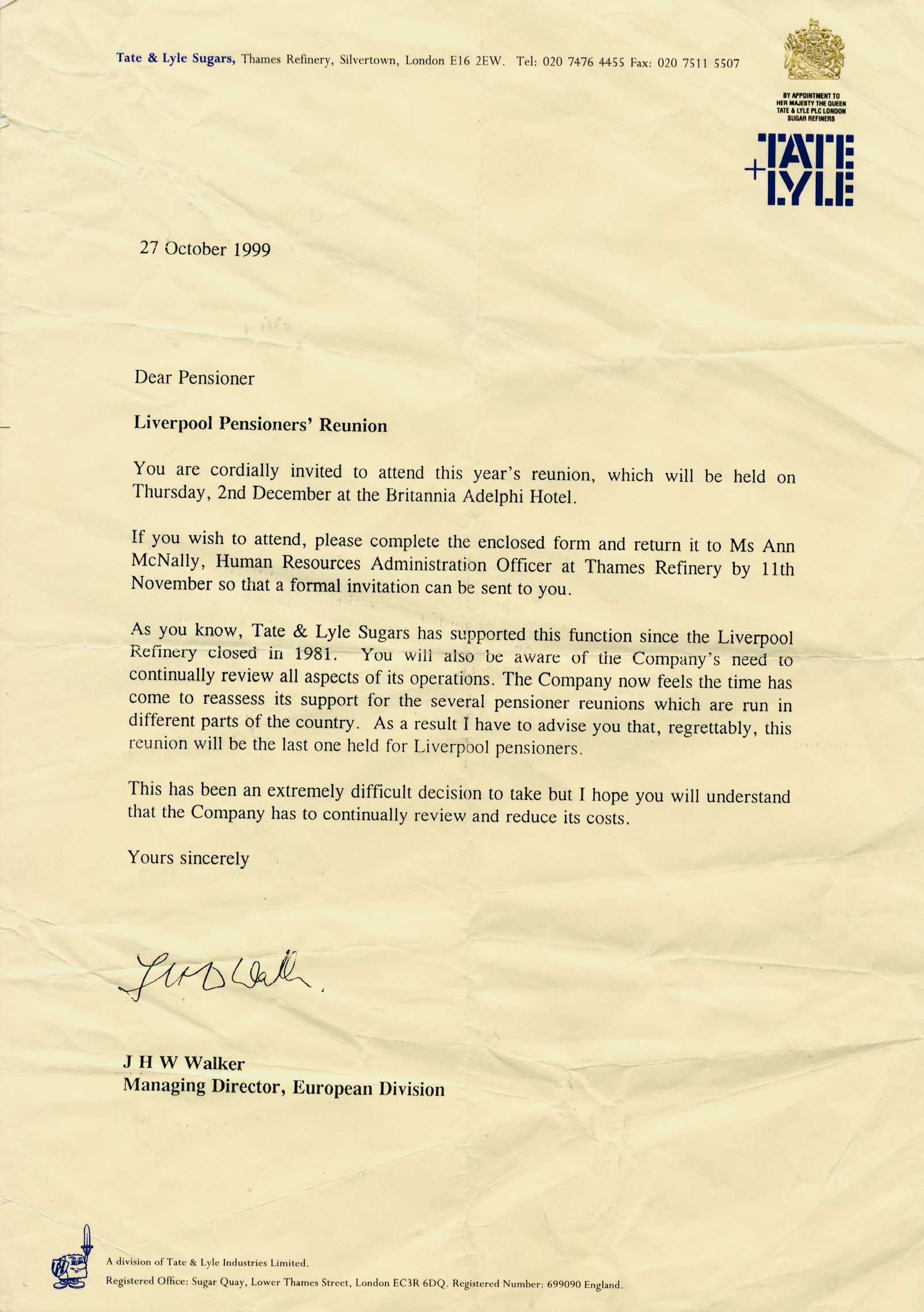
“Would it spoil some vast eternal plan if these Christmas get-togethers were to continue every two years, after all in ten or fifteen years most of us will have left for greener pastures?”
That was the plea articulated by former shop steward Bob Bannister at “the last tango on Lime Street” in December 1999 when because of Tate & Lyle’s stated need to “continually review and reduce costs” the history of the company’s “paternalism” and “biennial Christmas parties” for the boys and girls from Love Lane Liverpool came to an end. As a university teacher and honorary boy from the whitestuff I was determined to launch a petition to “bring back Christmas for the boys and girls from the whitestuff” only to have it categorically ignored/refused in 2001 a seminal year the world over. I had some big names on that petition as well as the signatures of many of the “extraordinary/ordinary lives” of former sugar refinery workers but the then CEO Larry Pillard refused to respond to my hand delivered letter to company headquarters at Sugar Quay London.
By that stage of my public history research the stubborness and determination of Albert E Sloane and other intrepid sweet fighters from the Lane had rubbed off onto me and with strategic pride we embarked on another skirmish with the Sugar Giant in 2006 on the 25th anniversary of the closure of Liverpool Love Lane refinery, the mother plant in Henry Tate’s global sugar dynasty. With the support and inspiration of Albert and other regulars at the Punch and Judy pub at the back of Lime St. where we held regular monthly meetings, a campaign was planned and this time unlike in 2001 it had the support and imprimatur of Tony Benn. Below is some of the surviving documentation that can do the talking:
1. The remarkable Peter Leacey: “When the ‘decline and fall’ of Liverpool is eventually written, let it be said of the Tate & Lyle Action Committee that there was no disgrace in failure. Disgrace comes in not having tried. And by God they tried.”
That comment by Peter Leacy, one of the company’s transport drivers, summed up a struggle that had actually lasted over 3000 days and culminated in “glorious defeat.His name would be included in my letter to the new CEO of Tate & Lyle in January 2006.
Dear Mr Ferguson,
I am a history teacher from Liverpool and next Sunday, January 22nd, will be the 25th anniversary of the issuing of 90 day redundancy notices to 1500 refinery workers at Henry Tate’s mother plant, Liverpool Love Lane. It is not exactly the kind of historical fact that is studied on the National Curriculum but it has a real resonance here on Merseyside, where the surviving “boys and girls from the whitestuff” look back nostalgically to the days when they helped sweeten the nations breakfast tables.
For me the only thing that mattered about sugar when I started to research Liverpool’s refinery workers, was that it was sweet, but that is the last thing that can be said about the history of the “white stuff”. Far be it for me to give the Chief Executive of a Sugar Giant that continues in the name of “Tates”, a history lesson, especially when you are married to a lady with impeccable historical credentials, but my brief goes beyond historical themes.
It is to make a request on behalf of the Tates Liverpool pensioners, the late Peter Leacy, Tony McGann of the Eldonians, Alan Bleasdale, Jimmy McGovern, Brian Reade, Jack Jones, and Tony Benn, that Tate & Lyle plc finance a reunion of the former Love Lane employees, either on or after April 22nd, the fateful day a quarter of a century ago when after 109 years of operation on the romantically named site, sugar cane time came to an abrupt end in Liverpool.
Our famous port city’s history is inextricably linked up with the politics and power of sugar and of a once prominent landmark, just north of the city centre, where the world’s biggest sugar dynasty was established in 1872. Facts like that were relayed to me by so many of your former Liverpool employees in friendly interviews where many talked about “family spirit” and the company being a “smashin’ firm to work for, most of the time”. Sadder tales were recounted however, and Mr Leacy, a proud former Tates pensioner visitor, told me of his bitter disappointment over the scrapping of the “biennial Christmas party” at the Britannia Adelphi Hotel, in December 1999 and of the disappointing responses to a letter he sent your predecessor, Larry Pillard, in January 2001.
Mr Leacy’s letter was written three weeks before the 20th anniversary of the issuing of the 90 days redundancy notices, and requested a final party bash! “The month of April…calls to mind the end of sugar refining at Love Lane factory in Liverpool, and your board of directors may wish to mark or commemorate the event to acknowledge the contribution that the many thousands of sugar workers made in over one hundred years to the well being, the prosperity, and the success of Tate and Lyle…May I therefore prevail on your good self, and your fellow directors to stage a final, one-off, never-to-be-forgotten farewell to Love Lane party at the very place of so many happy T&L get-togethers…the Adelphi Hotel in the City of Liverpool, on or near the date in April 2001. May I?”
He was then informed by Mr John Walker acting on the CEOs behalf, that because the company was having difficult times, reflected in a low share price, “I don’t think we could justify the kind of expenditure that such a party would require”. We hope sincerely that is no longer the case, especially given the lead your company took in the Footsie 100 just before Christmas last year.
Mr Leacy also described to me a cameo scene from the “last supper” on Lime St in December 1999 which I hope informs your response to this letter. “Mr Richard Springford, the ‘human resources’ supremo from T&L London, for whom I had worked during my southern sojourn, was appointed to deliver the final address of welcome and farewell at the Adelphi. I was annoyed when no senior staff person or ex Love Lane personnel bothered to reply either in gratitude for past Christmas dinners or to express regret at the ending of them. So I introduced Mr Springford to my old T&GWU shop steward, Bob Bannister who asked a very valid question…… ‘Would it spoil some vast eternal plan if these Christmas get-togethers were to continue every two years, after all in ten or fifteen years most of us will have left for greener pastures?’.”
Precisely! Sadly Mr Leacy passed away last June. So having discussed a number of options and after talking to his twin nieces, Sheila Sullivan and Councillor Sharon Sullivan, the course of action that has the backing and support of the names I quoted earlier, is to formally issue this 90 DAY REDUNDANCY PARTY NOTICE!
Yours sincerely
Ron Noon
2. Another “redundancy part letter” to MPs
Dear MP ,
I am writing this letter to ask for your support in what Tony McGann and a number of other prominent Liverpudlians think is a very worth while cause. Saturday April 22nd will be the 25th anniversary of the closure of Tate & Lyle’s Love Lane sugar refinery, and the surviving boys and girls from the Whitestuff, the very workers who gave such loyalty and dedicated service, unquestionably deserve a memorable reunion bash, hopefully financed by the Sugar Giant that started its corporate life in Liverpool.
In January I sent a letter to Iain Ferguson, the CEO of Tate & Lyle, that requested “on behalf of the Tates Liverpool pensioners, the late Peter Leacy, Tony McGann of the Eldonians, Alan Bleasdale, Jimmy McGovern, Brian Reade, Jack Jones, and Tony Benn, that Tate & Lyle plc finance a reunion of the former Love Lane employees, either on or after April 22nd, the fateful day a quarter of a century ago when after 109 years of operation on the romantically named site, sugar cane time came to an abrupt end in Liverpool”.
I received a reply from the Director of Corporate Communications and Deputy Company Secretary, dated February 2nd , which informed me that Mr Ferguson is “currently abroad on business” but “we are currently considering the proposal set out in your letter and will revert to you with an answer as soon as possible”. Unhappily that is too late for Peter Leacy, a proud former Tates pensioner visitor who initiated a similar request five years ago. He told me of his bitter disappointment over the scrapping of the “biennial Christmas party” at the Britannia Adelphi Hotel, in December 1999 and of the disappointing responses to a letter he sent to Ferguson’s predecessor, Larry Pillard, in January 2001.
Peter’s letter was written before the 20th anniversary of the issuing of the 90 days redundancy notices on January 22nd, and requested a final party bash! “The month of April…calls to mind the end of sugar refining at Love Lane factory in Liverpool, and your board of directors may wish to mark or commemorate the event to acknowledge the contribution that the many thousands of sugar workers made in over one hundred years to the well being, the prosperity, and the success of Tate and Lyle…May I therefore prevail on your good self, and your fellow directors to stage a final, one-off, never-to-be-forgotten farewell to Love Lane party at the very place of so many happy T&L get-togethers…the Adelphi Hotel in the City of Liverpool, on or near the date in April 2001. May I?”
He was then informed by Mr John Walker acting on the CEOs behalf, that because the company was having difficult times, reflected in a low share price, “I don’t think we could justify the kind of expenditure that such a party would require”. In 2006 we know that is no longer the case, especially given that the company is back in the Footsie 100 with sales of its no calorie Splenda doing splendidly.
Mr Leacy also described a cameo scene from the “last supper” on Lime St in December 1999: “Mr Richard Springford, the ‘human resources’ supremo from T&L London, for whom I had worked during my southern sojourn, was appointed to deliver the final address of welcome and farewell at the Adelphi. I was annoyed when no senior staff person or ex Love Lane personnel bothered to reply either in gratitude for past Christmas dinners or to express regret at the ending of them. So I introduced Mr Springford to my old T&GWU shop steward, Bob Bannister who asked a very valid question…… ‘Would it spoil some vast eternal plan if these Christmas get-togethers were to continue every two years, after all in ten or fifteen years most of us will have left for greener pastures?’.”
That is precisely what this is all about and that piece was included in my letter to Tates CEO in January, along with this conclusion: “Sadly Mr Leacy passed away last June. So having discussed a number of options and after talking to his twin nieces, Sheila Sullivan and Councillor Sharon Sullivan, the course of action that has the backing and support of the names I quoted earlier, is to formally issue this 90 DAY REDUNDANCY PARTY NOTICE!”
So hopefully now with the names of those who backed the original “90 DAY RPN letter” and the imprimatur of Liverpool MPs, and a petition, we will ensure that the Liverpool Tates pensioners, the men and women who over many years sweetened the nation’s breakfast tables, get their own memorable anniversary bash in 2006.
Yours sincerely
Ron Noon
3. We won! On August 28th 2006 we held a 25th anniversary party knees up in the Eldonian Village Hall scenes of which are contained on our website film. What is not recorded on that film and in the local press coverage of that event are my stumbling efforts to address the 250 partying pensioners and secure their attention. This was a night of partying and shared memories and the last thing anyone wanted was a “lecture” from a local historian, albeit the most sugarcentric on Merseyside. I shouted out a name and the audience hushed to hear what I had to say. This was my transcript, an even more precious one today:
28th April
“A telephone message from Tony Benn came through to my house at 4.15pm today. He said have a great night on the 25th anniversary reunion but lets all remember this:
(He asked me if I had a pencil and I had to tell a white lie because it was a red biro that I used!)
Today’s pensioners created the wealth we now enjoy. They are entitled to share in the wealth we create.” Barbara Castle said that and she gave us the link between pensions and earnings. This link was broken by Mrs Thatcher, never restored by New Labour, and we must get it back.
Good luck Liverpool
(I’m sure he was n’t being sectarian and as an astute politician he obviously meant the city of LIVERPOOL and not LFC.)
Thank you Tony Ben from the readers of LOVE LANE LIVES.
4. Here are two useful links about our reunion bash:
http://www.catalystmedia.org.uk/issues/nerve9/sweet_fa.php
http://www.liverpoolecho.co.uk/news/liverpool-news/bittersweet-memories-3520065
POSTSCRIPT
Tony Benn loved Liverpool and he also loved and admired our own Jack Jones who was another of the names on our 90 DAY REDUNDANCY PARTY LETTER!
THIS MESSAGE IS FROM JACK JONES
Dear Ron
I have read your e mail message to Mary and we both send our thanks for your efforts and good wishes.
As you know I am well into my nineties now and do not do much travelling – regretfully.
I am not able to be with you on the 28th but please convey my greetings and very best wishes.
Sincerely yours
Jack Jones
Contact: Mary Noor-Aly
26th September 1953: Sugar Rationing comes to an end at 12 Midnight!
Written by Ron Noon at 23:46 on Thursday, September 26th 2013
My first essay on MR CUBE the animated sugar lump that led the successful Tate & Lyle fight against threatened sugar nationalisation in 1949/1950 was published in HISTORY TODAY November 2001. It was entitled GOODBYE MR CUBE but obviously missing him in 2011 I co-authored another essay on the swash buckling champion of free enterprise (and “Tate not State”) with a former colleague at LJMU, David Clampin. (The Maverick Mr. Cube: the resurgence of commercial marketing in post-war Britain. Journal of Macro-Marketing)
We argued that the impact of the Second World War on British Society was widespread and much to the chagrin of its war time leader, Winston Churchill, the peoples war demanded a people’s peace without him and his Tory party at the helm. His party had been routed to the extent that they looked in danger of terminal decline. “The fear ‘was not that the Conservative Party had missed its turn…but that it would never get another’ (Schwartz 1991, 150). It was their Waterloo moment and arguably as devastating a defeat as in 1846 or 1906. Throughout the election campaign of 1945 Labour had spoken extensively of the prospect of the nationalization of key industries and, with it, a fundamental change in the nature of the business world.
Indeed The Economist at the end of that seismic year commented that ‘the voters were not so naïve as to imagine that they could get a Labour government without a Socialist policy’ (Rogow 1955, 156) given that ‘Socialism involves a radical transformation of incentives and motivations’ a ‘shift in the words of R. H. Tawney from an acquisitive to a functional society’ (Rogow 1952, 203). The tone of the Labour Government was distinctly cool towards the manufacturers of acquisitiveness.”
Those observations were made in an “academic essay” drafted with all the ritual genuflections to sources and the particular American journal’s etiquette and orientation. I’d felt constrained because I’d intended to write more about the post-war Labour Government’s achievements and less about the resurgence of commercial marketing.! At least I’d been able to write more about SUGAR which had been rationed since 1940 and establish some much needed context about why CONSUMPTION issues were of such great importance when “sweets and treats” had been absent for so long.
The much reduced sugar supplies in war meant that this generic and hitherto undifferentiated product would galvanise issues around food and consumption in a very bleak and austere post-war environment. When Peter Hennessey alludes to “an entire nation…obsessed with food” then sugar not steel is the commodity talked about in the grocers! That means that the grocery store, albeit not in the technical sense, becomes a political conduit for the “Tate not State” and “Dear, Dear, Dearer” sound bites of Mr Cube. (See some of the earlier blogs I’ve done on this lump of sugar. ) This is a way of saying that when a nation becomes obsessed with food the grocer becomes political!
There had been an experiment to de-ration sweets in April 1949 and it proved a failure. It was the month before Mr Cube was born in the Daily Express!
And then “just to cock a snook at Mr Herbert Morrison (Peter Mandelson’s grandad) and his colleagues, Mr Cube appeared on sugar packets timed for delivery over Christmas 1949, wearing a paper cap lifting a glass and saying ‘Whatever the Party, we wish you a merry Christmas”!
His seasonal greetings were conveyed in a very austere climate. For those however who argued that the Government was not doomed to a policy of continuing austerity Mr Cube was the proxy voice. He symbolised the fact that there is always far more to food than nutrition! Indeed the government’s nutritional adviser commented early on in the post-war period that “because meals, have become so much more unattractive…people will not eat sufficient to eat their daily energy requirements”. It is that psychological context and the reminder that sugar was both a fact and a metaphor for the sweet things in life conspicuously absent, despite improved vital statistics, that provides the key to understanding the politics of food discontent.
Bargielowska ‘s book on post-war austerity reminds us that although there was no objective evidence of under-nourishment “perceived deprivation was intense”. A cameo of this early predilection towards the good life as the sweet life was the experiment in de-rationing sweets referred to above. When carrots were sucked by children as sweets, Pathe News recorded the events in April 1949 that were designed to “put the fun back into being young” with its film footage of tiny tots queuing in anticipation of sweet shops opening up with their de-rationed goodies.
“Tots mouths have watered a whole lifetime for this great day. For years they’ve been cheated by the hard facts of world economy, from the unrestricted orgies, once accepted as the birthright of every child. But now hundreds and thousands are back by the billions, sherbert and gobstoppers and aniseed balls, lollipops and chocolate bars. And now for the Tummy Ache of a lifetime.”
The anticipated epidemic of tots tummy aches was prevented by so called killjoy Food Minister John Strachey who did not build up sufficient stocks to meet the pent up demand and failed “to take into account considerations such as the present high cost and shortage of tobacco, the cut in our meat ration and our dull diet”.
The disappointing result was that unlike France, Holland, Belgium, Luxembourg, Poland, Switzerland and Eire, Labour Britain botched the experiment in assuaging dietary severity with sweets. Consequently when “treats” like sweets were re-rationed the sweet fightin’ icon of free enterprise was a permanent reminder to contemporaries that there were choices and policy differences between the political parties. That was the political significance of the Mr Cube campaign and on September 26th1953 at midnight Sugar and sugar lumps were de-rationed successfully.
A re-released Bitter Sweet “Golden Oldie” from June 2001
Written by Ron Noon at 09:09 on Monday, May 20th 2013
The Boys and Girls from the Whitestuff
“I have come to the conclusion that there is nothing economically rational about the sugar business.” J.B.Bunker (President of the Holly Sugar Corporation. 27.2.1978.)
This is a bitter sweet story stretching back at least six hundred years and traversing strange latitudes and thousands of miles. From Liverpool, the former eighteenth century slave capital, and 1960s home of the Beatles, across the Atlantic to Decatur Illinois, a sleepy mid west town 175 miles south of the Windy City and original home of the Chicago Bears, the sugar chain extends due east back to Spike Lee’s hometown in Brooklyn, New York. The skeins of interconnectedness in this chronicle of globalisation are very much associated with sucrose, a simple taken for granted commodity with an infamous history, lucidly indicted in 1944 by the Oxford scholar and former Prime Minister of Trinidad, Dr Eric Williams. “Strange that an article so sweet and necessary for human existence should have occasioned such crimes and bloodshed.”
The terrifying images of transatlantic trade in human cargo and the African diaspora that decanted millions to the New World provide cruel evidence of slavery as the indispensable handmaid of the sugar industry. This together with proof of Liverpool’s lubricating role as a “slave city first”, is a potent reminder of the politics and power of sugar, a far from “natural” product, that the industry are loath to admit, mankind was able to do without for millennia. The Bible was a land of milk and honey not sugar and spice but subsequently there has been no other food which has rivaled this simple carbohydrate, (C12 H22 011) “in its influence on human affairs”. To the “food faddists” it is an “empty calorie” and “granulated scourge”, and decidedly not the “crystallised sunlight” of photosynthesis and school misinformation packs.
Nature was patently unaware of commerce when Columbus on his second Antilles voyage in 1493 transferred sugar cane from the Portuguese islands off the coast of Africa to the Island of Hispaniola, now divided into Haiti and the Dominican Republic. What is perceived in the travel brochures depicting the Greater and Lesser Antilles as indigenous flora and fauna was five hundred years earlier distinctively novel. The French food writer Maguelonne Toussaint-Samat in evoking Turgenev’s “genius of hunger”, reminds us that “the practice of hunting and gathering, the consumption of salt and cereals, the discovery of stock breeding and wine, the use of spices, sugar, potatoes, proteins, have all been stages along the way, each in turn shaking the known world to its foundations”. In that sense1493 marks the beginnings of Europe as “the monstrous shaper of world history”, with aggressive colonial expansion and global movements of people, plants and diseases to configure the following centuries.
Columbus’s epochal inauguration of sugar cane time and “the sugar standard”, rocked that new world so much that by the late seventeenth century the Dutch found it hard to resist the lure of “white gold” in Surinam in South America, and negotiated with the English Duke of York, stewardship over what is now the most expensive real estate in the Cosmos. It was obviously a commodity worth fighting over and in 1763 following the 7 Years War Britain negotiated a Peace Treaty that came glaringly close to repeating the earlier Dutch mistake with its initial preference for the French sugar islands of Guadeloupe and Martinique over the whole of what is now Canada! How many picketing Domino refinery workers earlier on this year with strike funds and accident cover dwindling, would have had the appetite for such historical reflexivity, as the bitter winds from the East River smacked into their marrow, and life continued pretty much as usual over the Williamsburg Bridge, in that big sugar cube of old New Amsterdam? [LOOKING AT THIS NEARLY 12 YEARS AFTER THE SUMMER SCHOOL, THE WEEK AFTER GOING OVER ON THE J TRAIN TO WILLIAMSBURG TO SEE WHAT’S LEFT OF THE FORMER DOMINO REFINERY IS VERY STRANGE!]
The main commercial source for the European and North American sugar refineries before the nineteenth century and Napoleon’s sponsorship of the ugly mangel wurzel sugar beet, was the majestic sugar cane, a reed which the Greek naturalist, Pliny the Elder claimed “produced honey without the intervention of the bees”! No bees but millions of Africans were needed in the Americas to cultivate this quintessential slave crop and agri-business. It far exceeded other exotic tropical produce such as coffee, tobacco and cotton in the rigours of its cultivation and even today as the tall and aesthetically pleasing reed sways in the tropical breezes, it is described as a backbreaking “hunger crop”, emblematic of the plight of many Third world countries. It is not much use in its “natural” state, and the industrial demands of rapidly milling and processing the cane into raw sugar has been a predominantly third world activity before shipment to Metropolitan port refineries for the final high value added processes. These refineries are the “temples of applied science” sponsored by capitalism’s profitable synthesis rather than nature’s photosynthesis.
Now into its seventh century of global expansion and in its indirect uses very much part of the “natural” architecture of processed and fast foods, sugar makes the products of Bill Gates seem pre-pubescent. In the twenty first century it is obviously not the only kid on the sugar and sweetener block, but perhaps miserably from the perspective of a new breed of anti-sacharites and “sugar busters”, most people think the only thing that matters about sugar and sweeteners, is that they taste sweet. Sweetness is the last thing that can be said about its history and the industry that produces not only sugar but its first main biotech breakthrough, High Fructose Corn Syrup, widely used in the lucrative soft drinks market. Nor does syruppiness explain the aggressive human resources management of global sugar giant, Tate & Lyle. In June 1993, it locked out 760 of its employees in Decatur in a dispute which lasted thirty months but achieved company objectives of “downsizing” the union and re-scheduling work shifts to conform to the company calendar rather than the more natural work rhythms that had made family and social life predictable. More recently at the 143 year old Brooklyn refinery, there in the shadow of the Williamsburg Bridge, a twenty month battle with the union was initiated by management demands to lay off 100 workers and sub-contract work and ended in March this year with defeat for the strikers.
The London based transnational was founded in Liverpool by Henry Tate a wealthy nineteenth century entrepreneur and philanthropist, sixty five years after Britain abandoned the Slave Trade. It operates in five continents and over fifty countries and first broke into the profitably protected North American sugar market with a leveraged buy out of the Decatur based corn syrup producer A.E.Staley in 1988. The fact that the Chicago Bears started out as a company sponsored team named the Decatur Staleys, coached by the legendary George Halas was less important than HFCS. The subsequent acquisitions made by “Tates”(the term of endearment/estrangement to its former Liverpool workers) included Domino Sugar, (cane) and until recent sales and divestments, Great Western, (beet). The company have manifestly undergone a corporate transplant from the paternalistic days of yore. From rationalisation and closure of their mother plant in Liverpool Love Lane in 1981 when significantly there was neither a Tate nor a Lyle on the board, to “downsizing” in the “War Zone” of Decatur and strike breaking in New York, Tates has belied not only that anodyne adjective, sweet, but its once proudly held reputation as an exemplary family firm. Generations of former employees perceived it as deliberately encouraging a friendly “company spirit” and viewed it as “a good firm to work for”.
Even after the act of matricide in the love starved Lane where eighteenth century “maidens and ladies” perambulated, overlooking stunning views of the Mersey, the Welsh mountains and sailing ships with slave tainted produce, the company ensured that there was a Christmas Party for the Tates pensioners. It was held in Liverpool’s Britannia Adelphi Hotel, initially each year but then “biennially”, agreeably catering for the associational needs and seasonal festivities of the old boys and girls from the whitestuff. Unhappily at the end of last Millennium the ex-refinery workers, many of whom never secured another job when the prominent Liverpool landmark was pulled down, were told the devastating news that “because of the need to continually review and reduce costs”, the bunting and streamers that were going up in the hotels magnificent banqueting hall, would sadly commemorate the last ever company sponsored Christmas party. December 2nd 1999 was the former Tates employees last supper and the sadness of the occasion was visibly reflected in the comments made to local reporters. This is no ordinary local history because Liverpool as a port city has been a barometer since the eighteenth century, of national and international trends, playing a central role in that earlier phase of European mercantile expansion that generated the displacement and scattering of millions of brutalised Africans. Social relations and decision making have never stopped at the Pier Head and Liverpool’s economic reach was emphatically global a couple of hundred years before the “isation” was tagged on to the G word.
Part of the identity legacy of Henry Tate the former grocer and populariser of sugar cubes is not just the company that bears his name but impressive artefacts of his private philanthropy. In Liverpool he left an imposing Unitarian Church in Ullet Road, a former hospital in the city centre called the Hanneman building and the striking red brick of Liverpool University’s Tate Hall. In London he financed an impressive public library in Brixton and more famously inspired the Tate Gallery and Tate Modern which interpelate his donations to the arts and culture. Part of his legacy, albeit unintentional is sadly a scrooge like and soulless global corporation. In the absence of ghostly interviewing techniques I can only hazard the suggestion that the meanness of spirit which resulted in the junking of Christmas in his former sugar capital, and recent trade union bashing in the economic capital of the free world, has caused the creator of this formidable sugar dynasty to turn in his grave.
Five hundred yards up from the impressive Liverpool waterfront is the splendid town hall whose corridors are still adorned by busts of blackamoors and elephants. It was built in the late eighteenth century when powerful slave trade interests were coming up against popular agitation to end the evil trade. “Beyond doubt it was the slave trade which raised Liverpool from a struggling port to one of the richest and most prosperous trading centres in the world.” That comment by historian Ramsay Muir and extracts from an Election pamphlet in 1790, sum up the influence and command of the slave trade interest. “If you have any regard for your God; If you have any regard for your King; If you have any regard for your country; If you have any regard for your native town and its prosperity…Vote for General Tarleton who so ably supported the African trade and the commercial interests of Liverpool…The Church and Slave Trade forever.” A few years later a drunken actor was cruelly booed by an audience of rich merchants inside Liverpool’s Theatre Royal. George Cooke’s response as he coruscated off stage, was scathing. “I have not come here to be insulted by a set of wretches, every brick of whose infernal town is cemented with an African’s blood.” In Britain’s “Gateway to Empire”, and richest of nineteenth century provincial cities, it is chastening to reflect that with one of the oldest indigenous black populations in Britain, it is not just thespian echoes that resonate in its outstanding civic buildings.
Liverpool’s infamous history as the capital of the slave trade may have belatedly been addressed in 1994 when a Transatlantic Slave Gallery was opened, symbolising a civic and public acknowledgement of its nefarious role in that momentous Black Diaspora of world history. Nevertheless twenty years after the disturbances and riots that erupted in Lodge Lane and Liverpool 8 in July 1981, Black people’s long standing inequality in this city has still to be positively remedied. Students, including a large number of African American students attending Liverpool University’s three week Summer School on Liverpool’s Black roots, will have opportunities this June to plug the past into the present and debate these issues and the legacy of slavery. They will experience a powerful evocation of that infamous trade by visiting the Transatlantic Slave Gallery down at the Albert Dock, adjacent to the Museum of Liverpool Life and the Tate Gallery. Significantly the benefactor’s name provides a reminder, twenty years after the closure of Love Lane, that there are skeletons in the company cupboard which demand more forensic examination than provided here. The sugar links stretching across from Love Lane and Lodge Lane to the Workers Memorial Viaduct in Decatur and the Willamsburg Bridge, New York, provide evidence for a reality check on “Tate & Lyle in the Community” and the Pensioners corporate campaign to bring back Christmas for December 2001. Bob Bannister one of the pensioners asked “would it spoil some vast eternal plan if these Christmas get-togethers were to continue every two years, after all in ten or fifteen years most of us will have left for greener pastures”?
Planters in the AnteBellum South once used the threat of deportation to Cuba as an instrument for disciplining their slaves and although to some it may appear hyperbolic, one of the course themes at the Summer School was influenced by a saying used by planters in Cuba which almost transcends metaphor and figurative language. “Con, sange, se hace azucar.” Sugar has been made with blood, and it has been shed in a variety of different and protracted ways, even in rich first world countries. In Liverpool, Decatur, and even in the Big Sugar Cube of New York, the damage to the health and safety and general morale of “sugar workers” caused by rationalisations, downsizing, union busting and “lean production” methods, has devastated families and communities. Nevertheless it is Third world producers who are more systematically and regularly short changed.
Twenty years ago, when the European Community put forward proposals to cut the structural sugar beet surplus they were opposed by Margaret Thatchers Government, and the writing was clearly on the wall for Love Lane, Henry Tate’s spiritual home. The city which was renowned for the Merseybeat in the 60s was the victim of the sugar beet and a soulless global corporation with no apparent local loyalties. The community blight and lengthening dole queue in Liverpool was not unrelated to the riots and disturbances a few months later but even this was eclipsed by the exacerbation of abject poverty and hunger in the Third World cane producing countries. The World Development Movement presciently summed up what is still very much the issue today. “A rich country’s sugar policy – who it buys its sugar from and how it pays for it - is a vital litmus test of its proclaimed benevolence towards the poor world.” Precisely but the reality is a continuing pattern of dependency and neo-colonial relations manifesting itself in the sweat and blood of “half slaves” and migrant labourers, cultivating sugar cane in parts of the Caribbean and South America today. What a chastening reminder this ought to be of how a unique commodity demands more than just history lessons.
Ron Noon 8.6.2001
[I had n’t found out about the Fanjuls in June 2001 who subsequently bought Domino from Tates and then closed the Brookly refinery down in 2004 and then in 2010 purchased Tate & Lyle sugar. Who does really know about the chicaneries of the Fanjuls outside of this crazy world of sucrose?]
JIM SMITH 1911-2013 RIP
Written by Ron Noon at 11:09 on Saturday, March 09th 2013
JIM SMITH 1911-2013 RIP
Yes the very sad news has been relayed to me that Jim Smith one of the stars of our Boys and Girls from the Whitestuff film has passed away. I had an email from his son Ken down in Bournemouth that “my dad Jim Smith passed away on Sunday 3rd March. He was 102 years old…He went very peacefully. The funeral is taking place on Tuesday 12th March at 1.00pm in the chapel at Christopher Grange Nursing Home, Youens Way, L142EW”.
Very sad but Jim’s life will live on with the undying love and memories of his close family and our “family” on this site. Love Lane Lives is designed to celebrate the lives of extraordinary ordinary lives, and when we commemorate the boys and girls from the whitestuff Jim’s sparkling commentary and observations are always available “cinematically” on this site. Great man and great storyteller.
That was Jim with the Lord Mayor and his mischievous friends on his 100th birthday.
Check this out: http://www.lovelanelives.com/index.php/blog/entry/pictures_of_jims_special_day
JANUARY 22ND 1981: 90 day REDUNDANCY NOTICES for Love Lane Refinery Workers
Written by Ron Noon at 15:26 on Tuesday, January 22nd 2013
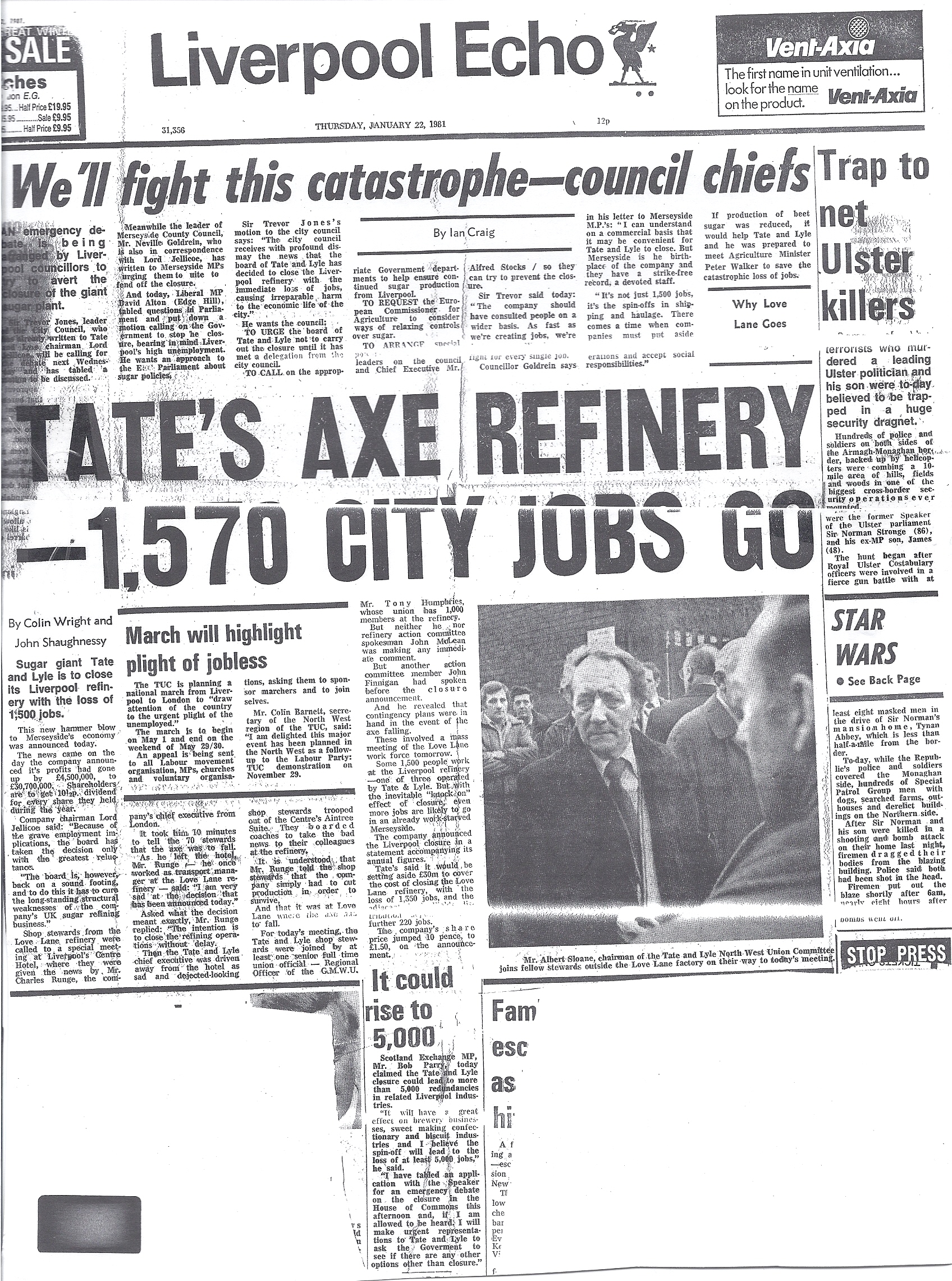
(A blog I did two years ago details the closure: http://www.lovelanelives.com/index.php/blog/entry/tates_90_day_redundancy_notices_thirty_years_after There is also the SAVE OUR SUGAR from Hillside School to read if you are new to this site. http://www.lovelanelives.com/index.php/blog/entry/save_our_sugar)
Before I illustrate the nature of the 90 day notice delivered to Tate & Lyle’s Chief Executive on January 22nd 2006 there are two key points to be made:
TWO incontrovertible facts have shaped my obviously partisan opinions as to why the comically misnamed Liverpool Love Lane Sugar refinery was closed down at the end of the 90 day redundancy notice period. 1500 workers and their supporters had to try and pull off in that concertinaed time frame, what they had failed to achieve in over eight years of struggle. The result was that a prominent Liverpool Landmark was shut down on April 22nd 1981. That had been Henry Tate’s mother plant.
1. The first piece of evidence particularly relevant on this 32nd anniversary of the issuing of the 90 day notices is that Tate & Lyle were the major recipients of regional aid between 1975 and 1981. That attention grabbing detail is verified by a document from the Planning Officer of the City Council, issued a few days after the 90 day redundancy notices had been issued and in the records that Albert and John gave to the Museum. * (see at foot of blog)
2. The second and equally incontrovertible evidence is that “ship sales will cover the Liverpool redundancy costs”, a point confirmed not in the museum but in the Lex Column of the Financial Times in May 1981. Ships that were originally bought through Bermuda based subsidiaries were now being sold to help finance a massive closure in what had been described as “the Bermuda triangle of British capitalism”.
Starting with a conclusion was not the method of the company historian, J.A. Watson but that did not preclude him from adopting a position statement at the beginning of his book which was a professedly “neutral opinion”! He argued that closure “could not have been prevented by the company acting on its own”. I fundamentally disagree with that.
“Counter-factual” is a jargon term imported from America which has established considerable scope for coffee table discussions on “what if” questions, and some quite successful novels and histories. We all have a habit of asking “what if” even “if” it is only to reflect on whether Anthony would have been as infatuated with Cleopatra “if” she had had a different shaped nose! “If” it had not been for Clive Thomas in April 1977 then we would have been at Wembley and not LFC!
The teacher character in Graham Swift’s Waterland is for me however the one who brilliantly, albeit unwittingly, provides the best reality check on Love Lane’s closure in 1981. He describes the “if” word as “sly and insidious” but “if” Love Lane had been kept open it would have at least acknowledged their earlier commitment to keep a presence on the site, in what had been the “jobs for jobs” policy of the late 1970s. Instead the end of a once prominent Liverpool Landmark just north of the city centre was both sly and insidious for the generations of workers who had not only devoted their working lives to Tate & Lyle, but vaingloriously believed right up until the very end, that despite fears over the Common Market and its egregious Common Agricultural Policy favouring first world beet sugar over African, Pacific and Caribbean raw cane supplies, that the company would maintain some presence on this historic site. It certainly benefited more from regional aid than any other company and of course after that was exhausted it had run!
Tates may have denied “transfer pricing” but it certainly operated a sophisticated fiscal policy. (Transfer Pricing relates to the price at which divisions of multinational/transnational companies transact with each other. Transactions include the trade of supplies or labor between departments and are always influenced by lower cost tax regimes.)
A good example of this is how a subsidiary of a Canadian subsidiary was able to provide monies from Bermuda to buy ships for the Tate & Lyle Group in the 1970s. Canada and Dominion which later became Redpath was Canada’s largest sugar refiner but in 1959 Tates acquired a majority holding in the firm. In 1965 when Tates had a 56% holding in the company, Saxon Tate became its managing director and with a considerable “war chest” was in a position to “undertake the first diversification of the Tate & Lyle group outside of sugar” into shipping and other activities. Under him a subsidiary Albion Limited was established in Bermuda to take charge of trading, broking and shipping activities. Bermuda was the ideal place to create a trading firm or as Chalmin suggests at the very least “the ideal place for its letter box”. This was very profitable and helped to finance the acquisition of ships for Tate’s Shipping Line. The Canadians were very discrete about Albion Ltd but how many redundant refinery workers in Liverpool were aware of Tates corporate welfare funding and the ironic fact that “ship sales” were used to finance the cost of redundancy. These were ships that may have been financed from the Bermuda subsidiary to fund another hole in the Bermuda Triangle of British capitalism.
Back to 2006 and the 90 day REDUNDANCY PARTY LETTER letter sent to Iain Ferguson!
19.01.2006
Dear Mr Ferguson,
I am a history teacher from Liverpool and next Sunday, January 22nd, will be the 25th anniversary of the issuing of 90 day redundancy notices to 1500 refinery workers at Henry Tate’s mother plant, Liverpool Love Lane. It is not exactly the kind of historical fact that is studied on the National Curriculum but it has a real resonance here on Merseyside, where the surviving “boys and girls from the whitestuff” look back nostalgically to the days when they helped sweeten the nations breakfast tables.
For me the only thing that mattered about sugar when I started to research Liverpool’s refinery workers, was that it was sweet, but that is the last thing that can be said about the history of the “white stuff”. Far be it for me to give the Chief Executive of a Sugar Giant that continues in the name of “Tates”, a history lesson, especially when you are married to a lady with impeccable historical credentials, but my brief goes beyond historical themes.
It is to make a request on behalf of the Tates Liverpool pensioners, the late Peter Leacy, Tony McGann of the Eldonians, Alan Bleasdale, Jimmy McGovern, Brian Reade, Jack Jones, and Tony Benn, that Tate & Lyle plc finance a reunion of the former Love Lane employees, either on or after April 22nd, the fateful day a quarter of a century ago when after 109 years of operation on the romantically named site, sugar cane time came to an abrupt end in Liverpool.
Our famous port city’s history is inextricably linked up with the politics and power of sugar and of a once prominent landmark, just north of the city centre, where the world’s biggest sugar dynasty was established in 1872. Facts like that were relayed to me by so many of your former Liverpool employees in friendly interviews where many talked about “family spirit” and the company being a “smashin’ firm to work for, most of the time”. Sadder tales were recounted however, and Mr Leacy, a proud former Tates pensioner visitor, told me of his bitter disappointment over the scrapping of the “biennial Christmas party” at the Britannia Adelphi Hotel, in December 1999 and of the disappointing responses to a letter he sent your predecessor, Larry Pillard, in January 2001.
Mr Leacy’s letter was written three weeks before the 20th anniversary of the issuing of the 90 days redundancy notices, and requested a final party bash! “The month of April…calls to mind the end of sugar refining at Love Lane factory in Liverpool, and your board of directors may wish to mark or commemorate the event to acknowledge the contribution that the many thousands of sugar workers made in over one hundred years to the well being, the prosperity, and the success of Tate and Lyle…May I therefore prevail on your good self, and your fellow directors to stage a final, one-off, never-to-be-forgotten farewell to Love Lane party at the very place of so many happy T&L get-togethers…the Adelphi Hotel in the City of Liverpool, on or near the date in April 2001. May I?”
He was then informed by Mr John Walker acting on the CEOs behalf, that because the company was having difficult times, reflected in a low share price, “I don’t think we could justify the kind of expenditure that such a party would require”. We hope sincerely that is no longer the case, especially given the lead your company took in the Footsie 100 just before Christmas last year.
Mr Leacy also described to me a cameo scene from the “last supper” on Lime St in December 1999 which I hope informs your response to this letter. “Mr Richard Springford, the ‘human resources’ supremo from T&L London, for whom I had worked during my southern sojourn, was appointed to deliver the final address of welcome and farewell at the Adelphi. I was annoyed when no senior staff person or ex Love Lane personnel bothered to reply either in gratitude for past Christmas dinners or to express regret at the ending of them. So I introduced Mr Springford to my old T&GWU shop steward, Bob Bannister who asked a very valid question…… ‘Would it spoil some vast eternal plan if these Christmas get-togethers were to continue every two years, after all in ten or fifteen years most of us will have left for greener pastures?’.”
Precisely! Sadly Mr Leacy passed away last June. So having discussed a number of options and after talking to his twin nieces, Sheila Sullivan and Councillor Sharon Sullivan, the course of action that has the backing and support of the names I quoted earlier, is to formally issue this 90 DAY REDUNDANCY PARTY NOTICE!
Yours sincerely
Ron Noon
........................................
background_note_City_Planning_Office_28_1_1981.pdf
1999 & The Last Tango on Lime Street.
Written by Ron Noon at 19:02 on Monday, December 03rd 2012
When the Archies sang Sugar, Sugar, back in 1969, they would not have imagined that the simple, pimp like carbohydrate saturating food and drinks as well as the lexicon of love, was the most intensely political and complex of all commonly traded commodities! Sugar, Sugar has always been intensely political and unlike Black gold, White Gold is in its seventh century of global expansion and you can not only ingest it but in Brazil they use it to provide the Tony the Tiger in their alcool tanks! Anyway 30 years after the ultimate manufactured pop group sang “pour a little sugar on it honey”, (they were as animated and cartoon like as Mr Cube himself!) Tate & Lyle’s Liverpool pensioners were eagerly anticipating the company-supported “biennial” Christmas party, in the Britannia Adelphi hotel, only to be shocked and saddened by the contents of a letter from John Walker, the Managing Director of the Sugar Giant’s European Division.

“Regrettably, this reunion will be the last one held.” His final sentence, hanging ominously over Mr Cube, the famous animated company cartoon that had brandished his sword and shield for “Free Enterprise”, stressed that it had been “an extremely difficult decision to take but I hope you will understand that the company has to continually review and reduce its costs”. (Just have a look at that letter in the blog summary!) Albert E Sloane, a bitter sweet fightin’ man who had figured prominently in the ten-year struggle to prevent the closure of the comically misnamed Love Lane refinery, the mother plant in Henry Tate’s domain, was very angry with this “rationalisation”.
He’d never lived his working life as a cost of production and yet history appeared to be repeating itself as another Tate & Lyle sponsored domestic tragedy for the feisty 77 year old. These were the thoughts that flicked through Albert’s mind as he and the surviving boys and girls from the whitestuff assembled for their last Christmas Party, beneath resplendent streamers strung across the banqueting hall of a once quite magisterial hotel. Cold business logic was matched by the weather outside on Thursday, December 2nd. Even wrapped up in sugar-coated management rhetoric the letter announcing their last Tango on Lime St. was perceived by the majority, who like Albert devoted most of their working lives to the company store, as of nothing less than Scrooge like meanness of spirit.
Albert’s close mate, John Maclean wryly observed “Christmas only come around every two years with Tates and each time absent friends meant that it got cheaper. We never thought they’d scrap it altogether mind.” Smile, it’s Tate & Lyle. Definitely not on Merseyside!
This bitter sweet story had some local but no national impact at all. David Charters of the Liverpool Daily Post reported the Last Supper in the Adelphi and “Party spirits dampened by bitter-sweet memories”, but sadly, like strikes and sacked dockers, such stories were not sexy enough for full national coverage. Just as well given that a company’s most important reputational asset is its brand and logo. The full story of why Tate & Lyle suffered from a cold hearted Ebenezer Scrooge virus at the end of last century, having made £231m profit ought to have translated those thin anodyne smiles on faces of corporate spokespersons, and even their animated sugar lump logo, into more fittingly mean faced expressions. Albert’s preferred scenario, supported by all the older boys and girls from the whitestuff , was to fulminate with anger and to demand that the guys in the Punch and Judy campaign to bring back Christmas!
Just look at this from December 3rd 1999. Thank you David Charters who has been a great supporter of the Love Lane Lives project ever since:
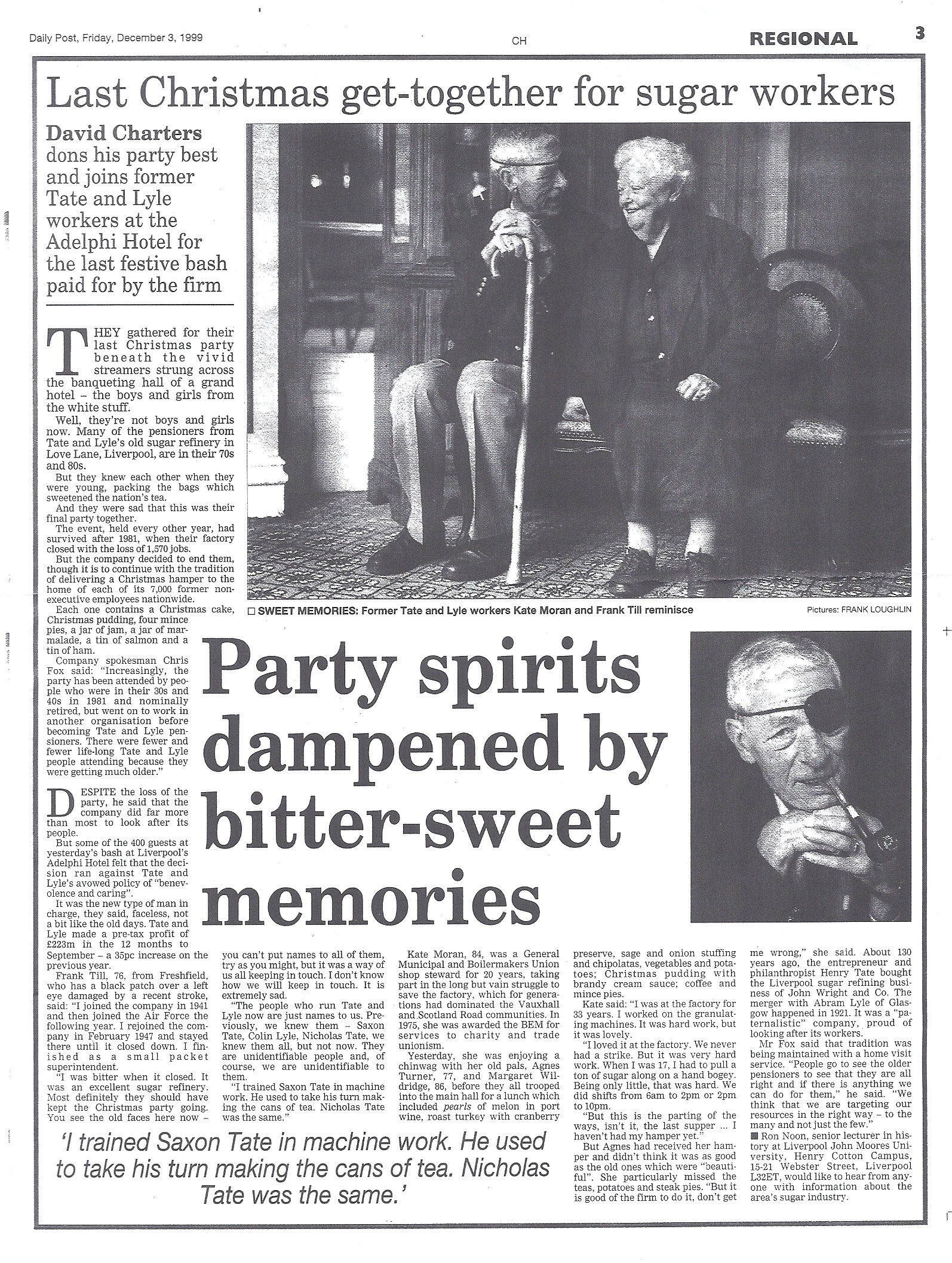
George’s last ride and Love Lane Lives
Written by Ron Noon at 14:13 on Wednesday, November 07th 2012
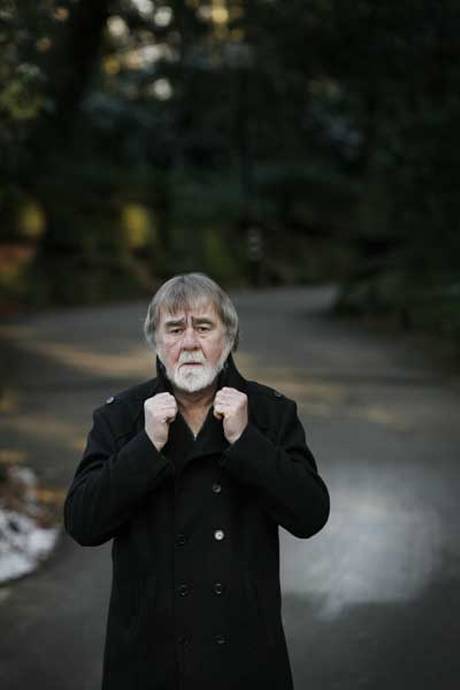
Tonight is exactly 30 years since Alan Bleasdale’s award winning series, The Boys from the Blackstuff, finished its first run on BBC2. “George’s last ride” was its final and unforgettable last episode and it made for more than just brilliant television drama. It articulated a zeitgeist of seemingly terminal economic decline for the once proud port city in which it was set, and more threatening than the disappearance of jobs, were lost hopes and dreams of battered and bewildered communities, in what figuratively was dubbed “The Bermuda Triangle of British Capitalism”! Chrissie one of the key characters in the series asks “what’s going wrong Logo, what’s going wrong” and the unequivocal answer was “everything la, everything”.
In the Sixties, the Merseybeat sound conquered the musical world and for fifty one weeks between April 1963 and May 1964 there would be a recording by a Liverpudlian artist at Number 1 in the charts, one understandable reason why we played a pivotal part in the so called cultural revolution that liberated that decade. Despite the Beatles the basic economic fact was that unemployment in the musical capital of the world was twice the British national average. So despite the world wanting to hold a Beatle’s hand in what seemed its musical apotheosis, the city and the Merseyside region in general in the 20 years that followed were ravaged by fallout from severe global economic recession. Between 1966 and 1977 no less than 350 factories in Liverpool closed or moved elsewhere, 40,000 jobs were lost and between 1971 and 1985 employment in the city fell by 33 per cent. The little ditty doing the rounds in the early 1980s and expressed in the Scotty Free Press was: “Redundancies here, Redundancies there, Redundancies, Redundancies everywhere”.
As Jon Murden expressed it in Liverpool 800, “from the docks to flour milling and telephone equipment, from office equipment to animal foods, there had been job losses and factory closures and as one British Leyland worker expressed it in 1980 two years after the Speke factory had been closed down, ‘I don’t know what’s happening. It seems like there’s just nothing doing for this town’. By the early 1980s most of the dock system had been changed and converted to other uses. The port that had created [modern] Liverpool had dwindled to insignificance and left the city with huge economic and political problems.”
A national tabloid 27 days before George’s last ride appeared on our screens asserted that “they should build a fence around [Liverpool] and charge admission. For sadly, it has become a ‘showcase’ of everything that has gone wrong in Britain’s major cities.” (Daily Mirror 11.10.1982). Whether depicted as showcase or basket case, the enormous condescension of media coverage was as widespread as the government policy of “managed decline” for the former gateway to empire, was top secret! The clichéd references to “Merseyside militancy” and so called “generalised apathy” had been trotted out with strike statistics that purported to show that the leaving and grieving of Liverpool was a self inflicted wound which the truculent workers had only themselves to blame for. (Tate & Lyle had not had a serious industrial relations hiccup since the 1926 General Strike and the company was subsequently found out as the biggest recipient of regional aid and assistance between 1975 and 1980!)
Not all newspapers indulged in the scapegoating. “The question that remains to be answered is why, when companies choose to rationalise, the blow so often falls on Merseyside?” That question posed by the Financial Times was a means of moving the focus from subjective phenomena into examining structural explanations, such as the make up and mix of industries in the local economy and Merseyside’s proneness to external decision making, particularly given the large numbers of MNC branch plants based here. In 1980 a collaborative and interdisciplinary project involving members of the University of Liverpool and the then Liverpool Polytechnic wrote and published…Merseyside in Crisis. In the book, the authors, (and I was one of them), attempted to elaborate the scale of the socio-economic disaster that Merseyside was experiencing at the time, and not only seek to explain the historical roots of this ‘crisis’ but how references to “Merseyside militancy” and “mindless militancy” were a reversal of cause and effect. We addressed over 100 meetings in the Merseyside area to publicise and sell the book & 5,000 copies were sold within 18 months, the vast majority within the locality, and mostly to a non-academic readership. We argued that “if the Government’s own estimates of 40 per cent unemployment are anything to go by, Liverpool looks set to become the Jarrow of the 1980s”! Was it any wonder that the People’s March for Jobs began in this city in May 1981?
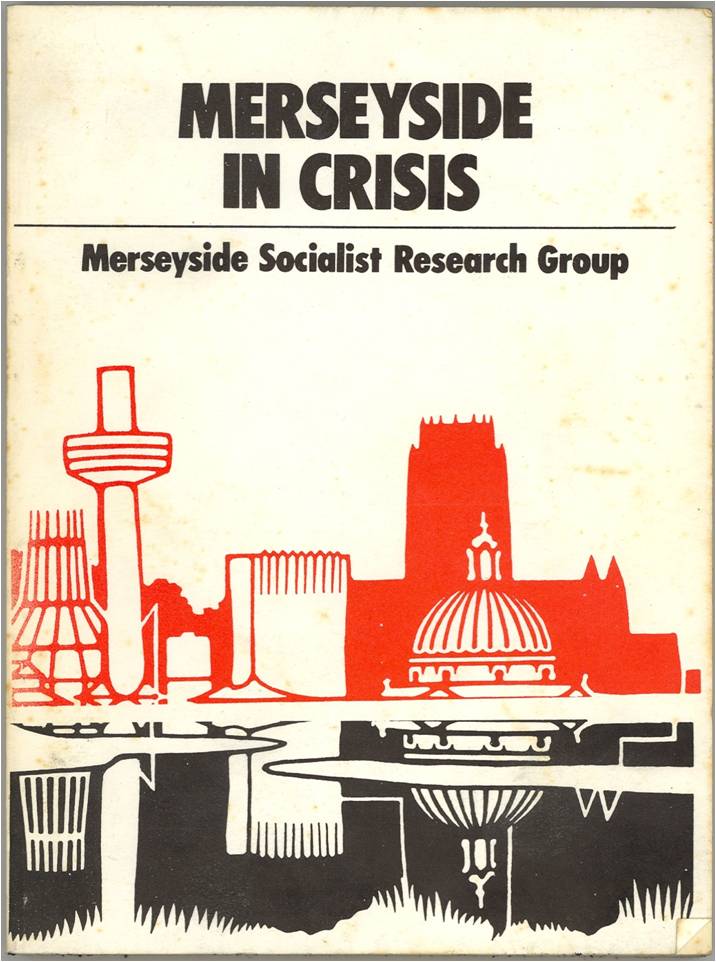
18 months later and our city was decidedly on the ropes and the woman quoted at the beginning of our film declared, “It’s dead now”. She meant Liverpool not Tate & Lyle which simply closed Love Lane refinery down and witnessed its share prices go through the roof! The actual refinery 30 years ago tonight was filmed being bulldozed into oblivion leaving what Albert Tod Sloane had warned in 1971 would be “a dirty big hole in the community”, impossible to fill. Bleasdale may have been subliminally aware of those proxy voices, of the 1570 boys and girls from the whitestuff who had gone down the road on April 22nd 1981, but the physical destruction of the refinery and use as background to yet another manic pub redundancy party in the Green Man, seared itself into the nation’s consciousness more effectively than the national unemployment demonstrations of the time. I wonder whether the character of George Malone was? The character of Yosser “gis a job Hughes” proved to have the longest shelf life but why not George?
The actor that the scouse Dickens used to play George Malone was Peter Kerrigan, a former Liverpool docker who played with pathos and grit the dying docker who ended up on the Blackstuff (tarmac), because of victimisation for his socialist beliefs. George stood for his class and the dignity of labour refusing to give up on those collective hopes and dreams in a remarkable speech delivered as he is being pushed by Chrissie in a wheelchair ride through the then derelict and decaying, now magnificently refurbished, Albert Dock. His superb cameo performance was based partly on Kerrigan’s own experiences* and a crafted Bleasdale script that articulated like a lorry over all those who were responsible for the death of George’s dreams.
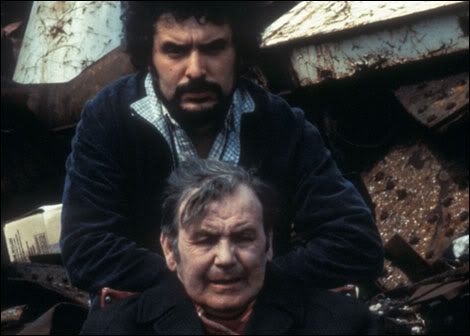
Here’s the script version:
Saturday dinnertime and not a soul about. Once upon a time, Chrissie, once upon a time, Saturday afternoon, we’d have been looking forward to it from the previous Saturday. Payday Saturday, you know. No five-day week and then off to the leisure centre then, boyo.
Oh, there’d be hundreds coming along here. There’d be the ship-repair men, the scalers, the dockers, the Mary Ellens who used to swab and clean the big liners, and right behind us there’d be them great big shire cart horses.
There was many a good old horse went down the hill but he came back up in the knacker’s carts. The vet had put a gun to his head, a straw bolster around its neck and he’d wind it up into the knacker’s cart. As its big head was turning, you could see the whites of its eye.
And yet those horses of privilege, who just pose outside Buckingham Palace and ponce and parade up and down the Mall! They were turned out into a meadow, of cowslip and clover, and guaranteed a full proven bag for the rest of their lives! Ah, Chrissie. It just seems like soddin’ yesterday.
The midday fun ... the women sandstoning the steps the flags. And the little kids playing allalley-oh. And the shops on the corner where you got your three pennyworth of fine Irish, the old snuff and a twist of tobacco. Your old gran had a nice flat top cart there. She used to sell salt fish and a big barrel of ribs straight off the pig’s back from the Irish boats. And then on the third Saturday we’d have the organ grinder and his monkey.
And there we’d be. All piling into Nellie’s or Pegleg Pete’s for a couple of pints of good beer. Maybe the first in the week. And we’d have the craic. Oh, the craic. We’d talk about many things … (Chrissie buts in with “of cabbages and kings!”).. of politics and power. And come the day we’d have inside toilets and proper bathrooms.
Of Attlee, Bevan. Hogan and Logan, the Braddocks and Dixie Dean. Lawton, Liddell. Matthews and Finney. Of “come the revolution” and the Blackpool Illuminations. Joseph Jones had a violin. A Stradivarius, he said!
Well, we’ve got our bathrooms, at considerable expense. And I write letters to prison for the mother of a man who rapes little boys. And there’s hundreds of friggin’ rapists still running free…
47 years ago, I stood here. A young bull. I watched my first ship come in. They say that memories live longer than dreams. But my dreams, those dreams of long ago … they still give me hope, and faith, in my class. I can’t believe that there’s no hope. I can’t…
Neither can I and the Love Lane Lives project, the recorded experiences of the boys and girls from the whitestuff and the rise of the Eldonians in that devastated sugar land community, prove that community and indeed “virtual community” is far more resilient than bricks and mortar that were Bleasdale’s stage props back then.
*Peter Kerrigan wrote a pamphlet, in 1958 entitled “What next for Britain’s port workers?” It’s the apprenticeship of so many Peters and Georges who’d witnessed at first hand the “blight of casualism”. This is what he writes: “Older men on the docks remember the thirties very well. The humiliation of the stands. The ‘muscle feeling’. The scramble for a job. They remember the ‘blue eyes’ system - the whisper of ‘You’re staying behind’ into the ear of a favoured one. The militant was isolated. The man who refused to overload a sling on the last ship was left standing.”
................................................................................................................................................................
Today has witnessed the death of another George’s dreams but whereas Romney’s are hopefully buried Malone’s may have Lazarus like been revived.
One thing that is not so well known about Peter Kerrigan is the fact that he was a great supporter of the refinery workers and wrote this letter in copper plate handwriting style to John Maclean.
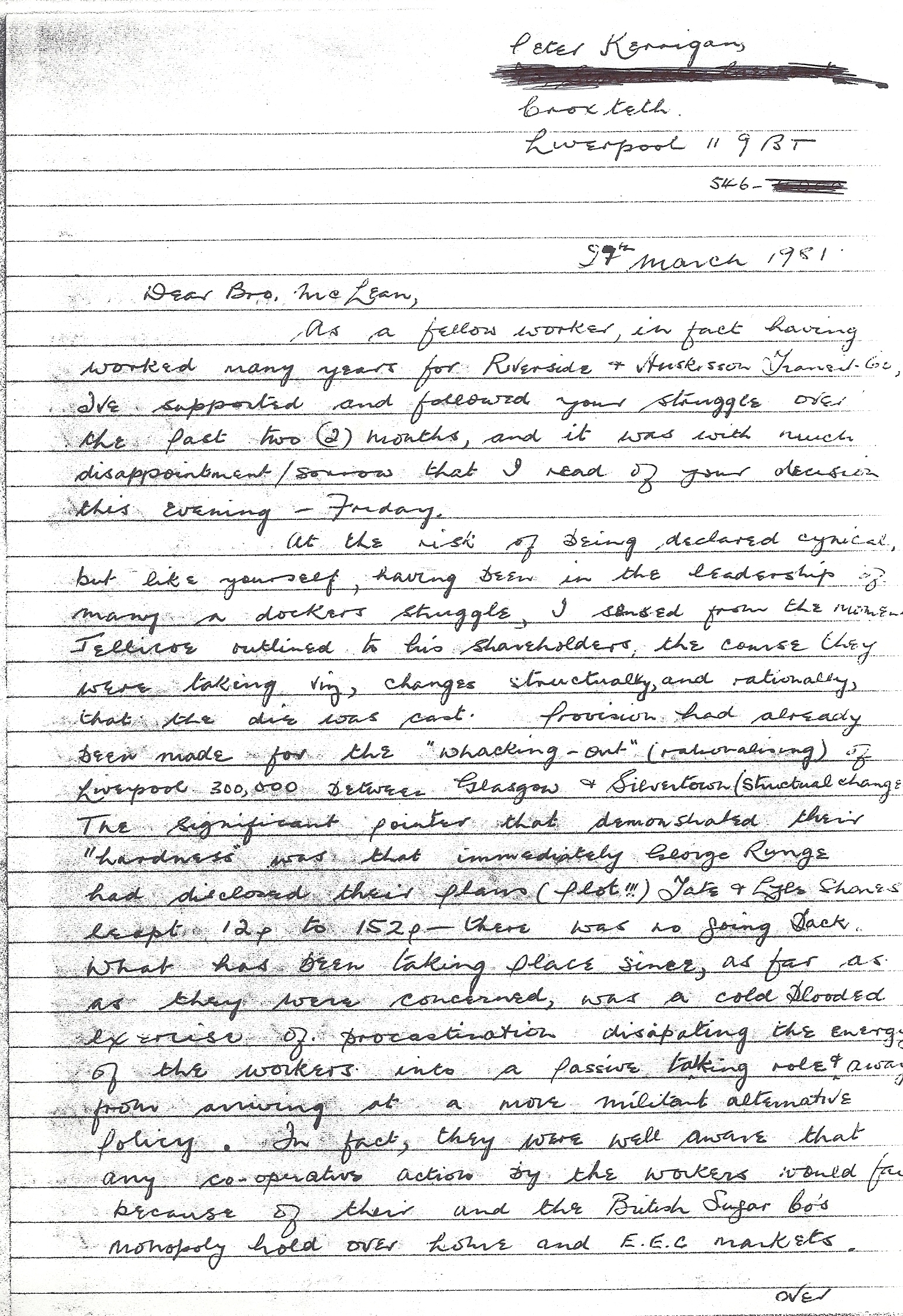
Here’s the full letter in this pdf file.
Peter_Kerrigans_plea_to_John.pdf
A review of Merseyside in Crisis in Tribune. The price was £1 not 95p!
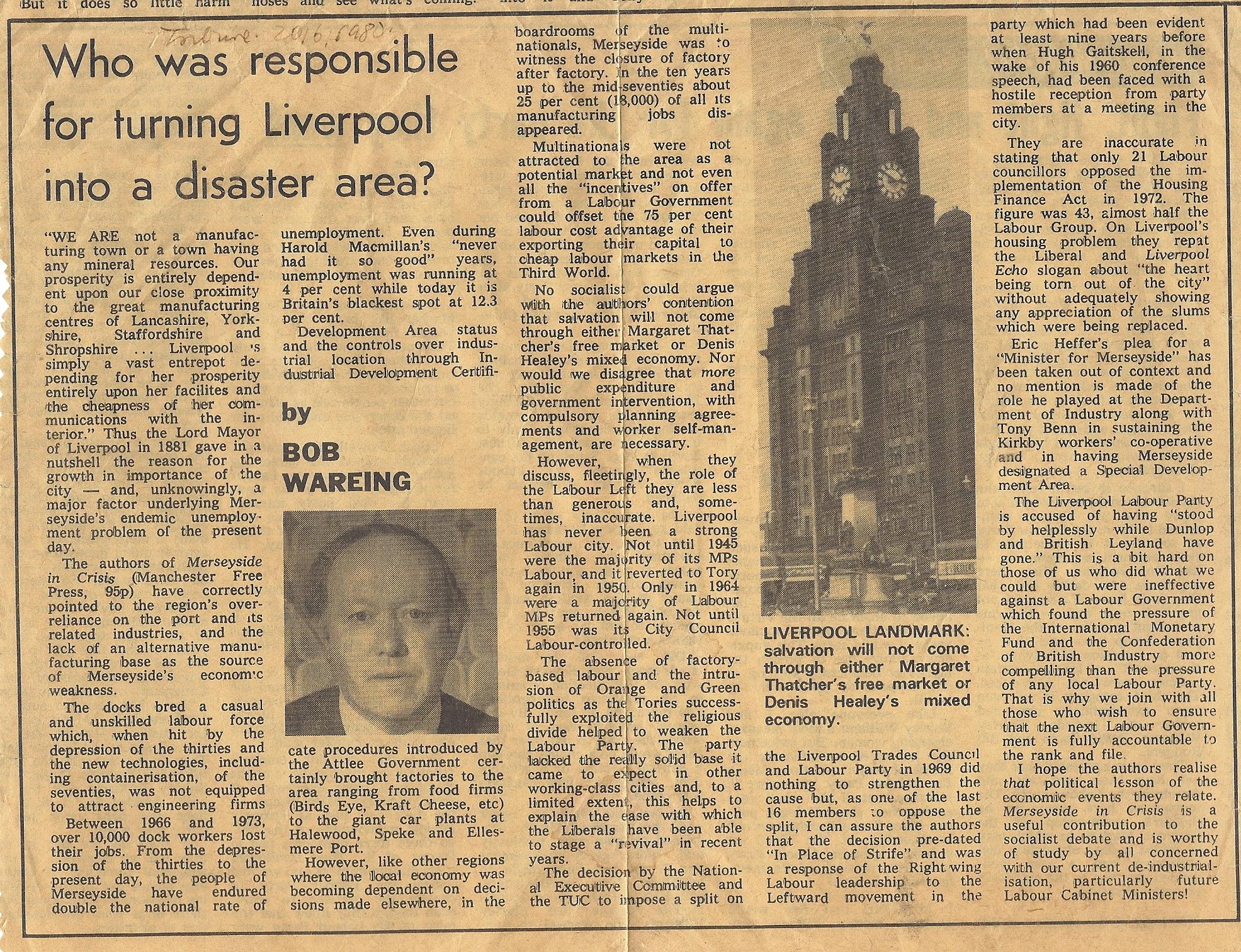
Happy 90th birthday Albert! There’s only one Albert Tod Sloane…
Written by Ron Noon at 17:59 on Monday, November 05th 2012
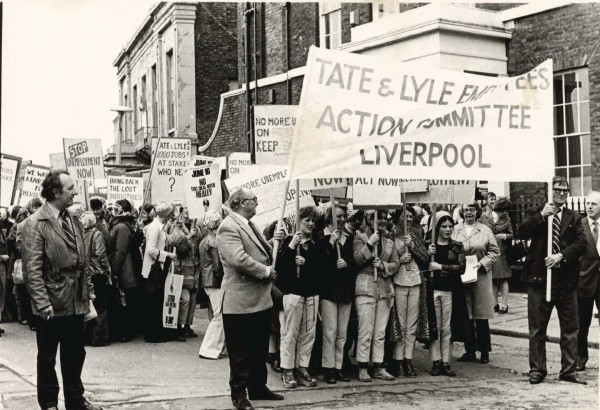
Albert is 90 today! Happy birthday to the Sweet Fighter, seen here on the left of the photograph with his famous leather coat and fag in right hand! John Maclane is on the far right (not his politics) looking up at the banner headline for Tate & Lyle Employees Action Committee.
When I first met Albert I was faced with a formidable guy who was not sure where the four eyed, “Bamber Gascoigne”, university teacher, was coming from. Reassured by my roots and devotion to Everton FC, I quickly gained his confidence and more important than anything else, his lasting friendship. Nobody can fail to be impressed by this sweet fightin’ man. Some of his Anglo-Saxon embroidery of the English language may have to be tailored to particular audiences, but “Tod” Sloane, as he is known, epitomises the free born scouser, the man who is as good as anybody else, and who nobody is better than. Mixed into this remarkable 90 year olds personality are the full range of emotions, the highs and lows and peaks and troughs, the humour, bitterness, anger, defiance and determination of a life long socialist to secure justice for the underdog, but also the sentimental man with a generosity of spirit and feel for those who are less equipped or prepared to stick up for themselves. His scouse humour and irreverence is infectious and easily explains why the machine minder from B shift who registered his first vote for Clem Atlee’s Labour in 1945, became the main focus of leadership and determined opposition to Tate & Lyle’s closure plans.

When interviewed for our film five years ago he summed up the main reason why he would not choose to leave Love Lane. “You became a family. It was n’t like people you did n’t know. I mean I went home many a time and I’d have a lump in me throat and the wife would ask me what was up and I’d say ‘Oh Berno’s havin’ terrible trouble’, nothin’ to do with Tates but we were all like that so we all became a family. That’s what kept me there.” He was a socialist and union man, never a company or firms man but he was respected and admired by local and national management. In the 1970s “sugar wars” between the beet and the cane Albert was involved in all the campaigning and organizing to prevent the closure of Henry Tate’s mother plant, and became Chairman of Tate & Lyle North West Trade Union Committee and a prominent member of the National Port Refineries Committee. Albert met and “engaged” with MPs and all the top decision makers in Government as well as the Company.
The “old” Tate & Lyle with its paternalistic family spirit once insisted on the scions of their families going through the sugar mill and the most prominent Tate family member that Albert mentored was a forebear of Henry Tate. I remember 6 years ago when I made contact with Sir Saxon Tate, the 5th Baronet, how he wrote very affectionately about Albert and some fun times in the Lane. Politically Albert and Saxon were poles apart but that did not inhibit mutual respect and affection from developing. Albert will have taught him a good deal about the actual refinery process but would have had to give up on educating the Baronet into socialist ideals and principles. Albert is quoted as saying to Saxon’s uncle, the company chairman Colin Lyle when the rumours of closure started to circulate in 1971 that “Brutus has got nothing on you lot. You wanna give me a cup of tea and stab me in the back. And why you’ve done that I’ll never know. You should have left us where we were yenno.”
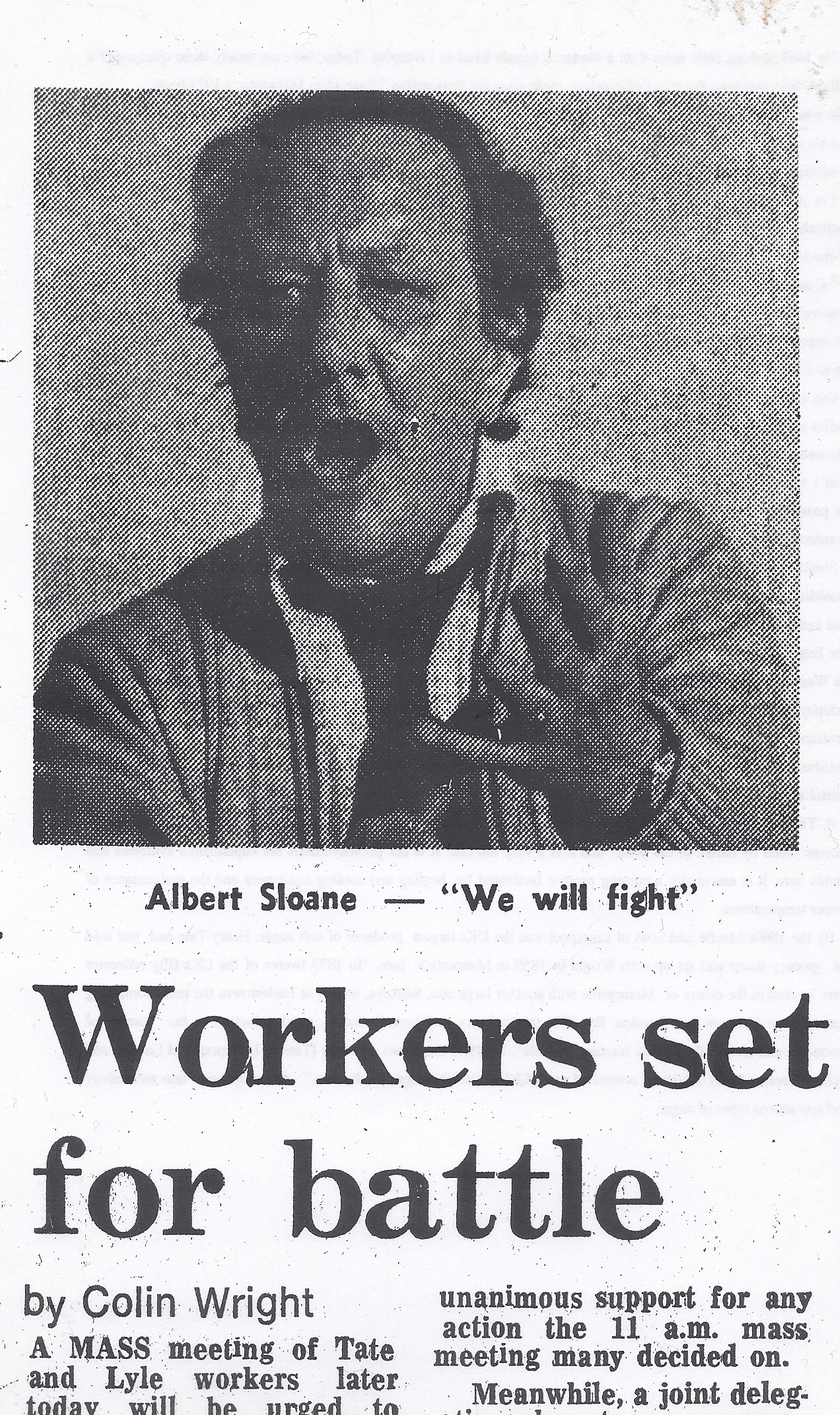
One of many cameo scenes that I’ve documented involving Albert was in the Liverpool Town Hall in February 1981. A meeting of workers representatives, Merseyside MPs, city and county councillors, and local Church leaders, had been called to the “blackamoored and elephanted” Town Hall to help organise resistance to the closure. Hailed subsequently as the “Congress of Merseyside” David Sheppard the Anglican Bishop of Liverpool described the mood of everyone involved in the struggle to keep Love Lane open. “There were moments when Archbishop Warlock and I were invited to go to meetings at the Town Hall and there seemed the greatest solidarity of all Liverpool interests in fighting to stave off this closure. There was a very good common feeling at this time.”
Albert as Chairman of the Action Committee was waiting on that cold February morning in the foyer of the Town Hall to welcome the invited dignitaries “as its dirty big fire blazed away”. One of the lads asked him how he was going to address such people of consequence when they arrived, and Albert’s retort, was “mind yer own business”! He recalls with affection and devilish humour what happened after most of the dignitaries had arrived, except Archbishop Warlock and the Anglican leader Bishop Sheppard.
“Ye see they’re all inside and the ones we’re waitin for is Sheppard and Warlock. I did n’t know what to call them like. But ye see me Ron, I speak from here, (me ‘art!), and ye have to take what ye get as the truth. Anyway he came into the building with a big procession, the monsooer like, yenno the fellah with the big mace, and I shouted, (bellows out laughing), ‘Hello Arch where’s the Bish’?”
The startled “Arch”, looked behind to the revolving doors, and apologetically explained, “oh sorry Albert, The Bish is following on soon”. Witty and irreverent, respectful but never deferential, these were some of the qualities that made Albert a natural rank and file leader. Merseyside despite Bleasdale’s efforts was still in the early 80s as factory after factory was closing down, the place, where “if you don’t laugh, you only cry” was a vernacular cliché. Albert was as fed up with that caricature as Bleasdale, and determined that everyone should see the tracks of the unemployed workers tears.
Albert’s an extraordinary “ordinary” man that will defiantly deny that he was more important in the organised resistance than all the others threatened by the sack and a longer dole queue. In one sense he is right. His story like that of so many other exceptional “ordinary” boys and girls from the whitestuff, that gave Tate & Lyle such loyalty and dedicated service has to be rescued from the “enormous condescension” of those who write British history with the majority of the Brits, and scousers, left out!
HAPPY 90TH BIRTHDAY ALBERT. We all love you so dearly.
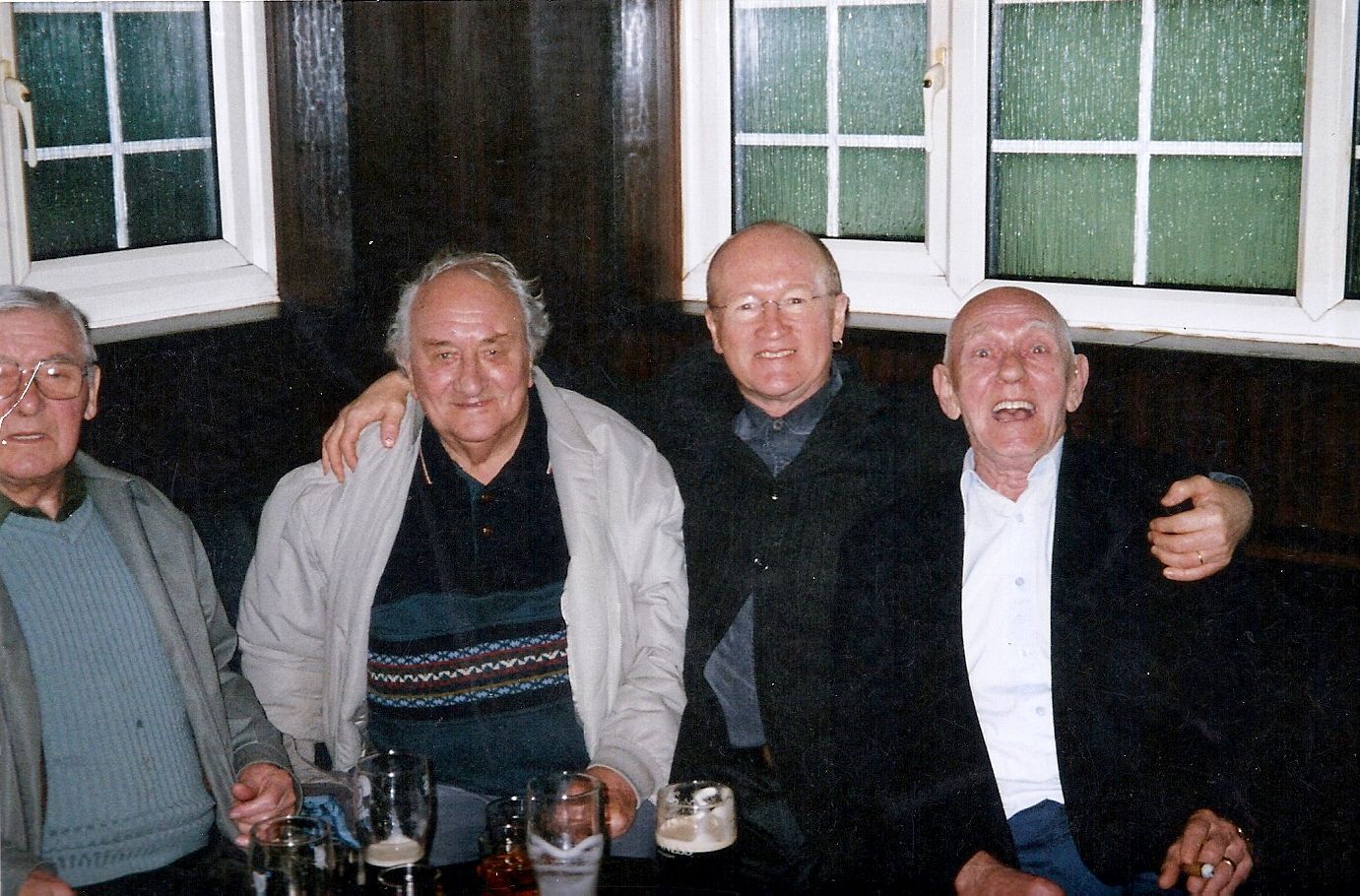
Don Milner, Albert, Bamber, Christy Byrne
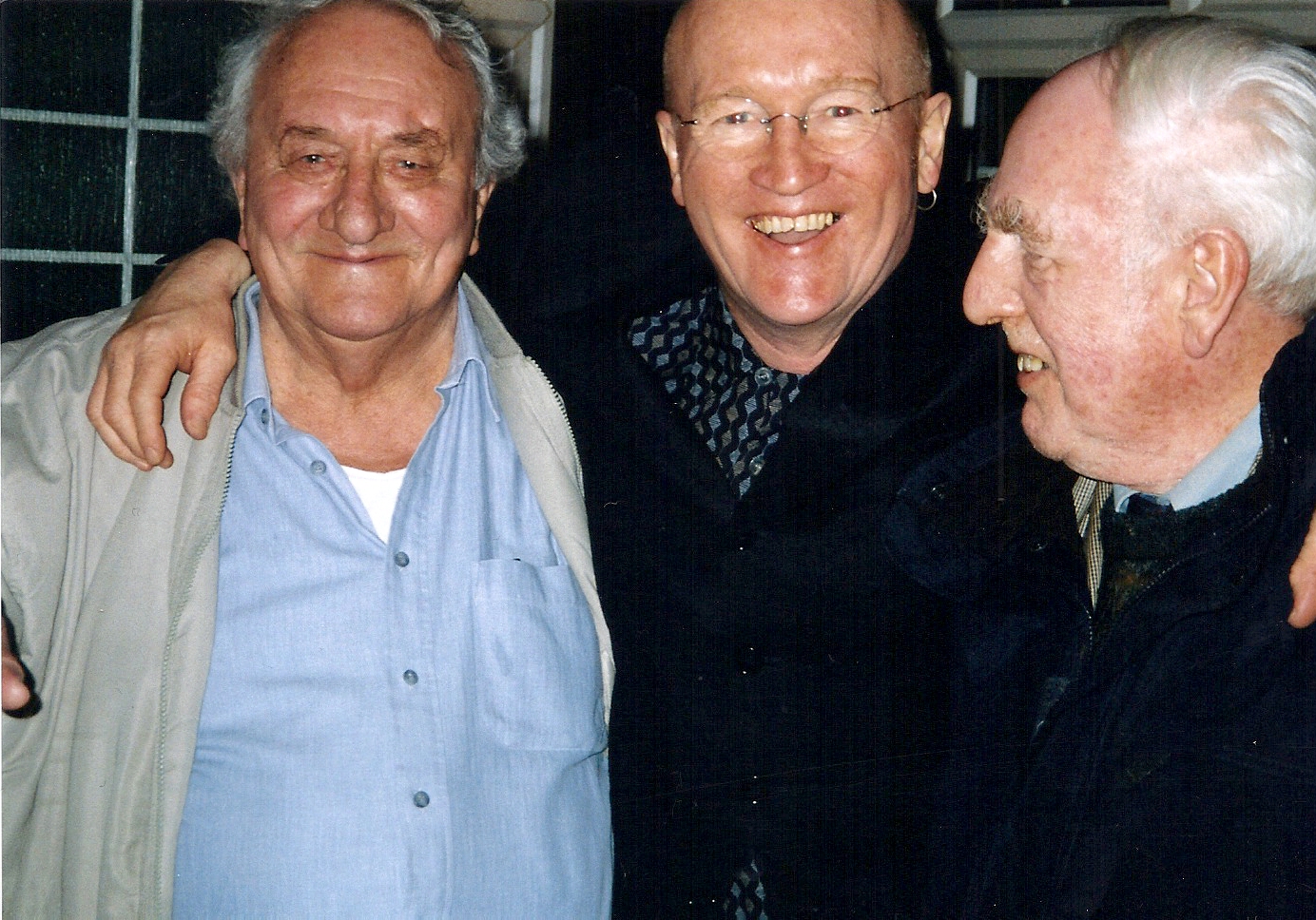
Albert and John and a devoted sugar acolyte in the middle.
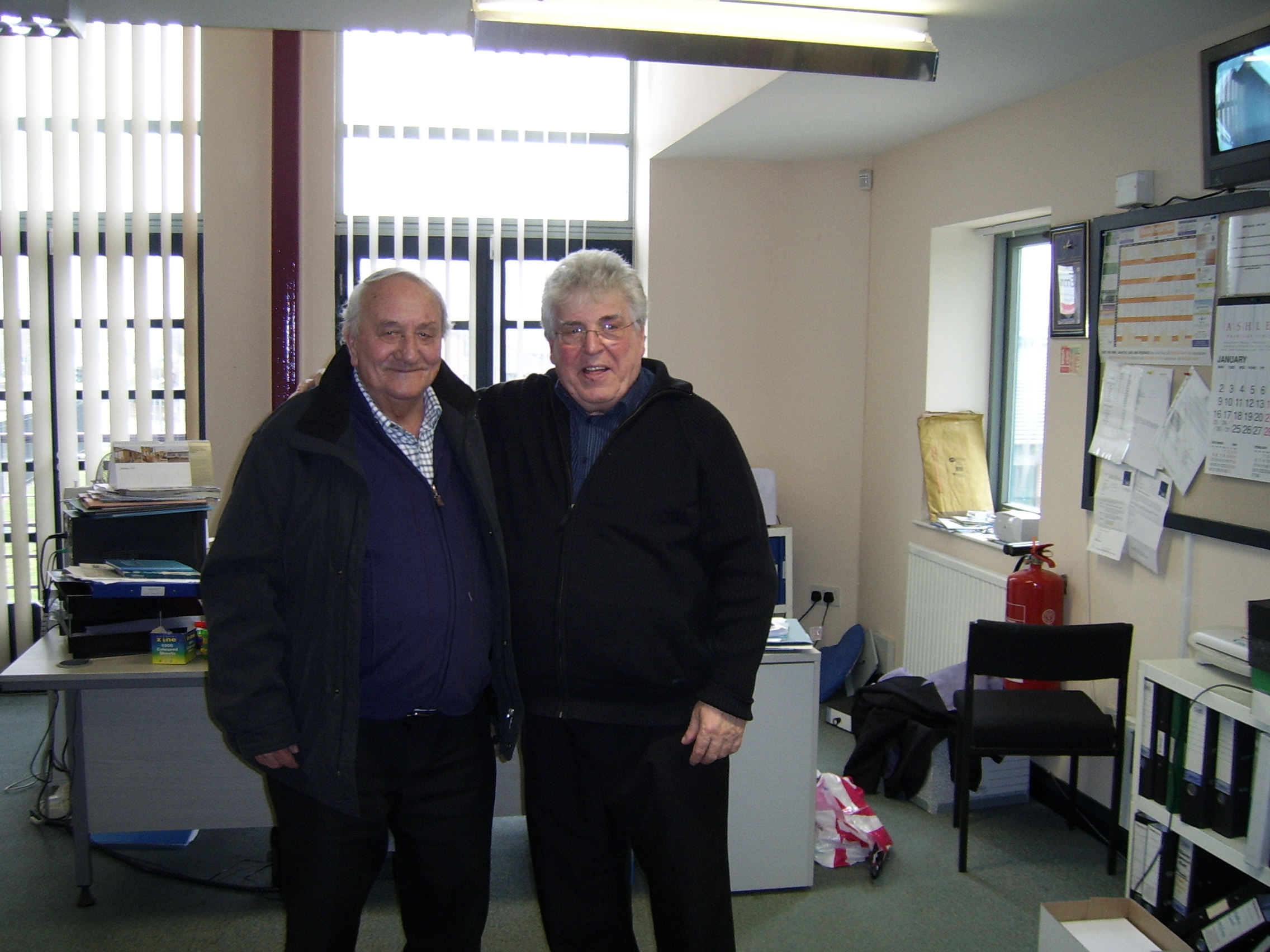
Albert and Tony McGann @ the Eldonians
Albert on the front page of the Echo!
Albert_on_front_page_of_Echo_22_jan_81.pdf
TATES@THE TATE!
Written by Ron Noon at 13:32 on Tuesday, October 30th 2012
“Historian Ron Noon’s decade-long obsession with the Liverpool sugar industry led to the making of the film Love Lane Lives: The Boys and Girls from the White-stuff, which is to be screened tonight at the Tate.” That was Vicky Anderson’s take on my “sugarcentricity” in an essay published in the Liverpool Daily Post on October 30th 2007. Where have those 5 years gone?
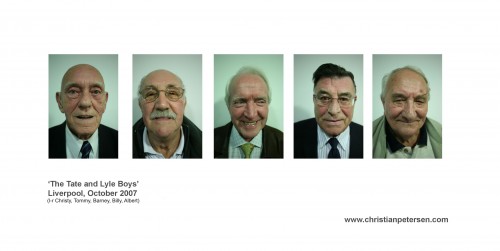
Sadly since this picture was taken there is only my dear friend Albert E Sloane alive. Christy, Tommy, Barney & Billy have all passed away but like the project their lives and influence live on.
......................................................................................................................................................
Below is an LJMU “write up” of the Film’s premiere and launch at Tate Liverpool.
After our website was established I composed a blog on the 2007 launch of our film and much of the material below including the pictures was used then. Hopefully with the alterations and adjustments I’ve made it will have much more resonance tonight on our 5th anniversary! So here we go:
Our film was funded by the Heritage Lottery and it explores how Henry Tate became Britain’s Rockefeller not with oil but white gold! It also documents how after 109 years of refining in the Lane, and the devastation of the Vauxhall community just north of the city centre, the phoenix eventually rose from the ashes in the guise of the Eldonian Housing Cooperative! This model of community-led sustainable urban regeneration received the accolade of a World Habitat Award in 2003. When I mentioned the award to Albert just before introducing him to the main man behind the Eldonian project, Tony McGann, he retorted bitterly that a WORLD UNINHABITED AWARD would have been more fitting in describing the HOLE that Tate & Lyle had left in the Vauxhall Community in 1981 with the closure of Henry Tate’s mother plant.
Our film also captured footage of the historic 25th anniversary re-union of the Tate pensioners at the Eldonian Village in April 2006 and set the scene for our recurring theme of LOVE LANE LIVES LIVE ON. So five years ago today there were three very excited but very anxious sugar project people just hoping that everything would go right on the night! It did just fine.
I’d never thought at the start of the new millennium that I’d be involved in the scripting, “making” and celebrating of a film, about SUGAR! I’d witnessed the junking of the Tates Christmas Party in 1999 and was determined to try to secure another reunion for the boys and girls from the whitestuff but the film project was only really kick started when we did succeed in 2006 in pulling off that great reunion at the Eldonian Village Hall. The success of that and the revived enthusiasm for something more permanent than a final one off reunion led on to the Heritage Lottery bid and the film was very much a bye product of that.
I was an enthusiastic amateur but I had great “professional” help and advice from young film maker Leon Seth and he and Maggy Skilling one of my former students at LJMU were the main movers in the Summer of 2007 behind our success in meeting pressing deadlines. We showed the film at a Big History show in St Georges Hall in September and then fine tuned it for its premiere at the Tate late October. Both turned out to be wonderful events but clearly the publicity we had for the Tate was special.
That cold evening drinks of fermented sugar in solution were quaffed back by everyone it seemed. I was the exception because I had to introduce the film and clearly did not want to be seen as under the influence of the fermented stuff. I just ratcheted up my anxieties and sobriety but throughout I thought this is the Tate and what a supremely ironic venue it is for a film focussed on Henry Tate’s mother plant in the former SUGARLAND just north of the city centre. The setting of a Modern art gallery on the Albert Dock named after Henry the 19th century sugar baron, and well stocked on the night with wine and nibbles and the “craic” of over 100 people was ideal for the launch of our film.
Belatedly I discovered that the only way to relax a little before the “curtain went up” was to go to the back of the building and look out over the historic and world famous River Mersey and see the flickering lights from Birkenhead illuminate the river where the great ships had made passage. I thought about another Henry, a mid 20th century seaman who was my dad and my wonderful mum Julia and what they would have thought if they’d lived to have been “at ar Ronnie’s opening film night”! My dad had lived in Burlington Street in the heart of the Love Lane community and had gone to school at Our Lady’s Eldon Street so there were a couple of circles being completed on OCTOBER 30TH 2007.
Anyway I need not have worried so intensely because as the pictures below show it was a great night and LOVE LANE LIVES LIVE ON.
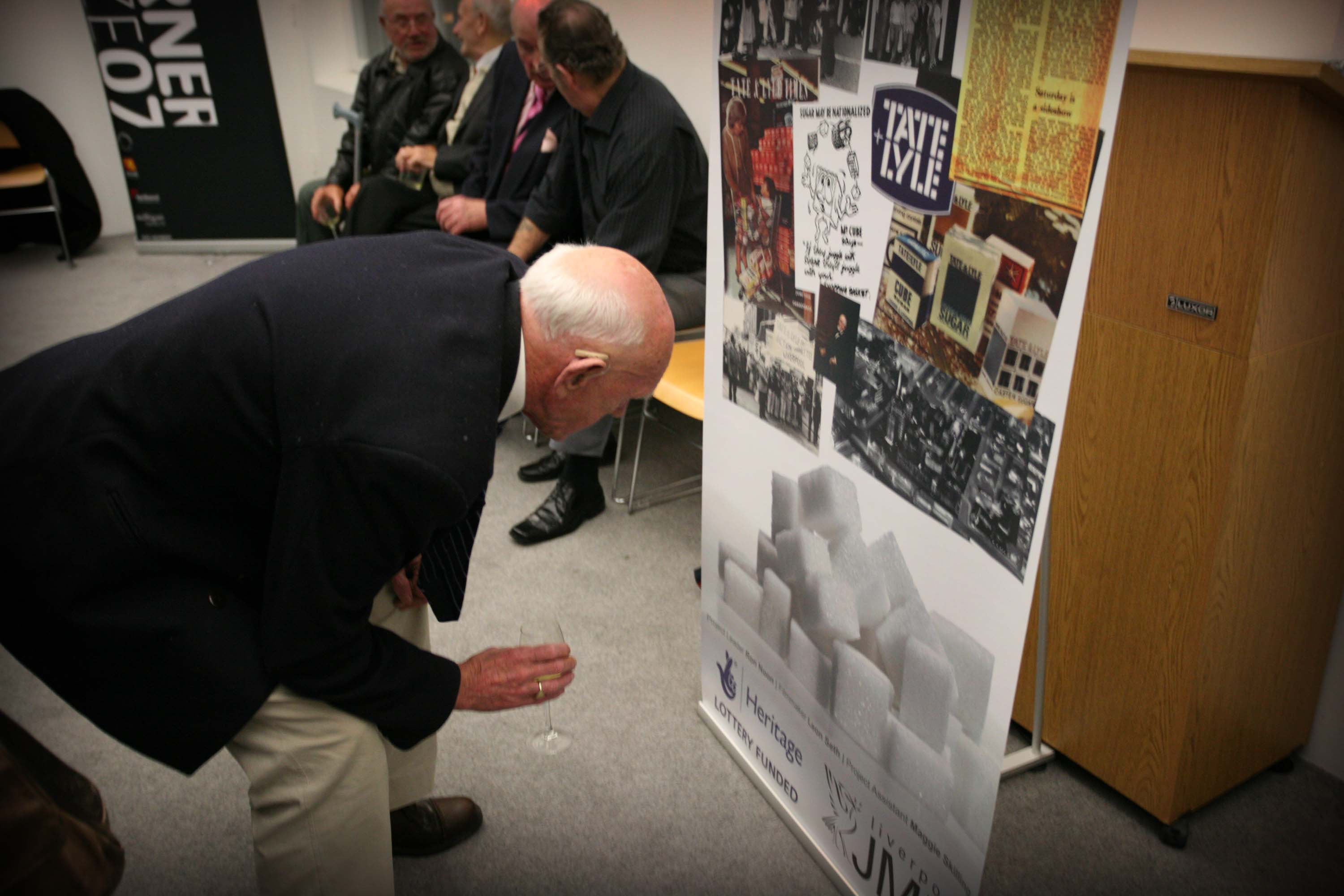
That’s Christy examining our colourful Love Lane Lives Poster
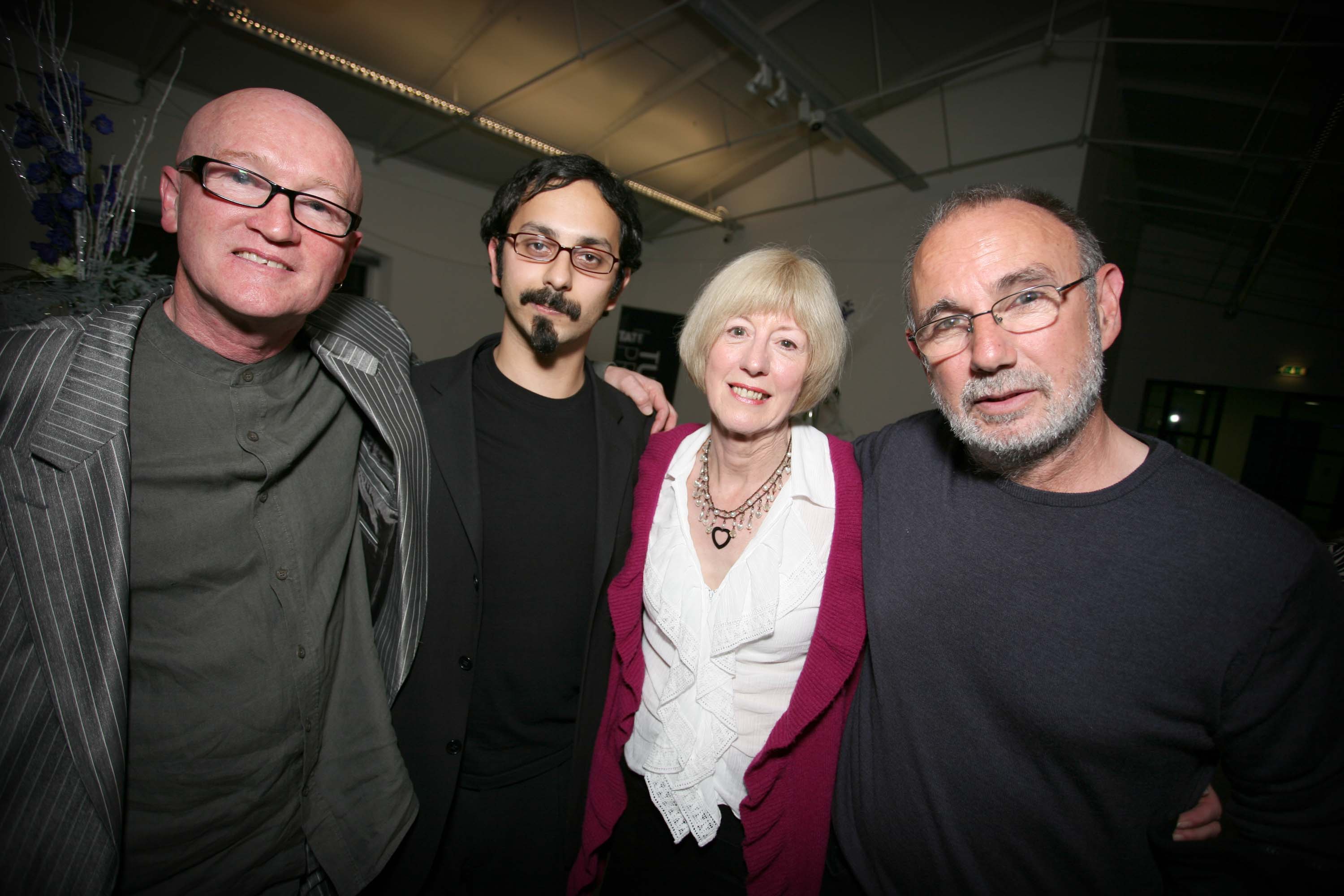
That’s ar sugar gang with Jimmy Mc
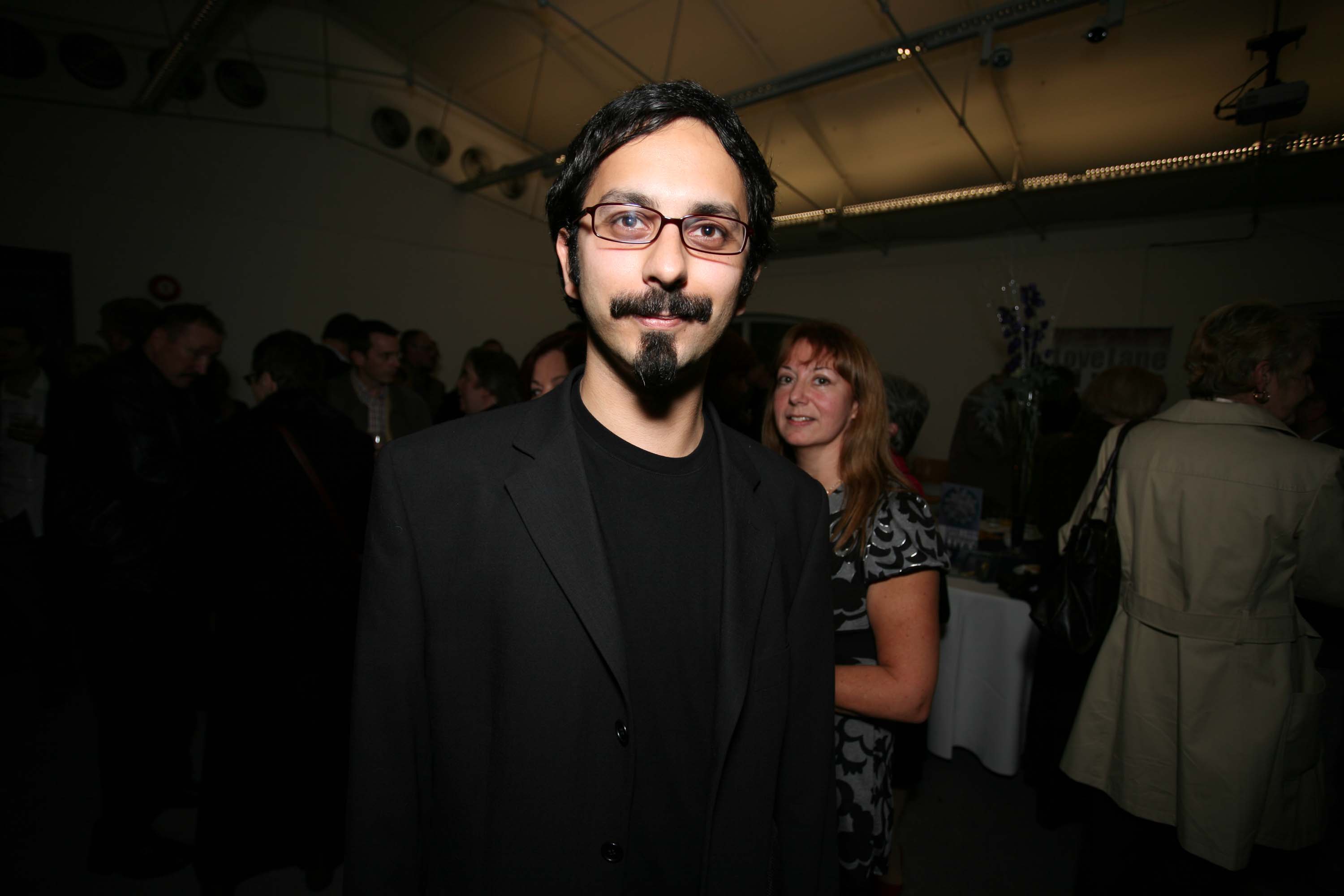
{
Our talented young film director, Leon Seth
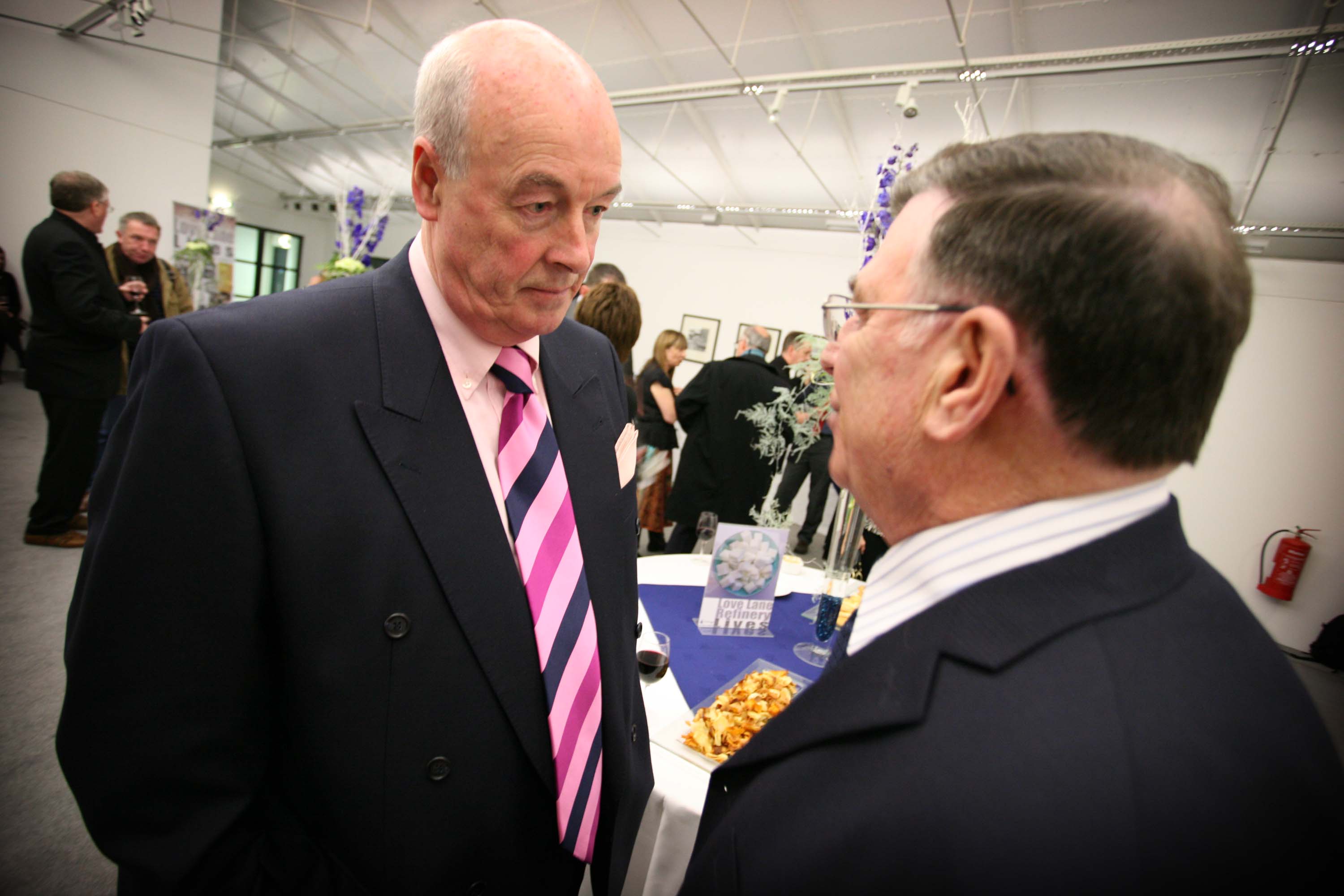
Dave McGowan and Bill
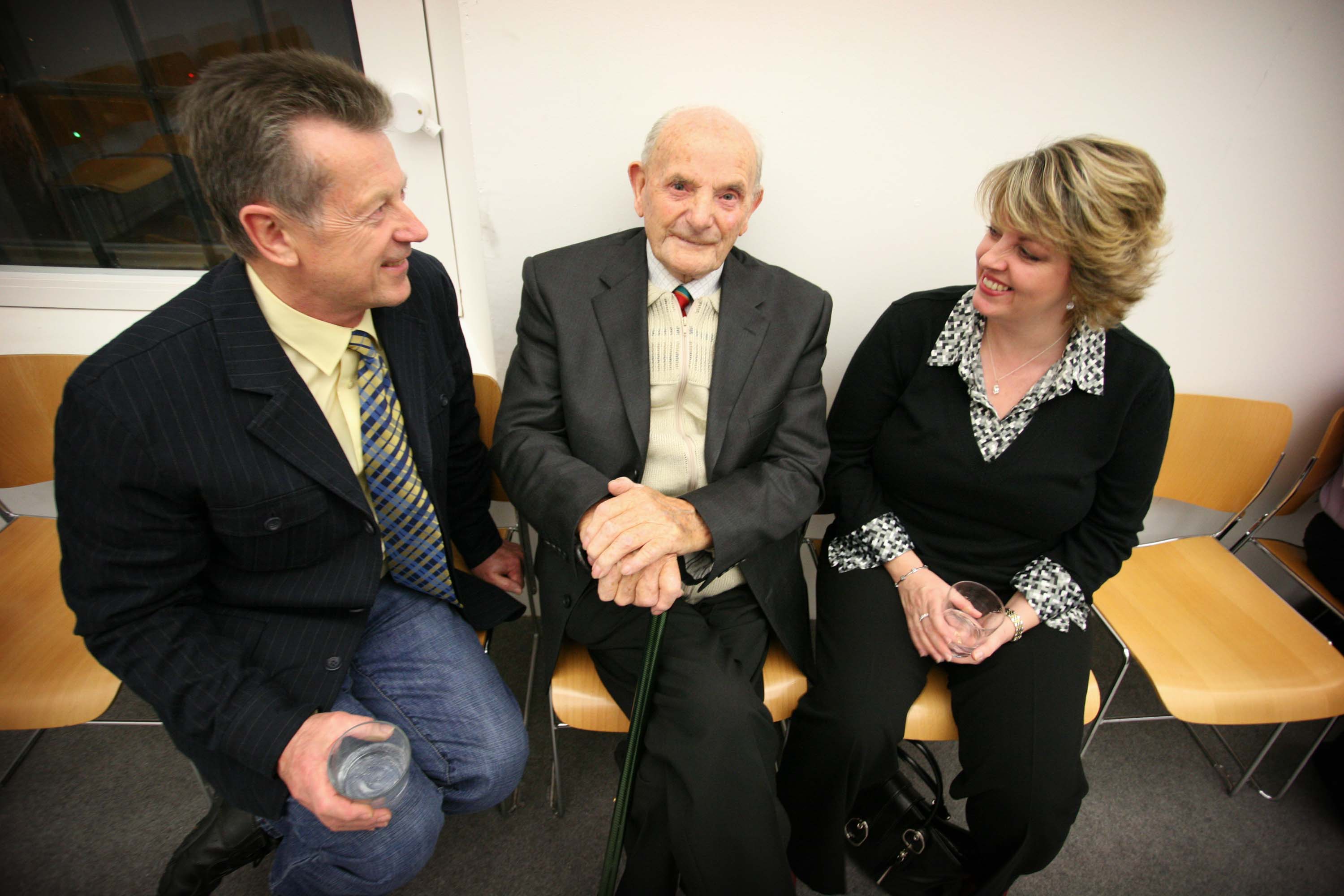
There’s Jim at 97 years young with his son and daughter in law
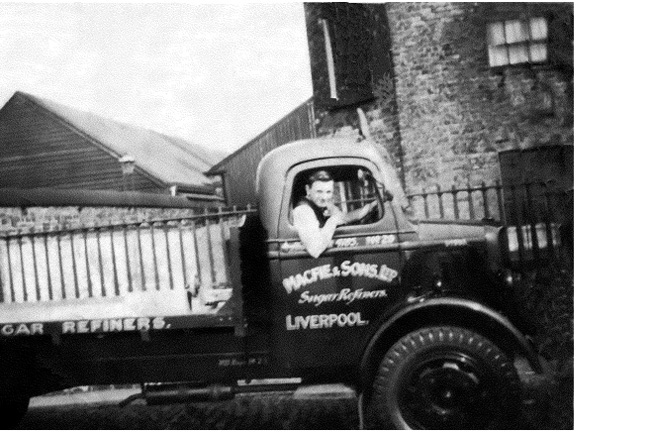
Hey my name is Jim Smith. I’m now102. Can anyone tell me how I will get back to the future? I’ve heard a rumour that my firm MacFies is going to be taken over by Tate & Lyle and that they will be taken over by an American Refining Company sometime in the next millennium!
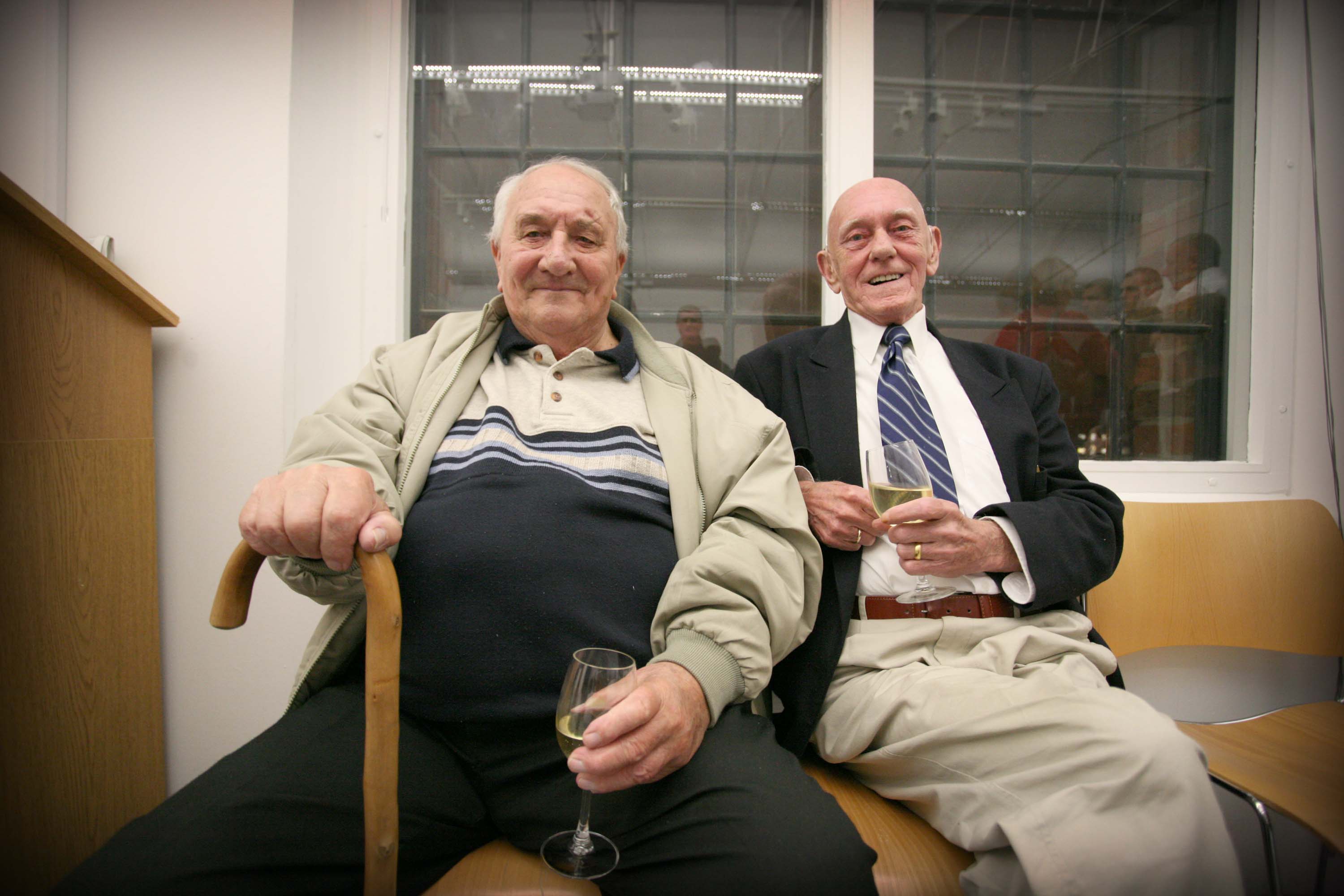
Albert and Christy.
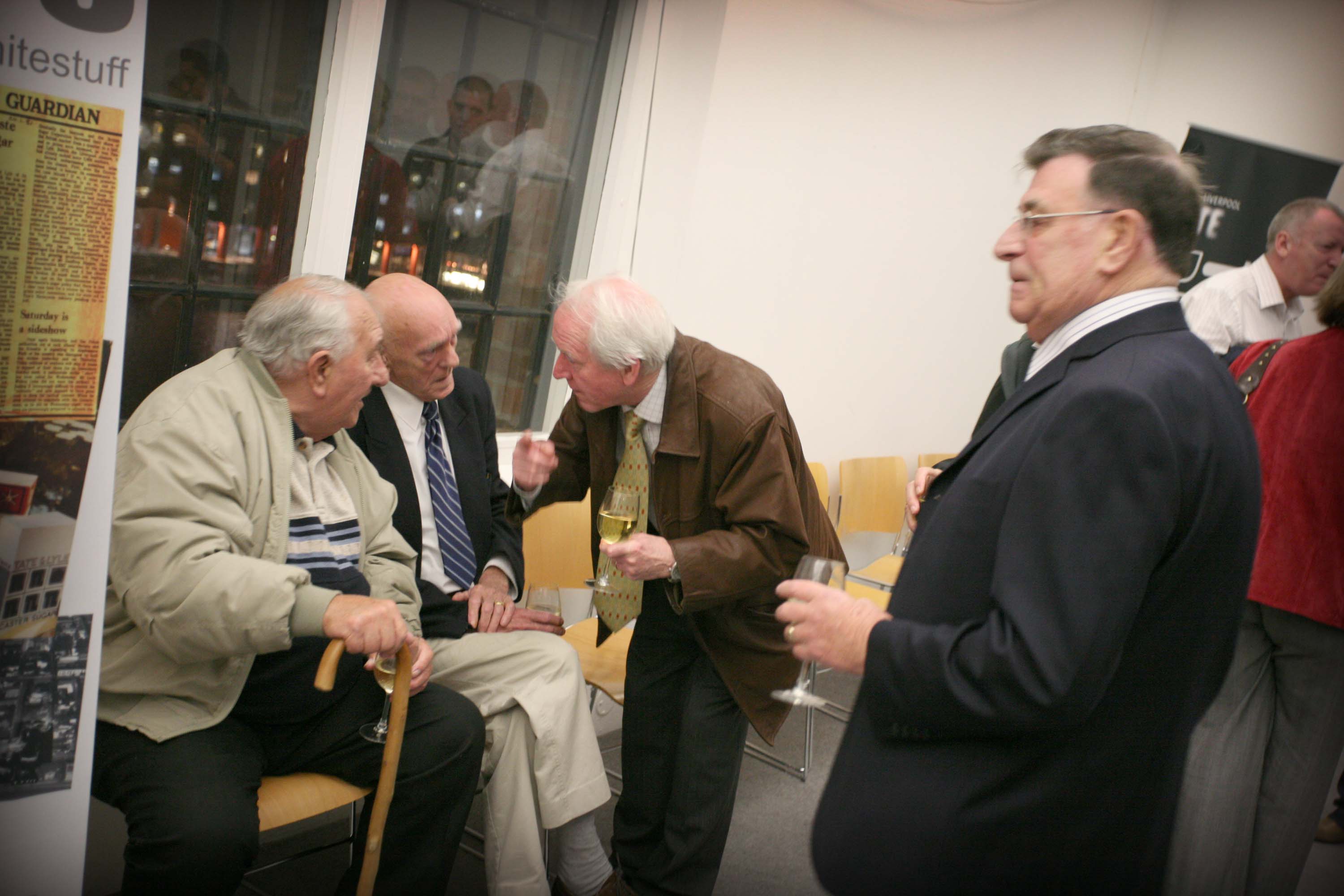
The guys testing the sugar in solution with Bill supervising!
http://www.lovelanelives.com/images/uploads/TateandLylefilmlaunch5.jpg
Amy Trego and smiling on her right is Whiz kid Warren Keith who subsequently set this web site up
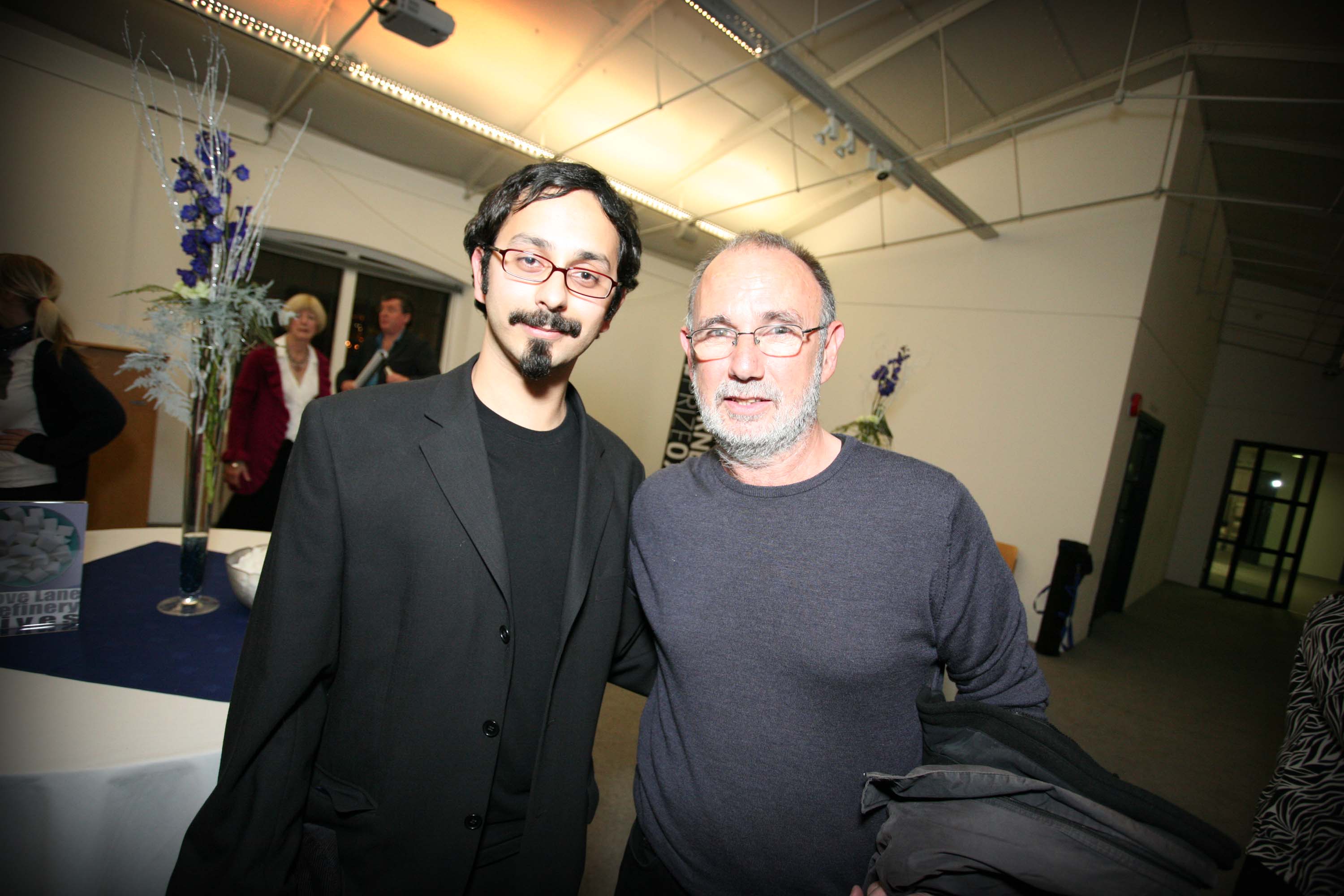
Leon and Jimmy with Maggie and Andy in the background.
..........................
*** What a crackin’ photograph of Jim driving a MacFie’s wagon. Jim started off at McFies with horses and this picture has to be Jim in his early to late 20s because it was not until 1938 that Tate & Lyle bought “the oldest of the British refineries, Macfie and Sons of Liverpool from United Molasses”. Of course not only have Tate & Lyle sold off their sugar business but United Molasses too. Tate & Lyle Sugars is de facto the American Refining Company that is dominated by Florida Crystals Corp which in turn is dominated by Alfy and Pepi Fanjul. I would never have predicted that in 2007 although I knew about the Fanjuls when they acquired Domino Sugar from Tate & Lyle back in 2003. How many people now know about Tate & Lyle Sugars really being a subsidiary of two Cuban American sugar barons?
Postscript:
Eileen O’Brien one of the stars of our film sagely advised that the children in the area needed to know all about this sugar story and about their former Sugarland community to the north of the City Centre. The Eldonian Village which Eileen lives in symbolises re-birth for the community that had been devastated by the closure in 1981, the flight of the phoenix. Tony McGann expressed this with some passion at the very end of our film:
“I don’t think the Tate & Lyle story should ever be forgotten. I think the project that you’re runnin’ now, I think it’s essential before there’s nobody left to tell it. I think it’s very important to the children in school to learn about Tate & Lyle and the story of sugar and obviously keep the name goin’ because again it was very, very important to this area, a fact that should never be forgotten, and obviously involving the children and giving them the full knowledge of what Tate & Lyle was about, I think it’s a wonderful idea. I think it is a wonderful project. But I think it is really essential that it is told before there’s nobody left to tell it.”
We had a wonderful project with Trinity Primary School in 2008 the Capital of Culture Year for Liverpool and below you can see a great picture of some of the children involved.
We also had a wonderful Sugar week at Hillside Secondary School in September 2009.
The death of Saxon Tate & one of the last of the Tates to serve an apprenticeship in Love Lane
Written by Ron Noon at 23:14 on Tuesday, October 02nd 2012
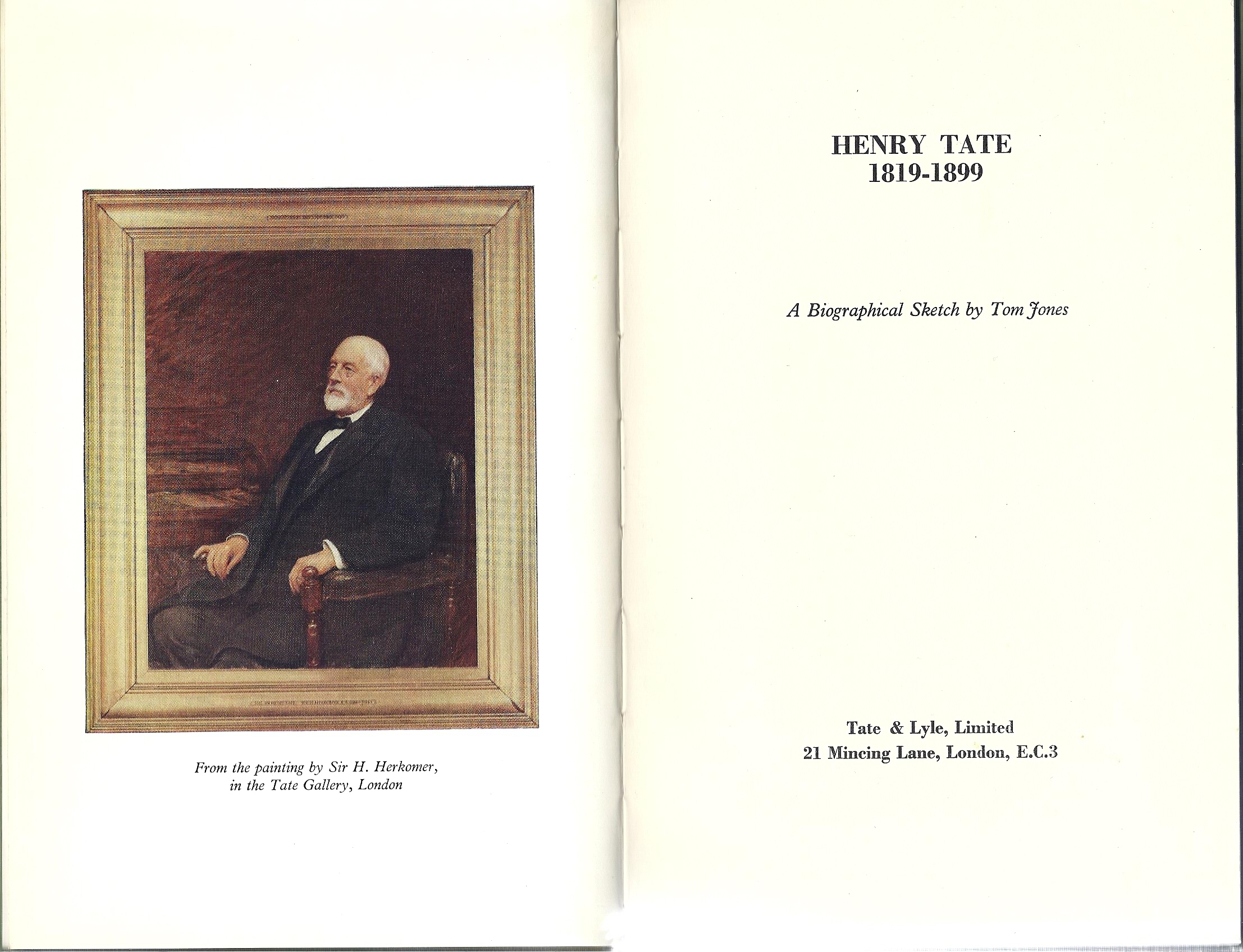
In January 2011 on the 30th anniversary of the issuing of the 90 day redundancy notices I wrote a blog which concluded in this way:
I’ll close my blog on this historic day with a reminder of how the giant sugar transnational was very much unaffected by local sentiments and even what local managers thought. One of the last of the Tates to go through “the Sugar Mill” was Saxon Tate and Albert E Sloane said that he was a really nice man who most people respected and liked when he “served his apprenticeship” in the Lane! (Saxy was an old Etonian as a young man but young men whether they were from Eton or not had to do a stint getting to know the process,and their workers experiences.)
Tate & Lyle’s management style was consistent with a global trend that had been evolving since the mid 1970s and it was in the 70s that Lord Jellicoe took over as the first outside Chairman of the company. (1978) The ideological baggage of tradition and paternalism was rapidly shunted to the sidelines when Saxon Tate and the “family spirit” gave way to an outsider chairman and Neil Shaw as group managing director.
The appointment of Lord Jellicoe in 1978 as Chief Executive, was very much at the expense of Saxon Tate, the “family” man who had been expected to take control when John Lyle stood down as Chairman. Jellicoe was an outsider who had only been on the board for four years whereas Saxon Tate had served a long and profitable apprenticeship with the Canadian subsidiary Redpath Sugars. From 1972 he had “for all intents and purposes” run the Tate & Lyle group. The introduction of modern methods of management and “the first touch of professionalism from within the board” was directly attributed to his regime. Consequently the consolation job of Group Managing Director, albeit under a son of the “victor” of the naval battle of Jutland, seemed scant reward for such endeavours. The fates seemed to be conspiring against Saxon Tate when in June 1980 he was given the honorary post of Vice Chairman. It was a poignant moment when his executive functions were all stripped away. An even crueller irony was to follow, with the appointment of the Canadian, Neil Shaw as Group Managing Director. This was clearly a reminder if one were still needed that a new day had indeed dawned for the sugar multi-national.
The first time Shaw had taken over from Saxon Tate was at Redpath when both their stars were in the ascendant, but the former subaltern now overshadowed not only the old Etonian, Oxbridge educated, former Life Guards officer, but also the “family spirit” as well. Along with Saxon Tate, the ideological baggage of tradition and paternalism was rapidly shunted to the sidelines. The following year Lord Jellicoe, as Chairman of a Board of Directors “on which there was, symbolically, neither a Tate nor a Lyle”, made the announcement that Love Lane was to close. “Thus the history of sugar refining in Liverpool was to come to an end at the beginning of 1981, after over 150 years of ‘good and loyal services’, owing to the ‘treachery’ committed by a firm which had been born there a little over a century earlier.” (That was Phillipe Chalmin’s comment in THE MAKING OF A SUGAR GIANT. Ironically what we have witnessed this year with the sale of Tate & Lyle sugars to the American Refining Company is it’s UNMAKING.)
Increasingly global perspectives meant that there was a corresponding withering away of national or local roots or loyalties. Much of that was evident before Neil Shaw took over as Group Managing Director, but under him the metamorphosis from what Chalmin describes as a “family and moral community” into a financial community was completed. Shaw had first been appointed to the Board in 1975 but by the mid 1980s he would assume an unprecedented position of power as the company’s first ever Chairman and Chief Executive.
The concept of the rootless firm without national identity, searching the world for low wages and union free environments is not without some substance but most multi-nationals are still locked by culture, tradition and staff into one nationality. The British based Tate and Lyle has witnessed a number of organisational shifts which severely compromised its historic “paternalistic” image. The end of sugar cane time in Liverpool and the blighting of an inner city community was the most dramatic consequence of that change, and was distinctly emblematic of the “soulless global corporation” that Henry Tate, the entrepreneur and philanthropist had unintentionally bequeathed to the world.
Here’s the link to the obituary that appeared in today’s Telegraph
http://www.telegraph.co.uk/news/obituaries/finance-obituaries/9523685/Sir-Saxon-Tate-Bt.html
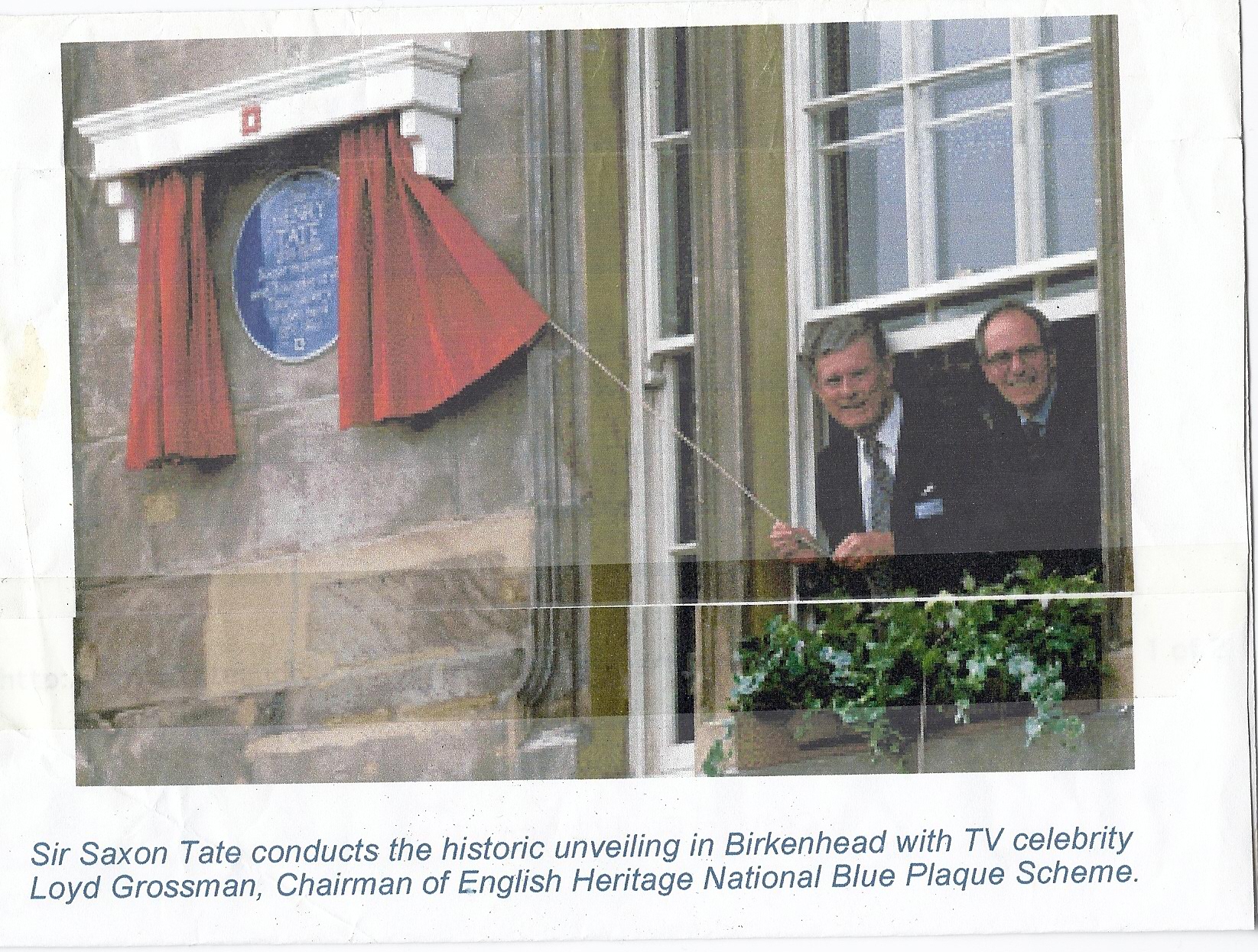
Sir Henry Tate started his business empire. The plaque at 42 Hamilton Street Birkenhead – now home to the Wirral Methodist Housing Association – was unveiled by Sir Henry’s great, great grandson, Sir Saxon Tate. Sir Henry acquired the shop in 1851 and equipped it with mahogany counters, sets of spice drawers and a window through which he could keep an eye on his staff while he wrote up the accounts.
At the ceremony, Sir Saxon said: ‘Sir Henry was a great philanthropist and entrepreneur, as generous as he was ambitious and forward thinking. Famed in his day for patenting sugar cubes, even he could not have foreseen the global success of Tate & Lyle, and the national and international importance of the Tate gallery’”.
TATE & LYLE WORLD NOV/DEC 2001 - headline “Heritage honoured” page 7
Giants and the leaving of Liverpool
Written by Ron Noon at 16:05 on Sunday, April 22nd 2012
The eccentric but brilliantly creative artistic director of French company Royal De Luxe was responsible for transforming our port city, albeit for a weekend, into a land of giants! Sea Odyssey was a three day event which told the story of the little girl Giant searching for her father who had gone missing on the sunken Liverpool registered Titanic 100 years ago. Today as she and her 20 foot tall dog Xolo and 50 foot tall Uncle “stepped onto” a barge at Canning Dock to exit the city’s famous pier head, in front of tens of thousands of people, only a few sugarcentrics would have been introspecting about Tate & Lyle’s leaving and grieving of Liverpool on the same day 31 years earlier!
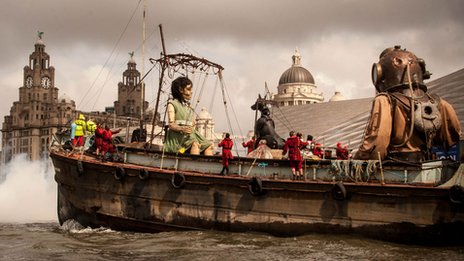
The above is a BBC picture which is used on this link: http://www.bbc.co.uk/news/uk-england-merseyside-17798401
Instead the massive influx of tourists and the indigenous scousers who had their spirits and imaginations raised by this spectacular event would only second the emotions of City Council leader Joe Anderson: “To have the world’s leading street theatre company bring the event to Liverpool is a real coup and another example of how internationally renowned artists want to showcase their work against the fantastic backdrop of our city.”
The backdrop to this blog is not those wonderful giants that evoked “tears of delight” as well as sadness as they exited the mouth of the Mighty Mersey on April 22nd 2012, but the ruthless transnational Sugar Giant that viewed what happened in Liverpool in the rundown to closure on April 22nd 1981 as nothing to do with sentiment or a sense of obligation to “Big ‘Enery’s” mother plant. Jean Luc Courcoult CELEBRATED a brilliantly successful weekend of street theatre to mark the centenary of the Titanic disaster, by jumping into the Mersey! A soulless transnational that has now completely divested from sugar as well as Liverpool is on this anniversary day still responsible, metaphorically at least, for throwing 1500 boys and girls from the whitestuff into the river of unemployment to sink or swim away to shore. Like Jean Luc Courcoult proved today people in this city have had to learn to swim. We are a city of the sea and once again on this historic day thank you Jean right down to your winkle picker shoes for reminding the world what this great city of ours still has to offer.
..................................................................................................................................................................................................................................................
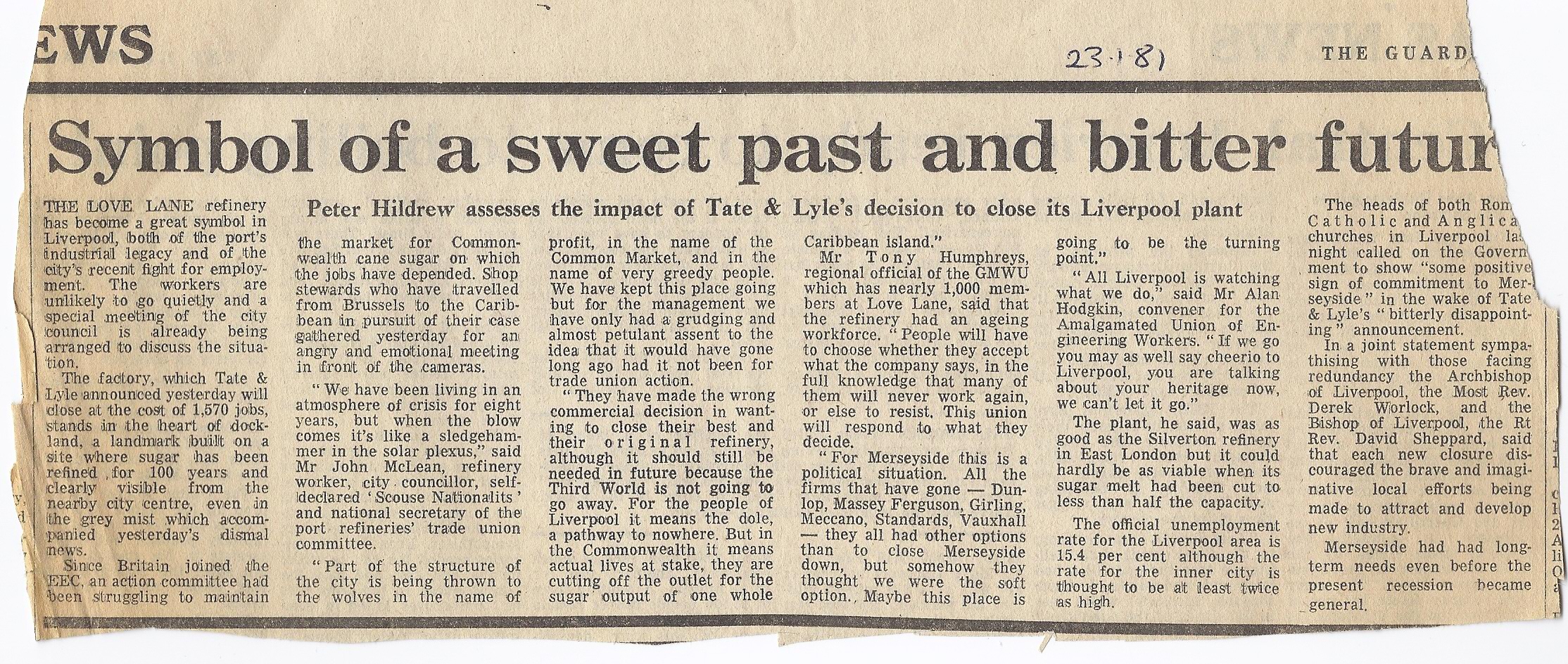
As well as that “on the spot” report by Peter Hildew of the Guardian on the 23rd April 1981, there is a good deal that I have already written about the closure of Love Lane in earlier blogs. The extract below is part of what I wrote for the North West Labour Historians Journal in October 2007:
The real story of sugar and Love Lane refinery is from a nutritional point of view, Sweet FA! It is an “empty calorie” shorn of any other nutrients, but achingly addictive and a perfectly legal drug for billions to be hooked on. We have no biological need for this refined chemical, technically termed sucrose, but despite the fact that it would be millennia before our innate “sweet tooth” and organoleptic senses became acquainted with “sugar”, our ancestors associated sweet with good and bitter with bad! In today’s “naughty but nice” era of processed profits, palatable junk food and globesity, the dissonance between tastiness and nutrition, renders those earlier instincts not only anachronistic but highly dangerous.
That said “there is no single food which has rivalled sugar in its influence on human affairs” and Fernando Ortiz a Cuban anthropologist, viewed it as “Capitalism’s favoured child”. This paper argues that the complementary chronologies of Capitalism and Sugar Cane Time, (sugar beet is a relatively new kid on the sugar block), and the particular case study of Liverpool’s bitter sweet past, provide excellent insights into Capitalism’s recurring themes of want, not need, wealth not health.
Tate Modern or Tate Sugar?
‘Sir Henry was a great philanthropist and entrepreneur, as generous as he was ambitious and forward thinking. Famed in his day for patenting sugar cubes, even he could not have foreseen the global success of Tate & Lyle, and the national and international importance of the Tate gallery’”.
Liverpool no longer imports and refines raw sugar but although no blue plaque commemorates sugar baron Henry Tate’s mother plant, or the city’s long association with this unique and much taken for granted commodity, there is however an absorbing Love Lane Refinery Lives film and oral history project. It has been backed by a Heritage Lottery Fund grant, and the studied ambiguity of the last word in the title is a permanent reminder of our major goal, to ensure that the story of the surviving “boys and girls from the whitestuff” lives on! An archive of film and oral biographies of the former Tate & Lyle workers will be supplemented by a website to facilitate a genuine bottom up version of Liverpool Labour and industrial history, and also to serve as an introduction to and permanent reminder of the politics and power of sugar! Now into its seventh century of global expansion it makes oil a relatively new kid on the politics block and the fact that they now drive “flex-fuel” cars in Brazil with ethanol derived from “energy cane”, portends even more non-food uses for this annually re-generable and far from historic crop.
It was supremely ironic that the closing scene in the last episode of Alan Bleasdale’s magisterially bleak Boys from the Blackstuff, (‘George’s last ride’), shown on BBC, November 7th 1982, was filmed on the day when Love Lane refinery was being bulldozed to the ground. The award winning series with an ensemble cast put together by the Scouse Dickens, highlighted the sheer waste, futility and demoralisation of being without work in Thatcher’s Britain, especially in a city described as the Bermuda Triangle of British Capitalism. “In the 20 years after the height of Liverpool’s post-war ‘golden age’ in 1965, the city and the Merseyside region in general were ravaged by fallout from severe global economic recession. Between 1966 and 1977 no less than 350 factories in Liverpool closed or moved elsewhere, 40,000 jobs were lost and between 1971 and 1985 employment in the city fell by 33 per cent.”
Bleasdale may have been subliminally aware of the proxy voices of the 1,570 boys and girls from the whitestuff who had gone down the road on April 22nd 1981, but the physical destruction of the refinery and use as background to yet another manic pub redundancy party in the Green Man, seared itself into the nation’s consciousness more effectively than the national unemployment demonstrations of the time. How many viewers would have realised that the destruction of the charmingly named site was the physical end of over 300 years of sugar refining in Liverpool? A multinational before the term was shoehorned into the lexicon, “Tates” was nonetheless perceived as “local” and paternalistic, and with no evidence of serious industrial relations hiccups since 1926, the closure reminded those who viewed it as “a city within a city” how “all that’s solid eventually melts into air”?
In the eighteenth century ships sailing in and out of the Mersey contained the classic products of an infamous triangular trade but how many Liverpool ladies perambulating along the romantically named “Love Lane, Ladies’ Walk and Maidens’ Green”, overlooking captivating views of river traffic and Welsh mountains, asked about the conditions under which those goods were produced? Sixty five years after the abolition of the slave trade a former grocer, born in Chorley, Lancashire, lay the foundations for an imperial sugar dynasty, by building a refinery in a Love Lane, far removed from rural arcadia, and intersected by the Leeds Liverpool canal and adjacent warehouses. When 109 years later the then tragically misnamed refinery, closed down, it served as a potent reminder of Liverpool’s twentieth century economic malaise and rundown from Gateway to Empire status, as well as an amazingly dramatic stage prop for Bleasdale’s zeitgiest character, Yosser (‘gis a job’) Hughes.
According to J.A.Watson, “its end was a bitter blow not only for those who worked or had worked there, but to the whole of Liverpool where the name of Tate & Lyle was held in the highest esteem. Tate & Lyle was Liverpool. ‘It’s dead now’ was a typical opinion, expressed in this instance by a woman casually met in the course of gathering material for this book. She meant Liverpool was dead, not Tate & Lyle”. Fortunately, judging by next year’s European Capital of Culture award, her reading of the tea leaves proved premature but dead right about the sugar, given that the FTSE 100 Sugar Giant, shorn of its original ethnicity, has never looked back on that act of matricide and the grieving of Liverpool. Indeed when the critical decision was taken to close Love Lane, the board of directors contained neither a Tate nor a Lyle and was headed by Lord Jellicoe, the first chairman from outside the families.
Unlike Watson’s professedly “neutral opinion” that “closure could not have been prevented by the company acting on its own” another company historian Phillipe Chalmin admits that the closure and disappearance of a prominent Liverpool landmark, owed to “the ‘treachery’ committed by a firm which had been born there little over a century earlier”. As a socialist and Labour historian what drew me to this project were the refinery workers not the product and certainly not Tate & Lyle. That said Albert E Sloane and John Mclean, my two sweet fightin’ mentors on the ten year struggle to keep the plant open, sagely advised “if you get to understand sugar you will understand capitalism”. The only thing that mattered to me about sugar before this project, was that it was sweet, but I soon discovered “what a bitter taste sugar takes on” when that global and local history is reconstructed.
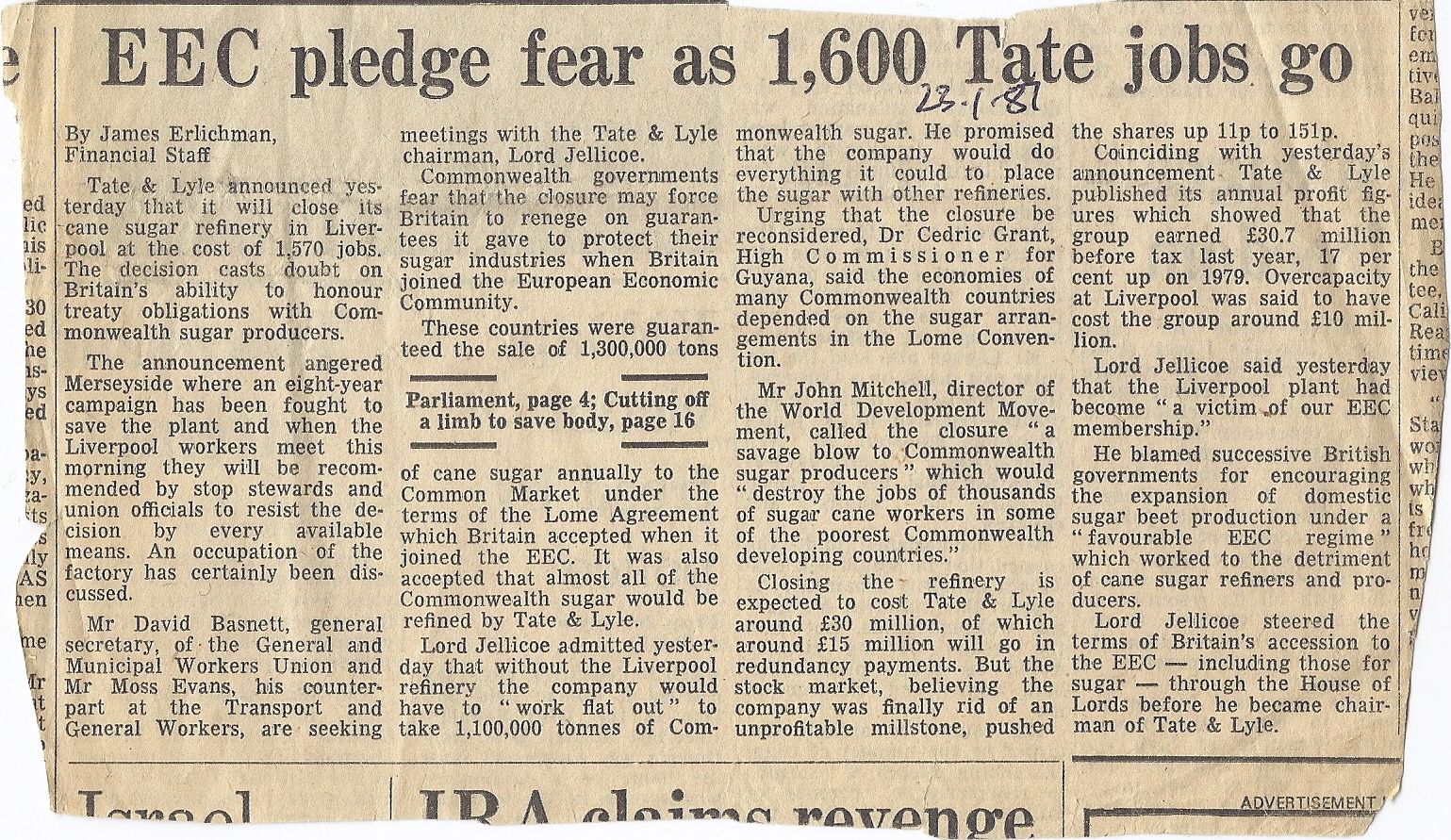
P.S. Check this link out on our site. This is how we bring in musical talent to encourage children to imaginatively reconstruct how “their community” was impacted on in 1981 by the closure of Love Lane.You can now listen to Ian Prowse’s efforts with the children of Hillside school who devised a SAVE OUR SUGAR protest song, albeit now 31 years out of date. Or is it?
http://www.lovelanelives.com/index.php/blog/entry/save_our_sugar/
What’s my former History student doing now? Well I was there last night when he played a gig in Liverpool to celebrate this:
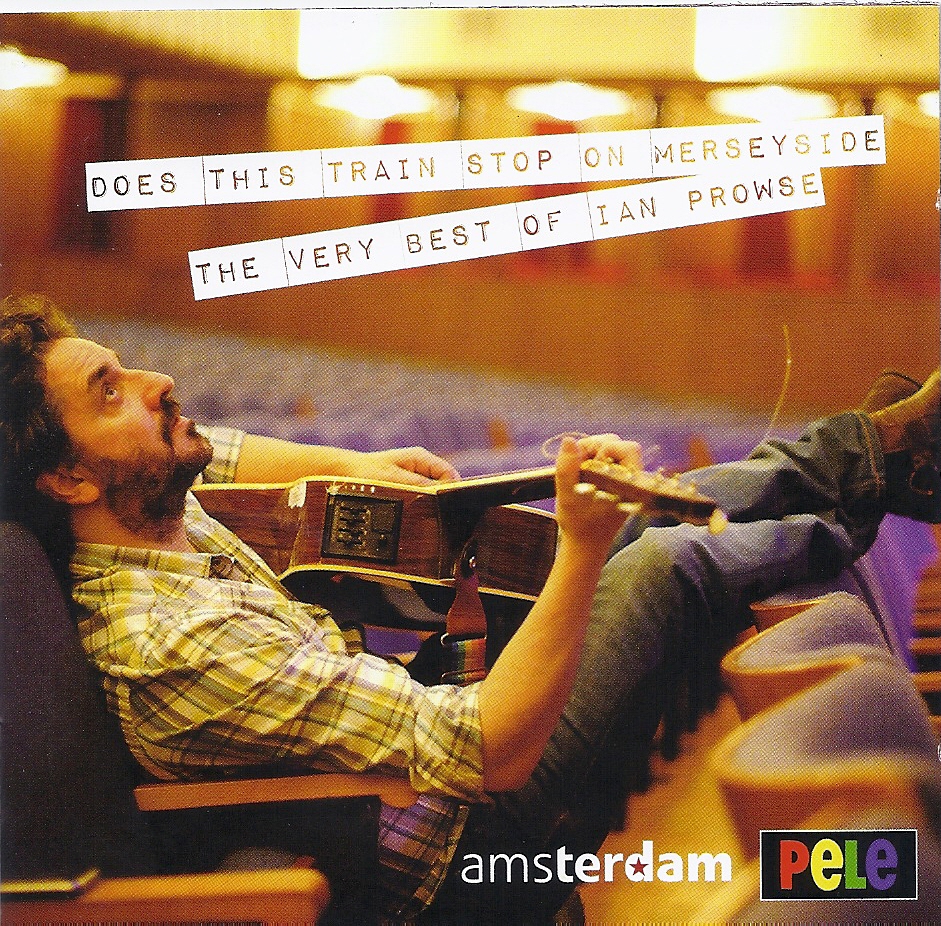
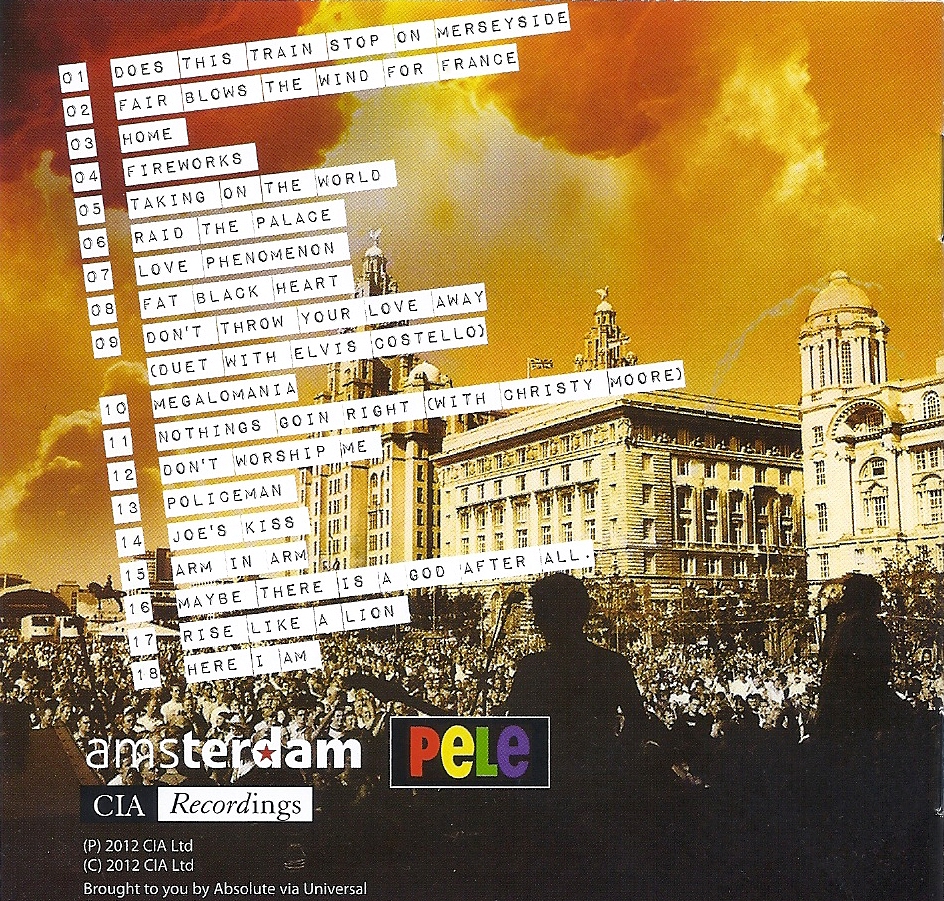
East End London Sugar Girls and North End Liverpool Sugar Girls!
Written by Ron Noon at 03:08 on Monday, March 19th 2012
That’s the back cover for the book by Duncan Barrett and Nuala Calvi to be published on the 29th of this month. It is a stimulating read and one that made me keenly aware of the “unwitting gender imbalance” on our site and the need to do something similar for our Liverpool Love Lane Lives project. Duncan and Nuala not only sent me an advance copy of their book but have been in correspondence about the possibility of coming up to Liverpool when their book has been published, and helping us to kick start a similar project about the blue turbaned ladies of our beloved Love Lane. Already on their website they have flagged up our project and said some very kind words about our film so clearly there is great scope for a mutually beneficial (some say the big long word is synergistic!) study of East End London sugar girls and Liverpool North end sugar girls.
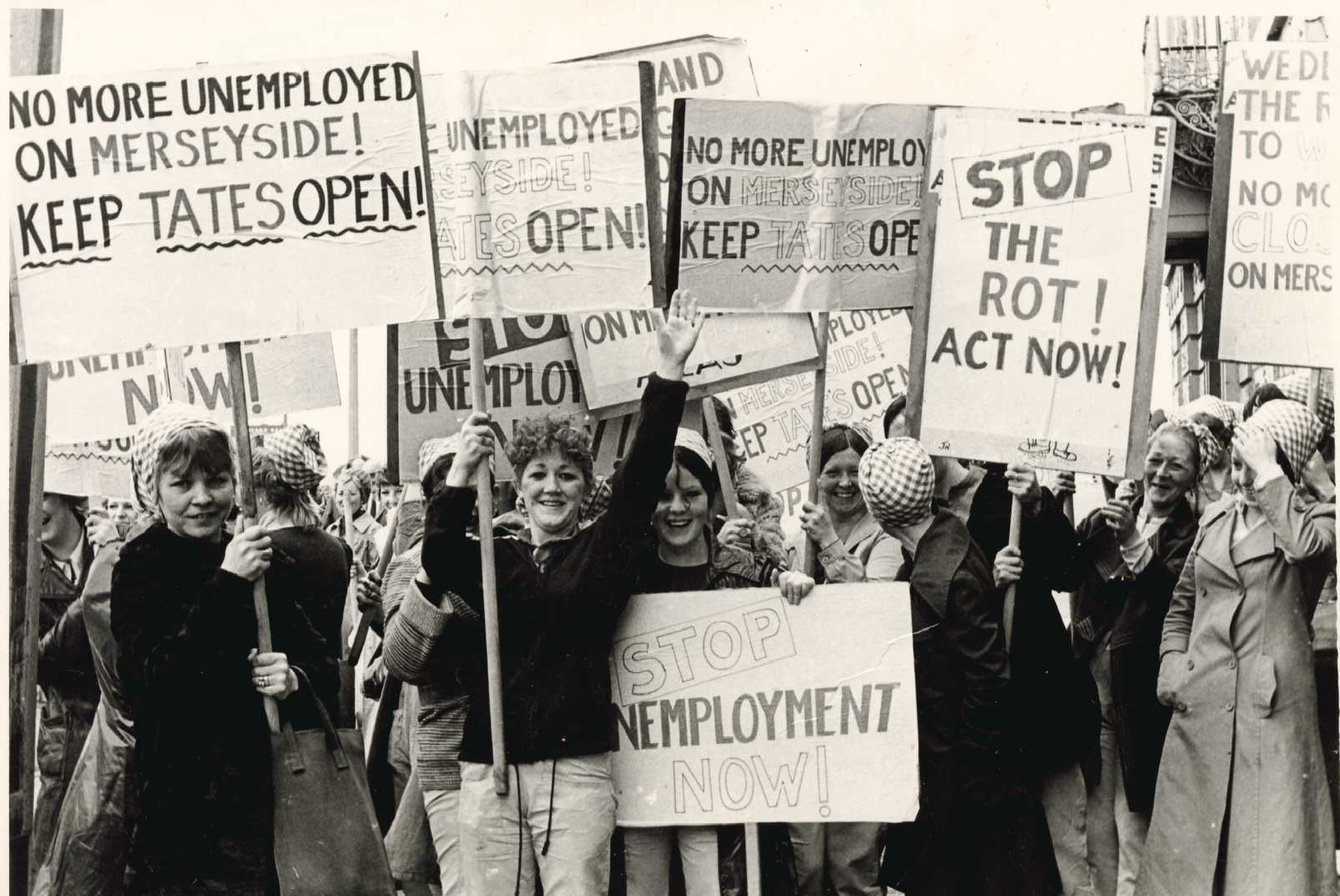
I’ll be filling you in with much more detail after I’ve met the authors and set in motion some of the stories of Liverpool’s beautiful ladies from the Lane. Write in and let me know whether you would like to be interviewed. In the early days of my project the links with some wonderful women from the Lane were unfortunately scuppered by a project worker whose mind was clearly on other things than sugar research and prioritising those links, but with the help of Leon Seth and Maggie Skilling we re-energised the project and launched the film and website. The gaps are now crying out to be filled in. Come on the Sugar Girls of Liverpool.
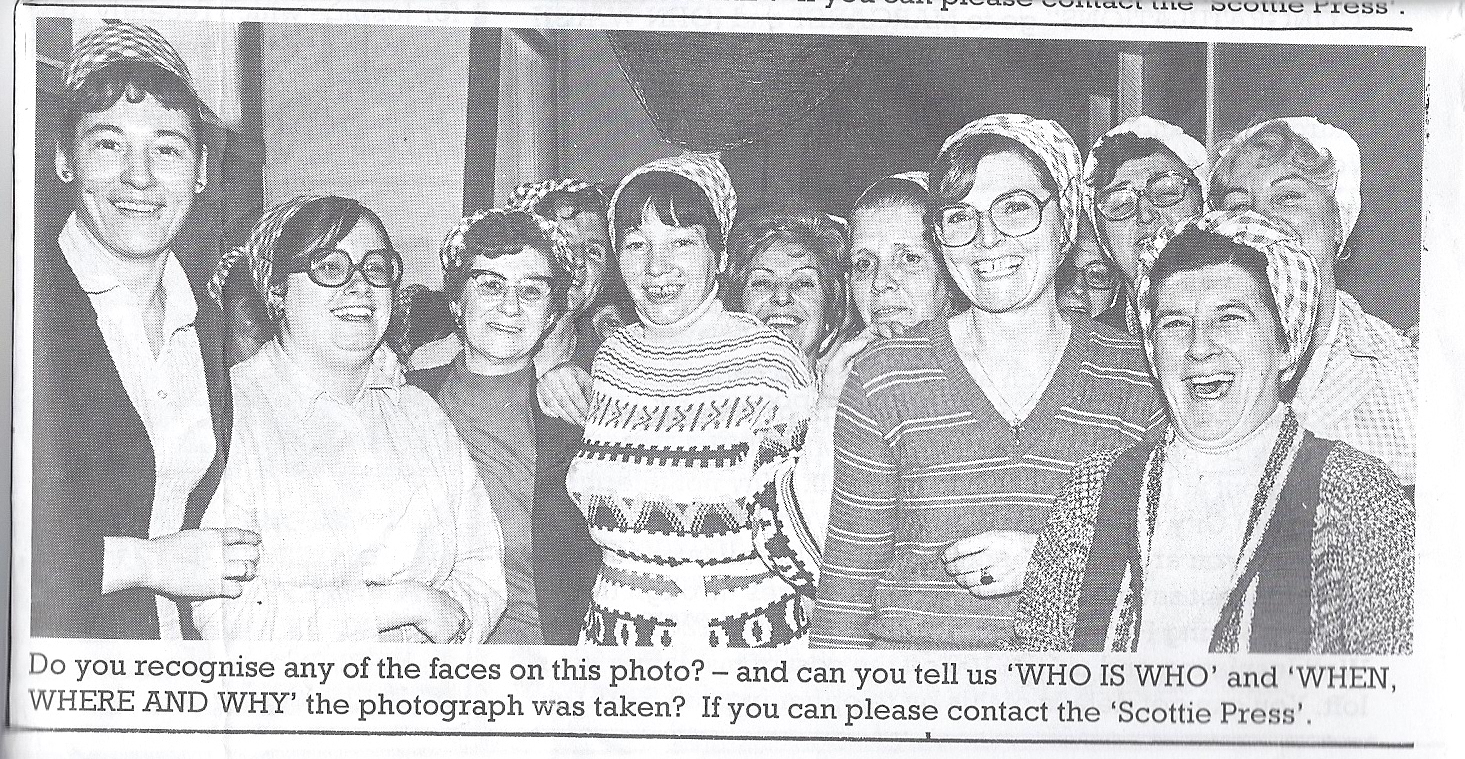
Let’s find these sugar girls from Liverpool!
Barny Murray and friends in the New Holt pub just before Christmas 2011
Written by Ron Noon at 16:10 on Saturday, January 07th 2012
These latest bereavements made me think back to the big re-union party we had back in April 2006. We had to “fight” to get Tate & Lyle to back it but we “won” and what a night and what great publicity for the boys and girls from the whitesfuff?
In Paddy Shennan’s April 2006 feature article on “the party being held to mark the 25th anniversary of the closure of Liverpool’s much-missed Tate & Lyle factory”, there were some wonderful cameo comments from our now absent friends, Paddy Brannigan and Tommy Owens. The 90 day Redundancy Party letter that I had sent to Sugar Quay in the January “had the desired effect” and Rowan D J Adams, Tate’s director of corporate communications and deputy company secretary, appraised me that “after considering your proposal, I am delighted to inform you that we are prepared to make a significant contribution” towards the cost of the re-union.
“I hope you have a very enjoyable reunion and party’ and unquestionably on that lovely sunny April Friday evening the payback from that Love Lane camaraderie was enormous. The Eldonian Village Hall resonated and rocked to the sugar beat and Paddy and Tommy, part of my expensively arranged security/bouncer team, did a great job keeping out would be gate crashers! (The clamour for tickets from the old boys and girls from the whitestuff was incredible and we could only allocate 200!). Paddy Shennan from the Liverpool Echo is not only a great Evertonian but a very talented journalist and his vivid feature highlighted much that was special regarding the former Love Lane refinery workers.
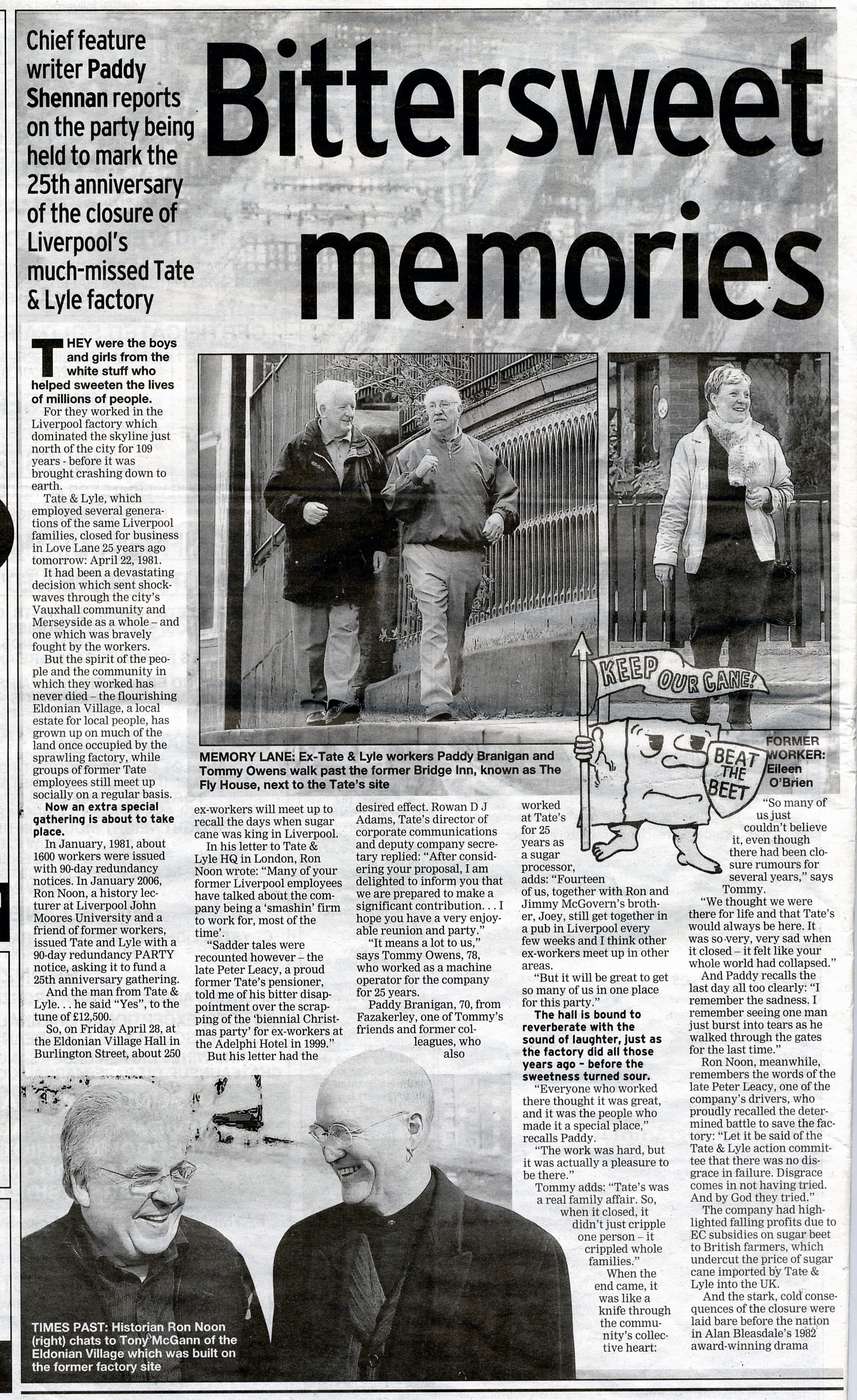
‘It means a lot to us’ says Tommy Owens, 78 who worked as a machine operator for the company for 25 years. Paddy Branigan, 70 from Fazakerley, one of Tommy’s friends and former colleagues, who also worked at Tate’s for 25 years as a sugar processor adds: “Fourteen of us, together with Ron and Jimmy McGovern’s brother, Joey, still get together in a pub in Liverpool every few weeks and I think other ex-workers meet up in other areas. But it will be great to get so many of us in one place for this party”.’
Writing now on January 7th 2012 in a shed at the end of my Sunderland mother in law’s shed (the only means other than the public library in Kayall Road I have of getting onto the internet), I am distressed by the number of lovely Love Lane lives that have ended since 2006. There are so many more absent friends and the latest bereavements are those of Bobby Austin who will be buried next Wednesday and Barny Murray who will be buried the following day. I was with Barny, Joey Mc, Mike Boyle, Big “Tone” and the inimitable Albert E Sloane just a little over a fortnight ago and I took some smashing photographs of that night. Barny will be a big miss.
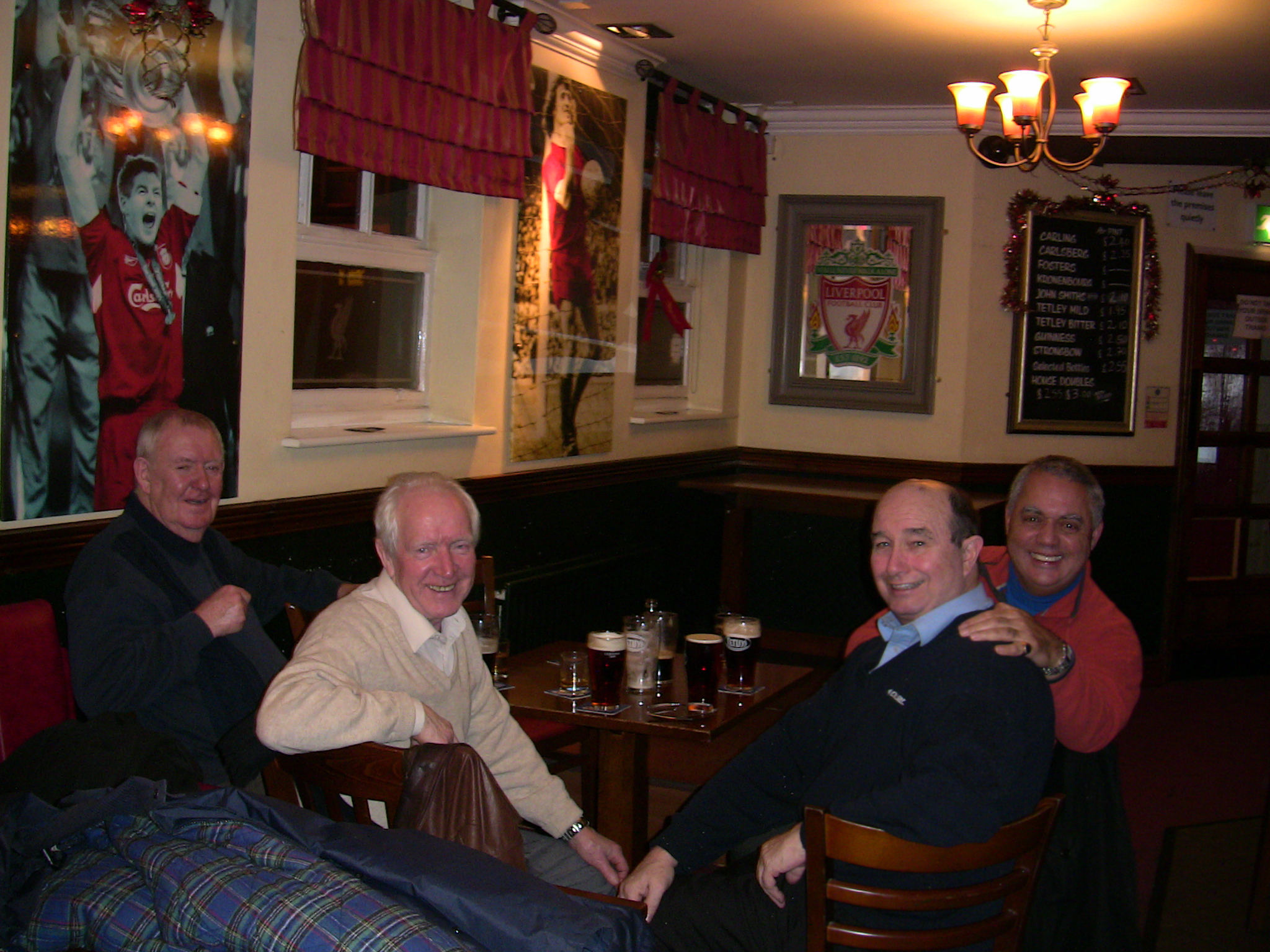
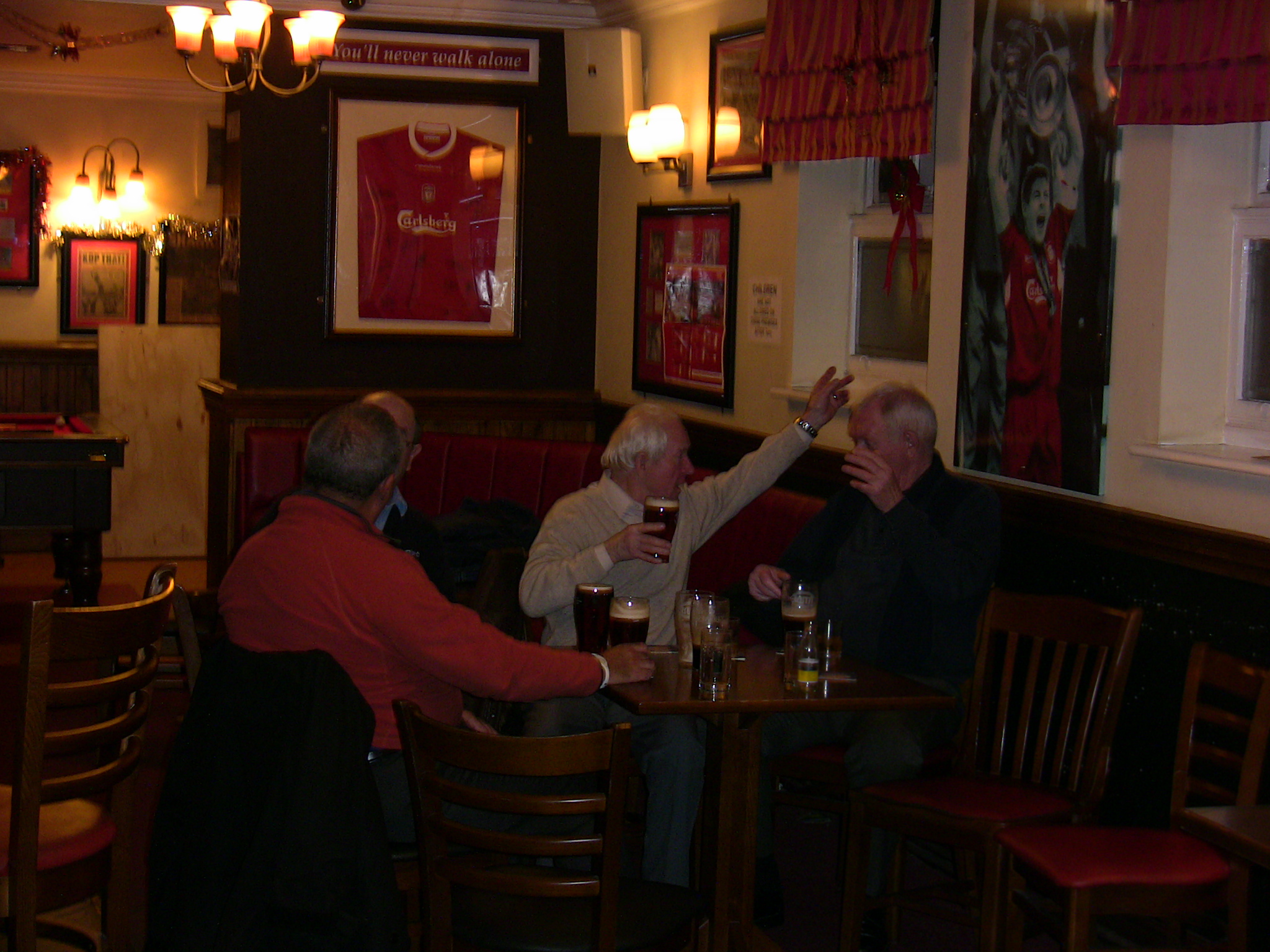
Bobby unfortunately never made it down to the Punch and Judy because although the spirit was willing it was too much of a treck in from Skelmersdale. This is a man who literally and metaphorically had sugar in his blood and was arguably the greatest sugar striker of them all.
Check out the Video interview with Bobby on our site at the bottom of the page entitled WHAT IS SUGAR?
My efforts to place photographs on this blog have failed because the connection is very poor.
BACK TO THE PAST! I’m back home in Liverpool on Monday 9th Jan 012 and have now been able to add the photographs onto the website. My study is not only warmer but the technology is way beyond the garden shed!
P.S. I must be a very “unbiased sucrose historian” because as an Everton season ticket holder I’ve gone for a drink in an LFC “tabernacle” called THE NEW HOLT. The reason for this is that it is Albert’s nearest pub and he’s not been too mobile recently and a trip into town to the Punch and Judy was ruled out. Albert is a blue, so too is Joey McGovern but Big Tone and Mike Boyle and Barny are all reds. (Have a look at the 90 DAYS OF SWEET FA pdf file below)
A toast of love and respect to our absent friends Bobby Austin and Barny Murray
Written by Ron Noon at 17:40 on Friday, January 06th 2012
First of all I am writing this under pressure of time as I have to visit my mother in law in Sunderland Hospital and writing in a public library just round the corner is my only acess to the TINTERNET!
Here is the email that we had from Rob Austin on New Years Day:
“My dad was Bobby Austin of your Film. Sadly he died on 31 December 2011. His family feel blessed to have this accessible recording of his interview on sugar, taken as part of your research. We gratefully thank you for this.
» Comment left by R N Austin (jun) from Rainford, Merseyside on 01st January 2012
Albert E Sloane phoned me up to tell me that Barny Murray one of our “regulars” from the Punch and Judy crowd had passed away and we had only been with him three weeks back.
I will provide pictures and more information about these two lovely men ASP but there is one reassuring thought that I gleaned from a card I picked up last week.
“To live in the hearts of those we love is not to die.” This site has a heart and soul and the lives of Bobby and Barney will always be celebrated with love and deepest respect.
RIP.
Bitter Sweet Memories: “MEMORY IS LIFE!”
Written by Ron Noon at 15:08 on Monday, November 21st 2011
MEA CULPA, MEA CULPA, MEA MAXIMA CULPA! That’s a rather posh latin apology for the near seven months of my failure to blog! I do have PMCs, (personal mitigating circumstances is the term we used at LJMU to describe student “excuses” for late submissions of assignments), and I will get round eventually to explaining why my sugar sabbatical has not been entirely unproductive.
FIRST THOUGH THE SUGAR “BUSINESS AS USUAL”.
Larry McShane a journalist at Associated Press when writing about the closure of the Domino Sugar Refinery in Brooklyn New York in January 2004 noted that the iconic building with its familiar red neon sign overlooking the East River and the most expensive real estate in the Cosmos had predated the Brooklyn Bridge and “outlasted the Brooklyn Dodgers”! After 148 years of refining in the Big Apple “Domino” like “Love Lane” in Liverpool, (described ten years after Henry Tate set up his state of the art mother refinery as “the New York of Europe, a world city”), closed down, leaving its workers with nothing more than memories. Domino had been owned by Tate & Lyle before it was sold to the American Refining Company in 2001, suggesting that the links in this sugar chain between the Lane and the Williamsburg Bridge crossing the East River, are not just random and coincidental. This was another version of history repeating itself as tragedy in the same way as closure had blighted the lives and community of the boys and girls from the Liverpool whitestuff 23 years earlier.
The M word was used by Ted Sampson from North Wales on our Comments page last week when he wrote about about his late mother Betty Sampson who had worked in Tates as a cleaner before retiring in 1968/1969. “Wow…Brilliant film…that brought back memories.” Thanks for that compliment Ted and yes our site is about helping to preserve memories and ensure that Love Lane lives do indeed live on. With the kind of contributions from you and other former Tates employees like the “2 Mikes” (Mike Wray aka MWW from the Wirral, and Mike Greenhall from New Zealand) we can hopefully help create a “virtual community” of former workers and their lived experiences. There are so many who have already written in and I would encourage some readers to overcome inhibitions and record or report their own or family members experiences of Love Lane Lives. (Not everyone is familiar with computers and webpages including my great mate Albert but all stories and comments can be printed off.)
The M word was also prominent in a sad, unsigned letter, doing the rounds of the historic Domino Sugar Refinery in Brooklyn, New York a week before it closed down. The advice it gave to 280 workers suffering from a growing sense of terminal nostalgia for a way of working life about to end, was “make sure you don’t leave your memories behind, because they are our entire world”. Surplus sugar cane capacity in an increasingly anachronistic plant was the ostensible reason for the matricide of what had famously been the original refinery of 19th century American Sugar Baron, Henry Haveymeyer, whose American Sugar Refining Company, a century earlier was one of the ten biggest and most profitable companies in the world. (What had been written before its closure about “the increasingly anachronistic Love Lane plant”?)
Perhaps the real reason for the end of Sugar Cane time in the Big Apple may have had more to do with the real estate potential of the 11 and a half acre site, and its vantage point looking out across the East River to lower Manhattan. (Due respect to MWW on the Wirral but New Brighton is not New York!) That glittering world of condos and loft apartments, housing Wall St. brokers and artists, although geographically close to Brooklyn’s blue collar workers was socially a million miles away at the end of the shift on Friday 30th January 2004. The boys and girls from New York’s White Stuff were now former costs of production whose memories the letter poignantly concluded “are the only things we keep”.
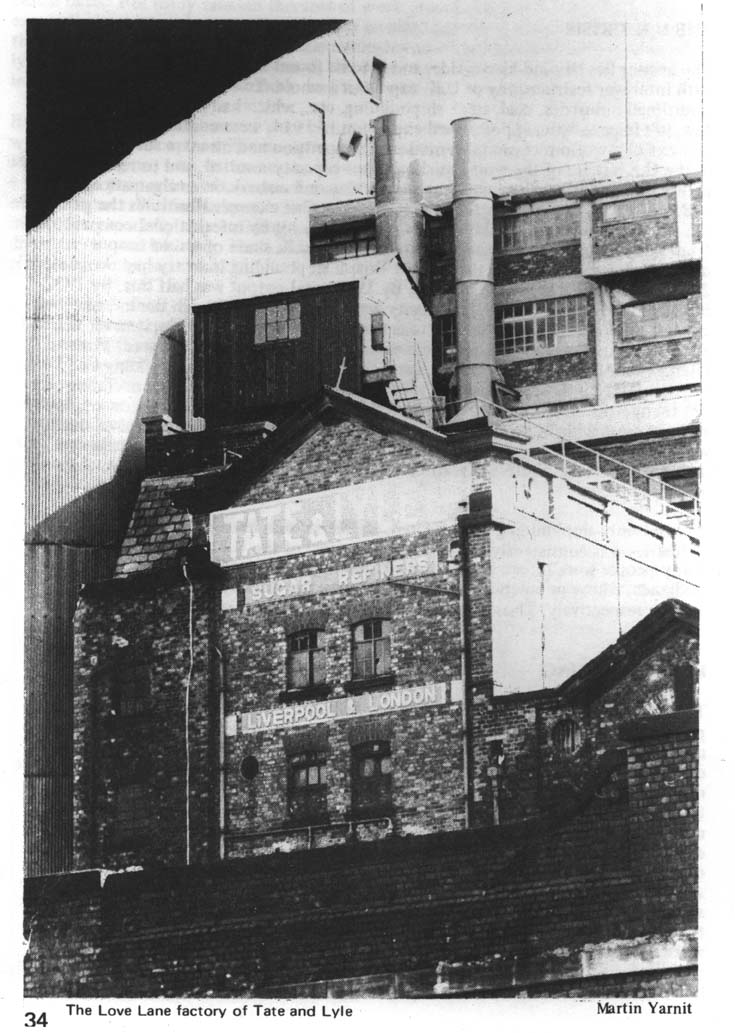
“Memory is life.” The 30th anniversary of the closure of Love Lane, Henry Tate’s mother refinery was the last occasion when I blogged! April 22nd is a poignant date irrevocably seared into the collective memories of the boys and girls from the whitestuff whose agonizing job insecurity intensified on January 22nd 1981 with the issuing of 90 day redundancy notices. This website symbolizes the extent to which Love Lane lives do indeed live on but the overwhelming sense of terminal loss when the refinery closed down is very difficult to do justice to. The Marxist historian Eric Hobsbawm in Age of Empire made specific reference to the difficulties of writing a dispassionate history of a period through which one has lived. Hobsbawm quotes French writer Pierre Nora who affirms that “history is the always incomplete and problematic reconstruction of what is no longer there” and how “memory always belongs to our time and forms a lived bond with the eternal present”.
I tried to convey some of the pathos of closure by making accessible online a number of the newspaper accounts of that tragic period and of Tate & Lyle’s leaving and grieving of Liverpool. “Where do I go from here? The dole I suppose.” That comment was typical of so many to the closure announcement and as an historian, albeit a sympathetic historian I had not lived that pain and demoralisation. The newspapers only tell part of the story. The rest has to be written up by former refinery workers.
Trying to write up stuff while on half term holiday with our grandchildren back in February was a sneaky way of trying to keep the blogs fresh and pertinent during the “90 days”. Writing blogs in Kayall Road public library in Sunderland was another stimulus because it gave me access to the web while my wife was visiting her elderly mother. Somebody once said that history is not so much what happened as what contemporaries perceived to be happening at the time. For me “at the time in question” there seemed so much more to be done when I safely returned to my computer back home in Allerton.
How and why did I “dry up” in mid April? Even the much welcomed anniversary coverage in the Liverpool Daily Post and Liverpool Echo failed to re-charge my sugar-fuelled batteries. It was not as though there was zilch in the sugar world to write about but something I’d embarked on at the very end of 2010, was deflecting my bitter sweet thoughts elsewhere.
I was and continue to be a Labour and trade union historian which was how and why I first got involved with my two sweet fightin’ mentors Albert E Sloane and John Maclane, but also why 2011 and a centennial anniversary of a seminal event in the history of the Liverpool working class became more compelling. I was committed to do something about the Liverpool General Transport Strike of 1911 with a non-sugar centric friend and former colleague and it “crowded out” everything else. Sam Davies and I have now successfully deployed our historical knowledge and passion to commemorate the memory of John Sutcliffe, a carter and Michael Prendergast, a docker, shot dead by the military on August 15th 1911.
The 20 year old Sutcliffe and 29 year old Prendergast were not “rioters”. They were innocent victims of what Sam is now investigating as a shoot to kill directive. Where they were shot (Sutcliffe was “murdered” on the corner of Hopwood Street and Vauxhall Road) was right inside the sugar land area just north of the city centre that this website of ours is focussed on. With the help and backing of the North West TUC and THE CASA in Hope Street we have succeeded in ensuring that there will be a commemoration plaque to remind people of the horrendous consequences of deploying armed troops when dealing with striking workers seeking union recognition.
The surviving relatives of John Sutcliffe who was due to be married three weeks later were traced by Sam’s forensic researches and on November 7th on the BBC North West Inside Out programme there was a feature involving Sam and I and Sutcliffe’s relatives.
That said I did a good deal of writing and research with Sam on 1911 but the real forensics of working through documents at Kew Record Office and tracing the family histories was down to Sam. Tony McGann of the Eldonians once again turned up trumps and allowed us to use the Eldonian Village Hall for a 15th of August Centennial Commemoration event sponsored by the North West TUC. How shocking and sickening was the news relayed on our comments column by Mike Wray of the arson attack on the Village Hall and the devastation it has left in its wake? The indomitable spirit of Tony McGann and the Eldonians will ensure another rise of the Phoenix but they will surely need help and assistance and I’m convinced there are many familiar with this website more than willing to support a campaign to restore the Hall to its former community glory. It was of course built on the FAIRRIES part of the Love Lane refinery.
The Russian poet Joseph Brodsky wrote in 1986 that “if there is any substitute for love, it is memory”. That’s why the surviving relatives of Sutcliffe and Prendergast will know that although they can’t bring them back, they can now at least remember their legacy in an environment which thanks to this type of public history project will ensure a collective respect and memory of the young lives lost in the cause of social justice and a better tomorrow. Sam and I felt very proud of what we’d been able to uncover and Sam will now write up much more than what was included in our joint pamphlet published back in August. I can now get back to my achingly addictive Sucrose studies.
P.S. What about this Paul Theroux comment in MY SECRET HISTORY?
“One of the greatest things that writers did, I thought, was to isolate an event, and light it with imagination, to make people understand and remember; and not just events, but people and their passions. Forgetting was much worse than failure; it was an act of violence…For all writing aimed at defeating time. No one could become a writer - no one could even care about it - until he or she experienced the impartial cruelty of time passing.”
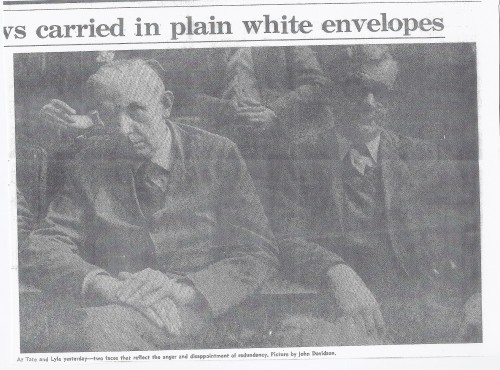
The writing is too small to make out on this scan but this is what the reader would have read on January 23rd 1971:
“At Tate & Lyle yesterday - two faces that reflect the anger and disappointment of redundancy.” The picture was by John Davidson.
It certainly takes more than Liverpool’s Paul McArtney to evoke the pain of YESTERDAY, a yesterday experience that will tragically become tomorrow’s experience for millions more in 2012 unless….
The 30th anniversary of an act of matricide is TODAY, 22nd April 2011
Written by Ron Noon at 06:30 on Friday, April 22nd 2011
I’m reproducing a blog I wrote exactly a year ago TODAY, on this 30th anniversary of the closure of Love Lane. A sad day indeed. This website’s title tell’s it’s own story and we have tried to ensure through the film, letters and contacts that LOVE LANE LIVES do indeed live on. You have only to look at the emails from Michelle Bailham and Collette Kid (Michelle’s dad is Tony Roche) to know the importance of shared memories. “A people without a past is a people dispossessed” a reminder, if one was needed, that history is vital to our shared collective memory and dreams of a better tomorrow.
You can after reading this listen to Ian Prowse’s efforts with the children of Hillside school who devised a SAVE OUR SUGAR protest song, albeit now 30 years out of date. Or is it?
http://www.lovelanelives.com/index.php/blog/entry/save_our_sugar/
.............................................................
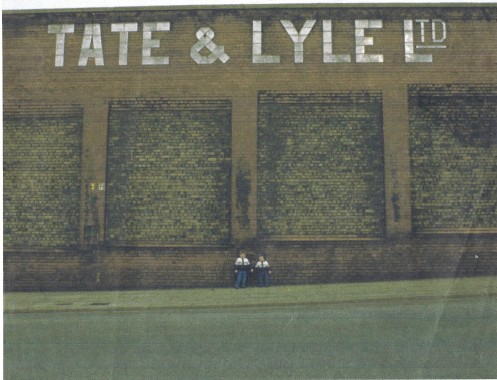
“On 5th December, [1872], the barque Dei Gratia of Nova Scotia bound from New York for Gibraltar and 300 miles west of her destination, sighted two other vessels. The first of these was a German tramp steamer outward bound for the West Indies, the other was the brig Mary Celeste, sailing crewless in the Atlantic.” (Watson)
Unlike the mystery shrouding the Mary Celeste the reasons why Tate & Lyle abandoned Liverpool are knowable and historically verifiable, but similar to that ghostly vessel, explanations as opposed to convenient myths, stretch way beyond European shores! The commonest cause of the rundown of Love Lane is that it was due to EEC regulations and the reduction of cane quotas, an explanation Tates management sold to their employees from the early 70s. Initially it justified common cause with the unions and blaming Brussels and the ludicrous CAP. Many people who were far from xenophobic and anti-European bought this argument and my initial conclusion about closure, although rhetorically sound,is insufficient as explanation for the matricide. “The city which had been renowned internationally in the 1960s for the Mersey Beat and the Beatles became the first main victim of the ugly sugar beet and Mad ‘CAP’ disease!” (CAP = Common Agricultural Policy)
Of course it was mad but the EEC and its Common Agricultural Policy was only one factor in the decline of Love Lane, and one skilfully and cynically magnified to divert attention from other reasons for wanting to junk the mother plant. We have alternative sources to investigate the ten year struggle to keep Love Lane open and Albert and John my two sweet fightin’ mentors, (John now sadly deceased), urged me to work through their documents, which are a very important part of this ongoing Love Lane Lives project. The provenance of their documents, deposited but un-catalogued in Liverpool Musuems, was struggle! In 1973 when the threat of closure switched up a few gears, a workers action committee was set up and “in various guises and under various names was to remain in existence until the refinery closed, producing in that time several hundred weight of paper”. That takes time to process.
The 90 day redundancy notices issued on 22nd January 1981 meant according to company historian Watson that “someone had to achieve in less than three months what they had failed to do in eight years…to persuade the Government, (as a successor of previous Governments with the same idea), to change its mind”. The joint union document that was rapidly prepared was too little and too late. (There was a Joint Trade Union Research Committee set up in early February which reported at the end of February.) Watson is correct in arguing that “although this was an honest and conscientious piece of work”, it was produced in a hurry and of course “the threat to Liverpool refinery had not come out of the blue”. The first rumour of closure had been in 1971!
Actually there had been “trust” in the early days of the campaigning for local management. The ironic thing at the end of the 70s, early 80s was that Liverpool was suffering because of the vulnerability of branch plants of large Multi National Companies to rationalisation. Tates was a company which despite its paternalistic image was a MNC of the sugar world and it was difficult for the Love Lane workers to comprehend the survival and diversification strategies open to such a geographically spread company. From the vantage point of company headquarters in Sugar Quay down in London, what was happening in Liverpool was a local side show. A letter in ‘78 to John and Albert from a Liverpool University lecturer, emphasised how the company was uncoupling refining and Love Lane in particular from the group’s growth engine and its corporate “accounts”. It was being made to stand alone! What may appear from company headquarters as “strategic disengagement” is in fact chicanery from the perspective of Love Lane refinery workers (and indeed local management) who knew nothing about Tates global strategies.
Tates always denied transfer pricing but creative accountancy and movements up and down the sugar chain can be described by other terms. When the subsidiary of a Canadian subsidiary (Redpath) provided monies from Bermuda to buy ships for the Tate & Lyle Group there is clear evidence of at the very least a sophisticated fiscal policy. An earlier blog dealing with CONCLUSIONS elaborates more on this theme. (“More pictures and interviews for 09 as well as a controversial conclusion about closure”. Ron Noon 12/20/08)
Another point to bear in mind about how MNCs operate is that they can so often play one set of workers off against another, and Albert had some jaundiced views about the London refinery workers. There were inbuilt tensions between the different refinery sites in Britain that eventually exploded out of the holding efforts of the Port Refineries Committee, but there was also within the Tate &Lyle Group different divisions and sections, which adjusted and diversified away from refining as a core activity. At the same time there were changes going on at Board Level which would culminate in a chairman from outside of the families and a “chief executive” from Canada (Neil Shaw) that had little feel for local loyalties.
What I’ve focussed on in some of the earlier blogs is the extent to which Tates were able to hide behind the complexities of sugar diplomacy while it stealthily moved away from commitments to the original mother plant. This was decision making with no room for sentiment or history and of course it was symbolic that the actual decision to close Liverpool was taken by a board with neither a Tate nor a Lyle on it. The ‘theatre of paternalism’ had served the firm well and that P word needs to be more closely examined in a subsequent blog. The concept of “theatre” is not to trivialise analysis but to get to the very core of people’s perceptions and mis-perceptions of representations and realities.
......................
Peter Hildrew a Guardian journalist described his impression of the vast refinery the day after the 90 day redundancy notices were issued. “It stands in the heart of dockland, a landmark built on a site where sugar has been refined for over 100 years and clearly visible from the nearby city centre, even in the grey mist which accompanied yesterday’s dismal news”. ‘Symbol of a sweet past and bitter future’ 23.1.81 Guardian

Christy Byrne has passed away: A lovely and funny man who will be sadly missed
Written by Ron Noon at 10:49 on Thursday, April 21st 2011
Many people who visit this site will have seen the picture of Christy taken at the FILM PREMIERE of our LOVE LANE LIVES film back in late October 2007. He was always a regular member of the Punch and Judy club when we had our get togethers and usually ended up singing a song and making us all laugh. He was an exuberant personality and he and Paddy Brannigan were notorious on the B shift (or Balmy shift) for mischief and fun. I feel privileged to have known him and he called me the “young Bamber Gascoigne” to remind me that it was all right coming along to get the chat and the craic from the B shift boys but “I had to get my ale in”. I think I did and I certainly enjoyed every minute with Christy and the friends who thought the world of him and who will now cherish his memory.
Here’s Christy at a 1987 Christmas bash in the Beehive.
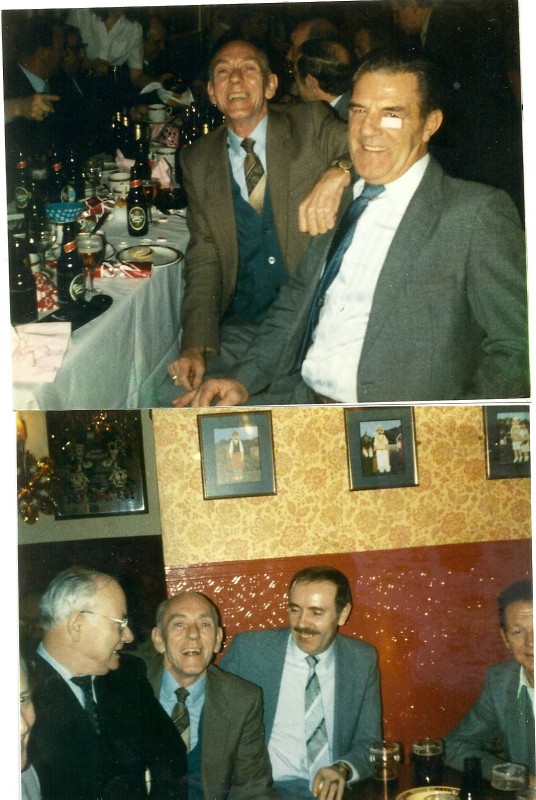
Workers plan to stop sugar supply!
Written by Ron Noon at 15:22 on Friday, March 11th 2011
I was with Albert E Sloane on Wednesday afternoon in the Punch and Judy and I told him of a GUESTBOOK entry from Mike Greenhall “the sugar boiler from down under”! Mike has written in to our site a number of times before and his latest email from a still shaken New Zealand was in response to my request for comments from people about their memories and experiences of the 90 day redundancy notice period. Was there an alternative to the closure of the Liverpool refinery? “Maggie Thatcher” had clearly snubbed Liverpool and was busily fine tuning what became one of the best and arguably most infamous of all acronyms? THERE IS NO ALTERNATIVE was popularised and propagandised as TINA but John MacLean was not having that and before I reproduce Mike’s comments this is what Albert E Sloane’s friend in conflict argued:
“We believe there is an alternative to closure of the Liverpool refinery, but to investigate and carry out that alternative requires time. We are asking very simply for a suspension of the 90 day notice to explore that alternative.”
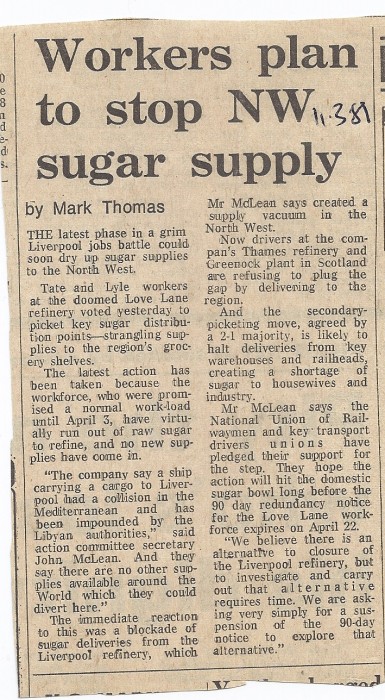
I wonder what impact a PROTEST SONG of the calibre of that produced by HILLSIDE SECONDARY SCHOOL, 28 and a half years later and recently played on this site for the very first time, would have had on the struggle? Both the title, SAVE OUR SUGAR, (S.O.S.) and the words sung out with such gusto by those wonderful school kids were/are the biggest retort to those who get bitten by TINA.
Here’s the link for a quick refresher in terms of the lyrics and the pash in which the kids delivered the SAVE OUR SUGAR song:
http://www.lovelanelives.com/index.php/blog/entry/save_our_sugar/
........................................................................
Hi Ron,
You asked about the 90 day notice, to be honest, I don’t remember very much about the 90 day notice period now. I do remember that just before Christmas, we were working on a 10,000 ton export order and just completed it before the Christmas shut down.
We had worked flat out to complete the order in the hope that it would prove our worth. Instead, we were informed that, though we had completed the order efficiently and ahead of time, the refinery would not re-open after the Christmas shut-down, and with the exception of a few management personnel who were to be transferred to London, the rest of the employees would be receiving redundancy notices.
Though we had been half expecting it, it still came as a shock. As I had come straight from school into the refinery, I could not imagine being employed anywhere else, particularly as my particular skills, sugar boiling, whilst being very important in the sugar industry, were of no use at all outside the industry.
When we returned after the shut down, I remember there were all sorts of plans to fight the closure with offers of support from various unions, particularly from the docks and transport unions, but the heart had gone out of the people, we had been worn down to the point where most just wanted it over and done with.
We had to turn in every day of the three month notice period and during that time we had to empty out all the tanks and storage vessels. As each was emptied, it was locked off, I believe to prevent sabotage, not that anyone cared any more. We spent most of each working day sitting in various rest rooms round the factory killing time. I spent most of my time in the Pansman’s changing room on the Recovery Pan Floor along with Dicky Hart, the Recovery Pansman and Sid Jones, the Recovery Receiverman.
I remember on one day, coming in from the canal car park, which was a section of canal alongside Pall Mall that had been filled in. I can’t remember now who I was with, but we were looking up at the refinery, from which a couple of wisps of steam were drifting up, and this person quietly said” It’s like a sleeping giant”. That’s what it was like, completely silent.
At some point during this time I remember attending a mass meeting in the Vauxhall Road Canteen during which Albert “Tod” Sloane addressed the meeting. I don’t remember much of what was said now but one thing I remember him saying and something which has stayed with me till this day “This is where we live!” It sounds corny now but Never was a truer word spoken.
I hope this is of some interest, though it was a long time ago now and I don’t remember a lot! Give my regards to Albert,assuming he “hasn’t popped his clogs” recently! “THIS IS WHERE WE LIVE!” Tell him I still remember.
Regards, Mike
..................
I am delighted to say that Albert has decidedly not “popped his clogs” and was in fine form on Wednesday afternoon, very much cheered by Mike’s kind comments.
................................
Guestbook_message_from_John_Callaghan.pdf
Michael Wray (MWW from the Wirral) responded to John’s lovely letter:
“Hi John. Besides working with Frank on a daily basis, I went down to a presentation at Tate & Lyle Croydon with your dad in 1978, The “Tate & Lyle News” had announced that the company was asking for employees’ ideas- not necessarily connected with sugar- into which the company could diversify. IIRC, Frank’s idea involved an innovative form of double-glazing. I’d also put forward a suggestion and we were both invited to a presentation at Croydon HQ. It was my first-ever visit to the capital, so Frank arranged that we should travel there by train together. Without him I would’ve been lost.”
Subsequent to that was a letter from Collette Kidd which again demonstrates how we can collectively ensure that Love Lane Lives live on:
“Hi John callaghan. I have an old picture of Frank callaghan and his mates, the drivers of tates. I was left it by my mum when she died. Your dad was good mates with my Uncle Gerry & John Mcgovern. ;Have you ever heard of them? They lived in Rose Place.”
.......................................................
P.S. I was handed this in the PJ last Wednesday. Can anyone remember the CRYSTAL team of 1968?
.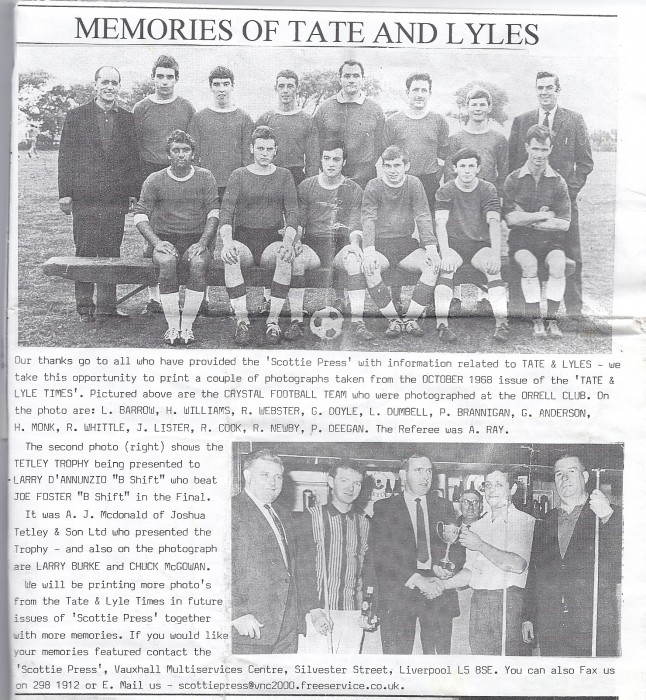
February 2011 is the 10th annniversary of Marie Brenner’s IN THE KINGDOM OF BIG SUGAR.
Written by Ron Noon at 15:52 on Monday, February 28th 2011
On November 27th 2008 I finished off my first “assignment” on this website and concluded:
“So that’s my first blog entry, somewhat incomplete and certainly leaving a good deal more unfinished sugar business to be blogged. Remember all you sugar lobbyists who may gain access to this site that ‘the only completely unbiased sugar historian is the recording angel, whose works are as yet unpublished and who according to Mark Twain had opinions which to Satan might appear like prejudices’!”
I’m an historian but I’m not the recording angel when it comes to writing about Tate & Lyle or American Sugar Refining Inc. I do contend however, (aka Mark Twain), that many of the practices and activities of these companies are “very much further south of heavenly veracity”.
When I first started blogging on Love Lane Lives, it would have taken a sheer feet of counter-factual, post-modernist imagination to have envisaged a Tate & Lyle world entirely devoid of sugar! That said on July 1st 2010, it was announced by Reuters that American Sugar Refining (ASR) had bought T&L and a “perpetual license to use the Tate & Lyle name”! ASR is the new Sugar Giant on the block, owned by Flo.Sun Inc down in Florida, a private company which in turn is owned by Cuban Americans Alfy and Pepi Fanjul! They had acquired Tate & Lyle Canada Ltd. (Redpath Sugar) in 2007, so there is a definite familiarity and “kinship” between the old and the new kids on the sweetener block.
So much for the 2010 variation on truth being stranger than fiction. What about the February 2001 case study examined in a stunning essay by Marie Brenner in VANITY FAIR?
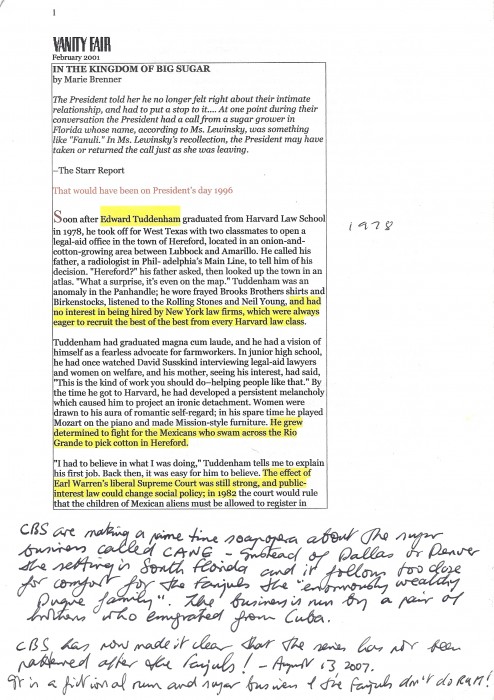
|Here’s the full essay.
February_2001_in_the_Kingdom_of_Big_Sugar_Copy.pdf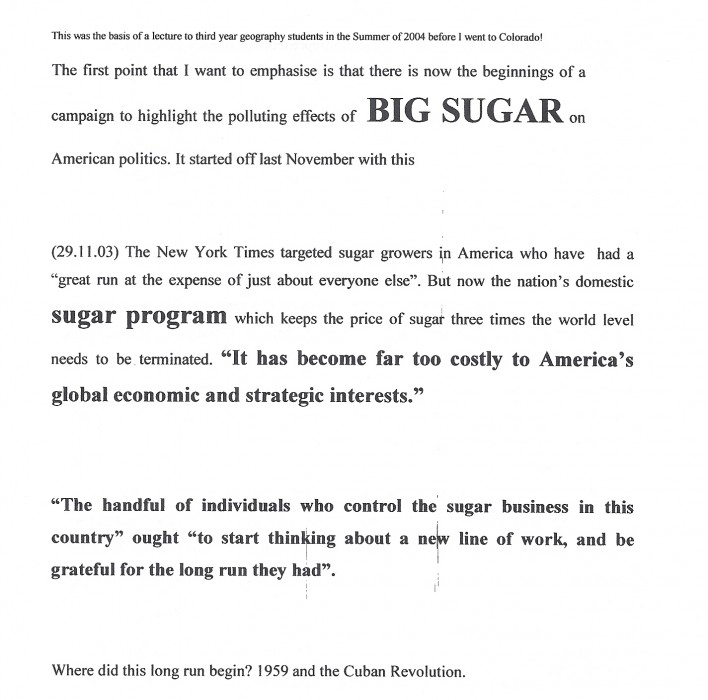
Another Kayll Road Public Library Blog
Written by Ron Noon at 14:51 on Friday, February 18th 2011
Friday February 18th, Kayll Road Library 
I knew before travelling up to Center Parcs, Whinfell Forest, Cumbria to meet up with our little grandchildren, Henry, Ralfie and Ruby, for a well earned half term break, that I’d have “problems” sneaking away from the rest of the holiday gang to do a blog on the 17th February! That was a key date for me as thirty years earlier, the House of Commons debated the Tate & Lyle decision to close Liverpool Love Lane refinery, but on the edge of the Lake District it was just another action packed day at Center Parcs.
I waited for the right moment, stealthily put on my anorak and sneaked out of the lodge we were staying in, to access any unsecured wireless network in the main village centre. It was the narrowest window of opportunity ‘cos I’d promised ar Ralfie, (three years of youth last week), that I’d go out with him later on that day with his Early Rider bike. What would my wife Gail, (Gail warnings are worse than yellow cards), ar Matty and his wife Sarah, Sarah’s mum Shirley and Sarah’s sister Laura think if I let the little man down? Not surprisingly in the frenzy of trying to do too much I had great difficulties uploading the important stuff I’d wanted to accompany the text and the site crashed and was far too slow. I remember the panic “freeze frame” moment, when I felt on the cusp of a Basil Fawlty like attack on my laptop machine, and only resisted such an inane act because of the compensating thought that internet access at Kayll Road public library Sunderland, would make up for all my frustrations as it had done before Christmas in snowy Cannyland. That was also a time when I’d been desperate to write up a blog but with the help of the great staff here and the facilities still on offer I did just that.
Anyway we left Center Parcs this morning and headed up to Sunderland to check out Gail’s 91 year old mum and here I am once again sat down in front of a computer in Kayll Road, the library that Gail used when she was a child. I can at a more leisurely pace than yesterday, add as many attachments as needed. I’ve also been very pleased to see that Warren Keith my website man has already uploaded the SAVE OUR SUGAR blog and film. Thanks Warren, the best young website designer in the sugar business!
So what follows below? First of all there is part of the debate in the House of Commons and the passionate contribution of Bob Parry whose constituency Love Lane Refinery was in.
Secondly a little more commentary on the Congress of Merseyside and the extent to which it was “merely” a “local side show” as indeed many of the efforts made earlier in the 10 year struggle to keep the refinery open.
Thirdly there is a great extract from the book written by Archbishop Worlock and Bishop Sheppard with references to our scouse Dickens ALAN BLEASDALE.
..............................................................................................................................................................................
HANSARD 17 FEBRUARY 1981 European Community (Sugar)
Several Hon. Members rose—
Mr. Deputy Speaker (Mr. Bernard Weatherill): Order. I remind the House that if the business motion is carried the debate will end at 11.30 pm. I should point out that 20 hon. Members wish to speak.
9.38 pm
Mr. Robert Parry (Liverpool, Scotland Exchange):
My right hon. Friend the Member for Barnsley (Mr. Mason) has given the historical background to this debate and my right hon. Friend the Member for Lanark (Dame Judith Hart) has touched on the question of the Lome agreement. I hope that the House will understand if I deal mainly with the proposed closure of the Tate and Lyle plant, which lies in my constituency. I wish to deal with the’ effects that that closure will have on the people of Liverpool, and particularly on those who live in the inner city areas. On Merseyside, more than 100,000 people are unemployed. In the special development area nearly 16 per cent. are unemployed.
The position in Liverpool is far more serious. In inner city areas-including my constituency - unemployment has reached 40 to 50 per cent. Those are official figures, given by the Under-Secretary of State for Employment just
before Christmas.
Recently, the Daily Mirror carried out a survey in a multi-storey block of flats in my constituency – Logan Towers - which is situated close to the refinery. That survey showed that 50 per cent. of the people living in those flats were unemployed. The deputation that met the Minister this morning included people from all strata of society. I think that the Minister was touched when the Roman Catholic archbishop. the Rev. Derek Warlock, said that only last Sunday he went to St. Anthony’s church, in the Scotland Road area, and found that. in a parish that formerly had 12,000 people, only 2,000 remained. Out of that 2,000, 250 worked at the Tate and Lyle, refinery. That gives some indication of the tragic consequences that will accrue in the inner areas of Liverpool. Mr. Runge, the managing director of Tate and Lyle, told the Minister that in his opinion the work force at Tate and Lyle was second to none.
We are pointing out that the closure of the Tate and Lyle refinery is due not to bad industrial relations or poor production but to the old question of the production of sugar beet in the United Kingdom. The Tate and Lyle workers are not opposed to the British Sugar Corporation producing more sugar. They insist - tbey have asked us to support them - that the 1.3 million tonnes of ACP sugar should be imported, refined and consumed in the United Kingdom. They say that if the British Sugar Corporation wished to refine more than the 936,000 tonnes that has been proposed the surplus should be exported. The cane sugar workers have never put forward any proposals that would lead to a loss of jobs in the beet industry.
Following an all-party meeting, of hon. Members, the Minister wrote to me last Wednesday saying:
“On the question of exports I made clear that if either or both companies” - That is Tate and Lyle and the BSC - “were able to export and hence maintain a higher throughput than could be absorbed by the United Kingdom market. I would welcome it. But exports are less remunerative than home sales and I could not require one company to incur the cost of exporting to ease the problems of the other.” Is there no way that a joint venture could be set up between the British Sugar Corporation and Tate and Lyle to export surplus sugar? I understand that the British Sugar Corporation is totally opposed to that, but I see no reason whatever why such a venture could not be set up. The Minister said that it would not be against the public interest.
Will the Minister of State consider the question of an increase in the regional premium from £7•50 to £20 a tonne? I understand that that would be borne by the EEC budget, and would cost £4•4 million a year gross. The net figure would be lower because the EEC budget would have to pay for absorbing the surplus sugar. That cost is very small beer when we consider that United Kingdom taxpayers and consumers have paid £ I billion over the last five years - 200 million a year. That is the highest contribution of any member State. Will the Minister really fight in Europe for the workers of Liverpool? Will he really put his shoulder in their corner?
Unemployment on Merseyside has reached such tragic proportions that we cannot face any more closures. There are 30,000 young school leavers under the age of 18 unemployed on Merseyside. Is the Minister aware that at Tate and Lyle there are more than 100 young apprentices serving their time who will be thrown on the scrap heap half way through their training? If the majority of people who are 50 years or more are made redundant. they will have no possible chance of finding any alternative employment.
The estimated cost of the closure of the refinery is £30 million. The bill for social security and loss of revenue that will follow will not be far short of £ 10 million a year. That does not take into account the degradation and feeling of absolute despair and despondency of the people in an area which has suffered so much. In the last year or so, even in the area where the refinery is situated. we saw the closure of Tillotsons, with the loss of nearly 500 jobs. Around the corner, we saw the loss of the CBS Engineering and Ship Repairing Company. Again with the loss of several hundred jobs. The cane workers have also suffered their share of losses in the industry. My right hon. Friend the Member for Barnsley has already mentioned the number of jobs that have been shed there.
As I said earlier, in an intervention, Liverpool cane workers are carrying the can. They are carrying more than two-thirds of the total number of jobs which have been shed by the Tate and Lyle company.
I asked the Minister of State a question when I was dealing with the position at Tate and Lyle. He replied: “One of of the tragedies of the situation is that this shouId be seen simply as a beet sugar versus cane sugar lobby. Cane sugar is important. and so is beet. Beet production holds an important position in British expenditure. We believe that there is a placefor beet sugar and cane sugar within our sugar refining capacity and we intend to keep a proper balance to the benefit of both.”
[Official Report. 5 March 1980; vol. 980. c. 488.)
Does the Minister of State fed that a proper balance has been kept? Over the past six years, the British-grown beet share of the home market has increased from 26 per cent. to 49 per cent. I am not opposed to the British Sugar Corporation’s growing more beet provided that it is exported, but I would be totally opposed to any further expansion of the British Sugar Corporation output at the expense of the workers in Tate and Lyle at Liverpool. I understand that the proposed merger with S. and W. Beresford is before the Monopolies and Mergers Commission and that the report is due in two weeks’ time. Labour Members of Parliament were advised by trade unions that if the merger were to go through - I understand that it would not be against the national interest - the Tatc and Lyle refinery would be saved, because the new company could then export cane.
The Minister’s point that the Tate and Lyle company has signed a five-year agreement with the ACP countries does not wash very much with me, because the .various high commissioners for the ACP countries have shown their grave concern over the closure of the refinery. They feel, as we do, that this is the thin end of the wedge and that the bridges have been taken down.
There were three preconditions for the British Government’s accession to the EEC, and the commitment to the ACP countries was one of them. The other two were the British contribution to the EEC budget and the imports of New Zealand dairy farm products. We know about the fights that have been put up by successive Governments in that connection, but they have not been very successful in defending the interests of the ACP countries. Those countries are rightly asking that their sugar cane should not have to suffer. They fear that if assurances given about preserving the cane markets can be breached once, they can be breached again.
The Minister has the right of veto on the new sugar regime on 1st July 1981. Will the right hon. Gentleman use his veto? If not, why not? Will he use it to ensure that Tate and Lyle will be able to remain open on Merseyside? If the closure takes place it will displace surplus home sugar from the United Kingdom. However, the United Kingdom taxpayer will still have to pay £ I .8 million.
The Government are pumping cash into Liverpool in the form of inner city area payments. I am sure that the hon. Member for Liverpool, Wavertree (Mr. Steen) will refer to those payments if he succeeds in catching your eye, Mr. Deputy Speaker. Liverpool is also receiving Government assistance in the form of activity by the National Enterprise Board and the urban development corporation. It is crazy that the Government are pumping money into Liverpool at one end when there is a constant outflow of jobs at the other end.
I was delighted to note that there were seven Conservative Members among the group of Members that saw the Minister last week. If they are so concerned about the loss of jobs on Merseyside, I hope that they will demonstrate their concern by abstaining when the Division takes place. I should prefer Conservative Members to vote against the Government. That would demonstrate the strength of their feeling about the loss of jobs in Merseyside constituencies. I voted against the Labour Government on issues on which I felt strongly, and I ask Conservative Members to think again.
I was disappointed by the Prime Minister’s refusal to meet an all-party delegation to discuss these issues. In the past, my right hon. Friends the Members for Huyton (Sir H. Wilson) and for Cardiff. South-East (Mr. Callaghan) have met all party delegations from Merseyside. I shall be receiving next Thursday, a document produced by the three main trade unions involved-namely, the Transport and General Workers Union, the General and Municipal Workers Union, and ASTMS. I believe that the document will contain several options. If the Government are interested in saving the Liverpool Tate and Lyle refinery. one of the options could be the answer to the problem.
When I receive the document I shall present it to the Prime Minister. Tile right hon. Lady has given me an assurance that she will meet me. I wrote to her this afternoon and asked her to meet me next Monday or Tuesday. I shall advance the argument on behalf of the trade unions and Merseyside Members.
If there is no response from the Government. All these exercises having been gone through, I shall be convinced that the Government do not give a damn about unemployment on Merseyside, and specifically in Liverpool. The company is not responsible, there is no depression within the industry, and the workers are not responsible. If the Government do not respond, I shall consider that they are washing their hands of Tate and Lyle, Liverpool, and are trying to blame either the EEC or the company for making a commercial decision.
If the Government decide to allow the Tate and Lyle refinery to close, the next time a Minister starts shedding crocodile tears from the Dispatch Box over job losses on Merseyside I shall call him a hypocrite.
9.53 pm
...............................................................................................................................................................................
The Congress of Merseyside was a local sideshow which was never given any national exposure. Tragically what happened on Merseyside for most of the previous ten years of closure threats was also very much a local sideshow. There were some national landmarks as in 1973 and the Party Political Conference season, again in 1974, but from then on the Brussels trips did not sprout at any time into concerted national action on behalf of the cane refineries that were threatened by the 1975 Food From Our Own Resources policy and the EEC’s inbuilt bias towards expanding sugar beet. There was a union structure in Britain that was split between the two competing sectors and on top of that a very powerful pan European sugar beet lobby. Was Tates’s at the end of the day really all that concerned about the junking of Liverpool? Did it really wish to take advantage of any more government funding to build a refinery in Liverpool on the waterfront for the sake of Liverpool?
..................................................................................................................................................................................................................................

What I’ve typed out below is a great extract from a book entitled BETTER TOGETHER by David Sheppard & Derek Worlock. It was published in 1988 and this extract is from Chpt 7 “Gizza job” – The Indignity of Unemployment.
“The burden of unemployment in a nation like Britain does not fall evenly. It falls on predictable areas and on particular groups. In all parts of the country, for example, black people have poorer opportunities for jobs than the rest of the community. In the same way, Merseyside is always up near the top of any table of figures of unemployment or other forms of deprivation…Liverpool has many comparable problems with Glasgow and Belfast. Together they form what we call the North West Triangle. Even within these areas – and this is particularly true of Merseyside – unemployment hits some social classes much more drastically than others…Statistics in themselves cannot adequately tell the story of human hurt which results from unemployment, or indicate the nature of the poverty which goes with it…Poverty goes hand in hand with unemployment bearing with it all the obvious mental strains. ‘I worry from Friday to Tuesday (Child Allowance day) that I’ll run out of money,’ we were told by one housewife. ‘We have to spend so much time going to see officials, to the Social Security and Housing, asking for advice, it’s degrading. They ask you the same questions over and over and over again. We feel ashamed, so low, as if we are beggars.’
Alan Bleasdale, the Liverpool born and bred playwright, caught the atmosphere of the social security office with telling force, both from the claimant’s point of view and from that of the official’s, in his series of television plays…Many people from outside Merseyside believed that Bleasdale must be exaggerating. But those living in urban priority areas said quite simply, ‘He’s got us right’. Here was a latter day Charles Dickens enabling those with eyes to see to enter into the subterfuges which the system drove people to adopt, the fear of snoopers, the escapism of the redundancy celebration or party, married couples taking it out on one another…We often hear people speaking of the situation today as that of ‘relative poverty’. The term is used in comparison with conditions in certain parts of the Third World, or when today’s circumstances are set against the ‘absolute’ poverty and hunger experienced in this country in the 1930s. To compare the lot of the unemployed receiving the dole in this country with that of those abroad, whose loss of job means no relief for loss of income, is scant comfort for those facing long term unemployment here. We have found that those who speak of the grave hardships faced by their parents in the Depression of the 1930s, often come from the ranks of those who have climbed out of the urban priority areas. Those whose parents were not so successful recognise a remarkable continuity in their situation. Succeeding generations bear the same scars. In an age when television portrays the standards of the more fortunate, poverty, even if only relative, still hurts human dignity when the sharpest pangs of hunger have been assuaged.”
I_know_Ill_never_work_again.pdf
“Save Our Sugar” and Hillside Secondary School
Written by Warren at 15:27 on Thursday, February 17th 2011
The text below is from Ron Noon:
“Here’s a great new video for our website, as fresh and vital now as it was when filmed during the specialist Sugar Week held at Hillside School back in September 2009. I’d invited one of my former LJMU history students and lead singer with the critically acclaimed rock band AMSTERDAM, to come into school and help with the composition of a protest song to SAVE OUR SUGAR, albeit 28 and a half years after the historic Love Lane refinery was closed down! The wonderful pupils at Hillside were very conscious of what the closure of the refinery had meant for their own community and in that week of different subject based and “inter-disciplinary” projects centred around the world of sugar and Tate & Lyle, they were able to imaginatively re-create the spirit of those challenging times and respond in words and music to the S.O.S. caused by the issuing of the 90 day redundancy notices on January 22nd 1981. School children “if” they are imaginatively taught the real poetry of history have no problems dealing with time shifts and as Leon Seth and I discovered back in 2008 with the primary school children at Trinity R.C. are best placed of all to ensure that Love Lane Lives do genuinely live on.
The former Liverpool John Moores University History student Ian Prowse, then studying for an MA “up the hill” at Liverpool University was delighted to apply his musical talents and stagecraft to work with the children and with a mutual friend, Christine Chellhew of Chellhew Productions, to assist in the making of a Hillside “protest song”. (Ian told the interviewer “I did n’t expect it to be as good as it was…It was brilliant. It was an honour to do it.”) The music along with the numerous essays and letters addressed to “Prime Minister Margaret Thatcher” represented Liverpool youth’s creative opposition to “yet another closure” on what in the early 1980s was caricatured as “Merseyslide”! Watching and listening to the video as the coordinator of the Love Lane Lives project makes me well up with pride and admiration at the sensitivity and passion of the Hillside school children, and their talent for bringing history alive and making it relevant to everyone committed to fairness and decent community values. It was after all their community that was blighted by the decision of a former sugar giant to sever its links with Henry Tate’s mother plant. Enjoy the new kid on our website block and test your emotions watching the making of “Save Our Sugar”.”
On the PROJECT page of our site you can listen to the classic Ian Prowse song “Does This Train Stop on Merseyside?”.
http://www.lovelanelives.com/index.php/project/
You can then go to page 13 of the blogs (it is page 13 at the moment but the more additional blogs…) and read all about what inspired him to write the song.
http://www.lovelanelives.com/index.php/blog/entry/welcome_to_chicago_and_a_song_by_the_lead_singer_of_amsterdam/
................................................................
PROJECT page. Amsterdam - “Does This Train Stop on Merseyside?”
This is a track written by Ian Prowse, a history student of Ron Noon’s at Liverpool John Moores University.
Click on the arrow below to play the track.
.............................................................
BLOG page:
Welcome to Chicago and a song by the lead singer of AMSTERDAM
Posted by Ron Noon in Beyond The Lane on Thursday, May 28th 2009
The debate in the House of Commons over the closure of Love Lane 30 years ago TONIGHT
Written by Ron Noon at 13:07 on Thursday, February 17th 2011
Alfred Stocks, Chief Executive Officer of the City of Liverpool wrote to the Prime Minister on the 30th of January 1981, expressing the alarm felt by the City Council at Tate & Lyle’s decision to close the refinery in April. In a second letter he wrote to Mrs Thatcher (2nd of February) he emphasised the critical importance of a special meeting which had taken place in the City. It had been comprised of representatives from all the Merseyside District Councils, the Leader of the Merseyside County Council, Members of Parliament and Members of the European Parliament, the Bishop of Liverpool and the Archbishop of Liverpool, representatives from the Chamber of Commerce and the Mersey Docks and Harbour Company, as well as the various Trade Unions.
The purpose of Alfred Stocks’s second effort was to ask Mrs Thatcher to meet up with this broadly based delegation to discuss the implications of the Love Lane closure and the possibility of preventing it. In its comment column of February 3rd the Liverpool Echo christened it the “Congress of Merseyside” adding that “this could well become an important milestone in the history of our community. Here we see diverse interests coming together with a strong common purpose - to halt the wounding loss of jobs. The initial aim is to save the threatened jobs at Tate & Lyle. The fight will be difficult and prolonged but a start has been made. Whitehall will get the message that Merseyside has taken enough blows. Tates could well prove the first of many battles. It is not difficult to identify other areas under threat. At the first whiff of danger our Watchdogs should be active.”
Readers of the previous blog know that Margaret Thatcher was not prepared to do business with a delegation from Liverpool even or especially if it did contain Bishop Sheppard and Archbishop Worlock! Is that why David Alton, Liverpool Edge Hill MP, fulminated with anger at Thatcher’s “insult to the people of Merseyside”? He pointed out that “the woman has n’t visited Liverpool since she was elected Prime Minister in 1979” and now “her policies have increased unemployment to well over 100,000 people she refused to see people who simply want to present a case to her”. So on the 11th of February The Liverpool Echo editorial column responded to the Prime Minister’s refusal to meet the extraordinary delegation from Merseyside in a measured but emphatic retort to the snub Thatcher delivered to the people of Liverpool.
“Mrs Thatcher’s refusal to see the Liverpool delegation over Tate &Lyle is no doubt defensible in terms of Westminster protocol. But it will be interpreted as a cold insensitivity to the feelings of the whole community. The composition of the delegation including Church leaders reflected the deep concern over unemployment not just at Tate &Lyle but throughout Merseyside. Mrs Thatcher’s policies have played a large part in creating the situation and she cannot brush aside the responsibility by referring protests to the management concerned. ‘I don’t myself see delegations’ she told the Commons. The Premier should step down from this lofty position and if mere delegations are below her dignity then the City of Liverpool would offer her a warm welcome to see at first hand what is actually happening outside Whitehall.”
Later on that year in the aftermath of the Toxteth riots, Thatcher would be smuggled in to the city to hear testimony from another more informally and more rapidly convened Congress of Merseyside. The historic fact is that unforseen events can turn even those ideologically “not for turning” into listening mode. The impact of Thatcherism, particularly on Merseyside is repeating itself in the deleterious policies of her scion, David Cameron. Liverpool City Council is harder hit than any other council in the country by ConDem cuts, and a tabloid newspaper page in front of me now is very depressing. I’m looking at a picture in today’s Daily Mirror, of Hollywood star Meryl Streep, “her face as unflinching as iron” as she acts out her latest film role as Mrs Thatcher, “on the set of The Iron Lady”, currently being shot in South London! How can Liverpool people and especially the surviving boys and girls from the whitestuff, feel “reassured” that in her blue suit and coiffed hair Meryl is “completely immersed” in the role of the then Prime Minister, particularly Thatcher’s attitude towards delegations from Merseyside. Perhaps it is not too late for Meryl Streep to weave into her script some of the insights gained by the school children of Hillside School when they researched the consequences of Thatcherite policies on their communities.
............................................................................................................................................................................................
I don’t suppose Meryl will be too impressed by this pdf file of her new heroine.
John Maclean: I’ve discovered a briefing note that John left me which related to the House of Commons Lobby on February 16th 1981. It refers directly to Parliamentary question 189 over the Prime Minister’s meeting with Merseyside members concerning Tate & Lyle Liverpool. It poignantly expressed regret at “the refusal of the PM in a reply to the honourable Member for Liverpool, Scotland Exchange, to meet an all-party deputation of Merseyside Members, leaders of local authorities and church leaders, and representatives of management, workers and cane producing countries, to discuss the proposed closure of Tate and Lyle, Liverpool; believes that a Government decision can save the refinery and 1,500 jobs in an area facing nearly 16 per cent, unemployment; and calls upon the Prime Minister, if she is concerned about the situation to think again”.
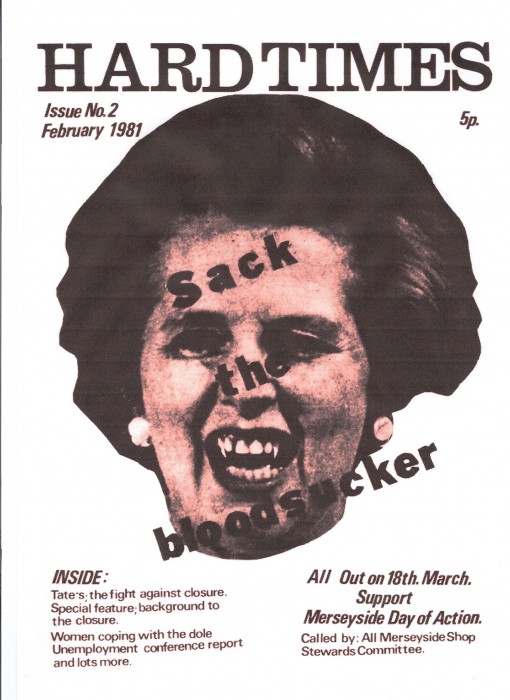
Maggie snub for Mr Cube team
Written by Ron Noon at 10:11 on Thursday, February 10th 2011
The headline in the Liverpool Daily Post on 11th February 1981 was “Maggie snub for Mr Cube team” and it came on the eve of a meeting between Liverpool MPs and Peter Walker the Agriculture Minister about seeking to persuade the Government to intervene in a campaign led by a new CONGRESS OF MERSEYSIDE. David Alton the Liverpool Edge Hill MP was fulminating with anger at Thatcher’s “insult to the people of Merseyside. The woman has n’t visited Liverpool since she was elected Prime Minister in 1979” and now “her policies have increased unemployment to well over 100,000 people she refused to see people who simply want to present a case to her”. The Congress of Merseyside was a cross party group including MPs, councillors and church leaders like the Bishop of Liverpool, David Sheppard and Archbishop Derek Worlock.
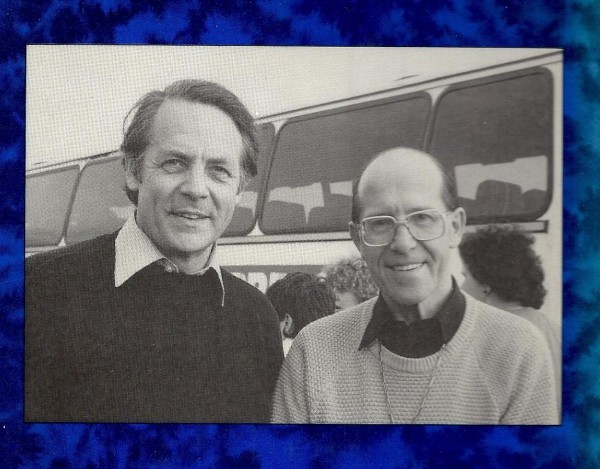
This is a photograph of Bishop Sheppard and Archbishop Worlock from a book they wrote together entitled BETTER TOGETHER in 1988
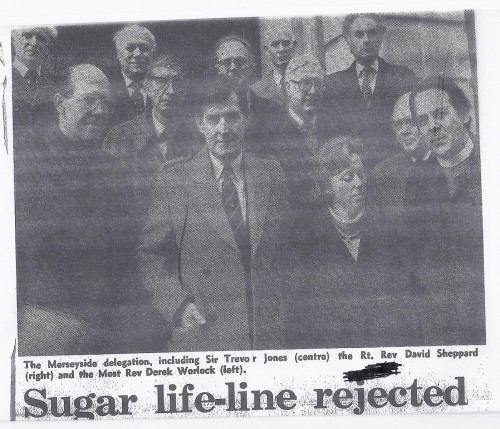
The Daily Post reporters David Rose and David Utting, explain “how she told MPs that those seeking to save the jobs of the refinery’s 1500 workers should see the ‘management concerned’”! The initial request for the PM to meet the delegation was from Sir Trevor Jones the leader of Liverpool City Council. “In the Commons yesterday Mr Alton intervened to ask Mrs Thatcher whether she would agree to the request. But she replied: ‘I don’t myself see delegations’.”
The early 1980s were really grim but history has a tendency to repeat itself, sometimes as farce and tragedy. Judging by the repsonse in the House of Commons yesterday of Thatcher’s heir, David Cameron, to our Council leader Joe Anderson’s rejection of the “Big Society” as the Big Con, there was clear evidence of a recurring Tory theme, which sees the flesh and blood victims of Government cuts as having only themselves and their councils to blame for the pain!
On a lighter note just imagine how Evertonians felt at Thatcher’s snub! There was “no culture of consolation in football results” for “us Everton fans” but in drawing 1-1 with Manchester City “an off form” Liverpool FC benefitted from “match winner Kenny Daglish” who with the rest of LFC and their fans were on their way to Wembley in reaching the League Cup Final.
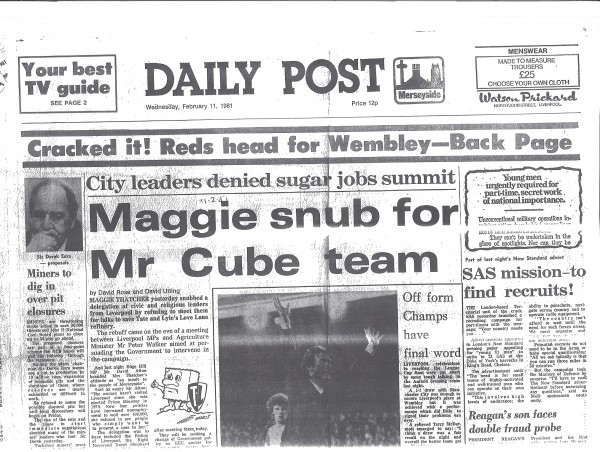
P.S. “If” I’d had this when I did the last blog, it would have been “common currency” by now and seminars would have been conducted (!), but belatedly it’s here to add to the newspaper archives that I’ve built up and which I’m now re-visiting with a passion and a sense of deja vu!
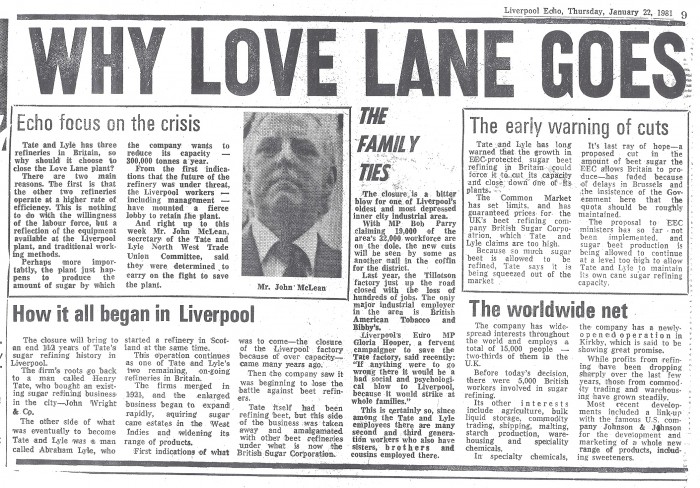
30 years ago TODAY, 90 day Redundancy Notices were served on Love Lane Refinery workers
Written by Ron Noon at 16:03 on Saturday, January 22nd 2011
“The loss of 2000 jobs near the city centre would be more than the end of a business enterprise - it would obliterate a community.” Michael Otterson Liverpool Daily Post July 8th 1976
“The dole queue on Merseyside, already one of the longest in Europe, is about to be stretched farther by the decision of Tate & Lyle to close its sugar refinery in Liverpool.” The Economist 31.1.1981
..............................................................................................................................................................................................................................................................................................
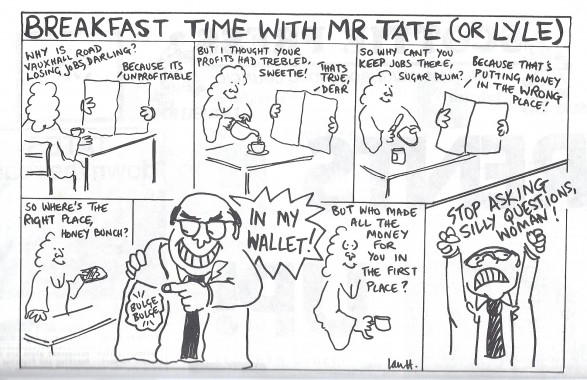 SCOTTIE PRESS, Issue 85, 1978
SCOTTIE PRESS, Issue 85, 1978
Radio Merseyside’s 12 Noon news on the 22nd of January 1981 gave an account of a meeting “at a Liverpool City centre hotel where about 50 union officials were officially told of the closure and the issuing of the 90 day redundancy notices by a Tate & Lyle Director, Charles Runge. There was to be a mass meeting of the work force the next day and the recommendations from the Shop stewards which were to be put to the men and recorded in full by Radio Merseyside, were these:
1. That there will be a unanimous decision by the work force for total resistance to the closure.
2. That all available Trade Union and Political power will be used.
3. That individual letters of redundancy terms be returned to the Shop Stewards.
4. That normal working shall continue until there is a change of circumstance which will warrant a different decision.
The recommendations were read out a second time and carried. “This second performance, the Chairman explained was for the benefit of the representatives of the media who were present” in that hotel, which is just up the side of Lime Street Station and nowadays called THE LINER!
THIS IS THE CHAIRMAN!
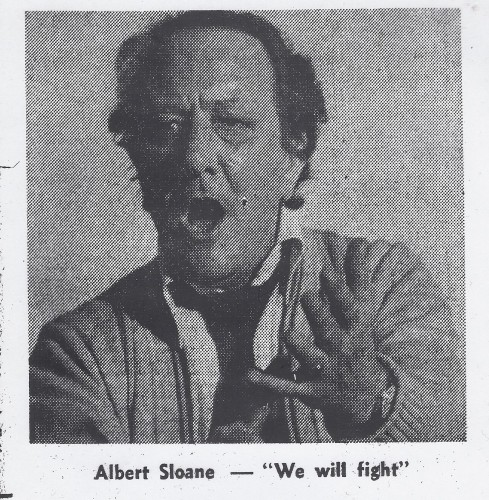
J.A.Watson a former company chemist emphasises just how bitter a blow this closure decision was and how “someone had to achieve in less than three months what they had failed to do in eight years…to pursuade the Government, (as a successor of previous Governments with the same idea), to change its mind”. This was a crisis situation not just for the threatened refinery workers but for the whole of Merseyside which had suffered disproportionately from factory closure after factory closure. A little ditty in the Scotland Road Free Press that was going the rounds went like this: “Redundancies here, redundancies there, Redundancies Redundancies every ****** where!”
The local economy had been reeling throughout the 1970s and the threatened closure of a prominent Liverpool Landmark which had not had a serious industrial relations hiccup since the General Strike in 1926, seemed to portend disaster! “It’s dead now ” said the woman at the beginning of our film. She meant Liverpool not Tate & Lyle and that sense of almost terminal decline and the waste, misery and human suffering of unemployment is surely a message which ought to make us all reflect on the waste, misery and human suffering that is repeating itself again in 2011. Watson was technically wrong about it being an eight year struggle because the first rumours of closure had been in 1971 but effectively the tempo and seriousness of the threats were ratcheted up in 1973 after Britain’s entry into the EEC and its commitment to the “egregious” Common Agricultural Policy” with it’s inbuilt bias towards Continental beet sugar growers rather than the sugar cane supplied by African, Caribbean and Pacific countires to Tate & Lyle’s port refineries. What could be done to change both Tate & Lyle’s mind (remember there was no Tate nor Lyle family member on the board that took the closure decision and local roots and loyalties meant little down in London) and that of Margaret Thatcher’s Government and its Agriculture Minister, Peter Walker?
Peter Hildrew writing in the Guardian the day after the closure announcement quoted BIG JOHN MACLEAN.: “We have been living in an atmosphere of crisis for eight years, but when the blow comes it’s like a sledgehammer in the solar plexus,’ said Mr John Maclean, refinery worker, city councillor, self declared ‘Scouse Nationalist’ and national secretary of the port refineries trade union committee. ‘Part of the structure of the city is being thrown to the wolves in the name of profit, in the name of the Common Market, and in the name of very greedy people. We have kept this place going but for the management we have had only a grudging and almost petulant assent to the idea that it would have gone long ago had it not been for trade union action. They have made the wrong commercial decision in wanting to close their best and original refinery although it should still be needed in future because the Third World is not going to go away. For the people of Liverpool it means the dole, a pathway to nowhere. But in the Commonwealth it means actual lives at stake, they are cutting off the outlet for the sugar output of one whole Caribbean island.” Symbol of a sweet past and bitter future 23.1.81 Guardian
John was a life long socialist and was never parochial in his thinking and views, and so the emphasis he placed on the plight of the cane growers, the suppliers to Tates of what Belinda Coote describes as “the hunger crop” (because of the extent to which so many third world economies were dependent on it for scarce foreign exchange),was typical of a man small in stature but who walked his life like a Giant..
Here’s more food for thought from the same Guardian essay:
The refinery “stands in the heart of dockland, a landmark built on a site where sugar has been refined for over 100 years and clearly visible from the nearby city centre, even in the grey mist which accompanied yesterday’s dismal news”.
That same day the local MP, Bob Parry, stood up in the House of Commons to “ask leave to move the adjournment of the House, under Standing Order No 9”, in order to discuss the 90 day redundancy notices issued to Love Lane refinery workers. The speaker would rule this out but not before the passionate “Rob” Parry evoked the magnitude and seriousness of the decision for his Scotland Exchange constituency and for Merseyside generally.
“The loss of so many jobs “is serious enough but my constituency, in which the refinery is situated has already one of the highest levels, if not the highest level of unemployment in the United Kingdom, certainly well above 50%...The Tate & Lyle company, which made the announcement this morning about sacking these people and throwing them on the scrap heap, also announced that its profits had increased…This is the naked and vicious face of capitalism.” That same day the London Stock Exchange reacted to the closure news and the loss of more than 1500 jobs on Merseyside by increasing the value of the company shares by 12p!
Bob Parry also targeted Peter Walker the Minister of Agriculture, noting his absence and saying that he had a lot to answer for. Bob accused him of having tried to ride two horses in the one race and always supporting the sugar beet lobby.
“It would be interesting if, some day, the right hon. Gentleman would tell us how much sugar beet he grows”.
Just after that comment he was reminded by the speaker that he ought not make that kind of speech if his application were granted! Undeterred Bob pointed out that
the “right hon. Gentleman, according to the feelings of the workers in Liverpool, is a twister and has spoke in this House with a forked tongue”.
Bob had to withdraw the twister tag but still maintained that “the Minister of Agriculture has sold these jobs in Liverpool down the river”.
...............................................................................................................................................................................................................................................
We’d be interested in people’s memories of the 90 day Redundancy Notice period and the three months of struggle to try keep the refinery open. There is more to follow in terms of blogs but input from those who experienced that three month period and have particular stories or accounts of those days would be very much appreciated. I’ll close my blog on this historic day with a reminder of how the giant sugar transnational was very much unaffected by local sentiments and even what local managers thought. One of the last of the Tates to go through “the Sugar Mill” was Saxon Tate and Albert E Sloane said that he was a really nice man who most people respected and liked when he “served his apprenticeship” in the Lane! (Saxy was an old Etonian as a young man but young men whether they were from Eton or not had to do a stint getting to know the process,and their workers experiences.)
Tate & Lyle’s management style was consistent with a global trend that had been evolving since the mid 1970s and it was in the 70s that Lord Jellicoe took over as the first outside Chairman of the company. (1978) The ideological baggage of tradition and paternalism was rapidly shunted to the sidelines when Saxon Tate and the “family spirit” gave way to an outsider chairman and Neil Shaw as group managing director.
The appointment of Lord Jellicoe in 1978 as Chief Executive, was very much at the expense of Saxon Tate, the “family” man who had been expected to take control when John Lyle stood down as Chairman. Jellicoe was an outsider who had only been on the board for four years whereas Saxon Tate had served a long and profitable apprenticeship with the Canadian subsidiary Redpath Sugars. From 1972 he had “for all intents and purposes” run the Tate & Lyle group. The introduction of modern methods of management and “the first touch of professionalism from within the board” was directly attributed to his regime. Consequently the consolation job of Group Managing Director, albeit under a son of the “victor” of the naval battle of Jutland, seemed scant reward for such endeavours. The fates seemed to be conspiring against Saxon Tate when in June 1980 he was given the honorary post of Vice Chairman. It was a poignant moment when his executive functions were all stripped away. An even crueller irony was to follow, with the appointment of the Canadian, Neil Shaw as Group Managing Director. This was clearly a reminder if one were still needed that a new day had indeed dawned for the sugar multi-national.
The first time Shaw had taken over from Saxon Tate was at Redpath when both their stars were in the ascendant, but the former subaltern now overshadowed not only the old Etonian, Oxbridge educated, former Life Guards officer, but also the “family spirit” as well. Along with Saxon Tate, the ideological baggage of tradition and paternalism was rapidly shunted to the sidelines. The following year Lord Jellicoe, as Chairman of a Board of Directors “on which there was, symbolically, neither a Tate nor a Lyle”, made the announcement that Love Lane was to close. “Thus the history of sugar refining in Liverpool was to come to an end at the beginning of 1981, after over 150 years of ‘good and loyal services’, owing to the ‘treachery’ committed by a firm which had been born there a little over a century earlier.” (That was Phillipe Chalmin’s comment in THE MAKING OF A SUGAR GIANT. Ironically what we have witnessed this year with the sale of Tate & Lyle sugars to the American Refining Company is it’s UNMAKING.)
Increasingly global perspectives meant that there was a corresponding withering away of national or local roots or loyalties. Much of that was evident before Neil Shaw took over as Group Managing Director, but under him the metamorphosis from what Chalmin describes as a “family and moral community” into a financial community was completed. Shaw had first been appointed to the Board in 1975 but by the mid 1980s he would assume an unprecedented position of power as the company’s first ever Chairman and Chief Executive.
The concept of the rootless firm without national identity, searching the world for low wages and union free environments is not without some substance but most multi-nationals are still locked by culture, tradition and staff into one nationality. The British based Tate and Lyle has witnessed a number of organisational shifts which severely compromised its historic “paternalistic” image. The end of sugar cane time in Liverpool and the blighting of an inner city community was the most dramatic consequence of that change, and was distinctly emblematic of the “soulless global corporation” that Henry Tate, the entrepreneur and philanthropist had unintentionally bequeathed to the world.
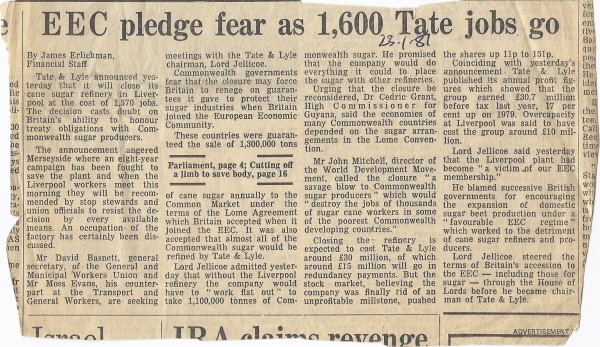
Henry Tate
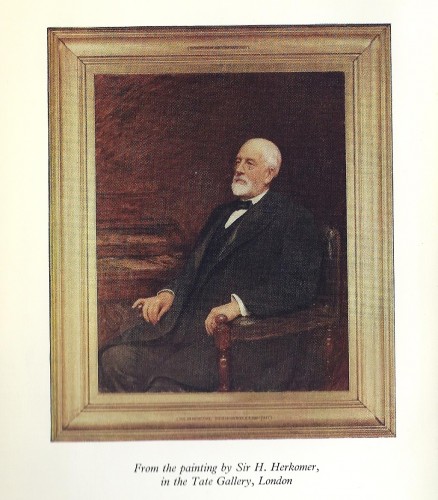
Below Henry is a small picture of the unveiling ceremony on October 3rd 2001 in Hamilton Street Birkenhead and the TATE nearest the blue plaque is the great, great grandson of Sir Henry Tate, Sir Saxon Tate. Next to that scion of the family is Lloyd Grossman!
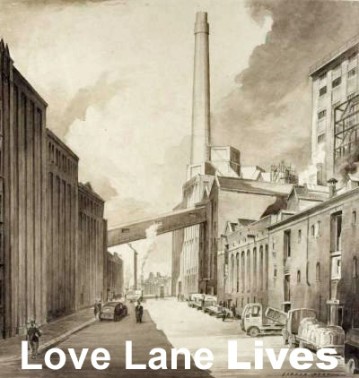
Does anyone recognize these “ladies” from the packin’?
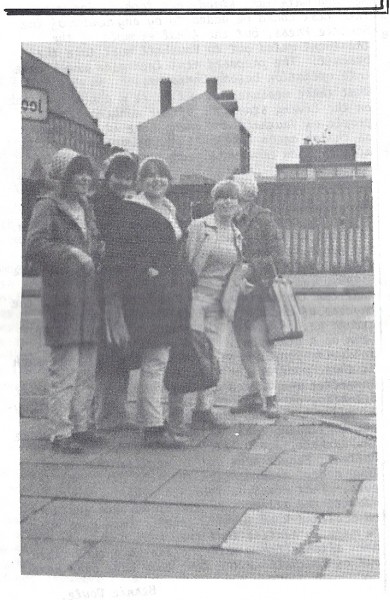
This was an essay written by John (The Scribe as he was affectionately known) in the SCOTTIE PRESS issue 85, 1978
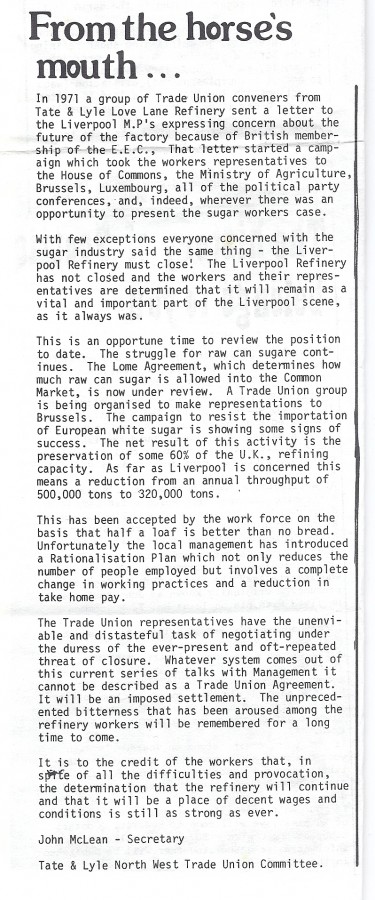
What was Mr Cube’s response to the crisis on Merseyside? Had he kept in training as Lord Lyle had urged back in 1949/1950 when he was so zealous and determined an opponent of nationalisation? Would he be a champion for Liverpool Love Lane?
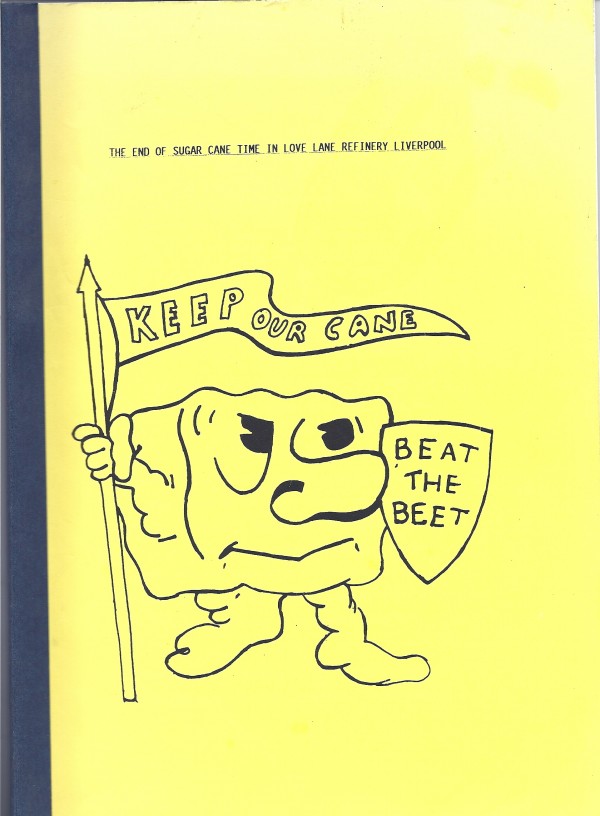
Below are a few pdf files containing contemporary newspaper comment THE DAY AFTER!
Financial_Times_23rd_Jan_1981_and_strong_RECOVERY_for_Tate__lyle.pdfJames_Erlichman_23rd_Feb_1981_1.pdfJames_Erlichman_23rd_Feb_1981_2.pdf
Time for a Blue Plaque for Tate Liverpool!
Written by Ron Noon at 17:54 on Monday, December 06th 2010
WE NEED A BLUE PLAQUE LIKE THEY’VE GOT OVER IN BIRKENHEAD!
.........................................................................................................................................................................................................................................................................................................................................................................................................................................................
“On Friday 26th November 2010 The Liverpool Echo contained this report: “TATE & LYLE is to end its 150-year presence in Liverpool after agreeing to sell its molasses operation. Northern Ireland-based grain trader W & R Barnett will pay £67m for the business, in a deal which will see the 50 employees based at Regent Road, Bootle, and Birkenhead’s North Alfred Dock transfer over.” I asked myself what will there be left to “commemorate” Tate’s Grieving of Liverpool and the answer was/is obvious! We may need the help of the Liverpool Pilot to achieve an ambitious but achievable goal for 2011”
I’ve started off this blog with a question and answer and very little context! Here’s the fuller version of what was written in the Liverpool Echo at the end of last month.
“TATE & LYLE is to end its 150-year presence in Liverpool after agreeing to sell its molasses operation. Northern Ireland-based grain trader W & R Barnett will pay £67m for the business, in a deal which will see the 50 employees based at Regent Road, Bootle, and Birkenhead’s North Alfred Dock transfer over.
The proceeds from the sale will be used to reduce Tate & Lyle’s net debt. Completion is conditional on employee consultation but is expected to occur in the next few weeks. That will be the last of Tate & Lyle’s operations in Merseyside, which has been closely associated with the company since Liverpool shop owner Henry Tate made his first venture into sugar cane refining in 1859. Later he set up Henry Tate & Sons and the Love Lane Refinery in Liverpool was opened in 1872. A century later, it closed with the loss of 1,570 jobs, followed by a syrup making plant in Bootle which shut in 1984. The molasses division also has its roots in Liverpool. A Liverpool-based cattle feed importer, Marquis, was founded in 1910 and soon began importing molasses – an ingredient used in cattle feed. The company moved to London in 1925 and became United Molasses before it sold its Liverpool refinery to Tate & Lyle in 1937. The sugar giant bought the entire company in 1963. In the year to March, the molasses operations had external sales of £228m and made an operating profit of £13m in the year to March, and had gross assets of £81m at that date.Tate & Lyle announced in July its intention to find a buyer for the remaining businesses within its sugars division. Tate & Lyle chief executive Javed Ahmed said: “Tate & Lyle’s clear priority is to grow its speciality food ingredients business, supported by cash generated from bulk ingredients.”
Those of you who have read the recent blog on United Molasses and “Rumbullion” will realise that the ECHO is guilty of a few errors including what we in the history trade label “chronological inexactitude”! That’s a long winded way of saying that facts are sacred and opinion is free and that reporters need to do their homework and quote accurate dates! Not only is the full name of the cattle feed importers shortchanged, (it was Marquis,Clayton), but Michael Kroyer Kielberg the “Liverpool Dane” I referred to in a recent blog, went to work at their office in 4 Chapel Street in 1907! In June1938 (not 1937 as quoted in the Echo report) Kielberg who was “Mr UM” and a director of Tate & Lyle (one of the first along with Lord Birkenhead from outside the Tate & Lyle families) sold Macfie and Sons which UM had acquired in 1936, to Tates. “The Macfie factory was closed and its capacity…was transferred to Love Lane”. Phillipe Chalmin
Given that context and background, who can claim that this final leaving of Liverpool has come out of the blue?, After the July 1st announcement that the company bearing the name of the “Sugar Magnate” on the blue plaque in Hamilton Street Birkenhead was selling its European sugar business to the American Refining Company, this latest announcement was sadly all too predictable. As an inveterate sugar buster I noted this Reuter source on 23rd of August 2010
“UK based Tate & Lyle would sell its stake in the Nghe An Tate & Lyle Sugar Company in Vietnam’s central region, ending its 14 year presence in Vietnam, a company representative told Planning and Investment Minister Vo Hung Phuc last week. Tate & Lyle is a global provider of distinctive, high quality ingredients and solutions to the food, beverage and other industries.”
That reference to global provider contains no reference whatsoever to sugar, and so molasses was clearly next in line! Phillipe Chalmin’s excellent book on THE MAKING OF A SUGAR GIANT: TATE & LYLE 1859-1989 is now decidedly historical. The company logo of Tate & Lyle is now blatlantly ANACHRONISTIC and past it’s sell by date in terms of its business links with the city of Liverpool. A more appropriate title for a new edition would be THE UNMAKING OF A SUGAR GIANT! That said Henry Tate the former grocer who became not ony a Sugar Magnate but Britain’s Rockefella (money made from white not black gold) is at the moment only commemorated Blue Plaque style in Birkenhead! He deserves commemorating over here on our side of the river as today’s Daily Post and Echo in their letters columns made clear:
Letters to the Editor
Daily Post letters
Dec 6 2010 Liverpool Daily Post
Time for a blue plaque for Tate
THERE is an English Heritage blue plaque on the front of 42, Hamilton Street, Birkenhead, home of the Wirral Methodist Housing Association, which reads “Sir Henry Tate 1819 to 1889, Sugar Magnate and founder of the Tate Gallery traded here 1851-1861”.
His first trading experiences were, of course, in groceries and the fine building just off Hamilton Square (said to be second only to Trafalgar Square for the most Grade I listed buildings in one place in England), although fitting testimony to those early successes, is on the wrong side of the river, to record and reflect the subsequent achievements of a global sugar dynasty that was made in Love Lane, Liverpool!
In the wake of Tate’s decision to end its molasses operations on Merseyside, following on the July announcement to sell off all of its sugar business, what is the equivalent to blue plaque status on my side of the river?
Love Lane Lives and the reminiscences of the boys and girls from the white stuff live on in the form of films and recorded interviews on my website of that name, (www. lovelanelives.com) but surely there is now an even more pressing case to have a Blue plaque, and perhaps a community based museum, on the site of the former “Sugarland” which, although devastated by the 1981 closure, has phoenix- like risen from that waste and dereliction to become a permanent reminder that community is defined and lived by people not politicians and businessmen.
If we had some ghostly interviewing techniques available, I think ’Enery would go along with that sentiment and our Blue Plaque campaign.
Ron Noon
..................................................
Echo Letters
Liverpool Echo letters, December 6 2010
Dec 6 2010 Liverpool Echo
THERE is an English Heritage blue plaque on the front of 42 Hamilton Street Birkenhead, home of the Wirral Methodist Housing Association, which reads ‘’Sir Henry Tate 1819 to 1889, Sugar Magnate and founder of the Tate Gallery traded here 1851-1861’’.
His first trading experiences were of course in groceries and the fine building just off Hamilton Square, (said to be second only to Trafalgar Square for the most Grade I-listed buildings in one place in England),
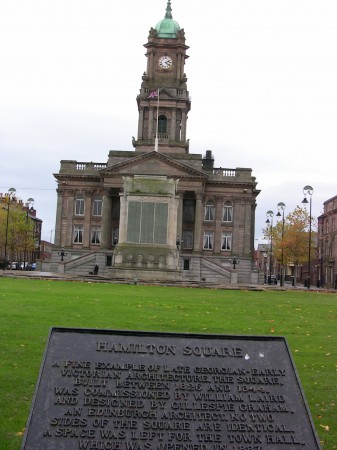
although fitting testimony to those early successes, is on the wrong side of the river, to record and reflect the subsequent achievements of a global sugar dynasty that was made in the more romantically named Love Lane Liverpool!..............
So to conclude a hastily compiled blog, the agenda for 2011 is to work with Tony McGann and the Eldonians to ensure that on the site that so many girls and boys from the whitestuff dedicated their working lives, a blue plaque is a major priority for 2011.

..............................................................................................................
APPENDIX TO DECEMBER 6TH 2010
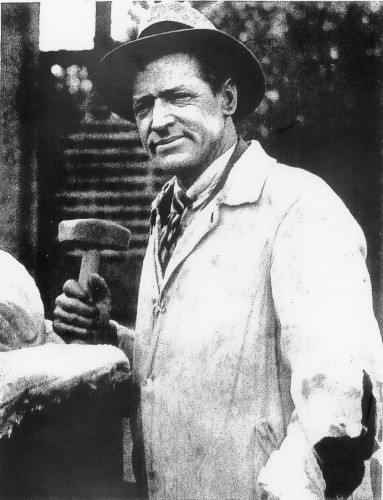
The guy above was one of the first stonemason’s to work on the Liverpool Anglican cathedral site and his autobiography ROLLING STONEMASON, published in 1936 contained a chapter entitled THE SECRET IN THE STONE. It ought to outsell Harry Potter but in 2011 the book could be re-published. I went over to Heswall today to place some red roses on his PLAQUE which is in the cemetry of St Peter’s Church opposite the BLACK HORSE public house.
Fred was born in Boston Massachusetts on December 6th 1871 but reared in Liverpool. I placed this “dust jacket” account of ROLLING STONEMASON: AN AUTOBIOGRAPHY alongside the flowers on Fred’s stone. Happy 139th birthday Fred.
“Among the sand dunes of the Wirral Peninsula, overlooking the estuary of the Dee, Mr Fred Bower lives in a hut he built with his own hands. He is well known at the local pub, and in some of the near-by villas, where the small children of Liverpool business-men look to him to play games, to write verses, and to carve gnomes and squirrels and fairies for them. But Mr Bower has a full, adventurous life to look back upon and he has written it in his own vivid and racy idiom. He comes from a family of hereditary stonemasons in Dorset, and though he was born in America and brought up in Liverpool he has practiced the stonemason’s craft in three continents, and combined it with such diverse activities as prospecting for gold, and working for the Labour Movement. The story of his life is the story of an ancient craft adapted to modern urban circumstances, and it is closely interwoven with the early years of Tom Mann, Jim Larkin, Philip Snowden and many other notabilities. He has been a prospective candidate for Parliament and worked as a fireman on a tramp steamer, he can tell you all about that dreadful pre-war ‘bloody Sunday’ in Liverpool, and all about the secret message to posterity which he buried in the foundations of Liverpool Cathedral. This is an autobiography as rich in character as the man himself.”
Love Lane’s Memory Lane
Written by Ron Noon at 05:12 on Friday, November 26th 2010
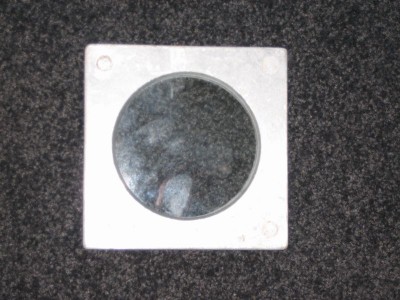
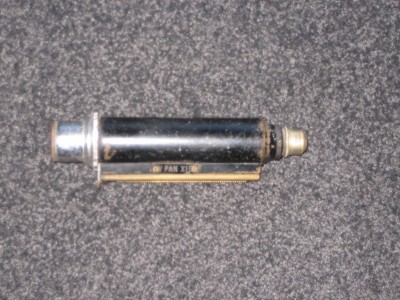
“It was a hot August day and I remember being on the Sweetland Press floor in the heat and the humidity and thinking how bad the smell was. It made me feel ill and I didn’t think I would be able to stand it. After about a day or so I ceased to notice it. How strange that we easily get used to things.”
That is an extract from the account that Mike Greenall provided of his early days as a Process apprentice in Liverpool’s historic Love Lane where working conditions were clearly at variance with the refinery’s romantically sounding name! After he left school in July 1965 Mike started his apprenticeship in the refinery where he would be mentored by pansmen like Bobby Austin. In the so called “post industrial” era the term “apprenticeship” has sometimes seemed a misnomer for what skilled workers like Mike and many others like him regarded as a real and rewarding technical education. His apprenticeship was designed to provide training for “young men” in all aspects of the processing of sugar from the raw, which was ferried by wagon from the Huskisson dock, to the various refined products that Tates were famous for. Mike has informed me that the ultimate goal of the course was to train people to be the next generation of Pansmen, Chargehands and Foremen.
I’ve made reference many times in these blogs to the fact that sugar is not as many of its vested interests would claim NATURAL and certainly there have been no sightings of sugar crystals growing on mother nature’s plants in recent times even in this era of genetically modified crops. Therefore the making of SUGAR is very much man made and industrial, an essentially purging,and laundering process in highly “chemicalised” refineries or as W.A. Aykroyd called them “Temples of Applied Science”. There is a great deal of skill involved in the processes and methods deployed and I’m going to reproduce an account from a SUGAR book published in 1949 and edited by Anthony Hugill.
“The boiling of sugar is the work of an expert, and under present conditions, it takes three years for a panman to reach full proficiency. The degree of proficiency required and the size and type of pan used depend very much on the grade of sugar which it is desired to boil. In the majority of cases the aim of the panman is to boil a pan of sugar without making ‘false grain.’ The usual method is to draw into the pan a small charge of liquor, and boil it until it reaches the correct degree of super-saturation, which it is part of the panman’s skill to determine. The thickened charge is then seeded with a little caster or icing sugar which brings out a large number of ‘points’ or tiny crystals. This process is known as ‘graining’ and is followed by the addition of more liquor. After graining the object is to continue boiling with the gradual addition of more liquor until the pan is full, in such a way that the original ‘points’ grow until they are of the right size. The appearance of any further points at a later stage in the boiling is known as ‘false grain’ and must be avoided as it will spoil the regularity of the ultimate sugar…In the boiling of small crystals such as granulated sugar, an experienced man will in most cases accomplish his object and turn out a pan of sugar of fairly regular size crystals.” Pp.s 35.36.
This was the world that 16 years later Mike entered and there is already a blog of Mike’s experiences dated June 10th 2009 on our site. Readers may be interested to update themselves with this because what I’ve reproduced below is PART TWO of his apprenticeship days! P2 was sent to me earlier on this year and I’m hoping for P3, P4… One consistent theme it seems will be Mike’s fondness for tea drinking, a good cuppa char, which on a Love Lane Lives website is a fact that perhaps I’ve taken too much for granted! More about TEA after this:
“Hi Ron, here is a bit more of what I remember of my time at Tates…Some of it might be incorrect, but I’m sure there are people you know who can correct any errors!
As new Apprentices our first port of call after our induction was two weeks with Huskisson Transit Co. This was the sugar berth at Huskisson Dock and the 100,000 ton silo across the road, now virtually derelict, though still in existence. During our time there we spent time on the ships watching the unloading process, though we were not allowed to take notes whilst on the dock or the ships in case we upset the Dockers, as if they thought we were writing anything down, they were quite likely to walk off the job!
Modern Health and Safety would not be impressed as to how we got to the docks. We would make our way round to the raw sugar unloading bay on Vauxhall Road and scrounge a lift off one of the drivers hauling the sugar up from the dock, one of us would sit on the passenger seat and the other would perch on the engine casing in the cab. The operation of the dock and silo was fairly straight forward. The ships hold would be opened up and the cranes would commence unloading the contents which was in bulk and unloaded using grabs. The crane then swung round to deposit its load into a hopper which fed onto a conveyor system. I think there were four cranes to each berth. The conveyors fed up over the Dock Road and into the top of the silo control tower, in which was the control room, from which the operation of the conveyors in and out of the silo was controlled. The sugar was then fed by another conveyor system, up and along the top of the silo in an enclosed tunnel, this conveyor fed onto a shuttle band which moved on a railway track up and down the length of the silo, evenly depositing the sugar inside. It was quite impressive to stand in the silo and watch the sugar cascading down from the roof to form big mountains on the floor of the building.
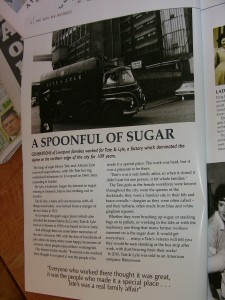
Great pictures from a Liverpool Echo book on WORK. Who are the blue turbanned ladies?
The sugar was withdrawn from the silo by means of an underground conveyor system. The sugar was allowed to feed onto this conveyor by a system of louvres which, when opened, allowed sugar from whichever part of the silo was required, to feed onto this band. It was then conveyed up into the tower where it was weighed in Servo Balans weighers for Customs purposes, that is, to calculate the tax to be paid, before being fed into the delivery hoppers. The bulk sugar wagons would pull up under the hoppers to be filled and weighed then make their way up to the factory, usually with small boys hanging onto the back! If the driver saw them, he would stop and chase them, but by the time he got in the cab and got moving, the boys would be hanging on the trailer again!
The wagons would park up in Burlington Street alongside 149 shed, which was another raw sugar storage facility, rather like the dock silo in use though a lot smaller and looking from the outside like a large warehouse type shed. While they waited, the drivers would spend their time polishing their Cabs; they were quite proud of their appearance and always had clean tractor units. As they were required, they would pull round to the raw sugar intake to unload. The Wagon would pull into the unloading bays. On each side of the vehicle set into the ground and running the length of the trailer were heavy metal grills covering large hoppers. The trailers were divided into two open topped compartments, inside each compartment was a V shaped centre section, which caused the sugar to run out when the compartment was opened. Along the bottom of the compartments on both sides, was a compressed air operated door, rather like the tailgate of a tipper truck. The plant operator would hook up a compressed air line to the rear of the trailer and open the doors to allow the sugar to run under gravity into the hoppers set into the ground. In a matter of seconds the trailer would be empty, the doors would be closed, again by the use of compressed air, and the wagon would be on its way back to the dock for another load. As it left, the next vehicle would be on its way in to discharge its load.
Beneath the Hoppers was a system of conveyors which carried the sugar from the Intake up into 149 shed and along the upper part of the shed wall alongside Burlington Street, up a bridge over the canal, to the Raw Sugar Silos. Inside 149 Shed were a couple of machines built on the gantry carrying the conveyor called Throwers. These machines were used to literally throw sugar into the shed for storage, the sugar would be shot out of these machines up to the roof of the shed where it would hit baffle boards then it would fall back to form large mountains of sugar on the shed floor. This sugar was used in the event of a stoppage in the flow of sugar from the docks. The shed held approximately 10,000 tons.
There were four Raw Sugar Silos which were filled up during the course of the day so that by five oclock, when the drivers knocked off, there would be enough sugar stockpiled to keep the refinery going till they started hauling sugar again the next day. The sugar left the Silos via a system of louvers feeding onto steel bands which in turn fed onto a conveyor up another bridge, over Burlington Street this time, it passed over a Band Weigher which recorded how much sugar was going into the refinery and then entered the Melt House to begin the process.
We spent a few weeks with the Plant Operators learning the running of the Intake and the Raw Sugar Silos, though I have to admit a lot of the time was spent in the Rest Room drinking tea!”
................................................................
Whoops! I seem to have encountered another technical glitch because I just tried to upload the piece I’ve put together on TEA and also the two pictures that Mike sent me. Right in the centre of this screen appeared the message: “This operation has been cancelled due to restrictions in effect on this computer. Please contact your system administrator.”
I don’t know who that is!!! All I know is that I’m in a lovely old public library in snowy Sunderland which I’ve been using all this week since my wife and I rushed up Cannyland last Friday afternoon to attend to the needs of my wife’s mum who went into hospital that day. She’s on the mend which is great news but I’ve only been able to function on the web, because of Kayll Road public library which is right opposite Sunderland Royal Hospital. Now it seems even these invaluable institutions are subject to even more Government cuts and have glitches similar to those experienced in my study or University Library back home in Liverpool. I’m getting kicked out in ten minutes because the library is going to close! (I queued outside of it at 9.25 yesterday morning before the snow began to fall and only realised a quarter of an hour later that it was closed on a Thursday. Boy did I experience withdrawl symptoms not gaining access to the web and my sugar files!) Anyway I’ll just upload what I’ve already written and come back later after this afternoon’s hospital visiting time.
TO BE CONTINUED
Here I am back in Kaylle Road which was the library my wife used when she was a child, and I’ve now had the technical problem resolved and so hopefully the pictures that Mike gave me are reproduced both in the summary of this blog and also in the main body of the text.

What was I “saying” about TEA?
“The first sweetened cup of hot tea to be drunk by an Englishman was a significant historical event, because it pre-figured the transformation of an entire society, a total remaking of its economic and social basis.” That’s a lapidary comment by Sidney Mintz, the doyen of sugar studies, in his seminal book Sweetness and Power. (1985) Outside my circle of sugar centrics this loaded argument would perhaps be difficult to grasp. It was for me initially but it is in fact key to understanding how this now taken for granted everyday commodity revolutionized the modern world. Mintz, without using the term “Sugar Revolution” used by Australian writer Higman, urges readers to “struggle to understand fully the consequences” of precisely that phenomenon and “other kindred events” of early modernity, “for upon them was erected an entirely different conception of the relationship between producers and consumers, of the meaning of work, of the definition of self, of the nature of things.”
Sugar, just like the G word, globalisation, (is it an s or a z?) has come from nowhere to be everywhere and its ubiquity provides a great example of how a taken for granted everyday commodity has a complicated social history, that provides good insight into the drivers that still operate in the world economy today. Sugar is a great example of an intensely political product that links the story of agriculture and agribusiness from the days of the plantation and the yoking together of field and mill, to the inexorable logic of world food markets today.
But where would sugar be without tea? Reflect on this extract which I’ve taken from an Open University Social Science Foundation year text which I taught back in the early 1990s. It relates to FOOD FOR THOUGHT.
“Tea was first developed in China, where it was called ch’a (from where we derive our own word ‘char’). In AD 805 a mandarin, Lu Wo, wrote The Cha Ching (The Book of Tea) and by that time tea was part of the internal Chinese tax and finance system. By 1200 it was a major item in commerce between provinces and by 1400, Hunan Farmers had begun to specialise in its production. It was still unknown in Europe.” It was not until the 1650s that tea was brought to Britain and it did not catch on at first. It was only when Charles II married the Portuguese Princess Catherine of Braganza, that things began to change. (1662) “She arrived with her dowry, which was Bombay and Tangier…and her tea-chests. The king neglected her and she found solace in tea. As a bribe, the directors of the East India Company gave her regular presents of tea; the Court ladies imitated her, and the taste for tea spread to bourgeoisie housewives like Mrs Pepys and thousands like her. However at 50 shillings a pound, tea did not spread far beyond the Court: tea drinking and brewing became a high status ceremonial which only the richest and most refined ladies, allegedly understood. Throughout the eighteenth century, the cost of tea fell and the taste for it spread. The bourgeoisie was soon commenting on the habits of tea drinking servants, who aped their betters.”
Rowling, N., 1987, Commodities: How the world was taken to market
People did not always crave sugar. For that to happen Roberts a recent writer on Globalisation argues “a luxury had to be converted into a necessity, a taste had to be created”. The taste for sweetened tea and other exotic tropical luxuries was rapidly acquired and what had been a luxury only indulged in by the rich and privileged, (why were there locks on tea chests?), became an essential part of proletarian diet during the classic industrial revolution era.
As Jim Walvin points out in his beautifully written book Black Ivory “tea brought from the eastern extremity of the world, and sugar brought from the West Indies, and both loaded with the expense of freight and insurance…compose a drink cheaper than beer”. I was tempted last year to use this as an exam question for my final year students on my GLOBALISATION IN HISTORICAL PERSPECTIVE course but for some reason I resisted!
Part of the explanation for this surge in tea consumption (how many think that tea drinking has always been a quintessentially English phenomeon?) was to do with the lowering of the tea duties in 1784. The result was that tea drinking in Scotland became so popular that it dislodged the “local commitment to malt liquor”. The history of sugar as has been painstakingly argued on this site, does not go back to the orgins of the biosphere as some Affiliation Biased Scientists suggest. It’s much more recent phenomenon, (albeit at least 500 years), and it links in with the chronology of capitalism.
That “fact” is an important reminder that globalisation is much more extended in its chronology than the last quarter of the 20th century and the rhetoric used by “extreme globalisers”! There is often too much emphasis on discontinuity and so the story of sugar “capitalism’s favoured child” is a “healthy” reminder of the continuing and recurring themes behind commodity production and production for exchange. The G word demands fitting into a longer historical perspective and the tea phenomenon linked in inextricably to the leavening out of many exotic tropical luxuries with its intense sweetness. Then and now it is a narrative of interconnectedness and to use the buz phrase in academic circles, “time/space compression”, albeit in a different epoch and context to that when the “sailing ships” of Liverpool and Boston moulded the world’s Zeitgiest. James Walvin’s “wee late eighteenth century story” of globalisation and “skeins of interconnectedness” with malt liquor in Scotland “downsized by TEA is a real cracker. It highlights how products from opposite sides of the globe were quaffed down in hot liquid solution in late eighteenth century England. There’s nothing trivial about a tea break Mike!
.........................................................................................................................................................................................................................................................................................
*My debts to Professor Doreen Massey and her social science foundation year course team at the Open University which I was proud to teach on for many years, are gratefully acknowledged. I never realised when I had my own OU tutees on a SATURDAY morning that I would subsequently become addicted to the story of sugar in a much more intense way than was demanded by the course team. But that was down to Albert and John who had nothing whatsover to do with the OU but who would nonetheless have loved the idea of largely mature “second chance to learn students” turning up on a Saturday morning to deepen their knowledge of THAT THING CALLED SOCIETY!
................................
Finally here’s an extract from The Sugar Cane Industry: An Historical geography from its origins to 1914 a book written by J.H. Galloway, University of Toronto.
“The decline in the price of sugar permitted people to assuage their taste for sweetness, but it also had a sombre side. The industrial revolution created a new working class and gave it a new sugar laden diet. Industrialisation drew people from the countryside, from their gardens and fields, woods and streams which had provided their food, to the tenements and back to back houses where they had to buy what they ate. The long hours spent tending looms, mills and other machinery, by women as well as men, meant that there was less time for preparing meals at home. Food had to be cheap, easily served and it was often insufficient. One response of the English working class to this situation was to incorporate into its daily diet many cups of sweet tea, a calorie-laden stimulant that warms the body, revives the spirits and blunts the pangs of hunger but does not nourish. A second response was to abandon the careful cooking of traditional dishes in favour of cold or quickly heated, store bought, factory processed food. The ‘jam buttie’, nothing more than factory made jam spread on a slice of factory made bread, is a sugar rich, high calorie ‘convenience food’, quickly prepared and quickly eaten. Sidney Mintz (1985: 180) has seen a dark side to this transformation of the English diet and has offered the hypothesis ‘that sugar and other drug foods, by provisioning, sating - and, indeed drugging - farm and factory workers, sharply reduced the overall cost of creating and reproducing the metropolitan proletariat’. To one exploited group associated with sugar - the slaves who for so many centuries cultivated the cane - Mintz would now add another: THE CONSUMERS..”
Our film was shown at the Tate three years ago LAST NIGHT, but BIG SUGAR loves TONIGHT best!
Written by Ron Noon at 15:55 on Sunday, October 31st 2010
“Historian Ron Noon’s decade-long obsession with the Liverpool sugar industry led to the making of the film Love Lane Lives: The Boys and Girls from the White-stuff, which is to be screened tonight at the Tate.” That was Vicky Anderson’s take on my “sugarcentricity” in an essay she wrote in the Liverpool Daily Post on October 30th 2007. All the hard work and effort that Leon Seth, Maggie Skilling and I had invested in the project, culminated in a great night three years ago last night! TONIGHT as I write these words I am keenly aware of other more taken for granted anniversaries and the fact that HALLOWEEN in the twenty first century has become in North American a $4 billion sugar festival which in the words of another film maker, Brian McKenna, has made tonight “a marketing dream for the sugar industry”.

Sadly since this picture was taken Tommy and Billy have passed away.
.......................................................................................................................................................................................................................................................................................................
More about Brian McKenna and his amazing 2005 Canadian Broadcasting Corporation film BIG SUGAR, later.
Our more modest film funded by the Heritage Lottery and not CBC explores how Henry Tate became Britain’s Rockefeller not with oil but white gold, and how after 109 years of refining in the Lane, and the devastation of the Vauxhall community just north of the city centre, the phoenix eventually rose from the ashes in the guise of the Eldonian Housing Cooperative! This model of community-led sustainable urban regeneration received the accolade of a World Habitat Award in 2003. When I mentioned the award to Albert just before introducing him to the main man behind the Eldonian project, Tony McGann, he retorted bitterly that a WORLD UNINHABITED AWARD would have been more fitting in describing the HOLE that Tate & Lyle had left in the Vauxhall Community with the closure of Henry Tate’s mother plant. Our film also captured footage of the historic 25th anniversary re-union of the Tate pensioners at the Eldonian Village in April 2006 and set the scene for our recurring theme of LOVE LANE LIVES LIVE ON. So three years ago YESTERDAY there were three very excited but very anxious sugar project people just hoping that everything would go right on the night!
I’d gone as a “fan” in 2000 to a Jimmy McGovern film premiere of LIAM, but while I know that the slightly younger brother of one of my best mates is a brilliant scriptwriter, (albeit a pretty mediocre footballer compared with the once lightning fast and jinky Joey), I’d never thought at the start of the new millennium that I’d ever be involved in the scripting, “making” and celebrating of a film, especially one about SUGAR! It turned out to be a wonderful evening and drinks of sugar in solution were quaffed back by everyone it seemed but me. I had to introduce the film and did not want to be under the influence of the fermented stuff so I just ratcheted up my sobriety. I thought this is the Tate and what a supremely ironic venue it was for a film focussed on the former SUGARLAND just north of the city centre. This was the setting of a Modern art gallery on the Albert Dock named after Henry the 19th century sugar baron, and well stocked on the night with wine and nibbles and the “craic” of over 100 people. I belatedly discovered that the only way to relax a little before the “curtain went up” was to go to the back of the building and look out over the historic and world famous River Mersey and see the flickering lights from Birkenhead illuminate where the great ships had made passage. I thought about another Henry, a mid 20th century seaman who was my dad and my wonderful mum Julia and what would they have thought if they’d been “at ar Ronnie’s opening film night”! My dad had lived in Burlington Street in the heart of the Love Lane community and had gone to school at Our Lady’s Eldon Street so there were a couple of circles being completed on OCTOBER 30TH 2007.
Anyway I need not have worried so intensely because as the pictures below show it was a great night and LOVE LANE LIVES LIVE ON.
Shock, horror in the last hours of Halloween 2010! The technology of placing the photographs is letting me down. It’s got to be the technology. It can’t be me! I’ll have to leave this space and come back to it with the missing pictures and move on to Brian McKenna! (Anyone more technically minded might be interested to know that this is the frustrating message that is threatening to send me into Basil Fawlty rant mode! [“This error (HTTP 500 Internal Server Error) means that the website you are visiting had a server problem which prevented the webpage from displaying.
For more information about HTTP errors, see Help.] SEE HELP!!!!
(Twenty four hours on I’ve added the pictures below. It must have been the technology!)

That’s Christy examining our colourful Love Lane Lives Poster

That’s ar sugar gang with Jimmy Mc
 {
{
Our talented young film director, Leon Seth

Dave McGowan and Bill
..............................................................................................................................................................................................................................................................................................................................................................................................................................................................
Big Sugar is a two part documentary made by CBC for 2005 and scripted, directed and narrated by Brian McKenna. It explores the sinister history and contemporary clout of the world’s sugar barons! I used clips from it with my students a couple of years back and most found it compelling viewing not least because of the way it reveals how so many today are “slaves to a sugar based diet” and also because of McKenna’s use of dramatic reenactments of sugar’s blood stained past. Today it would seem there is a different kind of “slavery” being fought and there is no doubt in my mind that the Big Sugar diet enslaves the poor. “Payola-sweetened scientists and politicians deny Big Sugar is behind another form of sugar slavery: the soaring consumption of pop and sugar junk food, which has created a worldwide obesity crisis.” How “natural” is that? Why have we got a new word in the lexicon called GLOBESITY?
I tried to answer that question in public yesterday. The reason for the public venue was very much to do with Black History month and how National Museums Liverpool have held a series of events including performances, talks, music, dance, craft activities across several venues to promote and celebrate Black people’s contributions to British society, and to foster an understanding of Black history in general. So yesterday at the Anthony Walker Education Centre inside the wonderful International Slave Gallery pioneered by National Museums Liverpool, I gave a talk about Liverpool, sugar and slaves and tried to plug the present into the past and the past into the present. It was a great audience and in the question and answer session we ranged over a wide range of issues that demonstrated that sugar and slavery is tragically not just an historical theme, (the work of Father Hartley in demanding justice and fairness for his former parishioners used and abused on the sugar bateyes of the Dominican Republic), but also the importance of harnessing the formidable pester power of the children to fight back against the drug like dependency on this “pimp product” that is sugar! There is clearly much to be done in that area but what has been achieved at Trinity School and at Hillside is a clear demonstration of how new generations of “sugar busters” can be educationally equipped.
The teaching room I was in is of course dedicated to that wonderful young 18 year old student Anthony Walker, who was brutally murdered in 2005 in a vicious racist attack in Huyton. His remarkable mother Gee Walker, his father, Steve Walker, his two sisters and one brother.have had to cope with that devastating hole in their lives and hearts, Racism kills and demeans us all and the frictions and tensions in times of economic turbulence and insecurity are clearly exacerbated. Education, Education, Education is a sad old refrain without Resources, Resources, Resources, but it has never been more important than it is now. Education for citizenship, education because it is intrinsically good of itself for itself and not just because it services the world of work or WOW as it is mimicked in some educational institutions that ought to know better, has never been more vital to the health of our society and polity than it is today. The story of slavery depicted in the galleries and teaching rooms of National Museums Liverpool is only one part of that investment in education that is intrinsically good of itself for itself. Tragically it too will be subjected to cuts in funding and resources. When will some politicians ever learn the lesson that the Edinburgh Review of the early 19th century exhorted? “We either build more schools or we build more prisons”. Precisely.
............................................
More photographs of our FILM NIGHT at the TATE.

There’s Jim at 97 years young with his son and daughter in law

Hey my name is Jim Smith. Can anyone tell me how I will get back to the future? I’ve heard a rumour that my firm MacFies is going to be taken over by Tate & Lyle ***

Albert and Christy.

The guys testing the sugar in solution with Bill supervising!
http://www.lovelanelives.com/images/uploads/TateandLylefilmlaunch5.jpg
Amy Trego and smiling on her right is Whiz kid Warren Keith who subsequently set this web site up

Leon and Jimmy with Maggie and Andy in the background.
..........................
*** What a crackin’ photograph of Jim driving a MacFie’s wagon. Jim started off at McFies with horses and this picture has to be Jim in his early to late 20s because it was not until 1938 that Tate & Lyle bought “the oldest of the British refineries, Macfie and Sons of Liverpool from United Molasses”. The Merton Grove company in Bootle was a Macfie subsidiary. Is there anyone out there who can give me any more information and memories about the Bootle branch of the sugar industry? I know it was a manufacturer of syrups but pictures and stories as always would be very welcome.
Molasses, United Molasses and RUMBULLION!
Written by Ron Noon at 13:52 on Monday, October 04th 2010
FIRST OF ALL THESE ARE THE INITIAL REMARKS ON A BLOG I DID JUST OVER THREE MONTHS AGO:
“The opening comment on our Love Lane Lives film is from a woman who declared shortly after the refinery closure in April 1981, ‘it’s dead now’! She meant Liverpool was dead, not Tate & Lyle but I wonder what she might have said about today’s historic announcement from Tate’s London Sugar Quay headquarters, that the once biggest sugar processor in the world, is literally selling off its sugar business? It will be left with “splendid” Splenda, the low calorie sweetener made from sucralose, and a substantial ethanol and industrial food ingredients business, which CEO Javed Ahmed emphasised as accounting for the majority of its annual sales and profit. If we had some ghostly interviewing techniques what would Henry Tate and Abraham Lyle make of a new company diet bearing their illustrious names but premised on eliminating sugar cubes and golden syrup?
In popular parlance Tate’s sugar cubes and Lyle’s golden syrup have gone together like bangers and mash but the newly appointed CEO who took over from Iain Fergusson at the end of last year has clearly decided to break away from company traditions and popular perceptions of its brand image. He does not see ‘Value added’ in the sugar refining industry, the brand with which Tate & Lyle is synonymous, but which historically has always been associated with the volatility of the commodity business.”
Tate and Lyle acquired United Molasses (UM) in 1965 but it had been coupled with molasses long before it bought the UNITED brand. At the very least in a roundabout way it was associated with the volatile and explosive nature of a liquid commodity comprising three letters, which was spelt by placing an R in front of UM! Sugar’s most obvious by-product was of course RUM and the Australian sugar and rum company Bundaburg was at one time in Tates portfolio, before they sold it off, (along with the iconic BUNDY RUM), in 2000.
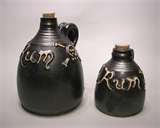
Where does the word RUM come from? There are those who argue that it comes from the latin term for sugar, “saccharum officinarum” but I prefer the historic English slang word “rumbullion” as its source. According to W.R.Aykroyd in Sweet Malefactor, “rumbullion” was a word of Devonshire origin meaning tumult and “was shortened to rum a few years after the hellish liquor was first manufactured”. A writer in Barbados in 1651 expressed it this way:
“The chief fuddling they make in the island is Rumbullion, alias Kill-Devil, and this is made of sugar canes distilled, a hot, hellish and terrible liquor.”
The website of the West Indies Rum Distillery provides a graphic account of the volatility of that mid 17th century world when as we know, an island smaller than the Isle of Wight inaugurated THE SUGAR REVOLUTION. (Have a look at the December 29th 2008 blog: Liverpool, the Bajan sugar Revolution and the era of the Sugar Standard.)
“Just 4 years later, in 1654, the General Court of Connecticut (New England) ordered the confiscations of ‘whatsoever Barbados liquors, commonly called rum, kill devil and the like’. This confiscation was to protect the distilleries in New England and is the earliest known recognition of Barbados rum in the colonies. Kill Devil or Rumbullion was noted as rough and unpalatable and could overpower the senses with a single whiff and would lay men to sleep on the ground! It was believed to have been a stronger spirit than any other in the islands and was used to cure many afflictions in the tropics - colds, tiredness and sunstroke were all treated in slaves by kill devil in order that these ailments did not interfere with their work. All these accounts co-incide quite nicely with the introduction of sugar cane in Barbados which was brought to the islands by the Dutch settlements of Brazil and Guyana in the 1630’s.”
The phrase “kill devil” according to Aykroyd might still be heard to this day in Newfoundland “where because of seafaring traditions, rum is a favoured spirit and where many old words are preserved”. (I may have to undertake some participant observation when next I visit Albert and the lads in the Punch and Judy. As the son of Merchant seaman Henry Noon I need to undertake more research on Liverpool’s seafaring and drinking traditions.)
In the interests of balance and to guard against my obvious bias towards the Tropical Antilles rather than wet Fenland England, it does however take two types of molasses to tell the full story of sugar’s quintessential by- product. Sugar cane molasses are known in Britain as “blackstrap molasses” but we have to acknowledge its “dopelganger’, beet molasses. To the aficionado however the doplelganger which Napoleon helped foist on the sugar world in the early 19th century, (and which belatedly was introduced into Britain and wet Fenland England in the 1920s and 1930s) is decidedly not the real thing! Although equally fermentable, it “is unsuitable because of its unpleasant taste and smell”! Albert reminded me of that when he emphasised how Love Lane refinery could and did “process” the beet from the then British Sugar Company quota, and he said unlike their traditional sugar cane source beets stank! The stench of ammonia from beet molasses only re-inforces the provenance of Caribbean and Demerara rum and how when it comes to fermented drinks the cane is always king. Anyway that’s enough about Rum for now.
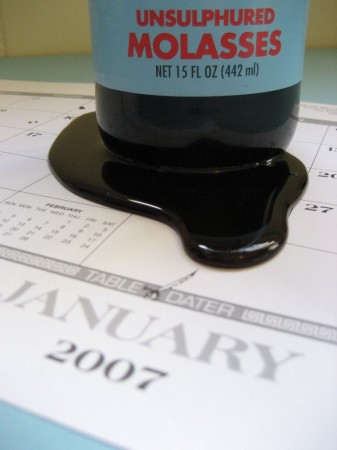
So to recap, Molasses is the main by-product of sugar production, used by the fermentation and livestock feed industries. UM was a firm like Tates that was made on Merseyside. If you ask ar Bobby Austin he will tell you all you need to know about the “refining process” and as an ace panman (sugar boiler) he knew when to “strike” to make the sugar crystals that we take so much for granted in our sugar bowls. Treacly molasses are obtained only after the crystallisation process and materialize as a dark gooey and heavy liquid. (Bobby was a far more effective “striker” than Ian Rush or Roy Vernon would have been if they’d “played” in Love Lane. The Love Lane “strikers” were world class and after the Lane Bobby continued to score sugar in Iraq, where his work was interrupted by a REVOLUTION, South Africa, and the Phillipines.)
Unrefined cane molasses contains some important minerals such as iron, zinc, chromium, and small quantities of magnesium, calcium and potassium. This is not enough to fill the “empty calorie” but certainly enough to differentiate it from that extracted from beet. UM was however much more than just rum and “brown sugar”. The extensive storage, loading and unloading equipment, spread over a vast geographical area, meant that the international molasses economy was dominated by a few players. As Phillipe Chalmin argues “the main problem of the molasses economy is the logistics involved: it is a costly product which it is difficult to stock and worth little…International trade in this commodity is therefore the preserve of firms which have enough money to handle the product from the sugar factory in the tropics to the warehouse of the end user”. So given that not many could afford to operate on such a scale, UM certainly did and was also an international trading firm with its own shipping lines.
Diversification out of sugar refining in the UK was a strategy Tates had planned and prepared for years before Britain joined the EEC in 1973. From the early 1960s a number of directors realised that refining was no longer the “cash cow” it had once been. Despite opposition from some of the old guard “sugar mill” directors, the acquisition in 1965 of UM, with its world wide network of activities and distribution points, opened up new horizons and new directions. It also completed another symbolic “local/global” dimension because UM had been founded by a “Liverpool Dane” with an attraction to molasses, Michael Kroyer Kielberg. Antony Hugill in SUGAR AND ALL THAT (the 1978 history of Tate & Lyle) describes how Michael had arrived in Liverpool in 1907 at the age of 25, “a quiet soberly dressed young Dane” He was about to apply for a job with Marquis, Clayton, “a modest firm of cattle-feed importers” whose address was 4 Chapel Street. The firm not only took him on but within three years made him a partner. “Now Kielberg became fascinated by molasses” and a global dynasty was formed. Keilberg was one of only two external directors on the Board of Tate & Lyle in the whole of the inter-war period. The other was Lord Birkenhead.
In 2004 Tates decided to unify its subsidiary companies including UM, Amylum, Alacantra and A.E.Staley, under the common name of Tate and Lyle and the liquid storage tanks that had once proclaimed United Molasses on Regent Road Bootle, helped provide a massive boost to the local paint trade. the biggest since the de-regulation of the buses, enabling fresh displays of the historic company livery of the Tates and the Lyles that had been sorely missing in Liverpool since 1981! .
Pictures of Jim’s special day
Written by Ron Noon at 14:44 on Monday, September 13th 2010
Yes that is the LORD MAYOR OF LIVERPOOL, Councillor Hazel Williams who went out of her way to meet up with and talk to the birthday boy before the birthday meal was underway.
Here is another picture of the Lord Mayor helping Jim down the steps with the help of Jim’s son Kenny, in order that he could pose for photographs with some of his Tate’s friends and former drivers.
They are a very lively and “mischievous” group of people and when one of them started the proverbial scouse banter and asked how long had it been since the gold chain of office had been “out of the pawn shop” she more than held her own. You can see Jim and everyone around him laughing as the Lord Mayor pointed the hand of office towards the guilty culprit!
There are some other pictures which I will post on site but in addition to the visit by the Lord Mayor, Roger Phillips of Radio Merseyside used his programme to wish Jim a happy 100th birthday and that was the day after Randall (Alfie) Holford, Jim’s last transport foreman, phoned into Roger’s show and eulogised the strength, wit and character of his former “boss”.
I also had a really nice letter sent in from Sydney Australialia from Frank Pankhurst
“I was a tanker driver with Tate & Lyle from 1954 to 1973, my father was Jim Pankhurst, and my eldest brother was Ted Pankhurst, both now sadly passed away, I would like to wish Jim Smith all the very best for his wonderful achevement in reaching his 100th birthday. Well done Jim, I raise glass to you, and for all the fond memories”.
We can all raise a glass to this legendary transport driver and anyone who has not viewed the film should watch and listen to Jim when he was a mere 97 years of youth, on the threshold of becoming one of the stars of THE BOYS AND GIRLS FROM THE WHITESTUFF.

The legendary Jim Smith
Written by Ron Noon at 18:04 on Thursday, September 09th 2010

This is the shortest BLOG on our site but less is best in this case!
It is now 2.15am and I’ve had to accept that I’m defeated in respect of getting this picture of Jim onto our site. I’ll try later on today but I’m going to his party at 1pm and I want to enjoy it and not fall to sleep.
....................................................................................................................................................................................................................................................................................

A WEEK AFTER JIM’S BIRTHDAY I’VE MANAGED TO DO IT!
Goodbye Mr Noon?
Written by Ron Noon at 18:47 on Monday, August 16th 2010
LIVERPOOL DAILY POST August 11th 2010

I feel real pride that in my home town Liverpool, where I have taught for so long that there was a danger of being viewed by students as a primary historical source, albeit an increasingly animated, walkin’, talkin’ one, that my retirement from full time teaching at the end of July was reported in the local press. It was a strange “pre-obituary” feeling to see myself in Liverpool Echo and in Liverpool Daily Post features, but it was undoubtedly a confirmation of the value of the public history project that has come out of the Lane!
Retirement from the company calendar, (I still have a desk at LJMU and hopefully a lasting link with the history department), is not retirement from the world of sugar and Love Lane Lives. In fact I feel that once the batteries in my old carcass are re-charged and I return from holiday in September that more can be done to update and keep fresh the ongoing stories of life on the Lane and much further afield in the 21st century sugar world. There is so much more to write about and on September 10th Jim Smith, one of the stars of our film, will be 100 years of youth and vitality. Leon Seth and I intend to film and record his “birthday” party and put it on the site. What a great character Jim is?
I recently had a snail mail from MWW which not only revealed the “true identity” of one of our most regular and valuable contributors (all those pictures and website addresses are down to Michael Wray), but of Jim’s nick name. Here is part of the letter: “Dear Ron, Regards the all too frequent postings from ‘M.W.W. Wirral’ in the Love Lane comments section. I plead guilty…Astonishingly good film, and it was good to see J.J. Smith of Tate & Lyle Transport featured. He was sometimes known as ‘J.J.’ to distinguish him from another Jim Smith who drove a tanker. J.J. drove a small van during my time at T<.”
Michael was himself a “Buff Note Clerk” with Tate & Lyle Transport. He recorded “returned damages, alternating 7am-3pm and 2pm-10pm shifts with George Laidlaw. Working alongside us were Johnno Johnston and Stan Armstrong. The office manager was Andy Roberts: foremen were Jack Kelly, Randall (Alf) Holford and Jack Garrity (whose brother Alec was a T+LT driver). Harry Bramwell was apparently in charge of ‘Miscellaneous’...” Where are these guys now?
Maybe now that I’m RETIRED, I’ll have more time to check out these characters and given that next April will be the 30th anniversary of the closure of Love Lane it is all the more important to establish contact with more girls and boys from the whitestuff, for their stories and reminiscences. With Tony McGann and the Eldonians and hopefully with some support from a sugar free Tate & Lyle company, we will be able to celebrate another re-union night on April 22nd 2011. Watch this space.
Here’s another email I’ve had, (one of a number that were not sent to our site’s guestbook and comments section), which I’ve not had “time” to include in a blog but which ought to provoke some sweet memories and kind thoughts.
“As a youngster just finishing an apprenticeship in 1962, I owe a lot today to John and Gerry for the push up I received from them (unknowingly at the time) but long since recognised.It was only after leaving T&L and going out into the world that I realised what a wonderful place it had been, what a wonderful experience and training I had received, and what marvellous people worked there. Another current link I have with sugar is that my son is married to a South African cane sugar farmers’ daughter! He’s now retired and his son has taken over the running of the farm – we visit and stay on the farm fairly regularly.”
That was from Jim Lycett who started off on the lane in 1957 but is now resident in New Zealand. He started a mechanical engineering apprenticeship with Tates and as the above extract illustrates he had a great deal of time for John Maclean (Albert E Sloane described his dear friend as a ‘Meccano fitter’) and for Gerry Hughes who was the AEUW steward. Colette simmons nee hughes wrote in from New Brighton Wirral on 02nd February 2010 about her dad Gerry. She can now read about how Jim from New Zealand cherishes memories of her father who sadly died from Asbestosis, linked very obviously as Collette explained to working at Tates. WORK can be dangerous, even in a refinery which as Jim Lycet argues was populated by “marvellous people”. One of those marvellous people was Jim’s own dad:
“My Dad had started as a lad in Tates drawing office, and had been involved in virtually all the alterations that went on in Liverpool for Tates since that time. He was given early retirement in 1972 from his position of Engineering Manager of Design and Development” Jim’s granddad started at Fairries (Tates took this over in the late 1920s and even though it was an integral part of Tate & Lyle many people continued to call it Fairries not Tates.) “He was shift foreman for the refinery and warehouses and retired before WWII my Uncle Jack was a carpenter there before moving over the water and going to Lairds. My Aunt also helped out there during the war. My sister trained in the drawing office as a tracer too,before moving to the Automatic (which later became Plesseys). My younger brother also at the Inny (Liverpool Insitute school) followed me to Tates for his apprenticeship then left straight afterwards to go sailing with Blue Funnel”.
Below is a picture of Fairries taken by a friend of mine, ROGER O’HARA,.
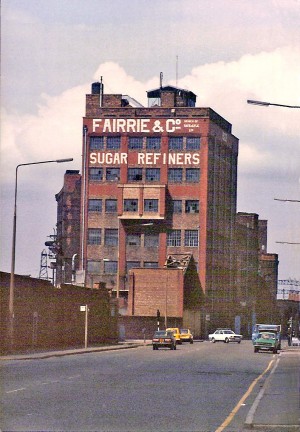
Jim Smith’s son Kenny worked shifts in Tates but was more concerned with a rock and roll career and did n’t last anywhere near as long as his dad would have wanted for him. That said when Leon and I first filmed Jim, he took us upstairs to a room where he had loads of pictures and memorabilia and there right in front of me was a picture of a younger Jim being kissed by Annie Lennox! I asked Jim what the connection was and his mischevous reference to Annie as one of his former girl friends was followed by an admission that “ar Kenny used to manage the Eurythmics”!
There’s some great stuff that I’ve had from Mike Greenall and Les Trent which I’ll get round to incorporating in subsequent blogs so maybe in answer to the rhetorical “Goodbye Mr Noon?” it ought to be just good bye to full time teaching and hello to a rejuvenated full time career as a sugar researcher! I better be careful because I’ve just heard my wife shout down to me “what are you doing down there? We are supposed to be on holiday”. Indeed when I looked at the sugar bowl on the table of our friends house in downtown Vanacouver an hour ago I felt this blog coming on and hastily retreated from the hot sunny deck upstairs to write this up in their basement. I am an addict that has to be controlled, but once upon a time it was for at least three spoonful’s!
Now this achingly addictive drug and “empty calorie” offers me nothing more than food for thought about how a simple carbohydrate which we have no biological need for in its pure concentrated granular form has become ubiquitous and taken for granted. The politics of health dimension to sugar studies on this website are underdeveloped and I know that for Albert and John’s generation some of the comments I now make about the sweet stuff resonate with “food faddism”! Our views on food and health have changed and what only mattered because it was sweet raises far more serious issues about overeating and obesity today.
Sugar is the best example for me of how a recognized foodstfuff has very little to do with nutritional needs and is consequently a permanent and sobering reminder of how production under capitalist commodity production is driven by want not need, wealth not health! Looking around today at the global warming of our one world (toxic smog and oppressive heat in Moscow and floods and landslides in Pakistan were the extreme weather events as we flew out to Vancouver last Wednesday) the stark evidence is that the rich are getting richer faster than the poor are getting less poor.
OK I am on holiday, I’ve had my second GAIL warning, and very soon I’ll have to put the ball away. As I metaphorically at least do just that I’m introspecting as I type, on a poetic thought about an approximately 500 year old system which reduces human beings to commodities and costs of production at the end of the day! William Blake in the poem Augeries of Innocence urges us “to see the world in a Grain of sand”! In the words of an inveterate sugar bore of no poetic ability, but who like Blake is addicted to a drug, (albeit a legal one), I can see Marx’s world of capitalism and greed in a granule or cube of sugar! Can you? Father Hartley certainly can and I’ll be updating readers with information and commentary from this wonderful “sweet fighter” in subsequent blogs.
To see a world in a grain of sand,
and heaven in a wildflower,
hold infinity in the palm of your hand
and eternity in an hour.
Where is History’s most famous sugar Lump on his 61st birthday?
Written by Ron Noon at 14:05 on Wednesday, July 28th 2010
Mr Cube’s first appearance was in the Evening Standard on July 28th 1949 and the command from the President of Tate & Lyle,[1] was that this powerfully symbolic cartoon character, (an ally of both the Conservatives and Fleet Street), “must always be a knight in shining armour. He must never be a psalm singing little bugger”. You can see from earlier blogs on this iconic sugar lump that he subsequently did just that! Mr Cube appeared on the famous “kill Chrismas letter” of October 1999 announcing the last ever Christmas party for the surviving boys and girls from the whitestuff. You may remember what my dear friend Albert E Sloane said about Mr Cube not only in December 1999 after “the last supper on Lime Street” but way back in Albert and Cube’s youth when the bosses at Love Lane asked workers for slogans to help in the campaign to prevent Clem Atlee’s Labour Government from nationalising the refineries.
At the end of last Millennium Albert accused Mr Cube of a scooge like meanness of spirit and suggested that he ought to have been depicted with a Scrooge like hat and matching ball and chain! In 1949 just after the birth of Mr Cube the young Albert who had registered his postal vote for Clem Atlee in 1945 from Burma where he had been with the Royal Air Force, suggested that “Tate & Lyle have made a pile, give it to the rank and file”!

That’s ar Albert in uniform ready to vote for Clem Atlee’s Labour
Not long after the “kill Christmas letter” Mr Cube was retired from public engagements and the company website made that fact very evident when they announced that he was being replaced by Lyle the Lion! Where is Mr Cube today on his 61st birthday?
[1] The former Tory MP Leonard Lyle who following Churchill’s resignation Honours list, became Lord Lyle of Westbourne, or Lord Cube to journalists!
............................................................................................................................................................................................................................................................................
As readers of this website are now keenly aware, on July 1st Tate & Lyle announced the sale of its sugar business to the American Refining Company, ARC. That news aroused comment about what had happened with Cadbury’s and Kraft and the loss of yet another iconic British brand name to the Americans but no references in the media were made about the fact that ARC is owned by two Cuban Americans, Alfy and Pepi Fanjul!
In my corporate watch over Tate & Lyle I first came across the Fanjuls in 2001 when they purchased from Tates, its American Domino Sugar brand, itself an iconic image which still hovers in neon on an historically preserved building in Brooklyn overlooking the East River and the most expensive real estate in the Cosmos! The Fanuls announced to the Brooklyn workers that they were there for the long haul but in 2003 they closed the refinery down. There is a lot to be researched in terms of the ARC but the key question today on the 61st birthday of Mr Cube is what is ARC going to do about Mr Cube? Bring him out of retirement? Or is Mr Cube now officially dead?
Finally on what ought to have been a happy birthday for history’s most famous ever sugar lump what will Tate & Lyle now do about its Royal Crest? I’ll leave readers with the Royal Crest which appeared on the letter sent to Albert in October 1999 and the Mr Cube logo which appeared at the bottom of the page. The representation is very much at variance with reality!.
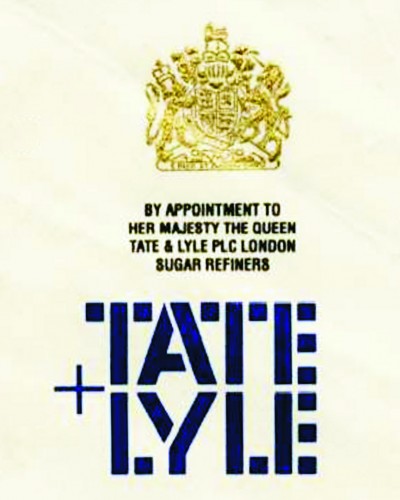

Dull faced manuscripts on Sugar Refining
Written by Ron Noon at 10:38 on Wednesday, July 07th 2010
THE WILDS OF LONDON by James Greenwood 1874 - AT A SUGAR BAKING
“It was a dull-faced manuscript – A Treatise on Sugar Refining (the dreariest subject I can think of) could have been given a more lively appearance…!
The source for that quotation is THE INN OF THE TWO WITCHES written by Polish born British novelist Joseph Conrad! Sugar does not grow on plant leaves and the laundering, purging and highly industrialised process of producing the white stuff is a core activity that has changed considerably over the last century and a half. Technological change in the second half of the 20th century can be seen through the experiences of our own Bobby Austin. Anyone who has met or watched Bobby’s video on our web site will know that “Sugar Refining” can be given a much more “lively appearance”. That said the extract from THE WILDS OF LONDON re-produced below from The Victorian Dictionary compiled by Lee Jackson, graphically illustrates just how dangerous and demanding the “process” was. Here we go:
“REGARDING the mild and innocent-looking sugar-lump, so pure, and bright, and sparkling, it is by no means easy to believe how its production can involve any prodigious amount of hard labour and man-sweating; so it is, however. Accidentally it came to my knowledge just recently that the manufacture of the saccharine luxury - a branch of trade of considerable importance, and providing with employment several thousand men at the east-end of London alone - was looked on, on account of its excessive hardship, with such dislike, that even that pattern of patient drudgery, the Irish labourer, could by no sort of persuasion be brought to undertake it. I was credibly informed that the bribe offered had taken even the seductive form of beer unlimited; but that still, marvellous to relate, the Emerald Islander remained obdurate, and the sugar-bakers were compelled, as has ever been the case, to resort for “hands” to the German labour market. There appeared to me something so unaccountable about this last feature of the business, that I resolved to go and find how it came about.
I cannot give the name of the bakery selected, as I have clean forgotten it ; but the reader will be at no loss on that score, since I was given to understand that one system regulates the business, and that one bakery is as much like another as peas of a pod. It is by no means a hole-and-corner business, as one might be led to imagine it was, judging from the rare occasions of its being brought under public notice. In the neighbourhood of Back-church-Lane, in Whitechapel, there are dozens of these baking, or, as they would more properly be called, boiling-houses. They are buildings enormous in size, usually occupying the whole of a street side, and so high that the massy “mats” of sugar craned up to the topmost story, and there dangling from its chains, looks no bigger or more substantial than a fishmonger’s rush-basket that the wind might blow away.
A kind-hearted German missionary was my companion, and soon as I put my head in at the door of the bakery, the nature of the manufacture in progress was at once made apparent to my senses. Just as unmeasured indulgence in sugar is nauseating to the palate, so was the reek of it palling to one’s sense of smell. You could taste its clammy sweetness on the lips just as the salt of the sea may be so discovered while the ocean is yet a mile away.
It was a sort of handy outer warehouse, that to which we were first introduced-a low-roofed, dismal place with grated windows, and here and there a foggy little gas-jet burning blear-eyed against the wall. The walls were black-not painted black. As far as one might judge they were bare brick, but “basted” unceasingly by the luscious steam that enveloped the place, they had become coated with a thick preserve of sugar and grime. The floor was black, and all corrugated and hard, like a public thoroughfare after a shower and then a frost. The roof was black, and pendent from the great supporting posts and balks of timber were sooty, glistening icicles and exudings like those of the gum-tree. “Sugar, sugar everywhere, but not a bit to eat.” Exactly the Bogeydom to which should be consigned for a term, according to the degree of their iniquity, the owners of larcenous little fingers so persistent in their attacks on the domestic sugar-basin. At the extremity of this gloomy cave, and glowing duskily at the mouth of a narrow passage, was dimly visible a gigantic globular structure in bright copper, and hovering about it a creature with bare arms and chest all grizzly-haired, with a long bright rod of iron in his grasp, which incessantly he waved about the mighty caldron; this was doubtless the Sugar Ogre himself; in waiting for juvenile delinquents.
Being in no dread of the ogre, however, we approached him, and discovered him to be a very civil fellow, quietly minding his business. The copper structure above-mentioned proved to be nothing more necromantic than a gigantic pan, in which were, gently seething, ten tons of liquid sugar. The vessel was all covered in, and looked as compact as an orange, the shape of which fruit it resembles but in the side of it there was a small disc of glass, and looking through it one could get a glimpse of the bubbling straw-coloured mass within. The iron rod the guardian of the pan called a “key,” if I rightly remember, and his sole occupation appeared to consist in dipping it in at a little hole in the vessel’s side, and withdrawing it again, along with a little blob of melted sugar, which he took between his finger and thumb, and drew out and examined by the light of the gas. ( The “Bobby Austin” Sugar boiler was the key strategic job in any refinery.)
From this we were conducted to the factory where the manufacturers of moist sugar were working. It may appear strange to the reader that the term “manufacture” should be applied to what every schoolboy knows to be a natural production, but it is by no means an incorrect term notwithstanding. (There is nothing “natural” about making sugar!) Some sugars are prepared at the place of their growth, and sent here ready for immediate use ; but the great bulk of it is exported in a very rough state, dense, strong smelling, and of the colour of mahogany, and before it can be brought to assume the bright and inviting appearance it bears when ticketed in the grocer’s window it has to undergo much torture by fire and machinery. (This is a very apt description of what is essentially a purging and laundering process.)
It was not a nice-looking place that to which we were introduced. It was not a pleasant way that led to it, inasmuch as it was in an underground direction, and through passages gloomy, low-roofed, and narrow, and lit with gas just enough to show all manner of wriggling and revolving machinery overhead and threading the walls. Down we went, however - our conductor kindly making the passage safer by illumining it by means of an old newspaper hastily twisted into a torch, and there we were in full view of the makers of moist sugar.
The fullest possible view under the circumstances it should have been written, for a clear view was impossible ; which, as we presently discovered, was a matter to be thankful for rather than to regret ; honors bursting suddenly on the unprepared vision have a bad effect sometimes. The place was nothing but a vast cellar underground, and lit from without only by a window here and there high up where the street pavement was, and as closely grated as though it were an object to keep flies out of the factory. The heat was sickening and oppressive, and an unctuous steam, thick and foggy, filled the cellar from end to end. Presently, however, when one’s eyes grew somewhat accustomed to the gloom, a spectacle of a novel and startling character was presented. Seeming, as it were, to grow out of the dense haze, busy figures appeared. Black and white figures running about, and flitting and skipping in the most extraordinary manner. Watching the figures, however, they were presently discovered to be men in a condition of at least semi-nudity. On one side of the cellar were two gigantic pans of sugar, melted and hot and smoking, and out of these the labourers, naked but for a covering for their legs and some sort of apron, and their bodies bathed in sweat, and their fair hair reeking and hanging lank about their wan faces, scooped tip the liquor into the pails, that would contain half a hundredweight, and hurried across the cellar to deposit it in vast revolving basins set in motion at lightning speed by machinery, and where the brown sugar was bleached and dried, to be presently shovelled out and added to the great heap that reached high nearly as the ceiling. Regarding the close, reeking, stifling place, the disgusting atmosphere, the incessant toil (machinery will not wait), and the disgusting conditions of it, the validity of the Irish labourer’s objection became manifest better a hod of bricks with a sixty-round ladder to mount out in the open air than such mean, enervating drudgery as this. “They’d be dead without their beer unlimited,” remarked our guide. “And does it not hurt them?” “Well, it helps to knock them off, I dare say.” So that it amounts to the same thing, only that the unlimited beer-drinker of the sugar bakery has the advantage of lengthy dying.
Out of this cellar and through others similarly occupied, and then upstairs, and here to be sure was another strange sight. This was a branch of the loaf-sugar department. It was an extensive floor, a hundred feet by seventy probably, and covering the whole of it were packed loaf-sugar moulds as closely as the cells of a beehive are arranged. The moulds were stuck point downwards into earthen jars that at once upheld them and served as receptacles for their drainings. I do not understand the process that was then operating, but what was to be seen was a dozen men of the semi-naked sort like those below crawling like frogs over the surface of the sugar moulds, getting foot and hand hold on the edges, some with a sort of engine hose squirting a transparent liquor into the moulds, and others stirring the thick stuff constantly in the latter with their hands. “I should imagine that you were not much addicted to the consumption of sugar,” I remarked to our guide. “I can never taste it ; it has no taste, no more. it has nothing for me,” he answered and one could easily understand how that happened.
Upstairs, again, up crystallized stairs, with “toffee” for a handrail and hardbake to knock your head against if you were not aware of impending beams, to a room likewise full of rnoulds (they turn out twelve thousand loaves a week at this establishment), but where the greatest novelty to the eye of the uninitiated are many heaps of what in appearance is the exact counterpart of mud off the public roads. It was not so, however, as the guide explained it ; it was merely the scrapings of beams and the shovellings of floors, and gangways, and workshops, and it was intended for filtration through charcoal, after which it would be deemed worthy to take its place as a marketable commodity.
Upstairs again - the place seemed to grow hotter the higher we climbed ; and here was the “filling” department - the place where the moulds were filled with liquid sugar, that flowed out of great taps. This, it seemed, was the hardest part of the sugar-baking business. Like every hand in the establishment, with the exception of the foreman and overlookers, the labourers here were midway nude (the disgusting practice is evidently one of habit rather than necessity amongst German sugar-bakers; we saw in one room - a comparatively cool room - half a cozen fellows squatted down engaged in the not over-heating occupation of painting moulds, but they were as naked as the rest). The moulds, as we were informed, when filled with the melted sugar, weigh a hundredweigbt and a half, and the liquid, as it ruins, is hot. The task to be performed is to fill the moulds at the taps and carry them across the great warehouses and arrange them close together for setting, each in its own jar in the manner already described. A gang of a dozen or so are so employed, and as the work is piece work, hurry is the order of the day. But hurry is not easy with a hundredweight and a half of sloppy hot sugar to carry in an inconvenient vessel, and the result is that as they shuffle off in line with their loads there are many lurches, and stumblings, and elbowings, and the contents of the moulds hugged to the chest slop over the naked bodies of the carriers, and then harden and crust to a coat, doubtless as inconvenient to wear as it is disgusting to behold.
No wonder that the poor wretches so employed drink much beer. With no more exertion than leisurely walking about demanded, before I had been in the factory a quarter of an hour, I was drenched with perspiration, and was not a moment free from a trickling down my face. To be sure, since indulgence in beer assists the sugar-baker in his work it is commendable in the master to provide it. But, as I am informed, it is in his power to carry his kindness a step further - he can abridge the sugar-baker’s labouring hours. The poor fellow’s wages are quite as low as those of the Irish hodman, but, unlike the last-mentioned, he knows nothing of a nine hours law. The sugar-baker works all hours. What he calls a fair day’s work is twelve hours, but it is not rare for him to be kept at the slavery above described for sixteen, and even eighteen hours - from three o’clock in the morning till eight at night - without a penny of overtime or extra pay. He cannot help himself. If he leaves one factory he must enter another exactly similar. It is a sight, I am told, to meet a group of the poor fellows just hurried from their beds, and making haste to their work at three o’clock of a winters morning. Unrested, shivering, pale, and agueish, they are eager to get back to the heat and the beer; they need “warming up,” as they say, and that object effected, they manage to potter through the weary day somehow, and then they shuffle home to bed, and so on between Sunday and Saturday. The only time, my good missionary friend informed me - and he should know - when you can catch sight of a sugar-baker neither abed nor at work is on a Sunday afternoon, when he enjoys the luxury of idleness and a pipe at his own door or window.
The Victorian Dictionary compiled by Lee Jackson
Tate & Lyle, one time Imperial Sugar Giant sings “Bye, Bye Sugar, Bye Bye”!
Written by Ron Noon at 21:41 on Thursday, July 01st 2010
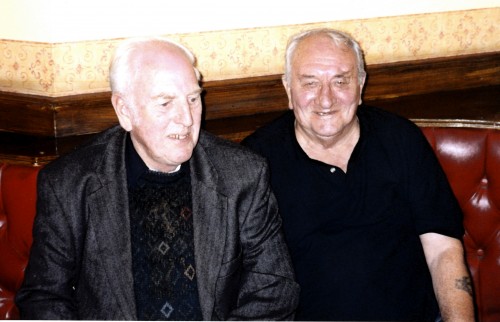
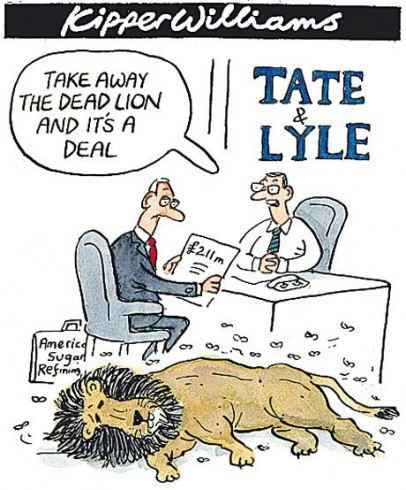
The opening comment on our Love Lane Lives film is from a woman who declared shortly after the refinery closure in April 1981, “it’s dead now”! She meant Liverpool was dead, not Tate & Lyle but I wonder what she might have said about today’s historic announcement from Tate’s London Sugar Quay headquarters, that the once biggest sugar processor in the world, is literally selling off its sugar business? It will be left with “splendid” Splenda, the low calorie sweetener made from sucralose, and a substantial ethanol and industrial food ingredients business, which CEO Javed Ahmed emphasised as accounting for the majority of its annual sales and profit. If we had some ghostly interviewing techniques what would Henry Tate and Abraham Lyle make of a new company diet bearing their illustrious names but premised on eliminating sugar cubes and golden syrup?
In popular parlance Tate’s sugar cubes and Lyle’s golden syrup have gone together like bangers and mash but the newly appointed CEO who took over from Iain Fergusson at the end of last year has clearly decided to break away from company traditions and popular perceptions of its brand image. He does not see “Value added” in the sugar refining industry, the brand with which Tate & Lyle is synonomous, but which historically has always been associated with the volatility of the commodity business.
I rapidly realised after I’d made a start to my research and talked to Albert and John about the progress I was making, that Tate & Lyle was not only strategically disinvesting from its once core sugar refining activities but pursuing investments wherever there was profit to be made which in 1977 they disastrously thought was in projects like skateboards! By 1988 when Tates had moved into High Fructose Corn Syrup, (HFCS) and invested in the American and European sweetener and starch industry using corn or wheat based products for the soft drinks, food and packaging industries, the influence of the commodity sugar business within the group declined even more. (Previous blogs refer to Tate’s main American acquisition, AE Staley and what Matt Damon’s role in THE INFORMANT dramatises in relation to the politics of corn sweeteners!) That said it would have been a sheer feat of imagination to have envisaged a Tate & Lyle world entirely devoid of sugar. That’s what today’s announcement symbolises for a transnational company long stripped of its ethnicity and family spirit. For our Love Lane Lives project however and for the Liverpool school children of Trinity and Hillside, the achingly addictive study of the bitter sweet world of sugar and it’s local and global lessons, continues unabated.
Here’s the news from REUTERS:Published: July 1, 2010
“LONDON — Tate & Lyle sold its European sugar operations to American Sugar Refining for £211 million Thursday, breaking a 150-year link to sugar in favor of low-calorie sweeteners offering faster growth. The privately owned U.S. group is buying Tate’s sugar and Golden Syrup business for the equivalent of $315 million, with a perpetual license to use the Tate & Lyle name. Tate said it will focus on its sweeteners such as Splenda and its industrial starches.
The British sugar maker’s roots go back to 1859 when Henry Tate started refining, then introduced the sugar cube to Britain in 1875. His legacy lives on after he bequeathed his paintings to form the nucleus of London’s Tate Britain gallery.
Tate’s new chief executive Javed Ahmed sparked talk of a sale of its underperforming sugar operations in May when he promised to focus on its super sweetener Splenda and corn-based sweeteners and starches largely made in the United States. .
Tate shares were up 2.7 percent to 462.1 pence at midday.
“We see the move as positive as it offers a cash injection and a move away from commoditized businesses,” said analyst Dirk Van Vlaanderen at Jefferies International.”
..................................................................................................................................................................................................................................................
The increase in share price suggested it was a sweet deal for Tates but share prices also increased in 1981 when Sugar Cane Time came to an end in Liverpool.
.......................................................................................................................................................................................................................................
Here’s the actual press release from Tate & Lyle on their website: 01 Jul 2010 07:00
TATE & LYLE TAKES MAJOR STEP TO FOCUS BUSINESS THROUGH SALE OF EU SUGAR OPERATIONS
Tate & Lyle PLC (“Tate & Lyle”) announces today it has signed an agreement for the sale of its EU Sugar Refining operations (“EUS”) to American Sugar Refining, Inc. The consideration is £211 million payable in cash, subject to closing adjustments for net cash and working capital, with the proceeds used to reduce Tate & Lyle’s net debt1.
On 27 May 2010, Tate & Lyle announced its clear intentions to focus, fix and grow its business. Today’s announcement is fully consistent with those intentions and will result in a more focused, less volatile business, and a solid platform to deliver sustainable long-term growth in Speciality Food Ingredients, supported by cash generated from Bulk Ingredients.
EUS consists of the cane sugar refineries in London, UK, and Lisbon, Portugal, the Lyle’s Golden Syrup factory in London, UK, the associated sugar and syrup brands and the Tate & Lyle Process Technology consulting business. In the year ended 31 March 2010, these businesses had external sales of £689 million and made an adjusted operating profit of £14 million (after transitional aid of £17 million), and had gross assets of £374 million at 31 March 2010. The sale excludes historic UK pension assets and liabilities and is expected to give rise to a book loss on disposal, before costs, of approximately £55 million, subject to exchange rate movements and the timing of completion. The transaction is expected to be neutral to the Group’s adjusted earnings per share on total operations in the 2011 financial year.
The completion of the transaction, which is conditional upon anti-trust clearance in Portugal, is expected to occur in approximately two months. Payment of £5 million of the consideration is contingent on the transfer of certain joint venture shareholdings that are subject to pre-emption rights held by the other shareholders.
Tate & Lyle has provided American Sugar Refining, Inc. with a perpetual worldwide licence to use the Tate & Lyle brand in connection with the retail sale of sugar and in other limited circumstances.
Tate & Lyle also announces the launch of processes to sell the remaining businesses within the Sugars division, principally Molasses and Vietnamese sugar.
The Sugars division will be classified as discontinued in the Interim Results to 30 September 2010.
Javed Ahmed, Chief Executive of Tate & Lyle said:
“Sugar refining has enjoyed a long and proud history within Tate & Lyle, but we believe the interests of this business and its employees are now best served by being part of a company for whom sugar refining is core. I sincerely thank our employees for their hard work and commitment over the years, and wish them every success in the future.
“Tate & Lyle’s clear priority is to grow its Speciality Food Ingredients business, supported by cash generated from Bulk Ingredients. This disposal will enable us to concentrate our resources on delivering our strategic objectives as we focus, fix and grow our business.”
........................................................................................................................................................................................................................................................................
P.S. American Sugar Refining Inc. is buying Tate’s sugar business and “perpetual license to use the Tate & Lyle name”. This is the new Sugar Giant on the block, owned by Flo.Sun Inc down in Florida, a private company which in turn is owned by Cuban Americans Alfy and Pepi Fanjul! (They bought Domino Sugar from Tate & Lyle in 2001 and Tate & Lyle Canada Ltd. (Redpath Sugar) in 2007, so there is a definite familiarity and “kinship” between the old and the new kids on the sweetener block.) For Father Christopher Hartley though, so keenly aware of the power of the Fanjuls and the “price of sugar” from the Dominican Republic, the focus on the sugar world also remains unabated.
PPS. Will the sage and up to the minute MWW from the Wirral please let me have his email address and identity next time he leaves a comment on the site?
Today 22nd of April 2010 is the 29th anniversary of the Closure of Henry Tate’s mother plant
Written by Ron Noon at 21:10 on Thursday, April 22nd 2010
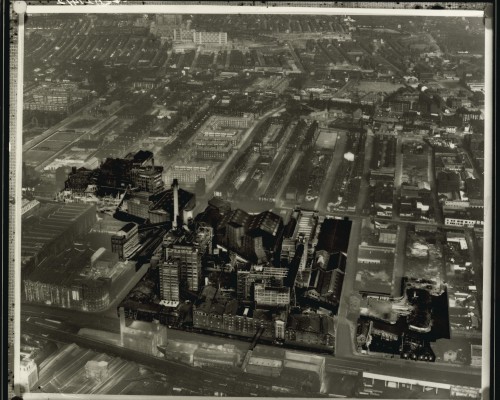
“On 5th December, [1872], the barque Dei Gratia of Nova Scotia bound from New York for Gibraltar and 300 miles west of her destination, sighted two other vessels. The first of these was a German tramp steamer outward bound for the West Indies, the other was the brig Mary Celeste, sailing crewless in the Atlantic.” (Watson)
Unlike the mystery shrouding the Mary Celeste the reasons why Tate & Lyle abandoned Liverpool are knowable and historically verifiable, but similar to that ghostly vessel, explanations as opposed to convenient myths, stretch way beyond European shores! The commonest cause of the rundown of Love Lane is that it was due to EEC regulations and the reduction of cane quotas, an explanation Tates management sold to their employees from the early 70s. Initially it justified common cause with the unions and blaming Brussels and the ludicrous CAP. Many people who were far from xenophobic and anti-European bought this argument and my initial conclusion about closure, although rhetorically sound,is insufficient as explanation for the matricide. “The city which had been renowned internationally in the 1960s for the Mersey Beat and the Beatles became the first main victim of the ugly sugar beet and Mad ‘CAP’ disease!” (CAP = Common Agricultural Policy)
Of course it was mad but the EEC and its Common Agricultural Policy was only one factor in the decline of Love Lane, and one skilfully and cynically magnified to divert attention from other reasons for wanting to junk the mother plant. We have alternative sources to investigate the ten year struggle to keep Love Lane open and Albert and John my two sweet fightin’ mentors, (John now sadly deceased), urged me to work through their documents, which are a very important part of this ongoing Love Lane Lives project. The provenance of their documents, deposited but un-catalogued in Liverpool Musuems, was struggle! In 1973 when the threat of closure switched up a few gears, a workers action committee was set up and “in various guises and under various names was to remain in existence until the refinery closed, producing in that time several hundred weight of paper”. That takes time to process.
The 90 day redundancy notices issued on 22nd January 1981 meant according to company historian Watson that “someone had to achieve in less than three months what they had failed to do in eight years…to persuade the Government, (as a successor of previous Governments with the same idea), to change its mind”. The joint union document that was rapidly prepared was too little and too late. (There was a Joint Trade Union Research Committee set up in early February which reported at the end of February.) Watson is correct in arguing that “although this was an honest and conscientious piece of work”, it was produced in a hurry and of course “the threat to Liverpool refinery had not come out of the blue”. The first rumour of closure had been in 1971!
Actually there had been “trust” in the early days of the campaigning for local management. The ironic thing at the end of the 70s, early 80s was that Liverpool was suffering because of the vulnerability of branch plants of large Multi National Companies to rationalisation. Tates was a company which despite its paternalistic image was a MNC of the sugar world and it was difficult for the Love Lane workers to comprehend the survival and diversification strategies open to such a geographically spread company. From the vantage point of company headquarters in Sugar Quay down in London, what was happening in Liverpool was a local side show. A letter in ‘78 to John and Albert from a Liverpool University lecturer, emphasised how the company was uncoupling refining and Love Lane in particular from the group’s growth engine and its corporate “accounts”. It was being made to stand alone! What may appear from company headquarters as “strategic disengagement” is in fact chicanery from the perspective of Love Lane refinery workers (and indeed local management) who knew nothing about Tates global strategies.
Tates always denied transfer pricing but creative accountancy and movements up and down the sugar chain can be described by other terms. When the subsidiary of a Canadian subsidiary (Redpath) provided monies from Bermuda to buy ships for the Tate & Lyle Group there is clear evidence of at the very least a sophisticated fiscal policy. An earlier blog dealing with CONCLUSIONS elaborates more on this theme. (“More pictures and interviews for 09 as well as a controversial conclusion about closure”. Ron Noon 12/20/08)
Another point to bear in mind about how MNCs operate is that they can so often play one set of workers off against another, and Albert had some jaundiced views about the London refinery workers. There were inbuilt tensions between the different refinery sites in Britain that eventually exploded out of the holding efforts of the Port Refineries Committee, but there was also within the Tate &Lyle Group different divisions and sections, which adjusted and diversified away from refining as a core activity. At the same time there were changes going on at Board Level which would culminate in a chairman from outside of the families and a “chief executive” from Canada (Neil Shaw) that had little feel for local loyalties.
What I’ve focussed on in some of the earlier blogs is the extent to which Tates were able to hide behind the complexities of sugar diplomacy while it stealthily moved away from commitments to the original mother plant. This was decision making with no room for sentiment or history and of course it was symbolic that the actual decision to close Liverpool was taken by a board with neither a Tate nor a Lyle on it. The ‘theatre of paternalism’ had served the firm well and that P word needs to be more closely examined in a subsequent blog. The concept of “theatre” is not to trivialise analysis but to get to the very core of people’s perceptions and mis-perceptions of representations and realities.
......................
Peter Hildrew a Guardian journalist described his impression of the vast refinery the day after the 90 day redundancy notices were issued. “It stands in the heart of dockland, a landmark built on a site where sugar has been refined for over 100 years and clearly visible from the nearby city centre, even in the grey mist which accompanied yesterday’s dismal news”. ‘Symbol of a sweet past and bitter future’ 23.1.81 Guardian
Mr Cube went down to Georgia
Written by Ron Noon at 23:58 on Sunday, March 28th 2010
Sat in a hotel bedroom in Athens Georgia the night before flying off home to Liverpool, I thought how supremely ironic it’s been for me to have been invited over to a Business History Conference in the Sun Belt to talk about History’s most famous sugar lump. It may be a couple of flights of fancy but coming from a city which loved country music before anywhere else in Britain, I keep on hearing the Charlie Daniels Band and a bitter sweet re-working of “The devil went down to Georgia”! So warrabout the consequences of “Mr Cube when he went down to Georgia” looking for a soul to steal and was “in such a bind because he was way behind” that he appeared willing to make a deal?
Hell did n’t exactly break loose in the Georgia University Conference “Center” when my friend David Clampin, (a genuine Business historian), and his Labour historian colleague examined Mr Cube’s role in staving off Clem Atlee’s threats to nationalize sugar refining, but that analogy of a fiddle of gold “to take your soul” is even more relevant to young sugar bustin’ “Johny’s” encounter with the devil and an inspirational demonstration of how it ought to be done! As the pulsating fiddles of that CDB record blasted away on my Ipod I wondered whether it was the devil in the form of Mr Cube or sugar bustin’ Johny of that great Country record that would now be forced to bow his head?
Too much rhetoric and figurative language as well as tiredness before going to bed, because in the real United States of America and Georgia the egregious “Sugar Program” continues. The devil is clearly not just in the detail. Take a look at what the New York Times said at the end of 2003 about the power of BIG SUGAR and ask if there has been any change since then. “If you care to take a dare I’ll make a bet with you” that even if “there’s fire on the mountain” and the refrain is to, “run boys run” that it’s not Alfy and Pepi Fanjul that are doing the running!
New York Times 29th November 2003
HARVESTING POVERTY
America’s Sugar Daddies
Sugar growers in this country, long protected from global competition, have had a great run at the expense of just about everyone else — refineries, candy manufacturers, other food companies, individual consumers and farmers in the developing world. But now the nation’s sugar program, which guarantees a domestic price for raw sugar that can be as much as three times the world price, needs to be terminated. It has become far too costly to America’s global economic and strategic interests.
The less defensible a federal policy is on its merits, the greater the likelihood that it generates (or originates from) a great deal of cash in Washington, in the form of campaign contributions. Sugar is a sweet case in point. The Fanjul brothers, Florida’s Cuban-American reigning sugar barons who preside over Palm Beach’s yacht-owning society, were alone responsible for generating nearly $1 million in soft-money donations during the 2000 election cycle. Alfonso Fanjul, the chief executive of the family-controlled Flo-Sun company, served as Bill Clinton’s Florida co-chairman in 1992 — and even merited a mention in the impeachment-scandal Starr report, when Monica Lewinsky testified that the president received a call from him during one of their trysts. Meanwhile, brother Pepe is equally energetic in backing Republicans, so all bases are covered.
The Fanjuls harvest 180,000 acres in South Florida that send polluted water into the Everglades. (A crucial part of their business over the years has been to lobby not just against liberalization of the sugar trade, but against plans to have the sugar industry pay its fair share of the ambitious $8 billion Everglades restoration project.) The Fanjuls had been Cuba’s leading sugar family for decades before Fidel Castro’s takeover. Crossing the Straits of Florida, they bought land in the vicinity of Lake Okeechobee, which feeds the Everglades, and imported platoons of poorly paid Caribbean migrant workers. Their business was aided by the embargo on Cuban sugar. The crop is protected from other competition by an intricate system of import quotas that dates back to 1981.
The government does not pay sugar producers income supports as it does many other kinds of farmers. Instead, it guarantees growers like the Fanjuls an inflated price by restricting supply. Only about 15 percent of American sugar is imported under the quota rules, and while the world price is about 7 cents a pound, American businesses that need sugar to make their products must pay close to 21 cents. Preserving this spread between domestic and world sugar prices costs consumers an estimated $2 billion a year, and nets the Fanjuls — who have been called the first family of corporate welfare — tens of millions annually. The sugar exporters who are able to sell to the United States also benefit from those astronomical prices. The Dominican Republic is the largest quota holder, and one of the big plantation owners there is — surprise — the Fanjul family.
The sugar situation hurts American businesses and consumers, but its worst impact is on the poor countries that try to compete in the global agricultural markets. Their farmers might never be able to compete with corn or wheat farmers in the United States, even if the playing field were leveled. But they can grow cotton and sugar at lower prices than we can, no matter how advanced our technology. Our poorer trading partners bitterly resent the way this country feels entitled to suspend market-driven rules whenever it appears they will place American producers at a disadvantage.
In fairness, the United States is not alone in distorting the sugar trade, and the European Union’s massively subsidized exports of beet sugar make it the biggest culprit. The American sugar lobby uses that fact as a shield, arguing that the crop not be included in any regional trade deals until distortions are addressed by all countries at the World Trade Organization. But quotas are set between trading partners, not on a global level. Right now the United States is negotiating the creation of a hemispheric free trade area that would benefit many United States industries, including other agricultural sectors. It is ridiculous for the sugar lobby to argue — as it does vociferously — that sugar should not be included in the agreement even though it is one of the few products that some Latin American republics can hope to ship to the American market.
So far the Bush administration has rightly rejected the sugar lobby’s push to keep the commodity off the table. The danger, however, is that American trade negotiators might still prove far too deferential to sugar industries when hammering out the trade deals’ specifics. For instance, any move to phase in elimination of sugar quotas over a period longer than a decade (as was done in the North American Free Trade Agreement) would undermine any promise a trade deal might hold for poor farmers in Latin America. The strength of the protectionist sugar lobby in Washington — which unites Southeastern cane growers and Midwestern beet farmers — was apparent in the success of Senator Mary Landrieu of Louisiana last year in bashing Nafta’s modest sugar provision during her re-election bid.
If the sugar trade were liberalized, world prices would start creeping up and domestic prices would fall, which would benefit both the developing world and the American economy. The industry itself cites “alarming” studies that if the United States imported an additional two million metric tons — roughly the amount Central America exports — domestic prices would be cut in half. But that is no argument for opposing trade liberalization. That is an argument for the handful of individuals who control the sugar business in this country to start thinking about a new line of work, and be grateful for the long run they had”.
PRECISELY!
..........................................................
“I know of no method of getting money, not even that of robbing for it upon the highway, which has so direct a tendency to efface the moral sense, to rob the heart of every gentle and humane disposition, and to harden it, like steel, against all impressions of sensibility.” John Newton in Thoughts upon the African Slave Trade (1788) – quoted in W.A Aykroyd Sweet Malefactor (1967) p.34.
Is there any easier method of making millions as saccharine as that provided by the Federal Sugar Program?
2010, Bloggers Block, Keele WAGs and THE real PRICE OF SUGAR!
Written by Ron Noon at 14:17 on Thursday, February 04th 2010
The last blog was written on Christmas eve but so many things have been happening since which I only felt half equipped to comment on, particularly in relation to the tragic events on the Caribbean island shared by Haiti and the Dominican Republic. A bit of bloggers block on a LOVE LANE LIVES website, (albeit one which has ON THE LANE, BEYOND THE LANE and SUGAR & GLOBALISATION sections), is a small thing, when so much more needs to be done and written about a country which witnessed the world’s first successful slave revolt and the establishment of the first black republic in 1804.
We all have individual and local lives to live in this One World of ours but a “Westerners” experience of the proverbial highs and lows, and peaks and troughs of everyday life, invariably translates in vernacular language into “if we did n’t have the lows then we’d never enjoy the highs”. That seems incredibly trite and indulgent in relation to the sheer scale of human suffering we’ve witnessed in Haiti. Why must those who have least have even less? I think it was about nine days into the disaster when I saw on the TV screen planes flying foodstuffs and supplies into an airport named after Toussaint L’Ouverture, and I immediately thought what “if” we could use some ghostly interviewing techniques to ask the famous BLACK JACOBIN what he thought about his descendants plight, what would he say?
What would he say about the illegal Haitian migrants and their children in the sugar bateyes of the adjacent Dominican Republic who are stateless and denied basic human rights and education? What would he say about the Sugar barons and the vested interests that have allowed this trafficking in people to go on? What would he say about the “cease and desist” order that was issued by a prestigious Washington law firm on behalf of one of those sugar baron families to limit the distribution of Bill Haney’s remarkable film THE PRICE OF SUGAR? The list of questions seems endless because someone far better equipped than most to write about Haiti, Gary Young of the Guardian pointed out earlier on this week that “Haiti is not a failed state; it’s a state that has been failed since it’s birth”. For workers to “tramp” to the DR to work on the bateyes has only emphasised just how systemic and abject the problems of this failed state have been for generations. How many more Haitians will be seeking to gain entry into the DR now?
Gary Young referred to a conference in Montreal last week of government and international agency representatives called FRIENDS OF HAITI who convened to discuss the country’s long and short term needs. Chillingly he notes that “even as the corpses remained under the earthquake’s rubble and the government operated out of a police station, the assembled ‘friends’ would not commit to cancelling Haiti’s $1b debt. Instead they agreed to a 10 year plan with no details, and a commitment to meet again - when the bodies have been buried along with the coverage of the country - sometime in the future”!
Anyway bloggers block defeated I’m off to Keele University in rural Staffordshire later on this afternoon to give a talk to OWEN POWELL’S prestigious WORLD AFFAIRS GROUP about High Fructose Corn Syrup (HFCS) and the politics of corn! It might start something like this:
“What’s that I smell in the air? The American Dream. Sweet as a new millionaire, The American Dream.”
That extract from Miss Saigon perhaps overstates the career profiles of middle America in the 1990s, certainly in Decatur Illinois! Tate & Lyle the sugar giant made on Merseyside, had acquired in a controversial leveraged takeover in 1988, the Decatur based A.E.Staley Mfg Co. Staleys, a once proudly paternalistic firm produced HFCS from CORN. (Many of the Tates workers I interview have claimed Tate & Lyle before the demise of the families were equally proud of their paternalistic reputation.)
The American dream was a fantasy that had become a reality for millions of blue collar Americans post-World War II and in Decatur before Tates. This mini-Chicago, (175 miles south of its bigger metropolitan neighbour), had about one third of its working population in manufacturing. That was before the era of “Transnationalisation”. For those blue collar Americans the smell in the air was the smell of money, a daily reminder that the good life was literally the sweet life. The bakery smells from the Staley plant would waft over the Viaduct on 22nd street.
Labor expert Kim Moody points out that “well into the mid-1980s” everything in town “seemed local and as American as apple pie” and that “even the multi-nationals like Caterpillar or Firestone Tire were names known across the Midwest farm belt for generations”. Globalisation and the era of downsizing and re-engineering would change all that and by the end of the 1980s, the London Sugar Giant in a controversial buy-out of “Gene” Staley’s traditional, paternalistic company, completed the triad of MNCs that would turn the world of Decatur workers upside down. The Staley, Caterpillar and Bridgestone/Firestone labor struggles in Decatur, Illinois in the middle of the 1990s created a turning point for labor. (Why can’t American cousins spell?)
Right no time for more bloggin. I’ve got to get down that M6, arguably the biggest car park in Europe to the leafy side lanes of Keele and Owen’s WAGs, not Sven’s.
............................................................................................................................................................................................................................................
This photograph is of a session I chaired at the Labor History conference in Chicago last May. The wonderful guy “listening” to my introduction is Dan Lane and he is one of the great “road warriors” of the Decatur struggles.
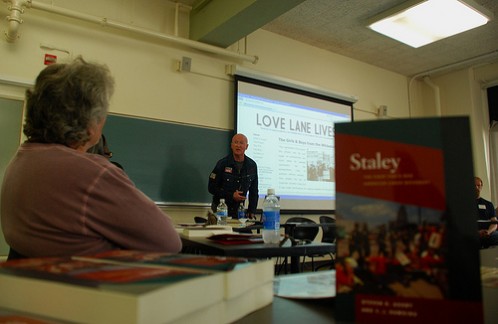
A Happy and Healthy Christmas to everyone, from the Boys and Girls from Love Lane Lives.
Written by Ron Noon at 23:00 on Thursday, December 24th 2009
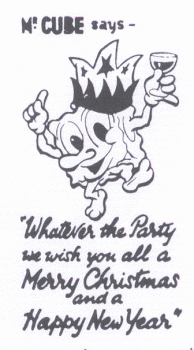
I popped around to see Albert E Sloane earlier on today but he was n’t in. Either that or the bell is not working. Maybe I ought to have phoned him in advance, but I know I’ll see him early in the New Year and I still felt good as I put his Christmas card through the letter box and slipped back to my car. This man means so much to me and not just as one of my most important sugar mentors. He is that and more but at this time of the year I’m sure Albert is not reflecting on his younger University friend and his own “sweet fightin’ youth” but on the absent friends that sadly are no longer around. This site is called LOVE LANE LIVES to ensure that at least we can keep their memories and their spirit as resonant as the festivities that we will be engaged in on the morrow!
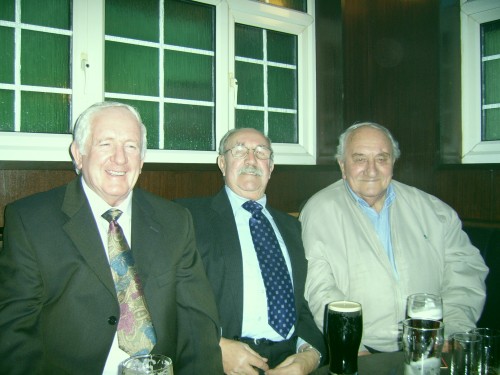
Tommy Owens died earlier on this year and that’s Tommy stuck in the middle between Patrick “Paddy” Brannigan and Albert. He’s so much missed by his family and by the Punch and Judy gang that he organised and kept together for so many years. “If” it had not been for Tommy this site would not have been possible.
Lord Cube in Liverpool 60 years ago tonight!
Written by Ron Noon at 23:09 on Tuesday, December 08th 2009
This is the report contained in THE TIMES on Friday December 9th 1949:
LORD LYLE DEFENDS SUGAR CAMPAIGN
REPLY TO ATTORNEY-GENERAL
FROM OUR CORRESPONDENT
LIVERPOOL, Dec.8
More than 2000 people packed into the Central Hall, Liverpool, tonight and filled another hall in the same building, to which the speeches were relayed to hear Lord Lyle of Westbourne address a free enterprise meeting organized by the local branch of the National Union of Manufacturers. Apart from one or two minor efforts at heckling, he was given an enthusiastic hearing.
Before the meeting he issued the following reply to the Attorney-General’s statement in the House of Commons yesterday: “The Attorney-General’s statement does not clarify the position with regard to the printing of Mr Cube on our packets. It will be necessary to get further legal advice. In the meantime some aspects of our campaign can be noted.
“The cost of printing Mr Cube is no greater than the cost of printing anything else on our packets. 2. Our campaign is not against nationalization in general, but against the nationalization of a section of the sugar refining industry - namely sugar refining. 3. There are many Socialist supporters, and no doubt many Socialist candidates, who are opposed to the nationalization of sugar refining. 4. Our campaign is certainly not directed towards the return of a candidate, thereby supporting one candidate or attacking others.”
In his speech, Lord Lye said that his firm intended to continue its oppostion to the Labour Party’s proposal to nationalize the sugar industry.
................................................................................................................................................................................................................................
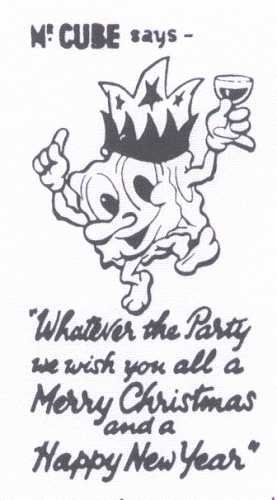
Sixty years ago Mr Cube was clearly enjoying the festive season. Forty years on in December 1999 the former refinery workers at Henry Tate’s mother plant, held their last ever Christmas party in the Britannia Adelphi Hotel and Mr Cube had metamorphosed to Mr Scrooge!
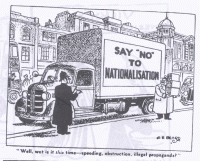
It was ten years ago and a day that Tate & Lyle told the PR band to play…
Written by Ron Noon at 23:18 on Thursday, December 03rd 2009
Tate & Lyle’s Liverpool pensioners were eagerly anticipating the 1999 company-supported “biennial” Christmas party, in the Britannia Adelphi hotel, only to be shocked and saddened by the contents of a letter from John Walker, the Managing Director of the Sugar Giant’s European Division. “Regrettably, this reunion will be the last one held”. His final sentence, hanging ominously over Mr Cube, the famous sword and shield brandishing, company cartoon, stressed how “this has been an extremely difficult decision to take but I hope you will understand that the company has to continually review and reduce its costs”.
Albert E Sloane, a sweet fightin’ man who had figured prominently in the ten-year struggle to prevent the closure of the comically misnamed Love Lane refinery, the mother plant in Henry Tate’s empire, was clearly very angry with this attempted “rationalisation”. He’d never lived his working life as a cost of production and yet history appeared to be repeating itself as another Tate & Lyle sponsored domestic tragedy for the feisty 77 year old. These were the thoughts that flicked through his mind as he and the surviving boys and girls from the whitestuff assembled for their last Christmas Party, beneath resplendent streamers strung across the banqueting hall of a once quite magisterial hotel. Cold business logic was matched by the weather outside on Thursday, December 2nd 1999. Even wrapped up in sugar-coated mangement rhetoric the letter announcing their last Tango on Lime St. was perceived by the majority, who like Albert had devoted most of their working lives to this company, as nothing less than Scrooge like meanness of spirit. Smile, it’s Tate & Lyle. No thank you!
..........................................................................................................................................................................................................................................................................................
There’s an earlier and more detailed blog entitled “A bitter sweet Christmas story from the last Millennium”! It’s dated 22nd December 2008 less than a month after our website went online.
The Informant is a corny film that’s really about SUGAR!
Written by Ron Noon at 11:02 on Wednesday, November 18th 2009
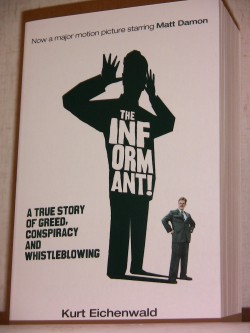
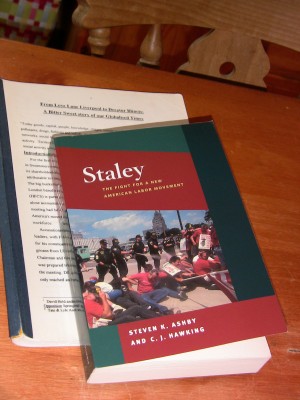
SCENE SETTING:
“We see the public being progressively shocked by one new corporate scandal after another. Yet these scandals although much larger in dollars and cents to those which have been rampant in corporate agribusiness for the past several years, directly affect far few people (thousands of investors, stockholders, employees) as compared with those millions of people who eat the products each and every day that these scandal-ridden companies manufacture.”
SCANDAL DU JOUR “The Fix is now institutionalized” The Agribusiness Examiner June 28, 2002.
“One of the recurrent themes addressed in these blogs will be the ‘politics of sugar’…and the connections between what Sidney Mintz, the ‘doyen’ of sugar studies, terms “sweetness and power’.”
But what about the politics of corn and of Harvest King now that the Fix is in?
Brewster Kneen’s splendid “biography” of Cargill, the massive agribusiness giant that once employed Dwayne Andreas, and former Tate & Lyle CEO, Larry Pillard, notes that CORN was “once something that people ate directly, fed to animals, or dried so that it could be either ground for tortillas and cornbread or stored for long periods before being used for either animal or human consumption. Now corn is one of the basic agricultural raw materials out of which almost anything, it seems can be made”.
Almost anything includes a syrup much sweeter than sucrose which with the help of subsidies and a protectionist American Sugar Program in the 1980s, served to boost not only its growing share of the huge home market, but also of the world sweetener market. According to Stephen Ashby and CJ Hawking’s excellent book on Staley, “an American consumer could not go through a day without using or eating dozens of products that originally come from corn…Cornstarches and corn sweeteners were essential in food processing innovations such as frozen and microwavable foods, instant mixes, shelf stable products, and low-calorie, low-fat products. Companies using paper, cardboard, textiles, gypsum and plaster board became major users of cornstarch”.
HIGH FRUCTOSE CORN! OK that’s the new corny sweetener on the block in the 80s but what about the town where it’s made and the people of that town?
“Beyond where the prairie roads widen and lonely gasoline stations, fast food stores, and windswept taverns begin cropping up, beyond the anonymous box-like moderately priced motels that surround everywhere junction USA, sits Decatur”.
Before big chunks of the Midwest were “transnationalised” in the 1980s, Stephen Franklin’s description of Decatur (Three Strikes 2001) would have conveyed traditional values, traditional prairie architecture, local industries and above all else corn! Ashby and Hawking comment that as you drive “any of the four lane highways into Decatur, vast cornfields line the road and extend to the horizon” and it is in fact “your nose” that tells you you’re nearing town, as “the sickening-sweet smell of processed corn fills the air”! Corn and Decatur go together like bangers and mash and just under 12 months since the first blog, this new kid on the sweetener block, High Fructose Corn Syrup (HFCS), produced by the hydrolosis of starch in the corn/maize, wet milling process, is still the main fix for Coke and Pepsi Cola! Staley’s Chief Executive Donald Nordlund confidently argued in 1980 that “HFCS was as much of a technological breakthrough as the transistor and videotape”! Eight years later Tate & Lyle became the owner of the historic Decatur corn wet milling company, in a controversial leveraged takeover, facilitated by ‘golden parachutes’ to senior Staley executives.
Once upon a time Staley’s like Tates, had prided itself as PATERNALISTIC. The withering away of that company spirit meant that despite its new chairman’s reassurances to the bargaining committee, over a beer in the Union hall, that “they would notice very little change in their life at Staley”, the takeover inexorably resulted in downsizing, re-engineering and eventually on June 27th 1993, the deployment of the ultimate weapon of mass destruction, in the employers armoury, the company lockout. It was that version of corporate greed which really did threaten to tear Decatur and its community apart.
“The Pride of the Prairie” and “Soybean Capital of the World”, was to become the site of bitter industrial struggles in the early 90s involving not just the sugar giant headquartered in London, but two other giant transnationals, Caterpillar and Firestone. Thirty percent of the town’s workforce in 1993 was in manufacturing, twice the national figure, prompting a Chamber of Commerce spokesperson to claim that “Blue Collar Decatur” was a MINATURE CHICAGO! Caterpillar in the same year that the FBI wired up Mark Whitacre as a CW, (Corroborating witness), for alleged “price rigging”, threatened to break their workers strike action with “replacement workers”.
Regan had sacked air traffic controllers in 1981 but Caterpillar raised the stakes to a different level by threatening “to toss out its striking workers” in 1992, a clear measure of the new corporate zeitgeist that resonated in what became known as the Decatur “WarZone”. Work and with it the lives of America’s working people was rapidly transformed by this brutal style of industrial relations premised on the spectre of “replacement workers” and “Lean” production methods.
This was “legitimated” by an unprincipled drive for success and “global competitiveness”. But what does that phrase mean in industries dominated by giants like Caterpillar, Firestone and Tate & Lyle? We all suffer from an insoluble shortage of TIME and workers time was being stolen. Is n’t TIME THEFT a CORPORATE CRIME too? Whereas previously the fight had been for the 8 hour day in Decatur the fight was to resist rotating 12 hour shifts which Staley’s management unilaterally imposed a few months before the lockout. Owen Bieber an automobile Union President speaking at the Economic Club of Detroit in 1992 delivered a corruscating response to the mantra of global imperatives. “I’m getting a little sick of hearing the word ‘global’. I’m sick of global competiveness” and this “anti-union takeaway stategy is a crime of domestic opportunity”. In other words it was all GLOBALONEY.
“Well into the mid 1980s, everything in the small industrial city of Decatur Illinois, right in the middle of farm country, seemed local and as American as apple pie”. It was a traditionally conservative city in many ways closer to the Southern states in its mindset than its sophisticated metropolitan neighbour, Chicago, 175 miles to the North. Corporate greed and crime would change all that and I hope by the end of the week, despite its apparent Peter Sellers, 1960s comedy style, that I’m not the only cinema goer to have grappled with cinematic representations of the politics of a corny film called The Informant!
………………………………………………………………………………………..
SATURDAY NIGHT AT THE MOVIES:
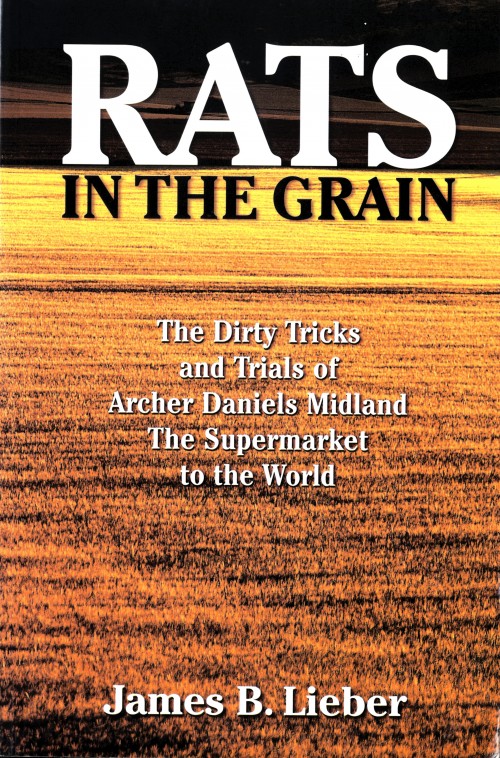
THE INFORMANT! starring Matt Damon and directed by Stephen Soderbergh, will hit UK cinema screens this Friday November 20th. New York Times journalist Kurt Eichenwald’s book of that name, (minus the exclamation mark), did have some stiff competition when it first came out nine years ago, from a verminous sounding title by Pittsburgh lawyer James B. Leiber, who also wrote about the mid 1990s price fixing scandals. RATS IN THE GRAIN: THE DIRTY TRICKS AND TRIALS OF ARCHER DANIELS MIDLAND was described by The Publishers Weekly at the time as “a steamy stew of sex, lies and videotape, revealing corruption that taints an entire industry”.
Let’s hope that Stephen Soderbergh, winner of the Palme d’Or at the Cannes Film Festival in 1989 for the quintessential “steamy stew” classic, has picked the right book. Perhaps he ought to have read and directed RATS! Anyway from what I’ve read Eichenwald and Leiber are not bosom pals and although the former does n’t mention the latter in his book, Lieber does at least mention Eichenwald in his. When Mark Whitacre, (Matt Damon), ADMs head of bio-products was doing his whistleblowing and delusionally acting out a Mitch McDeere role (a la John Grisham’s novel, The Firm), the alleged ADM company mantra was “our competitors are our friends, and our customers are our enemies”! That lapidary sentiment does not appear in economics textbooks and it does not seem to have rubbed off on how these two distinguished writers of agribusiness crime view each other!
More important than their continuing spats however is the fact that neither of them have fully contextualised Decatur as an Industrial Relations “War Zone” where in the early to mid 1990s thousands of blue collar workers became victims of a corporate solidarity that went way beyond price fixing. “In June 1992 Tate & Lyle and ADM announced that the two companies…would build a 3.5 mile, $600,000 pipleline between their Decatur corn processing plants.” That pipeline and I remember seeing pictures of it when I first set up a Liverpool Solidarity Support Group for the locked out AE Staley workers at the end of 1995, was designed to “carry 12,000 gallons of starch slurry per minute in EITHER direction”. It was blatantly obvious despite both companies’ denials that “it was their solidarity versus ours” and that “the purpose of the pipeline was to supply Staley” during a strike or lockout.
Leiber reminds readers of a broader remit than just Dwayne Andreas’ Archer Daniels Midland, which although not directly involved in the labor disputes, fully backed its competitor AE Staley. The “anti-trust prosecutor and FBI resolved to try to ‘flip’ additional witnesses against ADM…The Justice Department through grand jury subpoenas had seized records from a host of companies involved in manufacturing, lysine, citric acid, and high fructose. They included…England’s Tate & Lyle PLC”. He also emphasises how in “a tabloid culture, trials of gruesome crimes generate the most news…But bloodless white collar trials say more about the way the world works, and it is my personal bias that it makes sense to pay more attention to them”. Precisely.
………………………………………………………………………………………………
APPENDIX ONE.
The Informant and Rats are books about corn but they are really about an older kid on the sweetener block
“Federal sugar programs became one of Washington’s most sacred cows. Through price supports and quotas, the programs kept the cost of sugar high – gifting billions to sugar producers while pushing consumer product companies to save money by using high fructose corn syrup, a sweetener made by ADM. In time that created a billion dollar a year market for ADM, which sold its product at a higher price than would have been possible absent government intervention. In the decades that followed, many Americans would comment that the Coke or Pepsi they drank as children somehow tasted different, not knowing that the change had been largely the result of a switch of sweeteners dictated by government policies that favoured ADM.” Pages 24,25 in Eichenwald’s 2000 edition of THE INFORMANT.
APPENDIX TWO
I arrived at a conclusion in relation to the informant in December 1997: “There was always a hollow ring to arguments premised on the ‘press of competition’ in justifying Staley’s full frontal assault on the rights of its workers. That ‘argument’ is now completely vacuous. Whitacre’s unusual research into the operation of a supposedly ‘dynamically competitive’ agri-business Giant, and the operation of its ‘internal market’, has clearly uncovered the very visible hand of a price rigger. The ripple effects on Tate & Lyle and other ‘competitors’ in the secretive world of agri-business have still to work their way through.”
Nine years after the case had started out it did just that and on Thursday July 29, the Washington Post’s Business in Brief section had this information below the headline Sweetener Case Finally Over!
“Tate & Lyle, Europe’s largest cane-sugar refiner, paid $100 million to settle a lawsuit over sweeteners used by Coca-Cola and PepsiCo in the biggest food antitrust class action in U.S. history. Tate & Lyle, based in London, was the last to settle a civil suit filed in 1995 by the Department of Justice on behalf of food companies, including Coke and Pepsi, alleging its A.E. Staley Manufacturing unit conspired to fix prices of high-fructose corn syrup, a sugar substitute.”
The London Times reported how “Tate & Lyle protested Staley’s innocence, saying the settlement had been agreed for pragmatic reasons”. Robert Gibber, the Tate & Lyle general counsel said: “We deny emphatically involvement in any wrongdoing and believe we were in a position to demonstrate this at trial. However, particularly in the light of recent settlements by the other defendants, a jury trial would have exposed Staley to a degree of risk.”
What degree of risk were Staley workers subjected to in the era of the WarZone?
I dealt with some of those issues in the June blog BITTER SWEET PENSIONER STORIES where reference is made to Larry Pillard relinquishing his CEO spot at Tate & Lyle in 2002. Pillard had been brought in as chief executive at AE Staley ten years earlier, having formerly been “trained” at Cargill. His success at resolving the “thorny Staley problem” resulted in his eventual promotion to the top job in Tate & Lyle in 1996. Why did he stand down on June 14 2002? Alan Buebert in an essay entitled ALLEGED FRUCTOSE PRICE FIXERS REMANDED ON TRIAL, June 21st 2002, teasingly suggests that “just seven people – all with close personal and business ties to each other – have controlled American fructose production and pricing for two decades. Little wonder fructose buyers allege fructose sellers fixed prices”.
June 18th 2002 four days after Pillard stood down. A Federal appeals court in Chicago ordered the fructose price fixing civil suit to be heard.
27th June 2003 - Exactly ten years to the day that the Staley workers had been locked out, a report published in the London Evening Standard revealed, that the man vilified in Decatur, as a union buster and “damaging to your health” had received from Tate’s, ‘a £1.5 million pension sweetener’ after unexpectedly announcing he was stepping down as chief executive of the sugar giant. Allegations were heard that the timing of his move might have been related to an imminent class action case in America about the rigging of HFCS prices, by ostensibly rival companies, when he was chief executive at Staley.
ESSENTIAL FURTHER READING AND VIEWING (BEFORE OR AFTER WATCHING THE INFORMANT DEPENDS ON WHOSE TIME IT IS ANYWAY!)
You can see in the photograph my 2000 edition of THE INFORMANT placed over a poignant picture of the tri-union struggle contained in Ashby and Hawking’s STALEY, and then over to the page on the right are placed two excellent video’s recorded by Rosemary Feurer and LaborVision based in St Louis.
Bob Bannister
Written by Ron Noon at 21:05 on Thursday, November 12th 2009
I was delighted to read Brian Bannister’s comments which were sent in from London a few days back. This is what he wrote:
“I’ve just watched and really enjoyed the film. It brought back memories of my dad (Bob Bannister) and all of the Tate and Lyle crowd. I remember going in to Love Lane as a child and being overwhelmed by the size of the place but always being taken aback by the friendliness of the people. I never left without a pocket full of sweets and money! Looking back and remembering, there was a real sense of community in Love Lane and years later if I was ever out with my dad we’d more than likely bump in to former Tate’s people and I’d be treated, (and it was), to some of the old stories. My favourite was my dad finding great overnight digs in Leominster at Mrs Chambers (who by then was well in to her 70s!) and wanting to wind up the other drivers, (Frank Callaghan, Tucker Price and Oweny Moran), keeping her name and address a secret from them. So they used to try and follow him to track it down. I’ve still got visions of Tate’s lorries on a Smokey and the bandit run through the Welsh hills!!
Thanks for keeping the memory of Love Lane and all those great old scousers alive.”
..........................................................................................................................
Brian’s dad was one of the guy’s I heard so much about when I was conducting my early inquiries into the closure of Love Lane. Bob Bannister, was a senior shop steward and a driver for Tate & Lyle, but above all he was a very popular man of great presence and distinction. I did eventually have the privilege of meeting him, but sadly only once, and that was on that barmy “summer night” back in April 2006 when we had the wonderful 25TH ANNIVERSARY reunion bash, for the surviving boys and girls from the Whitestuff.
We had successfully petitioned the company to finance this event but I had the continuing headache as an “outsider” organiser, of trying to ensure as fair an allocation of tickets as possible, especially when demand was clearly far greater than supply.
Many would have been disappointed at not getting tickets but some of the oldest bouncers I have ever seen were given strict instructions that night not to admit anyone without that invite into the Eldonian Village Hall! It was a very special night and to hand a special picture to Bob meant asking my main sugar mentor Albert E Sloane to point him out. The picture I gave him is published here and I hope it gives Brian the pleasure it gave his dad on that halcyon night in the mid noughties. It’s an inspiring thought that very soon we are hoping when people visit our site, there will be a photo gallery. This photograph will be there in much bigger relief stirring the imagination and evoking visions of Tates lorries rumbling through the Welsh hills, alongside many other bitter sweet memories of Love Lane Lives.
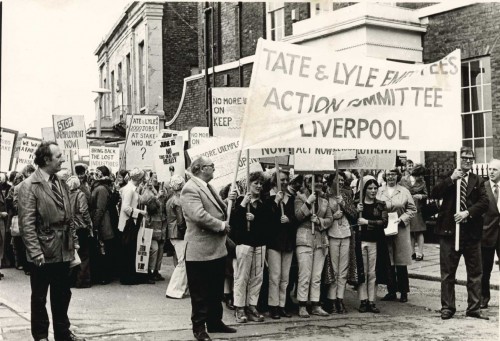
Bob is on the far right of the picture holding the banner, wearing glasses and a striped tie!
The final commentary on this blog is also one that I hope Brian and his family will appreciate because it relates to what his dad was trying to do with so many others to prevent the closure of this historic mother plant. It is from the records that we have which still need pulling together and cross referencing. But here’s a PRIMARY SOURCE which I’m sure the other guys from the Transport will appreciate the significance of.
It’s a hand written document signed by Roger and written in block capitals. It was dated March 1981 when Roger and other drivers were able to “scout” what was actually going on at that time in terms of other sources of sugar supplies entering into the North West. The traditional customers for the white stuff had been more than satisfactorily served by Love Lane refinery but the old friendly paternalism which had made it such a good firm to work for “once upon a time” had rapidly disappeared by 1981.
The refinery workers had secured a pledge of support from the National Union of Railwaymen and key transport drivers unions as well as an all party CONGRESS OF MERSEYSIDE that the Echo reported on. Everyone here was asking for a suspension of the 90 day notice to investigate an alternative to closure. The man who knew driving through the Welsh hills better than most certainly knew his way about Manchester where he was looking out for evidence that the firm was marginalising Liverpool and diverting supplies from other sources to long established customers supplied by the Lane.
Bob’s document is headed WARDS – TRAFFORD PARK
“Ward’s warehouse in Trafford Park is set up to handle Tamplin tanks. These tanks can be conveyed by road and rail. The equipment in the warehouse to handle the tanks is a substantial set up, costing a lot of money. From information received this cost has been met by ‘Mann’s’ - with Bugets involved somehow. Buget being the one drivers have to contact to receive delivery instructions. At the present moment of time the sugar into this warehouse is coming out of the Liverpool refinery, passing customers traditionally serviced direct by own vehicles. It is being lifted off by crane taken to far end of warehouse and tilted by equipment to gravity feed into another road tank to be taken to customers we in some cases have passed, even into Merseyside.”
It goes on: Commodity Foods Trafford Park Berrisford’s “This is only a half mile away from Wards and is handling sugar again from Tamplin tanks from Liverpool by road and London via rail. As well as having storage tanks for gran dry bulk, they are also installing liquid tanks, again delivering to customers once serviced direct ex Refinery. This establishment is also milling gran sugar into iceing: pulverised: caster: bagging it into 50 kilos for distribution. It is interesting to note that both these places are within a mile radius of the freightliner terminal.”
Yes there were many who thought that Tates HAD been a great PATERNALISTIC firm to work for. The emphasis is on HAD BEEN! Tates were able to hide behind the complexities of sugar diplomacy in the 1970s, while it stealthily moved away from commitments to the original mother plant. This was decision making with no room for sentiment or history and of course it was symbolic that the actual decision to close Liverpool was taken by a board with neither a Tate nor a Lyle on it. That’s perhaps why Bob a loyal and hard working transport driver and shop steward, was “scouting” around Manchester. So many who had given their lives to this company like my friend Albert E Sloane never worked again.
EVERYONE who had enjoyed the annual and then biennial Christmas parties at the Britannia Adelphi hotel were bitterly disappointed at the end of last Millennium when Tates announced that “because of the need to continually review and reduce costs we regret to announce that this will be the last ever” Christmas reunion. In the BITTER SWEET PENSIONER STORIES for June there is a tremendous but now even more poignant cameo of Bob Bannister asking “at the last supper on Lime Street whether it would ‘spoil some vast eternal plan if these Christmas get-togethers were to continue … after all, in ten or fifteen years most of us will have left for greener pastures’.
Decatur, Decatur, it’s Matt’s kinda town
Written by Ron Noon at 09:41 on Tuesday, November 10th 2009
IN CASE YOU HAVE NOT SCANNED THE BLOG SUMMARY this is how it reads: “In less than a fortnight a blockbuster movie starring Matt Damon will be on general release. The star of the Bourne trilogy plays the role of Mark Whitacre, a corporate “whistleblower” for a company which was not only headquartered in a town affectionately known as “The Pride of the Prairie”, but which down to the early noughties was the biggest institutional shareholder in Tate & Lyle. Much of THE INFORMANT was filmed in Decatur, a town of 84,000, 175 miles south of Chicago, where not only Archer Daniels Midland was based but so too was Tate & Lyle’s lucrative subsidiary AE Staley Mfg Co.”
Below is an extract from a paper I gave to Jerry Tucker, an inspirational American trade union activist, in 1998. (FROM LOVE LANE LIVERPOOL TO DECATUR ILLINOIS: A BITTER SWEET STORY OF OUR GLOBALISED TIMES.) I’d never been to Decatur, (the closest I managed was Chicago earlier on this year), but because of my corporate watch over Tate & Lyle, my sugar chain had extended from Love Lane to an industrial town of 84,000 in Illinois, the heart of the American Mid-West. I was keenly aware of the labor battles that blighted this town in the early 1990s, and determined to write about them. I’ve often suggested to students that HISTORY can be too neat and tidy looking back down the tracks from HINDSIGHT STATION so it is very important to try to imaginatively reconstruct the “mess” that so often faced the then contemporaries. Who would have anticipated events at AE Staley and particularly Archer Daniels Midland leading onto charges of PRICE RIGGING?
I read about the locked out AE Staley workers rejecting the company offer in July of 1995 and gaped with amazement at the other summer time news that the FBI had raided ADM headquarters, Staley’s ostensible competitor. It was that raid and its attendant publicity which has led onto Steven Soderbergh’s BLOCKBUSTER movie albeit 14 years later. Soderbergh’s movie is about CORPORATE CRIME and the role played in practicing and exposing it by bipolar Mark Whitacre, played by Matt Damon.
I’m “dying” to see it on the 20th of November, but I know that the broader context of corporate greed and industrial strife which made Decatur a social metaphor for all that was going down in the HOUSE OF LABOR in the 1990s will not be featured in a movie that has already been described in the New York Times as “a deadly serious comedy about corporate malfeasance”! Soderbergh’s brief was not to view Decatur as a paradigm of the ongoing bitter sweet story of our globalised times but that story has been addressed by activists and present minded labour historians like Steven K Ashby and CJ Hawking. Their excellent book STALEY: THE FIGHT FOR A NEW AMERICAN LABOR MOVEMENT is not to my knowledge the basis of any forthcoming film scripts but it ought to be! Anyway the section reproduced below that I wrote was written in December 1997 and starts off with a reference to another stalwart trade union organiser that I corresponded with at the end of 1995, Art Dhermy.
“Art Dhermy’s response was that ‘they don’t want us back with an offer like that’. To ‘carry on the fight’ was the only way forward and as Mike Griffiths commented in January 1996, how many of us can say that after two weeks, two months, three months that we can still hold our members in a struggle like a strike. These folks did it for over two years and were presented an offer by a corporation that expected it to be accepted and it was rejected. The national… leadership expected it to be accepted as well.’
That was the real significance of the July 10th 1995 union membership ballot [at AE Staley where 760 workers and their families had been locked out since June 1993]. Their tenacity and solidarity was also complemented by some other encouraging developments. Around this time the FBI actually subpoenaed ADM and Staley as part of an investigation into price rigging. What added extra seasoning to this unfolding drama was not just the FBI raids on the company headquarters, but the fact that a senior ADM executive Mark E Whitacre, had acted as a government informant on the case, for more than two years. The executive ‘whistleblower’ had ‘secretly taped thousands of hours of conversations and meetings in which price fixing was said to have been discussed’. The investigation known as ‘OPERATION HARVEST KING’ resulted eventually in October 1996 in ADM pleading guilty to charges of price fixing and paying a fine of $100 million, ‘by far the largest fine yet in a criminal anti-trust case’. The settlement requires ADM to cooperate with ongoing federal investigations into lysene, an aminio acid that speeds muscle growth in animals, and High Fructose Corn Syrup (HFCS) markets.”
HFCS was the new sweetener on the block in the 1980s and 1990s and Tate & Lyle had bought into AE Staley in 1988 because before then they had no capacity in this lucrative sweetener market. “The largest fine yet in a criminal anti-trust case” was a Kurt Eichenwald quote from the NYT on 7/18 1996 but in 2004 Tate & Lyle would pay the same amount in what the Washington Post described as “the biggest food antitrust class action in US history”. It had dragged on for 9 years and the London Times reported how “Tate & Lyle protested Staley’s innocence, saying that the settlement had been agreed for pragmatic reasons”! (See the June blog on Bitter Sweet Pensioner Stories.)
Back to the past and in 1999 three of ADMs top officials including its vice chairman Michael Andreas, were sent to federal prison for conspiring with foreign rivals to control the international market for lysine an important feed additive for cattle. In terms of time scale the Justice Department’s investigation was from August 1992 to December 1995 which was a significant month in my research into Tate & Lyle’s American subsidiary. The end of that year was to be the end of the 30 month LOCKOUT and according to Art Dhermy and Mike Griffiths their own union boss, Wayne Glenn, helped steal defeat from the jaws of victory! That broader context and “lessons to be learned” is more likely to be found in this blog than at the movies.
The movie owes much to the New York Times journalist, Mark Eichenwald who published THE INFORMANT in 2000. In 2009 it has been published over here in paperback with an exclamation mark! So depending on the extent to which it captures the film going public’s imagination it looks a likely big seller this Christmas. That genre of “truth is stranger than fiction”, is always appealling, but nothing surprises me about a film which although not directly focussed on the “white stuff” is nonetheless very much to do with the bitter sweet story of capitalism’s “favoured child”.*
WATCH THIS SPACE
* Kim Moody’s book Workers in a Lean World explains how “by the 1980s they (Trans National Corporations) had reached deep into industries and geographic areas of the United States once dominated by the family firms or larger, but still national or regional, corporations. This brought both a new balance of forces and new work and production methods to many parts of the United States unaccustomed to being a direct part of the world economy.”
Alongside the replacement of family farms by corporate giants was the arrival in 1988 of a SUGAR GIANT made on Merseyside.
Hillside blog on September’s Specialist Sugar week
Written by Ron Noon at 10:36 on Tuesday, November 03rd 2009
“It’s just over two years since our film Love Lane Lives was shown at the Tate Liverpool and the two best things that have happened since our sugar project gathered that momentum and publicity has been our association and involvement with two wonderful schools and their respective teachers and pupils. Trinity Catholic Primary school close to the original refinery site, and Hillside High School a little further away in Bootle, have demonstrated the remarkably creative work and insights into the world of sugar that primary and secondary school children can build into their education and community experiences.”
The blog is reproduced in its entirety below but I want to emphasise having recently visited the school before the half term, just how much superbly creative work is still on display in the entrance to the school and along its corridors. Leon and I have unfinished business in putting together the Trinity film which we know will be well worth the wait. The wonderful Trinity children and their teachers deserve nothing less. Hillside’s excellent teachers and pupils also deserve the best and indeed they used their own “amateur” film makers to record the weeks events. In addition to the children’s efforts, two excellent professional film makers were brought in from outside and I’m sure from what I’ve seen of the footage of the music sessions with Ian Prowse that it will be a fantastic film record of an exceptional week in the life of a school that just oozes character and excellence.
.....................................................................................................................................................................................................................................
Specialist Week 2009
“What a week! Pupils and staff have had a really exciting week discovering how sugar has helped shape Liverpool. Pupils visited the Tate Gallery (originally funded by Henry Tate from Tate & Lyle) and the International Slavery Museum Year 8 and 9 pupils visited the Royal Court theatre to watch a performance of Willy Russell’s “Our Day Out”. Year 7 pupils watched the film version of “Our Day Out” on the big screen in school. Older pupils watched episodes of Alan Bleasdale’s “Boys From The Blackstuff” and saw the demolition of the Tate & Lyle Love Lane refinery.
Pupils linked these performances to the social climate of the time of the refinery closure and wrote campaign letters and slogans to the government to try and keep the factory open. Alan Bleasdale was so pleased that we were using his work that he sent a personal letter of support to the school. Roger McGough, Liverpool’s most famous poet, and a Tate & Lyle old boy, also sent an e-mail to the pupils giving his support.
In science pupils looked at the chemical structure of sugar and made models of glucose molecules. They also discovered the negative effects of sugar on our health and our teeth. The school nurses gave very informative talks to pupils about the hidden sugars in our food. Did you know that a bottle of fizzy drink contains over 11 heaped teaspoons of sugar?
Our art department looked at sugar crystals under the microscope and helped pupils to recreate the effects using silk painting, collage, inks and other media. We had a visiting artist in residence, Vinnie Cleghorne, who worked with small groups of pupils to build big pieces of sculpture and wall hangings based around sugar and Tate & Lyle.
The performing arts department focused on slavery and its links to sugar and Liverpool. The music department looked at music from the Caribbean Islands and pupils really enjoyed playing the steel pans.
We were very lucky to have a visit from a Liverpool musician, Ian Prowse. Ian’s band, Amsterdam, have played at many venues across the country and Ian himself has played with Elvis Costello and the Icicle Works to name just two. He worked with our music teacher Gerry Harrison and the year 10 GCSE music group to compose a song about the closure of the Tate & Lyle refinery. Pupils used their experiences from watching “Boys From The Blackstuff” to gain ideas of the atmosphere around Liverpool at the time. Watch out Billy Bragg!
Pupils in food technology were very lucky to have a visit from a retired sugar boiler from Tate & Lyle. Bobby Austin, who is now 85 years old, spent the day with us and talked to pupils and staff about his experiences in the sugar industry. His knowledge is quite amazing; he has worked all over the world and told us tales from China, Swaziland, Iran and America.
A special thanks must go to Ron Noon from Liverpool John Moores University for his unstinting help in getting Specialist Week up and running. Ron is passionate about sugar and is a world authority on Tate & Lyle and the sugar industry. lovelanelives.com is the website Ron has created about the Tate & Lyle refinery closure and is a must for anyone with links to the old factory. Ron worked with staff and pupils to enthuse them and to help create the exciting activities that went on around school. It was great working with the university and Ron brought in colleagues and ex-students to pass on their expertise. Our pupils really enjoyed this opportunity and we hope to develop the links between Hillside and LJMU even further in the near future.”
Last day of Black History Month 2009
Written by Ron Noon at 20:47 on Saturday, October 31st 2009
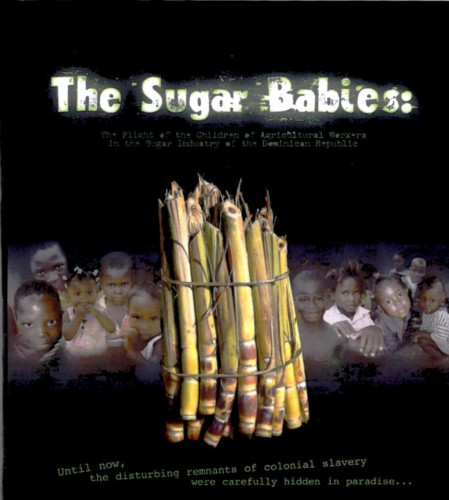
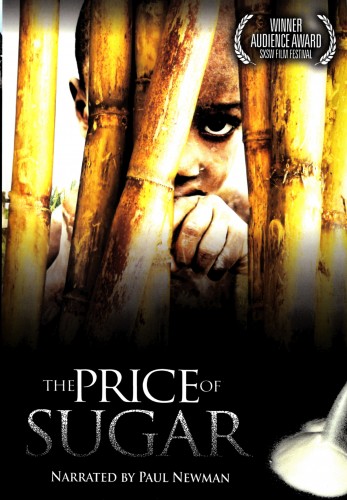
“Sugar did not create Negro slavery. Given the circumstances in which the New World was colonised by Europeans, the need for labour in the colonies for purposes other than sugar production and the long standing existence of slavery in Africa, African slaves would no doubt have been carried to the Americas if the sugar cane had never been domesticated. But the gigantic scale of the transatlantic slave trade and its maintenance for several centuries, were due primarily to the demand for sugar in Europe and North America.” W.A. Aykroyd Sweet Malefactor (1967)
The first blog on this website, (November 27th 2008), highlighted the formidable obstacles impeding the wider distribution of two shocking films about modern day sugar slavery. “Bill Haney’s film ‘The Price of Sugar’ narrated by Paul Newman, and Amy Serrano’s ‘Sugar Babies’ are bitter sweet films dealing with abuses of human rights on sugar ‘bateyes’ in the Dominican Republic that…demand the oxygen of publicity.” Unlike our Boys and Girls from the Whitestuff, these films aroused blatant opposition and resistance from offended “sugar interests”.
Paul Newman’s last film was shown to interested students and staff at the end of October last year in the Clarence Street Lecture Theatre and a year later I introduced Serrano’s Sugar Babies, narrated by Haitian-American author Edwidge Danticat, to a small audience at the FACT in Liverpool. Both of these incredibly important films were shown in Black History month and deal with the denial of birth rights to children born to Haitian parents on the sugar bateyes of the Dominican Republic. Both of these films deal with the remarkable Spanish priest, Father Christopher Hartley who spent ten years of his life among Haitian sugar cane cutters campaigning to win better conditions for them and who rapidly became a thorn in the side of the powerful sugar baron families, the Dominican Government and eventually his own church! “The human rights abuses I encountered there, were nothing I could have steeled myself for in advance” and “I would be a horrible man and a worse priest if I turned my back and did nothing.” Amy Serrano’s award winning film does not hold back in “naming the culprits” and she denounces not only the powerful Sugar families but the Government of the Dominican Republic “for criminal involvement with human trafficking”.
In an essay that appeared this summer she movingly reminds us of what is tragically not just a history lesson. “I linger on haunting portraits of stolen lives on modern day sugar plantations where ideas of freedom and self determination are but lofty concepts given the economics of dark skin. I dwell on easy recollections of starving children running into near seven foot high cane fields at noon, disappearing into the green as they scavenge for edible stalks to feed their daily hunger. I recall barefoot children venturing deep into those fields, vulnerable to cuts from the razor sharp blade of the cane and the bites from infectious rodents endemic to the sweet terrain”. She’s not only a talented film maker but an incredibly brave one too, determined to plug the past into the present and shake us out of a complacency that confines these abuses to museum exhibitions and transatlantic slave galleries! Her film “portends not only to deeply examine the disturbing modern day relations that continue among sugar, power and human rights…it equally strives to bring about sufficient awareness of how the past intersects the present, and how the future might be made right – at least for the children”. Who could deny the basic human rights of those children?
THE BOSTON BAY STATE BANNER
Febuary 14, 2008 – Vol. 43 No.27
Dominican sugar tycoons knock films critical of trade
Jonathan M. Katz
PORT-AU-PRINCE, Haiti — The Dominican sugar industry is striking back at two documentaries that depict Haitian cane-cutters working in dangerous conditions for little pay in the Dominican Republic.
The two films — one narrated by actor Paul Newman, the other by Haitian novelist Edwidge Danticat — echo U.S. State Department and Amnesty International reports that criticize the general mistreatment of Haitians who migrate over their shared border to the Dominican Republic on the island of Hispaniola.
The films have not been screened on the island, but Dominicans have lashed out at them nonetheless. When “The Price of Sugar,” narrated by Newman, was passed over for an Oscar nomination in January, Dominican newspapers widely quoted a sugar group celebrating that “justice has been done.” Industry insiders also were pleased when “Sugar Babies” was dropped from the program at the upcoming Miami International Film Festival.
Leading the effort to counter the movies’ impact are the Fanjul and Vicini families, who own the first and second-largest Dominican sugar companies, respectively. The Cuban American Fanjul family also owns vast sugar operations in Florida where Haitian workers on temporary U.S. visas harvest cane.
The Vicinis hired the Washington, D.C., lobbying and law firm of Patton Boggs to sue the makers of “The Price of Sugar” for defamation as part of their public relations campaign.
Dominican politicians are also getting involved. Foreign Minister Carlos Morales Troncoso, a former sugar magnate, called a Paris exhibition that displayed the two documentaries “a campaign of hate.”
“Their goal is to stop people in the world from seeing the movie, because it reveals conditions that viewers find deeply troubling,” said Bill Haney, who produced the Newman-narrated film, in a phone interview from Boston.
Patton Boggs attorney Benjamin Chew said the growers simply want to stop the spread of false allegations.
The Vicinis — heirs to a late Dominican president — say “The Price of Sugar” includes staged scenes, misrepresented photographs and footage of other companies’ workers.
“I tried really hard to tell the truth,” Haney countered. He said he met with the Vicinis for two days, offering to correct any major errors. He said they raised no major objections, and sent him a letter thanking him for being so open-minded.
Patton Boggs also wants to force “Sugar Babies” director Amy Serrano to turn over conversations with Haney, advocacy groups and workers. Serrano said last week that she was aware of an attempt to subpoena her, but had not been served.
She has faced difficulties airing her own film, which makes similar allegations of mistreatment at the Fanjuls’ companies in the Dominican Republic. On Jan. 25, the Miami festival told her it was removing the film from its program, without explanation. Festival organizers declined to comment to the AP.
The Rev. Christopher Hartley, a Catholic priest who worked with the cane-cutters for years and is featured in Haney’s film, told the AP in a phone interview from his new mission in Ethiopia that Haitian cane-cutters continue to live in “despotic misery” in the Dominican Republic.
But Chew said the criticism will only hurt the Haitian workers — a theme both sugar companies are focusing on.
A spokesman for the Fanjuls’ companies said they now provide free health care and schooling for the 35,000 workers and their families on company land. The Vicinis announced in 2006 they would build 500 homes with medical and other services, though construction appears to be in its early stages. And the Dominican Sugar Institute trade group posted photos online implying that life in the cane fields is better than in Haiti’s slums.
Thousands of Haitian cane-cutters live in state-run compounds known as “bateyes,” and while previous reporting trips to these places revealed poverty, overcrowding and numerous untreated field injuries, an Associated Press photographer visiting some Vicini bateyes last month found children had access to school and medical care.
“By urging Americans to ban Dominican sugar, the misguided filmmaker harms the very people whose cause he purports to advance,” Chew said about Haney’s film.
Gaston Cantens, spokesman for the Fanjuls’ Florida Crystals Corp., said Haitians would be harmed by “Sugar Babies” as well.
“The easy thing, perhaps, would be to go in there and kick everyone out and say, ‘We’re knocking this thing down, we’re going to mechanize,’” said Cantens. “That’s something that people like Amy Serrano don’t take into account.”
But Danticat — who recalls her family members returning sick and injured after years in the Dominican fields — said the companies should do much more.
“The only thing these children have to look forward to is death,” she said in a phone interview from Miami, where she lives. “That should make people angry. I don’t know why that doesn’t anger them more than the bad press they’re getting.”
March 6, 2008 — Vol. 43, No. 30
LETTERS TO THE EDITOR
An historical perspective on the sugar trade
It used to be the only thing that mattered to me about sugar that it was sweet. But today that is the last thing I would say about either its history or the industry that continues to produce the achingly addictive, but perfectly legal drug (“Dominican sugar tycoons knock films critical of trade,” Feb. 14, 2008). “Sweet” is the last word I would use to describe a tainted product and the harsh conditions under which it was, and is still, produced. But the journey from field to breakfast table has not been sexy enough to merit much filming before “The Price of Sugar” and “Sugar Babies” incurred the wrath of vested industry interests.
These sadly predictable responses from Big Sugar’s hired prizefighters threaten to prevent a much-needed public debate about the true price we pay to fuel our “naughty but nice” addiction. Teaching a course on sugar and slaves in Liverpool has meant facing up to a past in which “there was not a stone untainted by the blood of African slaves.”
That is how we strive to redress selective historical amnesia in the former epicenter of the slave trade, but 4,000 miles across the Atlantic, history is in danger of repeating itself as tragedy on the very island in which Toussaint L’Ouverture led a successful slave revolt against the mighty French Empire. Why do abject descendants of the Black Jacobin find themselves on bateyes in the Dominican Republic, where the only thing that is missing from the era of chattel slaves is the sound of the mayordomo’s whip?
I’ve not been to the cane fields of the Dominican Republic, nor to those of Florida where H2 workers from the Caribbean were hired in the 1980s and 1990s to work under atrocious conditions until adverse publicity “forced” the strategic substitution of mechanization for the machete. The labor lesson of the Sunshine State, still buried in boxes of documents in a West Palm Beach courthouse, is that because machines can’t talk back, “industrial relations” problems can be deflected. Again, rather predictably, the spokesman for Florida Crystals Corp. quoted in the Feb. 14 story poses precisely that scenario as the “solution” on Toussaint’s island, where Cuban Americans Alfie and Pepe Fanjul have extensive sugar interests.
But why, in 2008, are socially concerned filmmakers thwarted in their efforts to make the general public aware of what has hitherto been out of sight and out of mind? The question and answer ought not be rhetorical. But until “sugar films” like those mentioned in the Feb. 14 story are given the oxygen of publicity, they may just as well be. That is the bitterest lesson of all.
Ron Noon
Senior Lecturer in History
Liverpool John Moores University
United Kingdom
Day 2 of Sugar Week on Breeze Hill
Written by Ron Noon at 12:56 on Tuesday, September 22nd 2009
It’s day two of SUGAR week at Hillside and there is so much activity going on everywhere in the school, not just in the science labs where rumours of unexploded sugar bombs persist. The forensic and chemical analysis of the disaccharide sucrose is going on a treat but those of a less scientific disposition will be pleased to know that this industriousness is allied to so many other experiments conducted in the Maths, Drama, History, English, IT, Art and Geography classrooms. Walking around the school today I’ve been very impressed not just by the preparations that the teachers have painstakingly made to ensure the success of specialist week, but by the all pervasive buzz of interest and curiosity in a commodity that was hitherto far too much taken for granted because for most people the only thing that mattered about it was that it was sweet!.
“What have you learned today children about sugar?” was the question that Wendy invariably asked of all the classes we walked in on this morning. The sea of raised hands and clamour of questioning pupils was a reminder to me as a University teacher of how vital it is to continue to nurture curiosity and interest in knowledge, for its own sake and not just for exams and accreditation purposes.
Earlier on in the morning I was invited into the school Hall to introduce “George’s last ride”, the last episode of Alan Bleasdale’s “magisterially bleak” Boys from the Blackstuff series. History is a “discipline” of context but the scene setting in terms of Liverpool’s economic history in the 1970s and early 1980s is also for these youngsters an “imaginative” exercise, especially given that Suzanne’s English team wanted the students to reflect on a period when arguably even the four letter word HOPE seemed to have disappeared, from people’s vocabulary.
How do you explain that community blight and lack of hope to bright young children, albeit older year 10 and 11, with everything in their lives to look forward to? With some difficulty but the plight caused by mass unemployment was symbolised for them by the last scene in the film where Henry Tate’s mother plant, Love Lane Refinery was bulldozed into oblivion. The Vauxhall community just north of the city centre and not far from Hillside school was devastated by that closure but fortunately it proved to be much more resilient than the bricks and mortar that Alan Bleasdale used as stage props in 1982.
That was the lively discussion in Suzanna’s English classroom and I should have chipped in at the end of the session, on the threshold of lunchtime, to proudly announce that the school had received a great letter of encouragement and support from Liverpool’s “scouse Dickens” who was also speaking on behalf of his pal Willy Russell. What an obvious and upbeat postscript that would have been, but I forgot to mention it! When I remembered all the kids were satiated with food for thought and sugar and were galloping ahead in the direction of the school canteen!
I have had the pleasure of knowing Alan Bleasdale ever since his lovely wife Julie became a student of mine at the then Liverpool Polytechnic. (Perhaps because he heard over the grapevine that I was an Evertonian he felt he had to check me out!) I asked him for support on my Love Lane Lives project a couple of years back, (using some clips “from the Blackstuff for the Whitestuff”), and it was generously delivered. He supported our work at Trinity Catholic Primary School, Vauxhall and more recently I updated Alan about Hillside’s outstanding GCSE results and Wendy Daley’s plans for Sugar Week. Clearly our website and the resources placed on it have been helpful to the school and hopefully after this week will provide a template for public history projects in the wider community. It is fantastic however when all the hard work and effort of the teachers and pupils at Hillside is acknowledged by a man of Bleasdale’s reputation and standing. Here’s a brief extract from his three page hand written letter:
“This is just a small note of great congratulations. Hillside High School’s resounding turnaround in academic results does not come about by accident or legislation. Equally, that often elusive ingredient, spirit, cannot be found in textbooks on how to teach. Yours…is a team effort and that is the greatest achievement particularly as I cannot recall harder times in the last twenty five years to be a schoolteacher or a student.”
WITH ALL BEST WISHES
ALAN BLEASDALE.
..............................................................................................
And Finally some kind thoughts from Roger McGough:
Ron,
A couple of lines for Wendy and the kids. Sorry it’s brief, I am weighed down…
‘The sugar your mum and dad sprinkled on their breakfast cereal, or spooned into their tea, may well have been cleaned and bagged by me, who worked as a student at Tate & Lyles during the summer holidays. Even though the hours were long, the work back-breaking, and the pay lousy, it felt good to sweeten people’s lives.’
Roger McGough
Hillside Pupils discover the real story of SUGAR
Written by Ron Noon at 08:17 on Monday, September 21st 2009
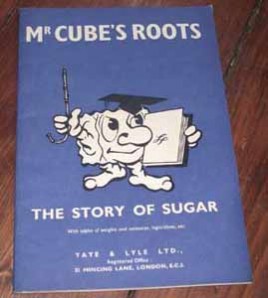
SUCROSE BLOGS FROM HILLSIDE SCHOOL
This is not in FACT a blog from HILLSIDE SCHOOL but more of an announcement on the first morning of SUGAR WEEK of our plans for a potentially excellent category for the pupils to write up themselves. I left the school playground way back in the pre-industrial period when Tate & Lyle Love Lane Sugar Refinery seemed a permanent Liverpool landmark, as irreversible as night and day.
Facts do not speak for themselves and in history there is a “processing process” whereby ORDINARY facts about the past are elevated to the status of historical facts. Who and what decides the applicability of the adjective historical when deciding on the STATUS of past events? There is a great deal about ordinary people’s everyday lives that is never deemed HISTORICAL and which despite the obvious enthusiasms of social and labour historians is hardly ever touched on in the books and articles placed on school library shelves. In how many school history books is there refererence to the FACT that Henry Tate’s mother plant, Liverpool Love Lane, closed down on April 22nd 1981 leaving a big hole in the community, as well as marking the end of over three hundred years of Liverpool links with African, Caribbean and Pacific cane sugar growing countries? What about the “extraordinary ordinary lives” of the boys and girls from the whitestuff who sweetened the nation’s breakfast tables for so long? What about the real story of an achingly addictive drug which is now into its seventh century of global expansion and which to the delight of the food processors and the sugar lobby overcomes the finite limits of the stomach? We seem to not only find room for something sweet but consume “liquid candy” in quantities which pose massive public health problems.
Voltaire cynically suggested that “History was the lie that historians agree upon” and without impugning the profession I belong to and which affords me access to the means of material life, there is always a need to assess the selection and interpretation of evidence and the extent to which it can be BIASED. (Was Voltaire aware of the powers of “spin” way back in the 18th century the era of the Enlightenment?) To paraphrase a good historian I read many years ago, the only completely unbiased historian “is the recording angel but unfortunately his works are as yet unpublished, and even he according to Mark Twain, has opinions which to Satan might appear like prejudices”! Debate and interpretion and the effort to be as objective as is possible, is a maxim that all teachers in all disciplines, not just history are hopefully committed to. That said when it comes to the market place and the versions of “truth” and fact that are relayed about sucrose then the powerful sugar lobbies around the world have candy legs to stand on, especially the claim that their product is NATURAL!
Finally and as a way of introducing some other FACTS which you may or may not agree upon, this is what the BBC news report highlighted as their TOP TEN five years ago! Making allowance for the inclination of Rupert Murdoch’s son to describe it as the BIASED BROADCASTING CORPORATION I personally feel as a license payer that it has more claims to VERACITY than sweets processed by MEDIA MOGULS. Here we go then with our starter for TEN:
Here are 10 quick facts you may or may not have known about sugar, the sugar industry and related businesses.
• In 2002, almost 132 million tonnes of sugar were consumed worldwide. [Source: The ethical sugar organization; iafrica.com]
• Countries in the European Union consumed around 14 million tonnes of that figure. [Source: The ethical sugar organization; iafrica.com]
• The UK consumes around 2.25 million tonnes of sugar per year, about three-quarters of which is sold direct to industrial users, such as manufacturers of soft drinks and confectionery. [Source: DEFRA.]
• The consumption of fizzy drinks in the UK has almost doubled in the past 15 years. Young adults now drink an average of six cans each week. [Source: National Diet and Nutrition Survey 2002, quoted on the Food Standard Agency’s website.]
• The European confectionery market - of which sugar confectionery such as gums, jellies and toffees represents a keen slice - is a significant sector of the European food industry. In the UK alone, a recent report from Key Note estimated the segment to be worth £5.96 billion in 2002. [Source: Food and Drink Europe.com]
• Children in the UK spent £433m on sweets, crisps and fizzy drinks on their journeys to and from school in 2002. This was up from £365m in 2000. [Source: The Sodexho School Meals and Lifestyle Survey]
• A Foods Standard Authority Consumer Survey in 2000 found that only 12 per cent think that labels are very easy to understand. [Quoted in Royal College of Physicians, Royal College of Paediatrics and Child Health, Faculty of Public Health, February 2004]
• The convenience foods sector, has grown by 70 per cent over the past 10 years. It is also the largest sector, with almost £17bn spent on convenience food in 2003. This figure represents a billion pounds more than in 2002, and almost a third - 32 per cent - of the total spending on food. [Source: Mintel]
• British consumers munch their way through 10kg of chocolate per person, each year, well ahead of any other country in Europe. [Source: Datamonitor’, The European Confectionery Market to 2007]
• In 2003, a total of 616 million kg of chocolate was sold in the UK. [Source: Datamonitor’, The European Confectionery Market to 2007]
Story from BBC NEWS:
October 2004

Hillside Secondary School, Bootle takes on the White Stuff in Specialist Science week!
Written by Ron Noon at 22:59 on Monday, September 14th 2009
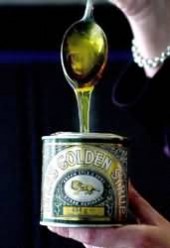
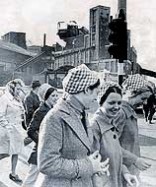
On the school website is this notice:
“This year the theme for the week is ‘Sugar – its impact on Liverpool’s heritage’. The pupils will be developing their knowledge and understanding throughout the week by taking part in a range of cross-curricular activities. We have lots of exciting things planned including; trips to the International Slavery exhibition, work at the North Sefton City Learning Centre, visiting artists and musicians as well as talks from ex-Tate & Lyle workers. It promises to be a ‘jam-packed’ week of creative learning. ‘Out of the strong came forth sweetness’”
When I talked recently to Wendy Daly the Assistant Head teacher about the outstanding results Hillside had achieved she emphasised the extent to which her colleagues were “totally committed to providing pupils with a full range of opportunities in their time with us, and we are determined not to become an exam conveyor”. That said Hillside is now in the top 2% of schools nationally for the “value we add to pupils achievement and attainment” a remarkable accomplishment for a school whose intake is not from leafy suburbs with “obsessively League conscious parents”. (In fact this is an area of severe socio-economic disadvantage and using ‘the school deprivation indicator’ it is approximately in the bottom 4% of all schools. At almost 34% the percentage of pupils entitled to a free school meal is well over twice the national average as is the percentage of pupils with special needs. “Value added” is a classic understatment of the real life choices that ALL pupils at Hillside are provided at the end of their studies.)
Wendy is convinced that their success stems from “having a varied and exciting curriculum which is tailored to the needs of every pupil”. That’s also my understanding of the much used and unfortunately much abused C word, comprehensive! The philosophy behind next week’s curricular perfectly captures that holistic outlook. “Specialist week gives pupils and staff opportunity to broaden their knowledge of a focus area together. We all learn something new during specialist week and the buzz around the school is almost palpable. It really kick starts the new school year and all pupils look forward to it - it has become part of our school calendar and this years is particularly exciting because we are focussing on part of our local culture and helping pupils realise the importance of sugar and Liverpool on the world stage.”
Liverpool John Moores where I teach is very enthusiastic about community projects and Hillside’s is an exceptional one which the University is prepared to give as much support and encouragement to as possible. That’s part of my job but I’ll also be making sure that this website covers the whole school curricular next week. It is not every week that school subjects from maths, science and Information Technology through to drama, English, and Modern Languages focus on the white stuff. (The rumour is of sugar bombs being made in science laboratories but I repeat that’s only a rumour.) Leon Seth may have been the most successful sugar film maker of recent years but he’s got competition from even younger talent looming on the school horizon. It will be brilliant to witness the making of a new film and to read the blogs which the young sweet fighters from “Breeze Hill” will be putting together with the use of the schools IT facilities and North Sefton City Learning Centre. This will be an exciting and challenging week in the life of a truly comprehensive school which just goes from strength to strength.
SUGAR and GLOBALISATION
Written by Ron Noon at 21:29 on Sunday, September 13th 2009
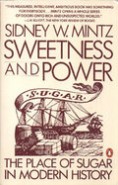
SUGAR AND GLOBALISATION
This is my first blog since late July when although holidaying in North America, I managed to write a short piece about Mr Cube, History’s most famous sugar lump. It was on the eve of his 60th birthday and was duly zapped off into cyber space from a communal computer terminal in a motel in Sacramento, California, just before I boarded an AMTRAK train to Salt Lake City to watch Everton play the MLS All Stars. Those of you not interested in soccer are surely thinking there’s more to SUGAR AND GLOBALISATION than pre-season globe trotting and watching the TOFFEES beat the MLS, albeit in a penalty shoot out, on a barmy hot evening, nearby the Nevada desert!? (“Toffees” is the affectionate nick name of my beloved EFC but the origins of our club lie in St Domingo Road, a telling geographic reference to a sugar island in the tropical Antilles.)
There is indeed much more to follow, and this third web category supplementing ON THE LANE and BEYOND THE LANE, will hopefully add to the interest and wider relevance of our LOVE LANE LIVES project by engaging with some of the debates around GLOBALISATION. They are far too important to be left to professional economists and politicians, especially as an American friend of mine sagely remarked “so much fatalistic globaloney is spoken in its name”! To paraphrase playwright, Dennis Potter “the trouble with words like Globalisation, is that we don’t know whose mouths it’s been in before”!
Our sugar bustin’ website can’t ignore these debates and with the help of technical wizard Warren Keith and the bright filmmaking talents of Leon Seth, there will hopefully be more “multi-media” engagement with these issues before the end of 2009. I’m a “labour academic” who although incapable of putting film in my digital camera, have spent a long time researching “capitalism’s favoured child”, and also redressing the historical amnesia I suffered in adolescence about our great port city and its rich working class history.
That’s Liverpool in case you are new to the site, the sleepy insignificant fishing village that had been eclipsed by Chester for four hundred years after the signing of its Royal charter, but jolted into Transatlantic take off in the late 17th century, by two commodities, sugar and slaves. In the century that followed Liverpool was not only at the epicentre of an infamous chapter in world history, but “globalised” long before the G word was shoehorned into the dictionary.
“Sugar did not create negro slavery…but the gigantic scale of the transatlantic slave trade and its maintenance for several centuries were due primarily to the demand for sugar in Europe and North America.” What was missing from Aykroyd’s comments, (he wrote Sweet Malefactor in 1967), was reference to the unsavoury fact that Liverpool merchants proved the most adept slave takers and profit makers and so the scatterings of millions of black people that constituted the Africanisation of the Caribbean sugar bowl, was indelibly “made on Merseyside”.
This is not local and parochial history. “The history of Merseyside is greater in quality and significance than that of many a nation. To speak of ‘local’ history with reference to the slave trade, the Liverpool-Manchester Railway, the establishment of the port, the Irish immigrations, Gladstone, the development of public health, and a dozen other facets of Liverpool’s story, seems odd, for Liverpool has reflected, more especially since the eighteenth century, not only the national but the international picture.” (1) The links between Liverpool and the sugar world which were broken in 1981 with the closure of Love Lane are an important part of that much bigger global story.
The grass that has changed the world (and mine too) is highlighted in a fascinating book by Henry Hobhouse: “Sugar cane, taken by the white man to the West Indies at the time of the Renaissance and cultivated on plantations by black slaves, (the only people who could work in the climate), was the cause of the infamous transatlantic slave trade, which made the Caribbean black rather than red. All this was for the sake of a product which is wholly superfluous in the diet, a luxury when expensive and a menace when cheap. The brutality of the treatment of the slaves could not possibly be matched by the toothache, the heart pains, or the obesity of the consumer. Yet the consumers misery is undoubted, since after the acknowledged drugs sugar is probably the most damaging of the commonly consumed addictive substances, and is associated with at least one type of cancer… The story is now so well known that there is little need to repeat that sugar, after the illegal drugs, and tobacco and alcohol, is the most damaging addictive substance consumed by rich, white mankind.” (2) Small wonder the French food writer Montignac suggested a skull and crossbones for labelling packets of sugar.
The slave trade and slavery in the British empire long abolished, an early 20th century source celebrated how “today all seas lead to Liverpool, if not as a terminus, at least as an exchange or a clearing house for world wide international transport. There is no part of the globe, however remote, whose natives may not be met on the Liverpool landing stage, and there is no territory so distant whose products do not pass from time to time through the docks and warehouses of Liverpool and Birkenhead. Those passengers and merchandise are, for the most part, en route for other, and often remote, parts; and it is this character of Liverpool as the great traffic exchange of the world that gives the port such a cosmopolitan tone, and that makes its name so familiar in every land and on every sea.” (3)
Before World War, this edgy port city had shipping lines like Cunard which helped make Liverpool and New York the most important landing stages of the 19th century and no part of the “Globe” was unrepresented on either. The Big Liverpool, the Cosmopolitan Liverpool, arguably became the most American of all English cities, and it not only spawned more millionaires than any other city outside of London as it embarked on its Merseypride excesses of constructing the biggest Gothic Cathedral in the world plus “three graces” to adorn its historic waterfront, but demonstrated more starkly than most the contrasts between a wealthy patrician elite and a desperately poor, casualised working class. “At its peak in the years 1880-1899, Liverpool produced as many millionaires as Greater Manchester, West Yorkshire, West Midlands, Tyneside and East Anglia combined.” (4) The Reverend Ackland Armstrong who arrived in Liverpool in 1885 to be minister to the wealthy Unitarian congregation in Hope Street commented that “the contiguity of immense wealth and abysmal poverty forced itself upon my notice…. I had seen wealth. I had seen poverty. But never before had I seen the two so jammed together.” (5)
So much rich food for thought? If three quarters of a century before the term globalisation became common currency, Liverpool was proxy for what is happening today, then a recurring social theme is the shocking one that the rich are still getting richer faster than the poor are getting less poor. When Karl Marx coined that lapidary phrase “the philosophers have merely interpreted the world, the point is to change it” the G word was not in use, but perhaps like all of us who want to change the world for the better we need to grasp our need to understand that world first. We can only do justice to the concept of globalisation and the excesses it is associated with by developing an historical understanding and sense of context, especially now that it has moved from the rareified atmosphere of the academic seminar room into popular parlance?
Invariably you will not have to search too far to find suggestions that the micro-electronics revolution has irrevocably changed our world, indeed changed the nature of human contact on Earth. There is talk of “time-space compression” and other jargonistic phrases that emphasise how distances are shrinking and information is spreading faster than ever before. (The “Atlantic ferry” crossing mentioned earlier, represented a conquest of time and space in its day and it was brought about not by Gerry Springer but by the substitution of steam for sail!) Of course the Pheonix night “tinternet” and the World Wide Web have helped this process, enabling business to communicate more smoothly and efficiently but have they narrowed the social distances between rich and poor? Do we really talk more to each other?
Wayne Ellwood in a stimulating book entitled The No-Nonsense guide to Globalization, published in 2001 argued how “there is little doubt that ‘globalization’ is the buzzword of the moment, the most talked about and perhaps the least understood concept of this new millennium”. What it describes and what our case study of sugar will demonstrate is that Globalisation is not just a late 20th century phenomenon? (Six centuries of global expansion make the products of Bill Gates pre-pubescent.)
“The entanglement of diverse cultures and economies now known as globalization, has been spreading for centuries and the world has been shrinking as a result. In that sense it is an old story…But the ‘old story’ of globalization today has developed a new twist sparked by the rapid rate of technological change over the last 25 years.” Elwood.
You can hear the punter exclaim “Well it’s gorra be technology ‘anit?” Superficially that appears to be the case but my experiences of teaching on the Open University Social Sciences Foundation course DD100, suggest the need to curb the “breathless tone” of those who hype technology, technology, technology! (More commentary about the OU and sugar will crop up in future blogs.) “Global culture is disseminated via an increasingly complex network of distribution technologies. So technology is commonly implicated in debates about the burgeoning global dissemination of culture. As well as being prominent in debates about globalisation, technology is seen by many as the defining characteristic of the contemporary era. Across the full breadth of social spheres and institutions – work, family, leisure, education and even the construction of identity – technological developments are seen as enormously significant for processes of transformation. According to this ‘information society’ thesis, information technology is the key feature of the contemporary social order, and information flows and networks lie at the heart of its organization.” (6)
This is where students have to be warned of the dangers of an information rich and knowledge deficient society, and that we are a long way from an instant K Knowledge society. Information overload and easier access to WIKIPEDIA is not the real K! There is also here another important warning about the dangers of Technological Determinism and the assumption that societies are indeed determined by their prevailing technologies. The argument goes like this: The common place expressions of “the stone age”, “the steam age”, “the computer age” convey the notion that the technology, stone, steam or computers is responsible for the dominant social characteristics of the era being discussed. The form of social organisation, hunter-gatherer society, the industrial revolution or the information society is read off from knowledge of that dominant technology. Technology is seen as the driving force of history.
TECHNOLOGIES are shaped by SOCIETY in the first place. The computer and communication technologies did not come from the ether, nor are they the result of some abstract genius on the part of their inventors. THEY CAN BE SEEN AS A DIRECT OUTCOME OF THE COLD WAR. – THE RESEARCH AND DEVELOPMENT BUDGET OF THE US DEPARTMENT OF DEFENCE. Society in the shape of the Cold War shaped the technology not the other way round. William Greider (7) provides details about the origins of the New Revolution that we are going through. The findings of two Americans working for two different companies discovered the integrated circuit or silicon chip which is the emblem or logo of the ‘global’ revolution. Economic revolutions always originate with the invention of a new power source. This one can be dated ‘quite confidently as the autumn of 1958 and early 1959”. Within a few months of each other Jack Kilby at Texas Instruments, and Robert Noyce at Fairchild Semi-Conductor arrived at the same breakthrough the silicon chip. They conceptualized the device that inscribes electronic circuitry in a tiny space much too small to see. This has become exponentially smaller as technology has continued to perfect the idea - the new integrated circuit was the inventive watershed of this revolution - fabulous powers of memory and complex calculation.
Clearly technologies do have profound effects, always have, but those effects are not pre-ordained. They are not built into the technology but are very much a consequence of how the technology is introduced. In making such a big thing of the technology (“reifying” it as the sociologist would say and forgetting the politics of the cold war period as with the example above), people fatalistically forget about choices and how that thing called Society is crucial to the decision making process. Does technological change have to lead on to redundancies? Do we all have to become croppers? (That expression is frequently used but how many know its genesis or why Luddites were not always Luddites! Sorry for the riddles but this is an experimental blog on a new category that will have to throw up questions about the T word.)
Here’s another riddle to resolve. What then “new technology” did this next extract hail?
“The celebrations that followed bordered on hysteria. There were two hundred-gun salutes in Boston and New York; flags flew from public buildings; church bells rang. There were fireworks, parades, and special church services. Torchbearing revellers in New York got so carried away that City Hall was accidentally set on fire and narrowly escaped destruction. ‘Our whole country’ declared Scientific American ‘has been electrified by the successful..?”
If you are struggling we’ll give you another clue:
“It revolutionised business practice, gave rise to new forms of crime, and inundated its users with a deluge of information. Romance blossomed over the wires. Secret codes were devised by some users, and cracked by others. The benefits of the network were relentlessly hyped by its advocates, and dismissed by the sceptics. Governments and regulators tried and failed to control the new medium. Attitudes to everything from newsgathering to diplomacy had to be completely rethought. Meanwhile out on the wires, a technological subculture with its own customs and vocabulary was establishing itself.”
So what technology and when? Hopefully this example illustrates that it is not only today that new technologies are greeted with excessive claims about their revolutionary significance and the fanfare that a new society is being heralded. (Will someone please convey the answer to our website comment column? The “owner” of the first correct answer will be rewarded with a bag of cane sugar and will have convinced me on this lovely sunny Saturday afternoon, that there are intelligent people outside the blogosphere, and my Summer House/garden shed, and Anfield, [it’s now just after 4pm and we don’t kick off for another 24 hours], building up really useful knowledge.
I’m conscious of having gone on for far too long with this blog, but while rambling on about technology we could consider the fact that the “tiger in the tank” that drives cars in Brazil is produced from sugar cane and that this non-food use for sucrose, from an annually regenerable crop, has resulted in many “breathless toners” forecasting that this plant could save the world! Let’s leave the hype and illusions there and maybe come back to flex-fuel cars and sugar in a later blog. The most important thing about my subject HISTORY and its relevance to studies of globalisation which have often have lacked that vital context and chronology, is that we do try to work out why déjà vu is not just a Crosby Stills and Nash album!
One of the most important bits of advice I give my students is not to develop the memory at the expense of the intelligence but think the details through and arrive at what I heard an American trade union leader sagely describe as glittering generalisations! (Where are the GGs?) With such a complicated phenomenon it’s hardly surprising that many people are generally confused and rudderless in understanding and comprehending all the talk about globalization but some like UAW President Owen Beiber speaking to Chicago businessmen on May 4th 1992 have grasped one very obvious GG about what it often means for organised labor (American spelling! So is it globalization or globalisation?) “I’m getting a little sick of hearing the word ‘global’. I’m sick of global competitiveness.” Maybe on the eve of the TUC annual conference in Liverpool this view will have some resonance.
There is much complexity and detail which makes it difficult to “get a handle” on the G word. That said we need to think the details through and search for the GGs. That is how we will get to “unpack” and understand this concept and whether we like Beiber get a “little sick” of hearing its mantra like sounds from politicians who argue TINA like, that there is no alternative to adjusting to global market forces! Perhaps Beiber like the other American trade union leader whose name escapes me, had read from an enlightenment philosopher who thought that “meaningless details in history are like the baggage of an army: impedimenta; one must take the wider view”. That was Voltaire writing in the 18th century and towards the end of last century William Woodward recommended that “In seeking to understand the totality, complexity and diversity of the past” the focus has to shift “from the parts to the whole, from the trees to the forest”. Perhaps he plays in a band called the Holistics, but with not far short of 7 billion on the planet and global meltdown much more than a futuristic sci-fi film scenario, they are the best live band around today The guiding principle is that only in historical terms can we “ever hope to understand the metamorphosis of the modern world”. And to save it!
Sometimes the “language” of the intellectual needs to be leavened out by not just a little levity but by a more chatty, conversational style of communication which presumes people’s intelligence and ability to grasp words that reflect real meanings, not just technical jargon. History is probably the least jargon ridden subject in the social sciences, (although none of us are unaffected by it), but the public role of historians is to build on those communication skills and make good analytical narrative history more easily available and accessible.
That is not to trivialise serious debate, or dilute the “academic labour process”, or the work of ostensibly more theoretically orientated social sciences like economics and sociology, rather it’s to try to irradiate commentary on difficult subjects with common sense and broader perspectives. There are dangers in the colloquial as we’ve discussed in relation to technology where “you can imagine some Alf Garnett of the 21st century, splitting vowels and spitting bile over the very word. ‘Well it’s yer globalisation, innit? All those bloody huge companies, hand in glove wiv the World Bankers, runnin’ riot all over the place, settin’ up an closin’ dahn wherever they bloody well feel like it’.”
That was Pat Kane amusingly reviewing Globalization: The Human Consequences by Zygmunt Bauman a few years before the banks came a tumblin’ down, and taxpayers took over from the Bank of England as “lenders of last resort”. Bauman’s a brilliant academic but he’s not an easy read and that again emphasises the importance of “public intellectuals” and “public historians” going busily about their business of reaching a much wider audience than the academy and Guardian and Independent readership.
Failing that “there are 3,300 books in English in print on the subject of globalization. Add to these 700 recent French titles on mondialization, 670 on globalisierung in German, and hundreds more in Russian, Arabic, Hindi, Chinese, Spanish and other languages. In all, there are over 5,000 titles in print on globalization. It’s a crowded field” says Alex MacGillivray in a “A brief history of Globalisation”! But how many references are there in this crowded field to SUGAR? (8)
According to Anthony Giddens, Globalisation is a word that has come from nowhere to be everywhere. My unorthodox way of unpacking the term and ignoring the breathless tone of those who eulogise technology, time space compression and gismos and gadgets, is to place it in more fitting historical perspective, and to deliberate on the story of capitalism and its favoured child, sugar! And why not? Sugar, just like the G word has come from nowhere to be everywhere and its ubiquity provides a great example of how a simple too much taken for granted everyday commodity has a complicated social history, that nonetheless provides clear insight into the drivers that still operate in the world economy today. Sugar is a great example of an intensely political product that links the story of agriculture and agribusiness to the inexorable logic of world food markets today.
For me the “empty calorie” offers more food for thought than nutrition but is always an important reminder how production under capitalism is driven by want not need, wealth not health! Looking around today at the global warming of our one world and the stark evidence reflected on earlier, that the rich are getting richer faster than the poor are getting less poor, agitates a final bitter sweet thought about the 500 year old system which reduces human beings to commodities and costs of production at the end of the day! There’s a great line in the poem Augeries of Innocence by William Blake “to see the world in a Grain of sand”! (9) In the words of an inveterate sugar bore of no poetic ability, but who like Blake is addicted to a drug, (albeit a legal one), I can see a world of capitalism and greed in a granule or cube of sugar! I hope I’m not the only one.
References
1. Eric Midwinter Old Liverpool 1971
2. Seeds of Change: Six plants that transformed mankind (1999) page xv & 59
3. Liverpool and Birkenhead in the Twentieth Century: Contemporary Biographies Edited by W T Pike Publishers: W.T.Pike & Co 19, Grand Parade, Brighton 1911 Pike’s New Century Series
4. Tony Lane Gateway to Empire pps 54,55.
5. My Secret in the Stone pamphlet 2004
6. Hugh Mackay page 79 in the OU text on Globalisation
7. One World Ready or Not: The Manic logic of Global Capitalism
8. Alex MacGillivray A Brief History of Globalization
9.
To see a world in a grain of sand,
and heaven in a wildflower,
hold infinity in the palm of your hand
and eternity in an hour
The AMTRAK view of Mr Cube on the eve of his 60th birthday party
Written by Ron Noon at 15:42 on Monday, July 27th 2009
My wife and I are having a great holiday over in North America. We travelled down from Vancouver with our friends Mally and Sue Jones on AMTRAK on Friday and arrived in Sacramento on Saturday morning about 6.30am. The weather is scorching and we’ve had a great time but the journey is not finished. We will be picking up the train again in a couple of hours to journey across to Salt Lake City, arriving there in the early hours of Tuesday. On Wednesday my other addiction (Everton Football Club) will be serviced by tickets for the MLS All Stars against EFC. My friend Mally is a red and he said he is wearing his no 9 shirt. I don’t even know who their number 9 is!
Anyway all this holidaying leaves little time for Mr Cube and my wife has given me a final GAIL warning to stay off this machine. (This is being typed in the Vagabond Inn Sacramento and my wife is still at breakfast so I better be quick!) Anyway in a special beyond the Lane blog here are some final thoughts on the significance of Mr Cube’s 60th birthday.
August Cochin wrote that “The story of a lump of sugar is a whole lesson in political economy, in politics and also in morality”. I suggest that his 60th birthday party is a great opportunity to examine the “once favoured child of Tate & Lyle” and to reflect on some of the lessons in political economy, in politics, and also in morality, that he championed in his youth.
On July 28th 1949 Mr Cube first appeared in the Evening Standard but in subsequent months it was his campaigning on behalf of free enterprise sugar and Tate & Lyle that drove Peter Mandelson’s grandfather, Herbert Morrison, Deputy leader (!) of the old Labour Party to apoplexy and arguably was responsible for a landslide majority of 186 registered in 1945 being cut to 6 in January 1950. I think that his imminent birthday party (Tate’s claim they retired him ten years ago!) is a good opportunity to reflect on how this sugar cube champion of capitalism and free enterprise is emblematic of the New Labour zeitgiest!
Two years before Bobby St John Cooper’s invention of Mr Cube Fernando Ortez suggested that sugar was “capitalism’s favoured child” and this simple taken for granted everyday commodity is a unique exemplar of capitalist commodity production’s dominant theme, of want not need, wealth not health! There is no biological need for an empty calorie in such concentrated chemical composition either as granules or cubes, and until the era of Christopher Columbus and his second trip to the Antillee islands of the New World where he transferred sugar cane from the islands off the coast of Africa, world and human history had largely been sugar free! Now in its seventh century of global expansion, it makes the products of Bill Gates, especially now that non-food uses as bio-fuel, are opening up, seem pre-pubescent.
My bitter sweet story is not about the era of sugar and slaves and imperial rivalries dictated by the lure of “white gold” and Europe’s insatiable appetite for sweetness, but about the last 60 years and particularly 1949 and 1950, classic years of austerity and food rationing, when British housewives were all too keenly aware of the missing sweets and treats of life. Sugar was both fact and metaphor for so much that was promised but missing from that grey era of interminable queues and “rations points consciousness”.
Mr Cube is a symbol of electoral embarrassment for the British Labour Party and forty five years after that astounding 1950 election result and the abandonment of Labour’s plans for nationalising sugar, a Tony Blair led Labour Party was posturing not towards its traditional union allies, but towards business friends including Tate & Lyle. Herbert Morrison would turn in his grave, but the zeitgeist in 1995 two years before Tate & Lyle made its first political donation to the Labour Party was of a New and contemptuous of Old Labour party, busy exorcising the demon of nationalisation threats, which conceived Mr Cube.
It appears supremely ironic that an alliance was subsequently forged with arguably its greatest ever business foe, resulting in the first corporate donation from Tate & Lyle to the Labour party, just before the 1997 General Election. This was more than just a pecuniary measure of the transformation of the Labour Party in Albert E Sloane’s lifetime. Neil Shaw the company chairman would tell the Committee of Standards in Public Life “how he began his love affair with Blair” and how “he introduced Tony as a speaker at a meeting of Prince Charles’ Business in the Community, in early 1995”. Shaw who would later be replaced by ace American union buster, Larry Pillard, noted “that his company had not always been a friend to Tate & Lyle, but that all this would change when the party’s new leader got rid of Clause IV”!
With echoes of Phillip Snowden and Montagu Norman, they embraced each other “like kindred lizards”. Blair even suggested that he ‘might use Mr Cube to help him destroy his party’s commitment to public ownership”. Was there ever really a prospect of this cartoon slayer of socialists being sub-contracted to Peter Mandelson, or appearing on the party’s headed notepaper as the symbol of a clauseless IV, free enterprise loving New Labour?” I’ve got a train to catch.
................................
The Litigious consequences of Mr Cube
Written by Ron Noon at 17:00 on Tuesday, July 21st 2009
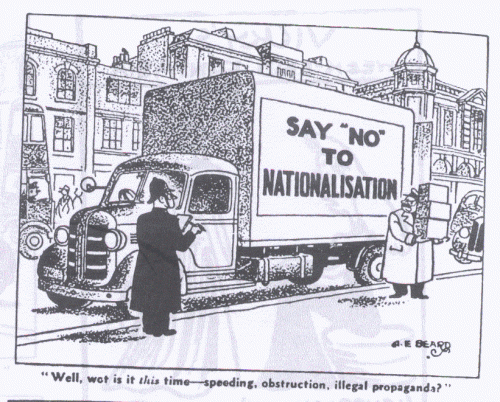
THE LITIGIOUS CONSEQUENCES OF MR CUBE
Below the signature on Albert E Sloane’s letter from John Walker announcing the junking of the biennial Christmas parties, was an impertinent cartoon figure called Mr Cube, who fifty years earlier reached his apotheosis in an amazingly successful campaign resisting Labour party plans to nationalise the sugar industry. The iconic status of an animated sugar lump, armed with sword and shield of “free enterprise”, seared itself into the consciousness of a generation that grew up with his swashbuckling image and the bitter sweet messages projected onto packets of sugar.
Cube provided real “political food for thought” especially for housewives in that austere era of queuing and rationing, with warnings that nationalisation threatened “dear, dear, dearer” prices, and “State control will make a hole in your pocket and my packet”. The most effective of his sound bites were “Take the S out of State” and the lapidary “Tate not State”, which allegedly agitated the deputy Prime Minister, Herbert Morrison into near apoplexy. The glittering campaign was all American turbo charged public relations, orchestrated by Tates PR consultants, the right wing propaganda group Aims of Industry.1
Before Mr Cube’s appearance on the “Kill Christmas letter”, I knew little about History’s most famous sugar lump but was prompted into conducting this research by a comment from Albert that by stealing Christmas from the Liverpool boys and girls from the whitestuff, Mr Cube ought be stripped of his sword and shield and made to wear a Scrooge hat with matching ball and chain! Not long after, I serendipitously discovered how after Cube’s first appearance in the Evening Standard on July 28th 1949, the command from Leonard Lyle, the President of Tate & Lyle, and a close friend of Opposition leader, Winston Churchill, was that he “must always be a knight in shining armour” and never “a psalm singing little bugger”! 2
Albert viewed him precisely as that. In fact towards the end of 1949 when Tates requested its employees to propose their own slogans for Cube’s sugar packets, this delightful lifelong socialist, who registered his first vote for Clem Atlee in India in June 1945, came up with the counter hegemonic slogan which needs rescuing from the enormous condescension of business history: “Tate & Lyle have made a pile, give it to the rank and file”!
It is so often revealing how political “non-political” people eventually turn out to be and that applies to animated sugar cubes, with similar protestations. Mr Cube’s campaign to slay the socialist hydra will always epitomise political embarrassment and electoral set back for the most radical of Labour governments, as well as providing Tates with a logo that brought them considerable commercial and media benefits. Even when talk of sugar nationalisation was ancient history, Cube was still brandishing his sword of “free enterprise”, and holding aloft the company shield, on billboards, lorries, and millions of sugar packets and tins of Lyle’s Golden Syrup. Before Cube, Tates had no brand image, no mascot, no punchy catchphrases and very little of what advertisers today call “conceptual value added”.
The exception was the “honeylike” Lyle’s Golden Syrup, where right at the front of the tin appeared an emblem of a dead lion festooned by bees, positioned above a biblical inscription, from Judges 14:18, alleging that “out of the strong came forth sweetness”. The source of sweetness was honey but that did not matter to family director Tony Tate who confirmed in 1968, “if you think this is honey, OK”!3 In the marketing world where historical veracity is not at a premium that is still OK, and Tates ever more alert to new sources of conceptual valued added, undertook an historic re-branding exercise at the beginning of the new millennium.
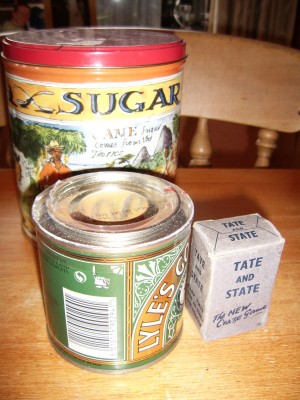
Supremely ironic was the fact that it was premised on the commercial euthanasia of a cartoon sugar lump and a Lazarus like re-launch of an old leonine emblem. The company web page notes that after 50 years of dedicated service, Mr Cube opted for retirement in 1999, (no reference there made to whether it was voluntary or compulsory and accelerated by the issuing of the “Kill Christmas” letter), and that his place has “now been taken by Lyle the Lion, who runs the ‘Cook with Lyle’ club”.
With the help of celebrity chef Gary Rhodes the club intends to provide children with recipes and great entertainment which akin to the national curriculum rules out any critical engagement with the nefarious history of the white stuff. “Smile, it’s Tate & Lyle” should not however be allowed to eclipse the fact that sugar has always been an intensely political product and despite company denials, State and Tate were inextricably linked from the end of the First World War onwards.
The company became traditional friends of the Conservative Party, a silent partnership which was only challenged by Atlee’s plans for nationalisation. The descriptions of Tate and Lyle as a privileged private monopoly engaged in political campaigning to reverse government policy, were sharply rebuffed by its directors, but this was as unconvincing as its international reputation for high efficiency and low costs was genuinely persuasive.
In the run up to the “dead heat” February 1950 General Election, the fight against increasingly unpopular Government policy was centred around the nationalisation of the refineries and Mr Cube proved a very adept friend of the Conservatives and their supporters in Fleet Street. Anthony Hugill a member of the Company strategy team reminisced at the end of the 1970s how the campaign was “not Tate & Lyle’s, nor Lord Lyle’s, but Mr Cube’s”.4 This was remarkable in an era devoid of electronic and instant communication media, when mass communications meant the press and “BBC steam radio”.5
There were many other issues at stake in the Election battle and although it would be impossible to calibrate the precise psephological consequences of the fight for free enterprise sugar, a 1945 Labour landslide of 186 was reduced to 6 in February 1950 suggesting it was hardly uninfluenced by Mr Cube’s campaigning. But forty five years after that astounding result and the abandonment of Labour’s plans for nationalising sugar, a Tony Blair led Labour Party was posturing not towards its traditional union allies, but towards business friends including Tate & Lyle. This would have made Peter Mandelson’s grandfather, Herbert Morrison turn in his grave, but the zeitgeist was of a New and contemptuous of Old Labour party, busy exorcising the demon of nationalisation threats, which had hastened the birth of Mr Cube.
For me it is supremely ironic that an alliance was subsequently forged with arguably its greatest ever business foe, resulting in the first corporate donation from Tate & Lyle to the Labour party, just before the 1997 General Election. This was more than just a pecuniary measure of the transformation of the Labour Party in Albert’s lifetime. Neil Shaw the company chairman would tell the Committee of Standards in Public Life “how he began his love affair with Blair” and according to Stephen Hughes writing in Red Pepper, “he introduced Tony as a speaker at a meeting of Prince Charles’ Business in the Community, in early 1995”.6 Shaw who would later be replaced by ace American union buster, Larry Pillard, noted “that his company had not always been a friend to Tate & Lyle, but that all this would change when the party’s new leader got rid of Clause IV”! 7
With echoes of Phillip Snowden and Montagu Norman, they embraced each other “like kindred lizards”. Blair even suggested that he ‘might use Mr Cube to help him destroy his party’s commitment to public ownership”. Was there ever really a prospect of this cartoon slayer of socialists being sub-contracted to Peter Mandelson, or appearing on the party’s headed notepaper as the symbol of a clauseless IV, free enterprise loving New Labour? My research to date including the account below has proved that in the too much taken for granted world of sugar, truth is often stranger than fiction:
“The story of a lump of sugar is a whole lesson in political economy, in politics and also in morality.” 8
In November 1952, the Solicitor General, Sir Reginald Manningham Buller QC, addressed the High Court of Justice on the political antics of a cartoon sugar lump which had brazenly challenged electoral law and Inland Revenue regulations. “The only question which falls for your Lordships determination is whether certain expenses incurred in a propaganda campaign against nationalisation of the sugar refining industry - a campaign which I think was generally known by reference to Mr Cube - is an expense ‘wholly and exclusively laid out for the purposes of the trade’ within the meaning of Rule 3a of Schedule D.“9
Mr Cube with his “huge eyes and a face able to depict any kind of emotion” 10 was a product of the fertile imagination of former Daily Express cartoonist, Bobby St John Cooper, and would say and get away with the most outrageous things. According to Peter Runge, campaign strategist and later, President of the Industrial Society, he permitted Tate & Lyle, an imperial sugar company with plantations in Jamaica and Trinidad, to “concentrate on attacking the Socialist policy” of nationalisation “in a somewhat more dignified manner”. 11 Mr Cube’s cold war sound bites appeared on millions of sugar packets that landed on the nation’s breakfast tables, and galvanising other industries into protesting against meddlesome bureaucracy.12 This also sharpened the ideological divide between Labour and Conservative politicians over the role of the state in post-war economy and society.
The argument developed here is that just like the nefarious commodity which he animated in comic strip form, Mr Cube was deeply and irrefutably political and in December 1949 Sir Stafford Cripps, the Chancellor of the Exchequer, reached the same conclusion that Herbert Morrison had reached earlier. The campaigning on behalf of the company founded by Sir Henry Tate, the wealthy Victorian philanthropist and patron of the arts, was political and expenditure for political purposes could not be deducted in computing profits for tax purposes. The adjudication was subsequently confirmed by HM Inspector of Taxes at the Board of Inland Revenue initiating a litigious chapter in the dazzling career of Albert’s “psalm singing little bugger”.
Aims of Industry (AOI), Tates Public Relations (PR) agent, were known as “PR storm-troopers”, 13 and a Blitzkrieg was duly launched on the party manifesto Labour Believes in Britain, in April 1949. AOI believed in free enterprise and had been set up in 1942 when HG Starley of Champion Sparking Plugs Ltd called a meeting of top industrialists and warned them to be prepared to launch an offensive against socialism. It was sustained by contributions and support materialising from a variety of lucrative sources including Associated Electrical Industries, Cortalds, Doulton, English Electric, Ford Motors, Handley Page, Imperial Chemical, Rolls Royce, the Cement Marketing Foundation and of course Tate & Lyle.
Despite unprecedented PR, deploying the best and the slickest of American methods and techniques, Lord Lyle the company President, affectionately known to journalists as Lord Cube, a former Conservative MP and close friend of the leader of the Opposition, Winston Churchill, defiantly declaimed his protégé as non-political. His skills as an orator and his “earthy realism and wit” made him a formidable thorn in the side of Government ministers and as company biographer Phillip Chalmin suggests, he would if necessary resort to “demagogy and calumny” in defence of his industry.14 The Lord who reigned over Mr Cube, indeed he was described as his spiritual godfather, defiantly insisted that the campaign expenses were “wholly and exclusively laid out” for the legitimate purposes of defending the industry.
Such advertising was patently not designed to win votes for Labour and coincided with revived Conservative electoral fortunes. “Set the people free” a slogan canvassed by the Daily Express in the wake of significant Tory gains in the local elections of 1947 was readily translated into a “freedom agenda” by Churchill which undoubtedly benefited from the imprimatur of this champion of free enterprise sugar! So when the polls closed on February 23rd 1950 Mr Cube had not only conveyed his final “non-political” message along with the cornflakes on the nations kitchen tables but registered a largely understated contribution to the Conservative recovery from a Labour majority of 186 to just 6!
Few general elections according to HG Nicholas “have cast their shadows for so long before” and this supposedly non-political campaigning made significant electoral impact months before Clem Attlee’s “unusually long notice of dissolution” of Parliament on January 11th 1950. 15 The Tories claimed that this early announcement was deliberately timed “to embarrass all the private champions of industries threatened with nationalisation” who could no longer insist that “their propaganda was ‘outside’ the election"16 but it did not deter Mr Cube. Exasperated Government Ministers claimed that Tates were breaching the 1948 Representation of the People Act, and its strict rules on election expenses.
Imposing a ceiling on electoral expenditures was intended as a means of checking private wealth unduly influencing public opinion. The Tariff Reform League at the turn of the century indulged in election mischief by supporting and carrying on intensive campaigns for select candidates and then claimed that because “they were not members of either the Liberal or the Conservative Party” their expenses could not be charged against the candidate”. Section 42(1) of the 1948 act was designed to prevent this chicanery by “restricting expenditure by ‘outsiders’ in support of a particular candidate at an election”. Chuter Ede the Government Minister speaking at the Committee stage of the Bill, reminded MPs that “anyone who has had experience of fighting an election, knows well what is aimed at”, 17 but by December 1949 the influence of “outsiders” like Tate & Lyle and Aims of Industry was unchecked.
Their free enterprise messages were indulged by a free press that portrayed the devoutly Christian Cripps, as a bully over the tax expenses issue. His colleagues, Deputy Prime Minister Herbert Morrison and Attourney General Sir Hartley Shawcross, both of whom had railed against the influence of big business propaganda and the breach of electoral law, confronted similar opprobrium. Their “scarecrow” tactics failed and even the stern warning to Tates and AOI delivered by Morrison a few days after Attlee had announced the election date, “to be especially careful” and if the law were in doubt to “err on the side of keeping it” 18 was blatantly ignored. Paradoxically Labour’s first Jubilee celebrations, planned for the second to the fifth of February 1950 were cancelled by Clem Attlee, and despite official denials it seems that “the expenses incurred might have been adjudged a form of election propaganda”. 19 That was why Mr Attlee not Mr Cube erred on the side of caution. No cases were brought either before or after the General Election and so the meaning and scope of 42(1) of the Representation of the People Act unlike Rule 3a of Schedule D, was not subjected to judicial appraisal.
Aims of Industry was a non-profit making PR organisation selling private enterprise ideals while cunningly registered as an educational body! Together with another PR group, The Economic League, they persistently refuted Labour allegations that they were political. This actually helped secure admission of its speakers and films to schools, churches and even armed forces study groups! For right wing propaganda to be purveyed as a legitimate educational project was especially galling to Socialists desperately needing to win the battle for hearts and minds at a time when common cause and common sacrifice was impossible to recreate as vindication for a post-war world of “unnecessarily” prolonged austerity and shortage. Sydney Finer writing in 1956 suggested that AOI and similar groups were only non-political “in the technical sense…that they are not affiliated to the Conservative Party nor do they subscribe to or receive subventions from it”. 20 They were “Specialized Propoganda Organizations of private Capital”, unfettered, unlike Government, by the “constitutionalist” dilemma over what to advertise and its financing from a restricted and constantly scrutinised public purse. Politically active client companies like Tates were always able to deny their politics precisely because of the success of this combative propaganda.
AOI were dubbed “underground Tory organisations” but this was technically incorrect. The Home Secretary Chuter Ede speaking in the House of Commons in December 1949 referred to a letter he had received from 48 Guilford Street, the Luton office of AOI which was “the side entrance to 58 Bute Street, a Tory Office”. 21 A search for AOIs telephone number educed “the statement from directory inquiries that this organisation is not known to them” but “it is possible to obtain them by ringing Luton 4500 which is the same number as the Tory Office”! 22 The Tories unlike Labour’s later problems with “deep entryist” Trotskyist organisations, wisely left the side door open to covert friends.
Brandishing the sword of free enterprise and appealing directly to housewives for whom food and consumption issues were of far more importance than the abstract battle for production and export markets, Mr Cube was lauded for standing up to bullying Government Ministers. The stoicism and selflessness that was disproportionately borne by women in mediating post-war austerity measures meant that they were more interested in their point in the interminable queues than Government points about the need to prioritise exports, and investment in production. As Ina Bargielowska’s work on austerity demonstrates, for many foodstuffs including sugar, pre-war consumption levels were only reached in the 1950s after the abolition of rationing and controls. 23
Food and consumption matters have been eclipsed in the historiography of the period by production issues and too much emphasis on the economy’s “Commanding Heights”. This has downsized the significance not only of Mr Cube’s campaigning but a commodity, which as its sullied history verifies, is arguably the most political of all foodstuffs. The insistence that sugar refining was not one of the economy’s commanding heights also ignores the fact that housewife dissatisfaction and low “food morale” translated much more quickly into the politics of everyday experience than say the much more vaunted politics of steel nationalisation. This is what Peter Hennessy was keenly aware of in researching Never Again: Britain: 1945-1951. Rationing meant “a very boring diet” and “the pleasure that an occasional ‘off ration’ treat must have brought” was as understandable as “how an entire nation could become obsessed with food”. 24
The ire of Labour leaders helped rather than hindered Mr Cube’s campaign endowing him “with the sympathy always reserved for the mechant animal defending himself against a bullying Leviathan”. 25 Rogow points out that of the twelve national morning and evening newspapers “with a total circulation of almost 19 million” there were two with a circulation of almost six million “that were reliably committed to the Government’s support”. 26 They were incensed and claimed that the Company was using its monopoly position “to force the housewife to buy Conservative and anti-Government slogans”.27 Tates despite the representation of “free enterprise sugar” and Mr Cube’s persuasive rhetoric was in reality a tariff protected private monopoly that had benefited disproportionately from Winston Churchill’s 1928 budget.
Before Britain was forced to abandon free trade policies one of the 20th century’s greatest political line dancers and free trade imperialists, was instrumental in securing for the refiners price discrimination against imports of refined sugar. (Five years before his Damascene conversion he stood unsuccessfully as a Free Trade Liberal in Leicester West!) Labour’s Shadow Chancellor, Phillip Snowden was so incensed he accused Churchill of being in the pockets of the refiners! A sympathetic company biographer Phillipe Chalmin argues that in 1949 “it controlled - directly or through its influence - the British sugar economy”. 28
The help of a largely Conservative press in bloodying Labour’s nose in February 1950 was recognized by Anthony Hugill, who like Peter Runge was a shrewd strategist in the campaign. His gratitude was extended to Government adversaries as they were the ones responsible “to a very great extent for the sudden and overwhelming success of Mr Cube”! Some of their assertions “on sugar refining” and “election expenses” had informed the public “to an extent which we could never have achieved without their aid, and all of this without having to pay them any plugging money”!
AOI claimed that British industry had received press publicity worth more than £1,800,000 or 93,178 column inches. “But it has n’t cost a tenth of that amount. News about the achievements of private enterprise and the failures of nationalization and State control has been of sufficient value to editors for them to have given it space in their columns free”. 29 Free newspaper column inches helped increase the number of features on sugar from 200 in August to 1800 at the end of 1949. And then “just to cock a snook at Mr Morrison and his colleagues, Cube appeared on packets timed for delivery over Christmas 1949, wearing a paper cap lifting a glass and saying ‘Whatever the Party, we wish you a merry Christmas”! 30. Fifty years later, on the threshold of his own retirement, Mr Cube donned his scrooge uniform and departed from public engagements as the “psalm singing little bugger” that had given his imprimatur to the junking of Christmas in Liverpool Love Lane!
In December 1949 he appeared as the knight in shining armour whose seasonal greetings were conveyed in an austere political climate. For those however who argued that there was an alternative to this policy of continuing austerity, Mr Cube was the proxy voice. He symbolised the fact that there is always far more to food than nutrition! Indeed the government’s nutritional adviser commented early on in the post-war period that “because meals, have become so much more unattractive…people will not eat sufficient to eat their daily energy requirements”.31 It is that psychological context and the reminder that sugar was both a fact and a metaphor for the sweet things in life conspicuously absent, despite improved vital statistics, that provides the key to understanding the politics of food discontent.
Bargielowska reminds us that although there was no objective evidence of under-nourishment “perceived deprivation was intense”. 32 A cameo of this early predilection towards the good life as the sweet life was the experiment in de-rationing sweets. When carrots were sucked by children as sweets, Pathe News recorded the events in April 1949 that were designed to “put the fun back into being young” with its film footage of tiny tots queuing in anticipation of sweet shops opening up with their de-rationed goodies.
“Tots mouths have watered a whole lifetime for this great day. For years they’ve been cheated by the hard facts of world economy, from the unrestricted orgies, once accepted as the birthright of every child. But now hundreds and thousands are back by the billions, sherbert and gobstoppers and aniseed balls, lollipops and chocolate bars. And now for the Tummy Ache of a lifetime.” The anticipated epidemic of tots tummy aches was prevented by killjoy Food Minister John Strachey who did not build up sufficient stocks to meet the pent up demand and failed “to take into account considerations such as the present high cost and shortage of tobacco, the cut in our meat ration and our dull diet”. 33 The disappointing result was that unlike France, Holland, Belgium, Luxembourg, Poland, Switzerland and Eire, Labour Britain botched the experiment in assuaging dietary severity with sweets. Consequently when “treats” like sweets were re-rationed the sweet fightin’ icon of free enterprise was a permanent reminder to contemporaries that there were choices and policy differences between the political parties.
Tory historians need to acknowledge their ideological debts to their class warrior, Mr Cube, because in the wake of the People’s War and the pronounced egalitarian shift in political culture, the Labour landslide of July 1945 symbolized more than a huge majority and electoral devastation for the Conservatives. Viscount Hitchingbrooke pronounced it a “philosophical disaster”, boding ill for a party visibly stained by privilege and rank, and haemorrhaging from an almost terminal sense of decline. They had been routed and the fear “was not that the Conservative Party had missed its turn - any politician can live with that - but that it would never get another”.34 Their revival was largely orchestrated by the administrative reforms introduced by Party Chairman Lord Woolton, formerly Sir Frederick Marquis and a great success as wartime Minister of Food.
This former Chairman of Liverpool Departmental store group, Lewis’s, was affectionately known as “Uncle Fred” to rank and file conservatives and vital though his organisational changes and sensitivity to housewife issues were to Tory revival, his success was boosted by the ideological spring cleaning of policies and the launching of a political education movement by Rab Butler and his young men of “ideas”. But despite the fact that organisational and policy changes were very important in restoring the Conservatives electoral capabilities, the transformation was more than just psephological and organisational. It was cultural and ideological and could only have been enhanced by the anti-nationalisation campaign of Mr Cube and Aims of Industry.
So when the Maxwell Fyfe Committee on Party Organisation published its recommendations for a reconstituted Advisory Committee in May 1949 a political educational campaign to proselytise the virtues of free enterprise over public ownership was well under way and the powerful illustrative ally for the Conservatives and their free enterprise allies in Fleet Street, was the ubiquitous Mr Cube. This is an important reminder to historians genuflecting to a latent “Bustskellism” amongst the political parties that the battle over the role of the state and consumption issues, reflected a far from consensual society and a two party system that had been re-energised by the furore over nationalisation. Nobody had perceived any problems with their sugar and syrup and according to Peter Hennessy “all the manifesto did was to stimulate a quite brilliant political advertising campaign” in which Mr Cube not only “brought political argument to every breakfast table in the land” but was “almost certainly my first encounter with politics”. 35
How ironic then that in November 1952, two and a half years after the start of his “pure spectacle of excess”, a leading judge in the High Court of Justice, professed not to know of him? Justice Harman displayed that studied and anachronistic unfamiliarity with public events and personalities, stoically favoured by many in the British Judiciary. After Buller’s opening comments he acknowledged “I am in duty bound to say, who is Mr Cube?“36 He professed to having “no judicial knowledge of him at all”, but on December 18th after listening to all the evidence of Mr Cube’s alleged transgressions, he delivered his judgement in favour of the Respondents, Tate & Lyle, and awarded costs against the Appellant, H.M. Inspector of Taxes. The most serious charge was the one which he absolved Mr Cube and his aristocratic patron of. “The case had nothing to do with politics”! That would not have fooled the business journal, Scope, which argued that “the deceptively frank avowal of political disinteredness” was “as much ritual as throwing spilt salt over the left shoulder”! 37
A further Crown appeal against the High Court of Justice decision was heard in the Supreme Court of Judicature, leading ultimately to the final Court of Appeal in the House of Lords in June 1954. The quintessential circumspection of the British Judiciary prevailed and the final legal chapter in the story of Mr Cube resoundingly closed with an even sharper denial of any political motive. Labour MP Peter Shore sagely observed the fact that “propaganda for free enterprise reaches the public in a most effective way, for it does not appear to be propaganda or to have any connection with politics”. 38 That was why their Lordships found in favour of Mr Cube. What has politics to do with their wigships? If the P word is used to describe the English Judiciary it has to be as unwitting as that of a sugar lump, albeit one shuffled off into retirement at the end of the last millennium by a Celebrity chef and a born again Lion!
Ron Noon 18.07.06
1 Ron Noon Goodbye Mr Cube History Today October 2001
2 Antony Hugill Sugar And All That: A History of Tate & Lyle (1978) page 59
3 Antony Hugill Sugar And All That: A History of Tate & Lyle (1978) page 59
4 Hugill A (1978) Sugar and All That: A History of Tate & Lyle p.159
5 Ibid p.161
6 Simon Hughes Sticky Fingers Red Pepper June 2002
7 ibid
8 Auguste Cochin quoted in Moreno Fraginals The Sugar Mill
9 Lord Lyle of Westbourne Mr Cube’s Fight Against Nationalisation (1954) page 212,213
10 Antony Hugill loc cit page 157
11 Lord Lyle loc cit page 29
12 Tate and Tates were the popular terms for the company.
13 The Advertisers Weekly September 1949
14 Chalmin P (1990) The Making of a Sugar Giant: Tate & Lyle 1859-1989 p.247
15 HG Nicholas The British General Election of 1950 p.72
16 ibid page 77
17 ibid page 20
18 ibid page 79
19 ibid page 77
20 S.E.Finer The Political Power of Private Capital The Sociological Review 1956 4
21 H.H.Wilson Techniques of Pressure- Anti-Nationalization Propoganda in Britain Public Opinion Quarterly Summer 1951 page 232
22 ibid page 232
23 Ina Zweiniger-Bargieolowska (2000) Austerity in Britain:Rationing, Controls, and Consumption 1939-1955
24 Hennessy P Never Again:Britain 1945-1951 page 50
25 HG Nicholas op cit page 73
26 AA Rogow The Labour Government and British Industry 1945-1951 op cit page 137
27 ibid
28 Chalmin loc cit page page 238
29 HH Wilson op cit, p.229
30 Hugill op cit page 171
31 Ina Zweiniger-Bargielowska op cit page 83
32 ibid page 82
33 Notes on Current Politics ed The Conservative Research Department No.18 26.9.1949.
34 Bill Schwarz “The tide of history. The reconstruction of Conservatism 1945-51” page 150 in The Attlee Years ed Nick Tiratsoo (1991)
35 Hennessy P Never Again:Britain 1945-1951 page 388
36 Lord Lyle of Westbourne loc cit page 212
37 Rogow op cit page 148
38 Kandia page 67
Mr Cube: July 28th 1949 to ?
Written by Ron Noon at 14:28 on Tuesday, July 21st 2009

Before Mr Cube’s appearance on this letter I knew a little about “History’s most famous sugar lump” but was immediately prompted into conducting intensive research by a comment from Albert E Sloane, that by stealing Christmas from the Liverpool boys and girls from the whitestuff, Mr Cube ought to be stripped of his sword and shield and made to wear a Scrooge hat with matching ball and chain!
Not long after my vainglorious campaign to bring back Christmas for the Liverpool Tate’s pensioners began, I serendipitously discovered how after Cube’s first appearance in the Evening Standard on July 28th 1949, the command from the President of Tate & Lyle, Leonard Lyle, a former Conservative MP and close friend of Conservative Opposition leader Winston Churchill, was that he “must always be a knight in shining armour” and never “a psalm singing little bugger”.
On holiday in Vancouver with my wife there’s little time for me to put a big blog together (the weather’s fantastic) but it was this psalm singing littler bugger that actually buggered Labour’s plans for a Jubillee Party in February 1950 the election month in which “election expenses” would be vigilantly scutinised and when much to the chagrin of Clem Atlee and his deputy, Herbert Morrison, the labour landslide of 186 registered in 1945 was reduced to 6.
It was Mr Cube’s mean spirited Christmas Carol to the Liverpool pensioners in 1999 that was the genesis of this website and the Love Lane Lives project so my encounters with this animated product of the fertile imagination of former Daily Express cartoonist, Bobby St John Cooper are not all negative.
In fact blog readers can reflect on why the theme of my essay in HISTORY TODAY October 2001 was GOODBYE MR CUBE. Why was he put into premature retirement at 50? Why was he replaced by Lyle the Lion? Next Tuesday Cube can reflect on ten years of retirement. Did he get a better deal than the Love Lane refinery workers did in 1981? Silly question but behind what might seem a quaint little chapter in business iconography, and Britain’s post-war version of Asterix the Gaul, are many unresolved issues and questions about a swashbuckling champion of free enterprise and Tate & Lyle.
Paraphrasing the words of August Cochin Mr Cube’s 60th birthday next Tuesday is a great opportunity to reflect on some lessons in political economy, in politics, and also in morality.
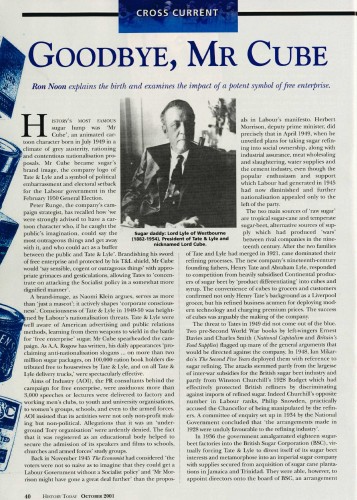
There is also an essay in the North West Labour History Journal for 2006 on the Litigious Consequences of Mr Cube.
The Trinity Primary School and unfinished sugar business
Written by Ron Noon at 07:11 on Thursday, July 09th 2009
It’s early morning July 9th and not long before I pick up Leon and journey off into town, then along Vauxhall Road, past the former Tates refinery site which is now the proud home of the Eldonians, left before the Green Man into Burlington Street, along to Titchfield Street and down the road into a brand new spanking Trinity Catholic Primary School. That’s where we will review the sugar and slaves project which year 5 accomplished in 2008, Liverpool’s European Capital of Culture year.
When Maggie Skilling, Leon Seth and I went into Trinity Catholic Primary school at the beginning of 08 our objective was to show our film to the parents and teachers and secure their support for a year 5 Tate & Lyle Love Lane sugar project which would also examine Liverpool’s history in the era of the slave trade. We wanted the children to become more historically aware of their SUGARLAND community just north of the city centre.
The afternoon film show proved a great success and we were able to outline our vision of what we hoped could be achieved by April and the anniversary of Love Lane’s closure. Julie McAdam and Anne Porter were the two great teachers who stimulated and supervised the children’s weekly work and who made our film visits enjoyable and productive. They were especially welcoming to the special visitors we brought along such as Albert E Sloane and Jim Smith, former Tates employees, and also young Laurence Westgaph, a local expert on Liverpool and Slavery.
This morning is a final opportunity for Leon and I to produce a “bookend” to that project by filming the children (now Year, 6), and inviting them to talk and reflect on what the project has meant to them personally and as members of a group.
Albert E Sloane and Jim Smith loved their visits to the school last year, They were questioned with a curiosity, honesty, intensity and tempo that Jeremy Paxman at his best could only dream of. The children’s questions inspired cameo responses and stories from the two wonderful “old timers” who had dedicated all their working lives to Tates. Albert’s name pops up frequently on these blogs and it was he of course who alongside his pal John McClean, who sadly passed away this year, tutored me at the start of this sugar odyssey. Jim Smith is a former driver and transport manager at Tates on the threshold of his 100th year! Unsurprisingly he first worked with teams of cart horses and then eventually the famous navy blue wagons that ferried raw sugar from the silo in the Huskisson dock to the refinery on the lane less than two miles from the river. Jim is brilliant and those who have seen our first film will hopefully before the end of this year see him and Albert again in full and loquacious flow. They were certainly in fine form in the classroom last year. (If you go back to the BLOG and the picture in the summary then you will see Jim with baseball cap on in the very back row behind the children and their lovely grandparents.)
I know there’s invariably a lag between intent and actual achievement and that there are limits to a planned script of objectives. Some of the best cameo scenes are unscripted and unplanned and that will hopefully happen again this morning. That said I am planning to ask some specific questions. First of all I want to know whether they are still dedicated SUGAR Busters! Secondly I want reassurance that they are persisting in pestering their grandparents, the former boys and girls from the whitestuff into re-telling their work and community memories. Finally, following on a lead which they had from Laurence Westgaph who they really enjoyed listening to I am going to follow up his suggestion that slavery was not just an historical topic. Laurence suggested to the children that slavery was contemporary and extended beyond what they had studied and viewed representations of down on the waterfront in the Transatlantic Slave Gallery.
The following extract tragically reinforces Laurence’s point and hopefully this morning we will get some responses from the children to a moving extract from Pedro Ruquoy.
Pedro Ruquoy, is a Catholic priest of the bateyes, (sugar plantations) in the Dominican Republic, and because he consistently spoke out against the proprietors of the sugar refineries in the Dominican Republic, he was relocated by the church in 2005 for his own safety.
He explained that:
“For more than 10 years I have had the opportunity to share the life of the cutters of sugar cane who live like slaves in the huts strewn among the fields of sugar cane. My last months in the fields were very extreme: my face appeared daily on national television where I was presented as public enemy number one of the Dominican homeland, I was the object of an unprecedented slanderous campaign and the churches where I celebrated the Eucharist were attacked. All because I made the suffering of the sugar cane workers known, making known to the world that Jesus is still dying among the gentle reed”
What is the price of sugar in 2009?
TO BE CONTINUED

Roger McGough was once a boy from the Whitestuff!
Written by Ron Noon at 20:32 on Sunday, June 28th 2009
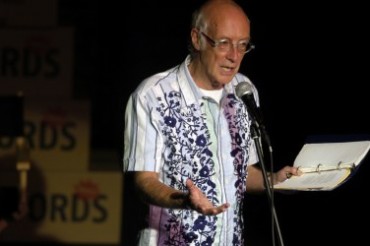
Photo credit Peter Everard Smith
Roger McGough has been described in the Daily Post as “Liverpool’s own Poet Laureate”. He’s “a trickster you can trust” and after a serendipitous encounter with the honorary fellow of Liverpool John Moores University, in a closing down sale of mens clothes in a Church Street boutique, I found out that he also knows a good deal about life in a sugar factory! That’s the kind of insider knowledge that our web site craves.
Closing down sales can entrap the great and the good, and last Tuesday it lured the internationally acclaimed poet into a deal with a fellow bargain hunter that had nothing to do with sartorial elegance and everything to do with SUGAR! I did however exercise some compunction by deliberately avoiding early references to the white stuff and by introducing myself with a question about a mutual friend. “Excuse me pal”, I almost shouted out as the familiar stranger attempted to exit the store, “do ye remember Joe Martindale?” Of course he did.
Here’s a picture of a party in 23 Canning Street around June 1974 with Joe and various other “Poly people”“
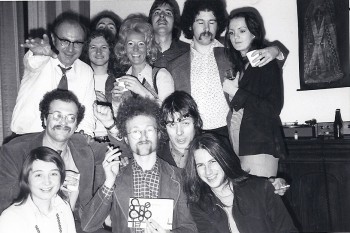

Joseph Martindale was a wonderful human being as well as a witty and urbane Lecturer in Industrial Sociology at what was then called Liverpool Polytechnic. (Oh for the days of the gas and water municipal poly when we were young and less prone to follicle challenges and when John Moores the Football Pools magnate was precisely that and not an apt name for a venerable Higher Education institution.) Joe was a true Poly man, former monk and author of two fine late 1960s novels, Found Wanting and Dry Mass. He had been an important part of the Mersey beat and poetry scene and actually wrote a reference for McGough, when the swinging sixties were over and Roger became a Poetry Fellow at Loughborough University.
So strong is the memory and love of “St Helens Joe”, the garrulous storyteller who died of a heart attack in the early 1990s, that I talked to some friends about trying to resurrect his work and his name in our European Capital of Culture year. It’s an unfinished project but much more will be written about Joe because just like the many Love Lane lives we dedicate this website to, memories are everything. When they are so compellingly strong, the onus is on all historians, (our subject is too important to be left to just professional historians like myself), to record, document and encourage further commentary about these extraordinary ordinary lives.
Anyway that was the sad part of our boutique conversation but in a lighter more upbeat vein we progressed on to the white stuff and the final request I made to one of our best loved poets “from me to you mate” is “to join the Love Lane Lives Alumni”! My Latin exhortation for him to look at our website and make some comments is now recorded on this blog for posterity but my wife Gail thinks it a bit rude and intrusive. Why should he? The guy was only looking for a bargain not a lecture on Love Lane Lives from a sugar-centric University teacher! “But Gail I had a drink with Joe and the younger McGough in the Commerce bar sometime back in the 70s. I did get a round in although I have to admit that would n’t be the same kind of historical fact for Macca to remember because I’ve subsequently discovered he partied with Hendrix and Jane Fonda, not Ron Knee!”
The serendipitous exchange between the poet and the sugar bore came to an end when McGough’s poor wife, presumably fearing that she had lost him for good, returned to the shop to extricate the spouse from sweet talkin’ Ron.
So as I wait with baited breath to hear whether the Fellow from LJMU responds to this ordinary fellah’s request, here is the extant historical evidence of what the young poet was up to when he walked down the Lane in the mid 1950s.
My source is his 2005 autobiography Said and Done where there’s a humorous chapter on “Work experience” and reflections on life as a Hull University student.
“The long summer vacations were usually spent in Greece, either sailing between the islands or just simply lying on a beach sipping retsina and reading the latest Robbe-Grillet novel. No they weren’t”.
This proud son of a North end Liverpool docker, and a very rich culture of irony and “one liner merchants”, became a casual University student the year after the Stanley Matthews cup final in 1954. Fully cognisant that a Joint Honours degree in French and Geography required summers spent earning dosh with real WORK, he flitted from a toy factory where he helped make money boxes in “Dickensian squalor beneath the railway bridge”, to a bakery where he inadvertently “squashed loaves” that once demanded an emergency stop of the conveyor belt to stem “erupting floury lava”. Recovered from that trauma he moved on to the Char House in Tate & Lyle!
This Sugar factory made Henry Tate’s millions but the mother plant half a century after the patriarch’s death, witnessed an unwitting McGough induced eruption, and unintended version of industrial sabotage. It was probably this episode, documented below, which was the main reason why the young student decided he was better cut out to be a poet than a pansman like Bobby Austin.
“I don’t know what it is about me and machines, but we just don’t get on…Tate & Lyle had a huge factory on the Dock Road and employed an army of students during the summer vacations. One day I would be part of a gang humping bags of sugar on to the back of lorries and the next I would be stacking boxes in the stacking box shed. For a month I worked the night shift in the Char House, or Charcoal House, a Victorian building on three floors where raw sugar was filtered through charcoal as part of the cleansing process. I enjoyed working through the night, and I liked the company of the men I worked with. The constant breaks for tea and toast and roll-ups in the furnace room with a group of surreal Scouse philosophers, who shared with the dockers an aptitude for bestowing colourful names on their colleagues – the Balloon foreman: ‘Don’t let me down lads’; the Sheriff foreman: Where’s the holdup?; ‘Lino’: ‘He’s always on the floor’; ‘Phil the Cot: ‘He’s got fourteen kids’.
Instead of loaves, it was charcoal dust that did for me this time when the chargehand left me on my own at 2am on the third floor. The huge space with its tiled walls and clanking metal pipes was like the engine room on some abandoned liner: ‘All you’ve gorra do is stand by the big pipe here, and when the noise changes hit that button there.’
‘What about these dials?’ I asked, pointing to a handful of quivering fingers.
‘Take no notice. See yer lad.’
So I pulled up a chair and sat down in front of what looked like a small ship’s funnel and waited for the noise to change. What noise? I could n’t hear anything. Oh, yes I could. Did he mean that faint sifting noise, like the sound of icing sugar passing gently through a sieve? Or did he mean the ticking noise coming from one of those dials? No, he’d told me to forget about the dials. Could he have meant the scuffling noise coming from the far corner? No, that’s a rat, take no notice. It’s amazing the sounds you can hear when you are cast adrift in an ocean liner above the rooftops of a sleeping city. Foghorns, of course, out on the river. A baby crying in a tenement block? Two lovers giggling in Paradise Street? In the empty jazz cellar, the pianist plays a final blues. Eyes closed now, I feel myself drifting into a sweet aural reverie. Drifting…Drifting…
Suddenly, what’s that noise? Snoring? The sound of somebody snoring? When I realised that I’d been asleep but not snoring, it was time to panic. The noise, and it was increasingly deafening, was coming from the blasted funnel and it was time for me to spring into action as I’d been trained to do. I hit the button. The trouble is that five minutes is a long time for charcoal to be pumped along lengths of piping and the eruption, though lacking the glorious yeasty smell of the bakery volcano, was a good deal more volatile and disruptive. Black clouds billowed around the room and the charcoal dust settled to a depth of several feet. It was like a satanic snowstorm. My Al Johnson impersonation failed to impress the chargehand when he arrived but at least he helped me shovel out the dust and hose down the room. The next day the good soldier was transferred to humping bags of sugar on to the backs of lorries.”
Roger McGough Said and Done the autobiography
Published by Century in 2005
....................
I tell my students about Hindsight Station and how much easier it is to look back down the tracks and see how we got to where we are now. The detours and branch lines can only be viewed in retrospect and from my place on the platform I see a wonderful cultural opportunity missed! The Times described Mr McGough’s Mersey Makeover of 17th century French satirist Moliere, now playing at the excellent Liverpool Everyman, as a “witty laughter tonic” and the Observer, not to be outdone, said it was “anarchic, irreverent, and hysterically funny”! That’s what Roger’s account of working at Tate & Lyle’s suggests and as you’ve read above, it was their char house that helped finance his French studies at Hull University.
The Hypochondriac by Roger McGough after Molière, the Everyman Playhouse, Liverpool, June 19 to July 11 (0151-709 4776; everymanplayhouse.com).
It’s sponsored by Liverpool John Moores University where Roger’s a FELLOW and I’m a fellah!

Beat the Beet, Keep the Cane
Written by Ron Noon at 14:18 on Friday, June 26th 2009
Beat the Beet, Keep the Cane
The picture above is the Frank Green painting that Julie Lyon-Taylor (John Maclean’s daughter) gave to me because she said that’s what her dad would have wanted. It is now proudly positioned in our hall and not above my computer, which would have restrict’ed its audience.
This is what the ETHICAL CONSUMER magazine wrote, not me!
Historian and sugar expert Ron Noon from Liverpool John Moores University unearths some uncomfortable truths about ‘capitalism’s favoured child’.
Whether it comes from the historic cane that sways in the exotic tropical Antilles or the ugly mangel wurzel sugar beet in wet Fenland England, the real story of sugar from a nutritional and ethical perspective, is Sweet FA! It is an ‘empty calorie’ shorn of any other nutrients, but achingly addictive and a perfectly legal drug for billions to be hooked on. The granules are manufactured in ‘temples of applied science’ and not in mother nature’s laboratories. The highly chemicalised refining process launders and purges the raw sugar to ensure that nearly all of the nutrients that accompany sucrose, are lost or taken out, leaving nothing but calories. This is a salutary warning to health conscious consumers who mistakenly think that raw or brown sugar is much more nutritious and healthy than the white stuff! Raw for retail is a misnomer because it has also been refined, and the sugar lobby ought to be warned about the ethics of describing its product as ‘natural’.
Globesity
As humans have no biological need for the refined stuff, we could, and did, live without it for thousands of years. The bible described a land of milk and honey, not sugar and spice. Despite the fact that it was millennia before our innate ‘sweet tooth’ became acquainted with what I brand as ‘industrial sugar’, our ancestors associated sweet with good and bitter with bad.
In today’s ‘naughty but nice’ era of processed profits, palatable junk food, and globesity, the dissonance between tastiness and nutrition, renders those earlier instincts not only anachronistic but highly dangerous. Foods packed with refined sugar are chock-full of calories and are always likely to give trouble because they help to overcome the finite limits of the stomach. We are always prone to finding room for something sweet and, not only do some sweetened foods taste so good that consumers are quite content to risk their health for deliciousness, but even savoury foods have fallen prey to sugar’s embrace.
Revealingly in a 1967 book entitled, Sweet Malefactor, the author, a former World Health Organisation doctor, declared that “there is no single food which has rivalled sugar in its influence on human affairs”.1 It was of course the quintessential slave crop, a label which is tragically not just historic. “Sugar slavery is back more powerful than ever, and now sugar is not only devastating for those who harvest it, but deadly for those who consume too much.”2 The so called diseases of affluence and overeating including the latest bitter sweet neologism, “globesity”, cannot be understood without examining the politics of food and health, and particularly the pimp-like product which, along with fat, is a key foundation food of capitalism.
Napoleon and subsidies
The history of sucrose, before Columbus represented only “a mere pinch per head for the whole of that history”,3 but then according to deposed Haitian leader, Jean Bertrand Aristide, it was premised on millions of African sisters and brothers being “exported like merchandise”, their blood “changed into bitter sugar”. A recent US documentary film, The Price of Sugar, narrated by Paul Newman, focussed on the plight of Haitian migrant workers in the sugar bateyes of the Dominican Republic, and dramatically reminded all those who talk about packaging and marketing ethical sugar, that slavery is not just about the past. The Haitian migrants and their children are of the same blood and lineage as Toussaint L’Ouverture, the “Black Jacobin” who led a magnificent slave revolt against the mighty French Empire at the beginning of the nineteenth century burying, albeit temporarily, their chains.
The Haitian revolt and the British navy’s stifling of French trade encouraged Napoleon to champion the sugar beet which not only symbolised the temperate world’s seizure of what had hitherto been the husbandry of the tropical world but the rigging of the international sugar trade against nature’s most efficient collector of solar energy, the tropical cane. The behaviour of many European governments in the form of “continental bounties” and subsidies for beet production has led inexorably to the European Union’s egregious Common Agricultural Policy which has worked very much to the detriment of cane growers in the developing world. Despite recent reforms which were forced on the EU by the World Trade Organisation, designed to help free up trade, the transitional period of adjustment and compensation for lower prices has been very much skewed in favour of the European Beet boys and the big refiners.
The ubiquity of industrial sugar today (two thirds of our intake is indirect), is based on this nefarious history of cane and beet, and a present day ‘Big Sugar’ lobby that increasingly makes the chicaneries of Big Tobacco seem old-fashioned. It is called ‘big’ in the US because of its disproportionate political clout and although the adjective is not used so often over here, de facto the reality is the same.
Slavery
It is so ordinary a product today that it is difficult for many to conceive that by the 16th century this addictive drug was a main marker and emulator of wealth and conspicuous consumption and that it would later become known as ‘white gold’, the basis of one of the first truly international industries. The ‘Sugar Revolution’ in Barbados and the Caribbean in the middle of the seventeenth century and the ‘proto-agri-business’ of plantation production, increased output and reduced costs and prices to feed the Old World’s seemingly insatiable demand for a product that rapidly moved along the value added chain, from medicine, spice and condiment, to decorative substance, preservative, sweetener and eventually the food that changed the world of diet!
It sweetened trades in other exotic tropical beverages, such as tea, coffee and chocolate, and proved, in the drive towards modernity and mass consumption, to be ‘Capitalism’s favoured child’.4 It is a wonderful social metaphor for a system of commodity production that prioritises want not need, wealth not health. Hobhouse argues that “although it did not create negro slavery” it was “the gigantic scale of the transatlantic slave trade and its maintenance for several centuries” that fed upon “the demand for sugar in Europe and North America”.5 It was, and is still in places like the Dominican Republic, the most exacting of all tropical taskmasters and Hobhouse reminds us that “because sugar cane was a labour intensive crop, the ratio of slaves/sugar always remained at least ten times greater than the ratio of slaves/tobacco, or slaves/cotton, or any other crop grown in servitude”.6 The remorseless demand of addicted consumers four thousand miles away rationalised the de-humanising logic of slave labour, integral to the Sugar Revolution and the rapid Africanisation of the Caribbean which cravings for sweetness brought about.
Boycotts
After Parliament’s rejection of a bill to abolish the slave trade in 1791 hundreds of thousands of people developed the tactic of boycotting sugar from the West Indies, and for those who abjured self denial because of their incurable sweet tooth, the ethical thing to do was to eat sugar from India. Thomas Clarkson one of the greatest of all the abolitionists, such was his unstinting fervour, energy and determination to remove the abomination of slavery, was delighted unlike Wilberforce who was wary of stirring up popular protest, that the boycotters, had found “a remedy which the people…were taking into their own hands”. The fact that Indian sugar was untainted by the blood of African slaves did not mean it was produced by “free labour” but the boycott methods and shift of demand to East India sugar was a broadside against the hitherto all powerful West Indies sugar lobby.
Today it is not the British West Indies lobby which stirs up the potential for popular protest on behalf of developing countries, but the EU and ‘Big Sugar’ in America. The former have not only heavily subsidised beet, but for over thirty years dumped surpluses onto world markets forcing prices down and exacerbating the problems of developing countries where cane has remained the ‘hunger crop’.
In March 2004 there was a report from the World Bank which concluded that sugar was the “most policy-distorted of all commodities” and argued how multilateral reform of sugar policy could produce global welfare gains of 4.7bn dollars (£2.5bn or 3.7bn Euro at that time). By increasing imports to the most protected countries, US, EU and Japan, it could create work for 1m workers in developing countries which, once again, revealed how more so than any other commodity it brings the interests of developing country sugar cane exporters most into conflict with those of developed country sugar beet growers and the cane growers in America who benefit from the protectionist Sugar Program.
Moral obligations?
So to conclude this present minded history of sugar, there are a few glittering generalisations that can be made despite the labyrinthine complexity of its politics and the argument of French food writer Montignac who suggests “it should always be labelled will a skull and crossbones symbol since it is a dangerous product when consumed in large amounts”.7 Firstly, apart from the existence of a few rich cane-producing countries such as heavily protected America and far more efficient and free trade oriented Australia, the divide between tropical cane and temperate beet coincides directly with the division between rich and poor countries.
Secondly sugar cane is nature’s most efficient collector of solar energy and if production costs are compared by looking at what the land and labour used in each country could produce if they were put to their most profitable other uses, or what the economist defines as “opportunity cost”, then beet production, because of the far greater opportunities available to resources in rich countries is substantially more costly.
Thirdly and of the greatest significance because it relates to our moral obligations towards the poorest of the poor is the conclusion reached by the World Development Movement over 30 years ago that “a rich country’s sugar policy, from whom it buys its sugar and by what means it pays for it, is a vital litmus test of its proclaimed benevolence towards the poor world. It’s policy indicates directly whether or not it is willing to stifle one of the developing world’s few real opportunities to increase its exchange earnings”. Gloomily the egregious and self interested sugar programmes on both sides of the Atlantic, highlight how there is nothing economically or ethically rational about the world of sugar and that sadly the colonies that were exploited in the days of slavery are still denied one of their few opportunities to develop via trade not aid. The maxim of the ethical consumer is to reverse the Napoleonic legacy and help to beat the beet and keep the cane.
References
1 W.A.Aykroyd Sweet Malefactor (1967) p.142
2 Brian McKenna in CBC documentary, Big Sugar 2005
3 Henry Hobhouse Seeds of Change: Six plants that transformed mankind (1999) p.54
4 Fernando Ortiz Cuban Counterpoint (1947) pps 267-82
5 W.A.Aykroyd Sweet Malefactor (1967) p.130
6 Hobhouse op cit. p.93
7 Michael Montignac, Dine out and lose weight: The French way to culinary ‘savoire vivre’ (1996) p.87
Mike Greenall’s apprenticeship to sugar.
Written by Ron Noon at 15:20 on Wednesday, June 10th 2009
I left school at the age of 16 in July 1965 and in August, started work at Tate and Lyles refinery in Love Lane as a Process Apprentice. This was a course designed by Tates to provide training for young lads in all aspects of processing of sugar from raw to the various refined products that were on the market at that time.
The idea of the course was to train people to be the next generation of the workforce and to provide the Pansmen, Chargehands and Foremen that the factory would need in the future. It never really turned out that way as most Apprentices left for other employment as they completed their training. I was one of the few who stayed.
I remember reporting to the gate on my first morning, extremely nervous and not knowing what to expect. I was taken to a small waiting room not far from the Time Clocks and told to take a seat. Another young lad was already there, his name was Neil Dumbell and he would be my fellow Process Apprentice for the next 5 years. (As with a lot of Tates employees, his father, like mine already worked in the Refinery).
After sitting in nervous silence for what seemed like ages but probably was no more than ten minutes, we were collected by the day Foreman, George Fitzpatrick who took us to the Stores to be kitted out with 2 towels, 2 pairs of overalls, (brown Jacket and trousers for process workers), and a pair of safety boots. From there we went to the main changing room to be given our lockers which were in a section where all the other Process Apprentices got changed, I think there were a dozen or so of us all together, all at different stages of training.
I think after this we were taken on a tour of the refinery, I can’t remember the details, it was so long ago and so difficult to take in all at once. It was a hot August day and I remember being on the Sweetland Press floor in the heat and the humidity and thinking how bad the smell was, it made me feel ill, I didn’t think I would be able to stand it, but after a day or so, I ceased to notice it. How strange that we easily get used to things.
We took our tea and meal breaks in the main canteen which was in the administration block, on the first floor. There were three canteens; the largest was the works canteen, for any of the works personnel. Then there was the Junior Staff canteen, also on the first floor. This was for the Pansmen, Chargehands and Foremen. The last was the Senior Staff Canteen for Senior Management, on the second floor.
Different groups tended to use different parts of the canteen. We apprentices used a couple of tables near the windows that looked out onto the Yard and Filtration House, the shift workers used the tables on the opposite side of the canteen overlooking Burlington Street, though their meal times did n’t coincide with the day workers. The rest, i.e. day workers, engineers etc used the centre of the canteen.
Above the canteen were the laboratories and some offices. One Lab carried out routine analysis of the various products and analysed the various syrups sent in by the Recovery and Yellows Pansmen in order to work out the required Footings for these pans. The second Lab was the Tech Lab, which carried out research projects for the plant in general.
As Apprentices, we had to complete Log Books in which we had to record everything we learned about the running of each department we worked in, including flow diagrams of the plant and how it was intended to operate. In fact, the more we found out, the better. We spent a lot of out time tracing pipe work from department to department as we were expected to know, if asked by a Foreman or Chargehand, where everything came from and went to. This was also a perfect excuse to be in places we shouldn’t have been, if asked, well, we were tracing pipe lines! The log Books were checked by whoever was supervising us to see we were actually doing what was required of us. This was somewhat hit and miss, as it very much depended on whether the Supervisor in question had the time or inclination to check on what we were doing.
There was also an Apprentice Club which had a club room above the Engineering Apprentices workshop. It had previously been in a disused section of warehouse in the main factory, well of the beaten track, but was moved as naughty apprentices used to sneak off there to skive! The new clubroom, being over the Engineering Apprentices workshop, could be observed by the foreman in charge of the shop.
Another popular skiving place was on top of the Recovery House roof. On the corner of the roof was a re-enforced steel lookout point dating from the Second World War. It was an observation point for fire watching during bombing raids on Liverpool, There were others in other high buildings within the factory, but this one, being accessible by steel ladder from within the Recovery House, was very popular as a card school.
As apprentices we were given sixteen, one hour driving lessons and a driving test as part of our training, and, if we passed, we were able to book out the Apprentices Jeep, which was, in fact, an old Land rover. I never did myself, though it was quite popular with other Apprentices.
During our time as apprentices we were required to attend Day Release at one of the local Technical Colleges, the one most of us Process Apprentices attended was Old Swan. It was a twelve hour day, as it included a night school session. The courses varied depending on the ability of the apprentice in question. My course was the Chemical Technicians Course. This was primarily laboratory work. Some people did the Chemical Plant Operators Course; others did National and Higher National courses.
We spent the first two years of our Apprenticeship on days, eight to five with an hour for lunch. Then when we were in our third year, once we were eighteen, we went onto one of the shifts. I think I was on A shift. I stayed on this shift until I finished my time, at which point I went into the laboratory as a Sampler/Tester, a full time employee.
………………
522.382-034 - SUGAR BOILER (sugar & conf.) - DOT Dictionary of Occupational Titles Job Description - www.occupationalinfo.org.
CODE: 522.382-034
TITLE(s): SUGAR BOILER (sugar & conf.)
Controls vacuum pan sugar boilers to concentrate sugar liquor and grow sugar crystals to specified size: Starts vacuum pump, and opens valves to admit specified amounts of liquor and steam into vacuum pan, and water into condenser unit. Observes boiling of liquor through sight glasses. Adjusts valves to maintain specified temperatures and pressures and obtain supersaturated solution without caramelizing sugar. Opens valve to shock solution with pan seed (powdered sugar) and start formation of sugar crystals. Obtains samples of solution, using proofstick, and observes grain size under microscope to determine when crystals have grown to specified size. Opens pan-feed valve to control growth of crystals. Samples solution to ensure that sugar crystals remain at specified sizes as pan fills. Closes pan-feed valve when pan is filled and continues boiling until solution reaches specified concentration of sugar-crystals and massecuite. Turns valves to stop boiling and to break vacuum seal on pan. Turns valve to dump sugar into mixing tank or crystallizer. Washes and steams pan after dumping strike to remove sugar remaining on coils or calandria. Records strike on station log. May be designated according to type of liquor boiled as Soft-Sugar Boiler (sugar & conf.); White-Sugar Boiler (sugar & conf.); or according to stage in process as High-Raw-Sugar Boiler (sugar & conf.); Remelt-Sugar Boiler (sugar & conf.).
Bitter Sweet Pensioner Stories
Written by Ron Noon at 14:39 on Wednesday, June 10th 2009
BITTER SWEET PENSIONER STORIES
Written by Ron Noon in 2004
This is a saccharine tale of contrasting retirement fortunes for employees of the sugar giant, Tate and Lyle, a multinational company before the term was shoehorned into the lexicon. It acquired the Royal imprimatur, mainly because of its famous founder, Henry Tate, a fabulously wealthy Victorian sugar baron, philanthropist and legendary patron of the arts. His name in 2004 is the logo of the Tate Modern rather than Tate Sugar and for most people the only thing that matters about the latter is its sweetness. That is the last thing to be said about a unique and intensely political product’s history. In six centuries of global expansion, so many tears have been shed in sugar’s name that it ought to have completely lost its sweetness. But for Larry Pillard, Tate’s American chief executive officer from November 1996, the world was very sweet, as on 1 January 2003, he started drawing his company pension at the middle age of fifty-five.
Vera Noonan* is the daughter of a working-class employee who tragically drowned in the River Thames in 1990, after falling from a crane at the company’s massive Silvertown refinery. At the beginning of November the thirty-one year old mother of Ron’s* three grandchildren avoided an immediate custodial prison sentence, although she was found guilty of drawing £14,000 of his pension. It transpired that for two years after mother Julia* died in 2001, Vera swindled the sugar giant, and as she told the jury at the Old Bailey, it was because of a determination ‘to make them [Tate and Lyle] pay for her father’s death’. The demand for reprisal is not the most noble of emotions but it is more ‘natural’ than the spurious claims made by sugar industry school misinformation packs, that refined sucrose is a pure and ‘natural’ product. The prolonged crushing, purging and laundering process that transforms sugar beet or sugar cane into the whitestuff, is decidedly ‘industrial’ and sadly tainted by more than the blood of African slaves.
There are other sources of sweetness and high fructose corn syrup (HFCS), derived from the wet milling of corn, was the first major biotechnology breakthrough in the sugar world. It immediately proved a lucrative sweetener in the American soft drinks market and Tate’s in 1988 acquired, in a hostile leveraged takeover, a major supplier - the Decatur, Illinois based AE Staley Manufacturing Company. The spur to the acquisition of Staley’s four major corn processing sites was to remove the competition and as with so many other multinationals obsessed with global competitiveness, Tate’s proceeded to follow the industrial relations low road of keeping wages down, undermining social safety programmes and environmental and workplace safety.
The result of the ‘war on the workers’ was that on 27 June 1993, a new chief executive officer, brought in from Cargill, a rival agribusiness colossus, locked out 760 union employees in Decatur. A lockout is the ultimate weapon of mass destruction deployed by employers against unions and this one took thirty months before corporate solidarity won. Not only was the union ‘downsized’ but Tate’s attained more flexible labour practices through the ‘time-theft’ of rotating twelve-hour shifts demanding conformity to the company calendar rather than the more natural work rhythms that made family and social life predictable. Larry Pillard who in his teens had wanted to be a dentist, had extracted the teeth from a concerted and admirable community effort to save union jobs, and was rewarded for resolving the aching Staley problem by promotion to the top job in London, taking over from Sir Neil Shaw in 1996.
There was no safety net to break Vera’s dad’s fall and it was ten days before his body was recovered from the Thames, only for the bereaved family to be torn apart by his cruel and preventable death. There is no anaesthetised pain when health and safety issues are ‘downsized’ and 1990 was a bad year to be a Tate’s employee. In Decatur, Illinois Jim Beals was killed by inadequate health and safety measures, while in Greenock a worker was smothered to death by an avalanche of sugar inside a silo. The tragedy in Scotland was so serious that the case was one of the rare workplace injury cases to be held in a crown court, resulting in a swingeing fine for Tate and Lyle.
In Decatur, plumes of smoke from forty-five acres of ‘chemical plant’ dust the downtown ‘with a scent as sweet and thick as a bakery’s’, but the dusts and vapours inside the plant were often invisible to workers. Safety measures were not in proper order when toxic propylene oxide gas was released into the cornstarch-processing tank in which Jim and another worker were making repairs. The awful irony here was that Jim had written up a grievance report on the handling of propylene oxide in the plant the very afternoon that he was killed. His fellow worker, Gerry Summer, described how on that fateful day not one of the fifteen ‘Scott airpacks’ in the plant was charged over thirty per cent, rendering them useless in an emergency, and that ten bottles of oxygen on the wall outside where they had been working, were all subsequently found to be empty. In January 1991 the Federal Occupational Safety and Health Administration, issued a $1.6 million fine against Staley based on 298 ‘serious and wilful infractions’.
The judge at Vera’s trial admonished her that ‘in the normal course of events this sort of theft … could have resulted in an immediate custodial sentence’. He was prepared to show leniency however, because after the company audit that led to her arrest, she candidly admitted to being a pensions cheat, and so her sentence was nine months jail, suspended for eighteen months. The jury had been told that the pension money was drawn because her father’s death had not only caused her mother to give up on life but her brother had gone to pieces and developed a serious gambling problem. This East End world of Newham and Silvertown was far removed from the terrain of ‘executive pensions excess’ and Larry Pillard’s west end Chelsea home.
Pillard’s career started at rival HFCS producer Cargill, before the promotion at AE Staley in 1992. By 2003 he was opening a lucrative pension account and an even higher paid position as executive chairman of Swedish group, Tetra Laval. This food packaging firm is owned by Hans Rausing, a Swede allegedly one of the richest men in Britain. He has lived here since 1982 but his home, albeit, a purpose-built palace in East Sussex, is not legally his ‘domicile’, according to his hired tax advisers. As the Guardian newspaper revealed in 2002, ‘with this one, vital, verbal distinction, he escapes paying tax on all his income and on all his capital gains in all the world outside the UK’. Larry Pillard and Hans Rausing live in a parallel and unfathomable world to ordinary pensioners and the young mother branded a ‘pensions cheat’ at the Central Criminal Court.
At the end of that first week in January, Vera’s pensions scam would have netted her about £134, well short of Larry’s legal £6,000. Financially Larry was looking on the bright side as in 2002 a £503,000 base salary for the nine months down to the end of the financial year, had been boosted by a £431,000 bonus, part of which was the pensionable ‘discretionary’ award from Tate’s remuneration committee. This audited arithmetic was out of sight and out of the public mind until a report published in the London Evening Standard on the 27 June 2003, revealed, that the man vilified as a union buster in Jim Beals’ old workplace in Decatur, had received from Tate’s, ‘a £1.5 million pension sweetener’ after unexpectedly announcing he was stepping down as chief executive of the sugar giant. Allegations were heard that the timing of his move might have been related to an imminent class action case in America about the rigging of HFCS prices, by ostensibly rival companies, when he was chief executive at Staley.
Larry’s sums shaded Vera’s £134 a week con, but company accountants were nonetheless adamant, that there been no backdoor settlement and no compensation, paid over to the ‘colourful Harley Davidson motor bike fanatic’. Pillard had simply ‘elected to exercise his right under the US pensions plan to draw his pension early’. (Ron’s family drew his pension early but obviously not through choice.) The Evening Standard’s view of the accounts was that ‘£1.5 million was added to his £2.36 million pension pot’ to allow Larry to draw his pension in the new year. A £311,000 annuity is a more than ample amount to enter life’s third age and Britain’s wealthiest pensioners club. As a working pensioner at Tetra Laval the pin money was useful for the maintenance costs of his home in Chelsea and farm in Iowa and paled the £67,000 housing allowance plus transport costs that Tate’s had paid him the previous year to facilitate family flights to America.
Sadly there are far too many cases of executive pensions excess falling below the radar of public scrutiny and which never end up in an Old Bailey trial. Warmly persuasive phrases such as corporate social responsibility slip off the public relations tongue too easily, whereas very little evidence can be found of investor anger over the stark disparity between executive munificence and employee privation. There was no displeasure - let alone anger - evident in the Royal Lancaster Hotel at the 100th Annual General Meeting of Henry Tate’s once proudly paternalistic company, when shareholders approved Pillard’s controversial retirement package.
That justifiable ire and outrage was sadly absent at the end of the last millennium when Liverpool Tate’s pensioners literally had Christmas stolen from them. They were told in an official company letter in October 1999 that the biennial Christmas bash at the Britannia Adelphi Hotel on 2 December would be the very last one. Albert E Sloane, the seventy-seven year old sweet fighter who led a ten year struggle to keep open Love Lane refinery, the mother plant in Henry Tate’s sugar dynasty, was incandescent with rage. This lifelong socialist never secured a job after the Lane was closed in 1981 and there was a sense of déjà vu that Tate’s history on Merseyside was repeating itself as another tragedy.
The junking of the biennial company-sponsored Christmas party symbolised a Scrooge-like meanness of spirit. That was certainly what Frank Till felt like when he expressed his sadness at the last supper. ‘The people who run Tate and Lyle now are just names to us. Previously we knew them - Saxon Tate, Colin Lyle, Nicholas Tate - we knew them all, but not now. They are unidentifiable people and of course we are unidentifiable to them.’ Frank was a sweet fighter who had joined Tate’s in 1941 rejoining in 1947 after service in the RAF. Albert’s wartime experience had been in the RAF and coincidentally he followed his father into the ‘sugar mill’, the same year Frank returned.
On a beautifully sunny Thursday afternoon, a weekend away from Christmas 2001, when Tetra Laval was presumably not even a twinkle in Pillard’s eye, an unusual labour petition was hand delivered to the receptionist on the second floor of Sugar Quay, the company’s multi-story headquarters looking out over the Thames and a wonderful view of the nearby Tower of London and Tower Bridge. Addressed to the company chief executive it called for restoration of the ‘biennial Christmas reunions’ for pensioners in Liverpool. The majority of these former employees had devoted most of their working lives to the charmingly-named Love Lane refinery, which in the eighteenth century, when Liverpool was at the epicentre of the infamous transatlantic slave trade, was a perambulating maidens’ and ladies pathway. By 1872 the lane was cut through by the Leeds-Liverpool canal and amongst glue factories and warehouses warped into the mother plant in Henry Tate’s sugar empire. Sadly at the end of the last millennium a letter from John Walker, the chief executive of Tate’s European division, announced that ‘regrettably because of the need to continually review and reduce costs’ the 1999 Christmas bash would be the last.
Albert had lived his working life as a free spirit not a cost of production, but sadly ‘commodity status’ was the objective reality for all the 1,500 workers junked in 1981. Many like him never secured another job but enthusiastically looked forward to the ‘craic’ and the ‘associational’ benefits of the annual and then biennial Christmas reunion. Walker’s rationale for the end of Christmas angered them all. Ominously as the pensioners gathered together beneath resplendent streamers strung across the banqueting hall of a once quite magisterial hotel, the cold business logic that deemed this their last supper was matched by the freezing weather outside.
The costs of these Christmas bashes had always been ameliorated by the demographic fact that it was an ageing labour force in 1981. Unsurprisingly the first topic of conversation at the Christmas bashes was of the latest toll of bereavements, but it was part of the ritual of reliving their memories and stories of the world of work and the age when they had helped sweeten the nation’s breakfast tables. John Maclean, Albert’s close friend, wryly commented that not only did ‘Christmas come round every two years with Tate’s’, but ‘each time, absent friends meant that it got cheaper. We never thought they’d scrap it altogether though’. The vainglorious efforts in 2001 to force a company rethink and bring back Christmas were totally ignored despite the terminal demographics. Bob Bannister another former shop steward like Albert asked at the last supper on Lime Street whether it would ‘spoil some vast eternal plan if these Christmas get-togethers were to continue … after all, in ten or fifteen years most of us will have left for greener pastures’.
There have been no hats off to Larry in Liverpool from the old boys and girls from the whitestuff, and ironically one of the signatories to the petition was Alan Bleasdale, the local playwright who rose to national fame in the early 1980s with his magisterially bleak The Boys from the Blackstuff. The award-winning series demonstrated more effectively than the unemployment demonstrations of the early-1980s, the sheer waste, futility and demoralisation of being without work in Thatcher’s Britain - especially in a city tagged the Bermuda Triangle of British capitalism. In the closing scene filmed on the actual day when the refinery was being bulldozed to the ground, Chrissy, Logo and Yosser (‘gis a job’) Hughes are seen leaving a manic pub redundancy party in the Green Man, and tramping disconsolately alongside the refinery walls. Despite Bleasdale’s impeccable craft skills, the irony was that the writer was only subliminally aware of the proxy voices of the boys and girls from the whitestuff who had departed a year earlier. ‘What’s going wrong Logo?’ asks the dejected Chrissy. ‘Everything la, everything.’ If Bleasdale had beamed up with Scotty on to the Starship Enterprise it would have had more credibility than the notion that this one time ‘family firm’, where sometimes three generations would be working at the same time, would in the future scrap Christmas.
Sadly the 2001 petition was deemed unworthy of even a reply from Larry Pillard or John Walker. The latter had at least been prompted earlier on in 2001 into replying to working-class scribe and pensioner Peter Leacy, who unlike many others had continued to work, as a tanker-driver for Tate’s at Silvertown, Greenock, Millwall and Manchester, until retirement in 1993. In a letter dated 1 January 2001, addressed to the chief executive, he emphasised his experiences as a pensioner visitor for the company and how ‘I encounter hundreds of regrets at the ending of the biennial Christmas reunions … May I therefore prevail upon your good self, and your fellow directors to stage a final, one off, never to be forgotten farewell to Love Lane party at the very place of so many happy get-together’s … the Adelphi Hotel’. Walker thanked Peter for the letter, which the chief executive had ‘passed to me to reply to you’ but regretted ‘you may have read the company is having very difficult times … and in these circumstances I don’t think we could justify the kind of expenditure that such a party would require. In more prosperous times, this reply might have been different’. (My italics.)
In the letter accompanying the petition to Pillard at the end of 2001, I had mentioned that unhappily Mr Leacy had suffered a stroke and his eyesight had badly deteriorated. We had nevertheless ‘decided that it would be worth one final effort to try to persuade your company to re-establish this much cherished biennial event … As an academic I do not have the same “property” in the subject as Mr Leacy and the other boys and girls from the whitestuff, but I fully understand the pain and regret constantly expressed by those interviewed. The sale of Domino and last month’s announcement of a strengthening financial position, reflected in an upward movement in share price, suggests that next year with accompanying generosity of spirit, a party could be financed.’ Miserably over the last five years, generosity of spirit has been the most conspicuously absent Tate’s trait.
More prosperous times have officially arrived for this world leader in carbohydrate processing, and the Evening Standard on Monday 6 December announced that it ‘is expected to make a triumphant return to Britain’s top 100 companies index this week’. As one of the few original FTSE companies, this seasonal cheer coincides with news that its breakthrough non-calorie sweetener, Splenda, is doing so splendid in terms of sales, that it is unable to keep up with demand for it in the US. Its first half of year profit fell however after the company settled what the Washington Post described as ‘the biggest food anti-trust class action in US history’. Archer Daniels Midland, the biggest institutional shareholder in Tate’s, and Cargill, another ostensible competitor, settled in May and June. Staley settled last and, while Tate’s legal team protested its innocence of price-fixing allegations, knew that if the case had gone to trial, damages could have reached $4 billion. The out of court settlement of $100 million ‘had been agreed for pragmatic reasons’. How ironic that Staley had tried to legitimise its draconian actions in 1993 as being dictated by the pressure of global competition.
Henry Tate’s paternalistic company died a long time before the junking of Love Lane in 1981. Its vestigial relics were the biennial Christmas bash at the Adelphi, the continued mantra-like exhortation of the company’s work in the community and the value attached to present and past workforces. That representation is sadly at variance with the reality of this story of pensioner politics, which are not only distinctly asymmetrical, but demand urgent redress. And this year, just to compound that asymmetry, Vera Noonan was stigmatised a ‘pension cheat’ for drawing £14,000 on her dead father’s company tab, while the company paid £56 million to conclude some unfinished business from Larry Pillard’s days with AE Staley.
After the historic pensioners’ last supper on Lime Street, in December 1999, a number of ex-refinery workers adjourned to a pub aptly named the Beehive. The mood of terminal nostalgia had been broken by angry defiance and Albert urged the sympathetic but by then well-inebriated sugar researcher to make Tate’s pay for ‘robbin’ Christmas from us’. Predictably in December 1999 and December 2001 when the petition was hand-delivered to Sugar Quay, the petty cash expenditure to fulfil historic obligations to Love Lane workers was not a sexy subject for the media to champion and pragmatic enough a cause for the company to reply to let alone comply with.
That said, for the old boys from the whitestuff, Albert, John, Bob, Frank and Peter, Larry Pillard’s executive pensions excess is now no longer the final painful reminder of the transformation of that soulful family firm they dedicated their working lives to. Last Thursday afternoon, when the old guys got together for an unofficial Christmas bash, in the Beehive and Punch and Judy pubs, the tragic case of a young mother of three, branded a pensions cheat, warranted a respectful solidarity toast to her father’s and mother’s memory. But then who would not wish to ‘get even’ with a company that officially killed Christmas in Liverpool, the historic home of the Tate and Lyle sugar dynasty?
..........................
* Vera, Ron and Julia are not the real names of the people involved in that tragic case involving plaintiffs, Tate & Lyle and the unfortunate defendant and young mother in South East London. The anonymity of that proud, dignified and respectable woman demands protection.
............................................................................................................................................................................................................................
If you want to know more about what happened at Staley in Decatur Illinois then this new book by Steven J Ashby and CJ Hawking is the one to try to get hold of. It’s not been published in Britain yet but is in its second print run in the States after only two months since its release!
Welcome to Chicago and a song by the lead singer of AMSTERDAM
Written by Ron Noon at 14:13 on Thursday, May 28th 2009
I’m writing these lines in downtown Chicago, at Roosevelt University a few hours before I take part in a Labour History Conference which brings together academics, activists and other enthusiasts of “labor history and culture”. (Why can’t Yanks spell Labour?)
One of my final year History students has just sent me an account of a wonderful song that he composed which sums up so much about the City of Liverpool, the Port City and its River Mersey which helped make us the most American of all English towns. Ian Prowse is what we call a “crackin’ workin’ class lad”, a mature student with drive and determination, (he says he’s in his early 40s), and a true “Labor Troubadour”. This song is so good that Christy Moore, (who some say is bigger than the Pope back in the Emerald Isle), has recorded it and included it on his latest album. So with a special dedication to the delegates at the LAWCHA conference, and particularly Steven Ashby, CJ Hawking, Dan Lane, Art Dhermy and Jason Kozlowski, written below are Prowsie’s reasons for writin’ what I think is a crackin’ record. I hope conference agrees! If you go back to the HOME PAGE and then click on THE PROJECT after reading Ian’s commentary you can scroll down to the bottom of that page and play the song. See if you agree with what his North American agent claims!
“Some songs take 15 minutes to write some take 15 years, either method can produce a cracker or a stinker. This song took 15 minutes. Well actually, most of it took 15 minutes, the final verses I had to think about long and hard.
Not many cities can stand up to this sort of examination in song and not end up boring the listener. Liverpool is exceptional though. In England but not of it, facing out across the sea with its back to the rest of the country, the once magnificent second city of Empire, as exemplified by its fantastic architecture. Liverpool people though lived cheek by jowl with splendour and utter depravity, most ripped from their motherland across the Irish sea by a great hunger which, if not facilitated by their new homeland was certainly exacerbated by it. Liverpool was always thus! A crazy seaport of the best and worst of all humanity.
I started the song with a rumour, the grave of McKenzie, a ghost story about a Liverpool merchant who entered into a deal with the devil. As ghost stories go it’s a brilliant one. Seaports specialize in these. I go on to contrast the mundane nature of commercial airliners flying out of John Lennon Airport with the completely unimaginable actions of a child on child murder. The dark and still not openly spoken about horror of Liverpools central position in the trade of human beings as slaves is firmly nailed, those Africans ripped from their homes and culture and made to work that most pernicious of needless crops, sugar cane, are honourably mentioned in my song.
The Beatles though not directly mentioned are everywhere in it really. Mathew street, the city’s most famous thoroughfare and home of the Cavern and Alan Williams the very first manager of the four mop tops who conquered America. He leads the charge most days in the old pubs like The Marlborough with stories of Merseybeat past, and the ghosts of long gone four piece beat groups will forever reverberate around the cellars of this city.
The final lines of my song concern the awful tragedy at Hillsborough in 1989 and the dreadful still not admitted mistakes made by the South Yorkshire police force were the most difficult to write. It’s still a burning issue within the city and everyone knows someone who didn’t come back that day. We all demand Justice for the 96.
Listen to my song, then come and visit. Liverpool is alive, its people are its gold. Be warned though. Its just as likely to offend as to thrill. We have a river running through it and a sea that crashes inside all of us.”
They were the words of Ian Prowse lead singer of Liverpool band AMSTERDAM and an addict to the power of Education and working class history.
Thanks Prowsie.
................................
Below is a picture taken last October at the top of the City Talk tower with Margi Clarke (the Queen of Liverpool) in between Noon on the left and Prowsie on the right.
VIVA BOBBY AUSTIN
Written by Ron Noon at 12:20 on Thursday, May 14th 2009
VIVA BOBBY AUSTIN
It’s after 12 midday and I’ve not long got off the phone to a former Tate & Lyle sugar boiler who knows more about making sugar than anyone I’ve ever spoken to since my “damascene” conversion to sucrose history! There will not be many who read this blog or visit this site as “sugar-centric” as Bobby and I, who both have family members who when they discern the now “tell tale signs” of sugarcentricity, remonstrate, “don’t start talkin’ sugar again dad”! I consider my children as unlucky to have a student as a dad rather than a real “professor” of sugar stories.
The amazingly lively and charismatic Bobby the sugar boiler from Skelmersdale, was 83 years of age when I first met him in April 2006. That was a quarter of a century after Love Lane had been closed down and on that wonderful 25th anniversary re-union night for the surviving boys and girls from the white stuff, an event which I had great pleasure in helping to bring about,I met up with my future sucrose supervisor. My real apprenticeship into the mysteries of sugar making began with the beer and the craic of that celebratory night. .
There are a number of my family on my dad’s side who live out in Skem so they should start checkin’ out the real sugar don who started his studies into the arcane mystery of sugar making in Liverpool Love Lane in 1946. Like everyone else they can check out the new film we have on our website with Professor Bobby being interviewed the year after the 25th anniversary re-union bash.
Viva is a word used to express enthusiastic support for somebody, like say viva le Presidente or viva Bobby Joe as in the old Equals, Eddie Grant song. It’s also an elastic word that I’m familiar with in my job as a University teacher because viva also means an oral examination, taken as part of a degree in which the student is asked and answers questions in a spoken interview, instead of on paper. So in that sense I am very much the student and Bobby the main examiner on a subject which is not only vitally important to this website and LOVE LANE LIVES, but needs a much more positive press! Why?
Well this next extract is taken from a Polish born British novelist who in The Inn of the Two Witches not only used his characters to write about reaching 60 but made this damning comment on sugar treatises!
“It was a dull-faced manuscript – A Treatise on Sugar Refining (the dreariest subject I can think of) could have been given a more lively appearance…!
Yea I like Joseph Conrad’s books but if I had some ghostly interviewing techniques available I would say to him “Hey Joe I heard you shot my sugar site down, but you’ve got it wrong man. That mild and innocent looking sugar lump is not dull faced or dreary, it’s sparkling and bright and once upon a time it was made by Bobby Austin and skilled sugar boilers just like him, whose working lives and experiences deserve to be written about in manuscripts. And ‘hey Joe’, great writer though you were, did you make it in the film world? What’s that I hear? Well ar Bobby did. Viva Bobby Austin.”
Sweet Memories by a Punch and Judy poet
Written by Ron Noon at 09:24 on Friday, March 27th 2009
SWEET MEMORIES by Joe Liasides
I will try to recall some memories
When I worked at Tate & Lyle,
A place where people seemed so happy
And always had a smile
I started in the “Handy Gang”
A temporary more or less,
We would be sent to “clean up
If there had been a mess.
I then went to the warehouse
To deliver on W.Two,
We did a double day shift with a “nutty crew”.
We rushed around with our wooden trucks
Sometimes it was almost insane,
Loading the wagons with different produce
From the sugar cane.
I was moved around again
To Fairies for a while,
The name of the building was Fairie
But it belonged to Tate & Lyle.
I worked on the machine called the Goka
Cube sugar it used to make,
And the bloke in charge of the said machine
Was a ringer for Charlie Drake.
Then after a while I moved again
To the Recovery House I came,
I have still not recovered
As they were all completely insane.
The shifts and conditions they worked in
Were really sometimes dire,
But they always had a laugh and a joke
Something I had to admire.
With doms and cards and practical jokes
I joined in with this nutty crew,
Nights out at the Barracks with guitars playing
Set up by Tom Donague.
With Bobo and Poynton arguing
Who had the biggest nose,
We all thought it was a dead heat
But no-one would ever disclose.
But with Byrne ‘o’ and Brannigan on the loose
You had to be alert,
You would either get water bombed where you sat
Or something stuck to your shirt.
In between the games and the practical jokes
These men worked day and night,
They knew their job, they done it well
To get their product right
The girls that worked at Tate & Lyle
They were a “feisty” lot,
You would never go alone in a lift with them
Because you would come out showing all you’d got.
Alas I had to leave Tate & Lyle
And so with much regret,
A new job I started and though broken hearted
The people I’ll never forget
Then I heard the refinery was closing
A great note of sadness did ring,
I thought of the families and friends who still worked there
And the hardship and sorrow it would bring
It was a sad day when it closed down
To not hear that old refrain,
Tate & Lyle, Love Lane Liverpool
Ever, Ever, Again
The Eldonian Village now stands there
A new part of Merseyside
We may have lost our workplace
But we never lost our pride
The Boys and Girls from the Whitestuff travel to Keele University
Written by Ron Noon at 08:12 on Thursday, March 12th 2009
The World Affairs Group has invited Ron Noon to talk about the Love Lane Lives project at Keele University tonight at 7.30pm.
Who are these learned WAGs?
The World Affairs Series is an annual programme of talks and subsequent discussion and debate focusing on a range of political topics and matters of national and international importance.
This series of approximately 30 lectures is organised by the World Affairs Group which began in 1978 as an Adult Education class of a few people who wished to study political history and current affairs. The World Affairs Group now have a regular attendance of approximately 300 members with an informed and growing knowledge of a range of topics which impact significantly on all our lives. To foster this interest, leading, high profile figures from all over the world are invited to deliver talks in an informal environment to encourage audience participation.
Another Eulogy to John Maclean
Written by Ron Noon at 17:01 on Saturday, March 07th 2009
A couple of days ago I received a beautiful card from the late John Maclean’s daughter, Julie, thanking me for the tribute I devoted to “The Scribe” at his funeral service on the 26th February. “We wondered if you would like Dad’s Frank Green painting of Tates refinery” as “it would seem appropriate either in your home or office”. I felt touched and honoured by Julie’s kind offer of a painting from one of Liverpool’s best known artists, one that my sugar mentor had gazed at with a mixture of nostalgia and pain over Tate’s “leaving of Liverpool”. It will be a gratifying reminder set in front of this computer in my home study, that the Love Lane lives film and website project owe a tremendous amount to the promptings and enthusiasms of John Maclean and his great friend, Albert E Sloane.
I did n’t cry when I gave my speech, reminiscing John’s key role in the struggle to keep the lane open. The family comes first and I was acutely aware that Julie’s words as older daughter and young Amy’s as one of John’s granddaughters were the precious ones. In their sadness and grief they nonetheless recounted witty and amusing episodes in John’s life which enabled me to talk and quote from the sweet fightin’ scribe’s account of the campaign to save the refinery and its workers livelihoods. It was a wonderful humanist service and it provoked everyone in attendance to indulge those “delicious tears” later on in the White Horse in Woolton. John would have loved the craic and the pint!
John’s father was from Glasgow and it was a great source of pride and satisfaction for this life long socialist that his dad had named him after the famous labour leader and “revolutionary” John Mclean who had figured so prominently in 1917 in the events of “Red Clydeside”. Our John was born ten years later and in 1942 became an apprentice engineer building ships at Cammell Lairds over in Birkenhead before using his engineering skills away at sea. He was always a great reader and would be fittingly described as an “organic working class intellectual”. His university was life on land and sea and his quoting of Shakespeare in union leaflets and his inveterate letter writing reminded me of what a wonderful talent and facility he had with words as well as with the more orthodox tools of his craft.
When John returned from sea he lived in Speke, south Liverpool, with his lovely wife Jean and his son Duncan and daughters Julie and Sue. Working for Dunlops on Speke Industrial Estate, developing his reputation with the Amalgamated Engineering Union, John eventually ended up as a maintenance engineer in Love Lane, the giant sugar refinery that he described as “a city within a city”.
John was a life long member of the Labour Party and was elected as city councillor and then later county councillor so it was hardly surprising that his skills of organisation and oratory were in great demand when the first “action committees” were set up to defend the refinery from threats of closure. That’s how he got to know Albert E Sloane who like John was also a life long socialist and trade unionist. Albert worked on the B shift in the process and given the characters employed there he always called it the “Balmy shift”! Albert became joint Chairman of the Action Committee and John became its secretary.
Both sagely advised me that “if you get to understand sugar you will understand capitalism”. They also warned me about the archival task: When the refinery closed sacks of unsorted documents were “transferred to the home of John Maclean, the continuing Secretary of these changing bodies”. It was in that Bellairs council home off Queens Drive Liverpool that company historian J.A. Watson was allowed “to sort through some of it” before “the several hundred weight of papers” were eventually transferred to the archives of the National Museums and Galleries on Merseyside, now Liverpool Museums.
“What is most strikingly apparent is how the initial committee, starting with small beginnings eventually took upon itself the responsibility of having a finger in many pies, so much so that that eventually John Maclean and Albert Sloane, a future co-Chairman, were working practically full time on the affairs of the Committee or its associates.”
John told me that in the plastic bags of documents, (subsequently decanted into brown museum boxes), I would find his “exercise books. They were my day to day diary, every meeting I went to I scribbled something in. It was my bible, I was able to refer to dates and times and places…Whenever we had conversations like we’re having now about the past, I never trusted me memory. I always said, right hang on a minute and flick back’.” He then exhorted what he regarded as the “single biggest task” which is quite obviously “to collate all that material. Do it in date order so that it starts to make sense of the story. We changed our name on route quite a few times. It started off as a management trade union committee. We soon ditched the management… and they were a bit of a hindrance to us, so we formed an action committee”!
There is so much more that needs to be written about this struggle and the documents and sources have and will continue to generate many gems and insights that will appear on this web site. What I want to do finally in this second dedication to John is to leave people with a few more examples of the scribe’s insight:
“To me the closure triggers the end of Merseyside as a major connurbation, not only because the factory was such a central and large part, but because it was almost the last part…One consoling thought - if there can be one - is that we were the only factory on Merseyside which survived more than twelve months after an announcement of closure. Because they did tell me we were closing in 1971.” There is an amusing and poignant part in the film where you see John laughing and saying “We got ten years”. That was no mean achievement in a city that was described at that time as “The Bermuda Triangle of British Capitalism” and where tragically thousands and thousands were losing their jobs on account of rationalisations and closures.
This is a great letter from J Burton of Birkenhead dated the 29th March 1981
“Dear John and Albert, please accept my sincere gratitude for the untiring and sustained time and effort you and the Action Committee as a whole have put into the campaign to save our jobs over the last few years. I know that during this period you have had to put up with some bitter criticism if not downright opposition to your efforts, and it is easy to criticise whilst sitting back waiting for someone like yourselves to come up with a reward from an almost impossible situation. I am sure that I speak for the majority of people at Tate & Lyle, Love Lane, and certainly from my particular department when I say, ‘no one could have done more’ and I say once more thank you and I wish you good luck for the future.”
Albert never got a job again but John did say that he had some luck because after getting onto a degree course at my university he was then elected as a full time trade union official of AEU where he served until his retirement. His academic career was sacrificed for the trade union struggle that had always shaped his decisions.
“We have been living in an atmosphere of crisis for eight years, but when the blow comes it’s like a sledgehammer in the solar plexus,’ said Mr John Maclean, refinery worker, city councillor, self declared ‘Scouse Nationalist’ and national secretary of the port refineries trade union committee. ‘Part of the structure of the city is being thrown to the wolves in the name of profit, in the name of the Common Market, and in the name of very greedy people. We have kept this place going but for the management we have had only a grudging and almost petulant assent to the idea that it would have gone long ago had it not been for trade union action. They have made the wrong commercial decision in wanting to close their best and original refinery although it should still be needed in future because the Third World is not going to go away. For the people of Liverpool it means the dole, a pathway to nowhere. But in the Commonwealth it means actual lives at stake, they are cutting off the outlet for the sugar output of one whole Caribbean island.” Peter Hildrew Symbol of a sweet past and bitter future 23.1.81 Guardian
What a great example this is of how John, who worked for so long on the lane, was always keenly aware of, the lives beyond the lane, and how African, Caribbean and Pacific countries (ACP) could be threatened with far worse than redundancy and a longer dole queue. John was an internationalist and had sagely advised me right from the start of the project that the story of sugar was the story of global capitalism. It is also a story of brave, sage John Maclean. RIP
How Henry Tate really started ON THE LANE
Written by Ron Noon at 18:16 on Wednesday, March 04th 2009
“You have a new man with new equipment who, working according to modern ideas, kept himself to the front, feared no competition, faced the competition of Europe and was better for it, was not deflated and is now one of the greatest refiners.”
“Few people, even in England would immediately make the link between the Tates of Tate & Lyle…and the famous Tate Gallery on the banks of the Thames, which houses works of a number of British artists. And yet these two institutions were founded by the same man, Henry Tate, who started out as a grocer from Liverpool…Henry Tate was to achieve the feat of making a fortune in a field where competition was fierce…and providing the British nation with a symbol making him the equivalent of a Rockefeller…No small achievement for an erstwhile grocer, son of a Unitarian Clergyman.”
Phillipe Chalmin The Sugar Giant.
.................................
The best example of ON THE LANE is not the “eulogies” above to Henry Tate but the recent comments I’ve just read by Roy Traynor and Mike Greenall. Roy was a process apprentice in 1979 and so started only two years before closure. I remember Albert E Sloane saying that he was really worried about what would happen to the young apprentices “if” the plant was closed.
Roy said that watching our film brought back great memories and mentioned fellow apprentices, John Pedleton, Glen Kearns, Lol Wainright, Paul Smith and Bob? He says that Gerry Townsend was the training manager but Mike asks whether it was Gerry TOWNLEY.
The Local/Global dimensions to sugar blogs
Written by Ron Noon at 17:57 on Tuesday, March 03rd 2009
Hopefully the extract below will serve as a good example of BEYOND THE LANE and the local/global dimension. It was originally entitled FROM LOVE LANE LIVERPOOL TO DECATUR ILLINOIS: A BITTER SWEET STORY OF OUR GLOBALISED TIMES and it relates to what was then a new kid on the sweetener block, High Fructose Corn Syrup. Tate & Lyle bought AE Staley Inc, an American producer of HFCS in 1988 and not long after proceeded to “downsize, re-engineer” and then eventually lock out the labor (Americans can’t spell labour) force for 30 months between June 1993 and December 2005
First of all a little context from a book by Kim Moody:
“Well into the mid-1980s, everything in the small industrial city of Decatur, Illinois, right in the middle of farm country, seemed local and as American as apple pie. Even the multi-nationals like Caterpillar or Firestone Tire were names known across the Midwest farm belt for generations. The AE Staley corn processing plant in Decatur had been a family owned business for nearly a century. Of course Staley like Caterpillar or Firestone, now had plants in many other locations. In 1988, however, the Decatur Staley plant was pulled irretrievably into the world economy when the British owned sugar marketer and processor Tate & Lyle bought AE Staley. Many of the Staley workers attributed the changes that soon took place at work to the fact that the new owners were foreigners not familiar or sympathetic to the way things had been done in Decatur. In fact, it was not the nationality of the new owners that motivated them but the new trends in work organisation sweeping the world in the 1980s. By the late 1980s a new dimension would be added to industries that were being internationalised: lean production…What is different about lean methods is the continuous search for marginal improvements in costs by constantly stressing and readjusting the production system and above all, the labor process. Lean production is run by a system of ‘management by stress’.” Kim Moody
Lean is “mean” and so from the rationalisations of the 70s at Love Lane followed by closure we have another sugar coated euphemism for “the sack and a longer dole queue”.
CRISIS IN AN AMERICAN HEARTLAND
“What’s that I smell in the air? The American Dream. Sweet as a new millionaire, The American Dream.”
Twelve and a half years after the closure of Liverpool Love Lane, and 180 miles south west of Chicago, abutting corn and soybean fields in the American Midwest town of Decatur Illinois, 760 workers and their families were left to ‘bleed’ in a similar way.“The high cost of running the Decatur plant put it out of step with other Staley plants and well behind the competition. For the Decatur plant to be competitive, major changes were needed: costs had to be reduced, operations needed to be streamlined and outdated work practices eliminated.” At 3am on Sunday 27th of June 1993, the entire union member workforce of Tate & Lyle’s American subsidiary, AE Staley, were locked out of its giant corn processing plant. The Annual Company Report admitted that this was “a drastic step” but one “necessary to protect the environment, company employees and property”! Above all else the company chairman claimed, it was vital “to ensure the integrity of product sent to customers”! This ritual genuflection to HFCS, today’s most successful variant on the “white stuff”, and its sacrostant customers, industrial Giants like Pepsi & Coke, meant that the last thing to be considered, was the integrity of the workers and the devastating social effects that a lockout would inflict on their community.
Although subsequently described in union leaflets and song as a “war on the workers” the battles with management had a more extended chronology. “It was a family company for fifty years. People liked the company. They boasted about working at Staley. It was a good place to work.” Stephen Ashby a member of a Chicago Staley support group was making similar comments to those that had been made on the other side of the Atlantic in Liverpool’s Love Lane. By the late sixties however Staley had moved away from the old family spirit. An “outsider” President, Donald Nordlund, defeated a 13 week strike over compulsory arbitration in 1970. Two years later the company could have rode roughshod over contract negotiations with the union. “They could have gutted our agreement, rubbed our noses in the mud so to speak. That did n’t happen and we came out of those negotiations, with our heads held high. Our relations with the Company would experience highs and lows…but one thing would remain constant, the respect by both sides for each other’s autonomous rights.” That comment by a union regional representative would seem to confirm that the “traditional” reciprocity and mutuality entailed in good industrial relations practices survived, albeit temporarily, the demise of the old paternalism.
After the hostile take-over of A.E. Staley in May 1988, Tates’ corporate intent to downsize and rationalise was immediately evident. The purchase of Staley, with its four major corn processing sites, was described at the time as a leveraged transaction that had been facilitated by the offers of “golden parachutes” to senior executives. No such favourable terms would be available for downsized workers. The number of hourly paid employees in the Decatur flagship plant had been constant for five years prior to take-over, at 1,250. Given that the corporate zeitgeist in the 80s was increasingly that of “shrinkage” and downsizing and Tate & Lyle were renowned for an aggressive macho management style, such stability in workforce numbers was viewed as unnatural! It was obviously not in synch with the business goals of the new owners.
Refocusing and “re-engineering” the group’s activities would entail ruthless cost cutting measures. This meant not only downsizing employee numbers, but also the Allied Industrial Workers union which sought to defend them. So in order to secure a negotiated labor agreement which the new management were stalling over, AIW Local 837, actually had to threaten strike action in 1989. That was little more than a year after Tate & Lyle’s “outsider” chairman Neil Shaw had gone along to the union hall, had a beer with the bargaining committee and toasted his new “partners”, assuring everyone “that they would notice very little change in their life at Staley”. Was there evidence of Shaw’s mentoring in the electioneering of Bill Clinton three years later. An AFL-CIO official in his home state of Arkansas said that the Democrat’s nominee “was a guy who would put his arm around you while he pissed down your leg”. Back in Decatur the Staley workers quickly realised that they were dealing with a new set of bosses that made the previous “tough but fair” former employers seem like philanthropists. The use of ghostly interviewing techniques with the philanthropic founder of the Tate’s empire would have evoked a similar conclusion.
“The motivation for the take-over was to eliminate competition, and its implementation demonstrated a consistent effort to drive down standards to the detriment of A.E.Staley workers.” That was the claim of two Chicago economists, David Ranney and Paul Schwalb, whose recent study highlighted the extent to which Tate & Lyle’s management style was consistent with a global trend that had been evolving since the mid 70s. Here the impetus to reduce production costs, resulted in driving down standards of wages, working conditions, workplace and environmental safety, and resisting all “efforts to interfere” with managerial prerogatives. The balance of class forces had dramatically shifted in the 1980s making it a very bleak decade for the House of Labor. Corporate America was openly on the offensive to achieve its “downsizing” goals and the demand from the boardrooms was for “jointness” with Labor in facing up to global competitive forces. This message was cliched by the time Tate’s arrived in the Mid West and by then many Labor bosses of big international unions, including the United Automobile Workers Union, had too readily acquiesced to the pace-setting corporate agenda.
Tate’s was never far behind the market leaders in business rhetoric and consistent with its status as world leader in sweeteners and starches, the sugaring on the pill of downsizing, was accompanied by inflated missionary statements of corporate intent. These were ingenuously designed to conceal the basic economic insecurity and dislocation that was being inflicted on Staley workers and their community. Stretching across from Love Lane Liverpool to Decatur Illinois, the links in the sugar and euphemism chain are crystal clear to the rationalised, and downsized workers who found themselves on the receiving end of the bitter company medicine…TO BE CONTINUED
Brave, sage, John Maclean has passed away. Rest in Peace
Written by Ron Noon at 23:24 on Friday, February 20th 2009
When the refinery closed sacks of unsorted documents were “transferred to the home of John Maclean, the continuing Secretary of these changing bodies”. It was in that Bellairs council home off Queens Drive Liverpool that J.A. Watson (Company historian and former chemist) was allowed “to sort through some of it” before “the several hundred weight of papers” were eventually transferred to the archives of the National Museums and Galleries on Merseyside, now Liverpool Museums. “What is most strikingly apparent is how the initial committee, starting with small beginnings eventually took upon itself the responsibility of having a finger in many pies, so much so that that eventually John Maclean and Albert Sloane, a future co-Chairman, were working practically full time on the affairs of the Committee or its associates.”
One of my early interviews with John provided a tangible archival task which is “unfinished business”. He told me that in the plastic bags of documents, (subsequently decanted into brown museum boxes), I would find “exercise books. They were my day to day diary, every meeting I went to I scribbled something in. It was my bible, I was able to refer to dates and times and places…Whenever we had conversations like we’re having now about the past, I never trusted me memory. I always said, right hang on a minute and flick back’.”
He then exhorted what he regarded as the “single biggest task” which is quite obviously “to collate all that material. Do it in date order so that it starts to make sense of the story. We changed our name on route quite a few times. It started off as a management trade union committee. We soon ditched the management… and they were a bit of a hindrance to us, so we formed an action committee”!
This was Scouse McLean, named after his dad’s favourite working class hero, from Glasgow’s Red Clydeside, and a scouser that loved irony and Shakespeare! “And then we turned track again to get rid of the word action, because we’d decided that we were going to go political and there were action committees all over the place that were making rude noises and we were n’t rude people. We were nice people. We wanted to do it the polite way and get introductions going round. It worked. We were n’t very polite people, we were n’t very nice people. We had to pretend to be. And we ended up meeting Ambassadors, going over to Brussels. We became an essential part of all the discussions which took place. None of them took place without us except those that took place between Tate & Lyle as a company wriggling and squirming to try and get what they could out of it, and at the same time they regarded us as a tool that they could use, and we regarded them as a tool that we could use. Our objective would be retention of jobs and the place. Their objective was the retention of their profit centre.”
Liverpool History Society talk on Tate & Lyle Refinery workers, Sunday 22nd February
Written by Ron Noon at 12:49 on Friday, February 20th 2009
A moot point at the very least to former Tate & Lyle management is my claim that It was Regional aid and ship sales that financed Redundant Refinery lives. I first made these points in a piece written just before Christmas 08 but perhaps “my controversial conclusion” could be challenged on Sunday so it is worth flagging up again. There was more to the closure of Love Lane than the egregious Common Agricultural Policy which prioritised beet at the expense of cane supplies Tates received from African, Carribean and Pacific countries.
Although an important part of the project’s unfinished business relates to filmed interviews of people’s perceptions as to why they think Love Lane was closed, and we have interviewed many who think it “was a great firm to work for”, there are however two incontrovertible facts which have shaped my conclusions. Some former employees might take exception to what I am now going to write but in 1981 when the decision to close the refinery was taken, there was not a Tate nor a Lyle on the board. Sentiment and nostalgia were not the basis of decision making down in Sugar Quay. Tate & Lyle was a Sugar Giant that had decided that Henry Tate’s mother plant was now expendible. I have been told by a number of people I have interviewed that local management was often as much in the dark about what was going on in this formerly “smashin’ firm to work for” as the workers like Albert and John on the “Action Committee”.
The first piece of evidence is that Tate & Lyle were the major recipients of regional aid between 1975 and 1981. That attention grabbing detail is verified by a document from the Planning Officer of the City Council, issued a few days after the 90 day redundancy notices had been issued and in the records that Albert and John gave to the Museum.
“Tate and Lyle have been aware of the problems of their refining operations for some time, and have successfully diversified into warehousing, commodity trading, distribution, shipping and speciality chemicals, inter alia. They were the largest recipient of regional aid in Liverpool over the period 1975/76 to 1979/80, receiving £3.95 million in Regional Development Grant and Regional Selective Financial Assistance.”
The second and equally incontrovertible evidence is that a couple of months after the closure of Love Lane the Lex Column in the Financial Times explained how “ship sales will cover the Liverpool redundancy costs”! Down to 1976 when trading was reorganised and “Albion Ltd” was dissolved, “profits made by the Bermuda subsidiary” of Tates Canadian subsidiary Redpath, “were reinvested to buy ships rented to a British subsidiary”! For a company that denied transfer pricing, (the technical term used to describe internal company pricing policies designed to minimise tax liabilities), that is evidence of a pretty sophisticated financial policy and one that enabled ships that were originally bought through Bermuda based subsidiaries to be sold to help finance a massive closure in “the Bermuda triangle of British capitalism”!
Lets make 2009 a great year for the website and Love Lane lives
Written by Ron Noon at 22:48 on Thursday, January 29th 2009
The last blog was written on New Years eve, a time when there is always a premium on thoughts about absent friends, but also our hopes and ambitions for a brand new 2009 chapter of Love Lane Lives. When deciding upon the most appropriate name for our website we relied on the elasticity of the English language because the title and your commentaries are the best means we have for ensuring that those remarkable working and community lives LIVE on. So please use this website again and again to make suggestions for what you want to see included and don’t hesitate to SIGN OUR GUESTBOOK
“After a long absence I was recently in the area. The only thing I recognised was Burlington Street bridge and that was only because it was named. Pity there is n’t a forum on the site. It would be interesting to read other people’s recollections and stories.”
“I really enjoyed the film. It brought back so many memories for me…My dad (nicknamed Wiggy) worked at Tates for 27 years as a driver on the tankers and he loved every minute of it…It was a crying shame what happened. They took away Tates but they will never take away the memories.”
The comments made by Mike Greenall from Staffordshire a couple of days ago and the one’s from “Wiggy’s” son from Garston Liverpool, on the 16th January, are not only what this LOVE LANE LIVES website is intended to be about, but an opportunity to ask for much more in the way of commentary and opinions from as many other people who have memories of working in the Lane and in the Vauxhall community. Contrary to what some colleagues have suggested, I never worked there and therefore I do not have “property” in the stories and reminiscences of the real boys and girls from the whitestuff.
As a history teacher dedicated to ensuring that Love Lane lives and stories live on, I have been delighted over the last decade and “a bit” that my research into this amazing but too much taken for granted commodity and the role it has played in world history, has been stimulated by meeting up with and talking to so many former employees of a “Sugar Giant” that did more than sweeten the nation’s breakfast tables. The “craic” and conversations I have had in the Punch and Judy public house over the road from Lime Street Station, every four to six weeks over the last ten years, have never been congenial to taped interviews and films but in every other respect the venue has provided me with a knowledge and insight into Tate & Lyle refinery lives and the incredible characters and personalities that worked and lived in that Sugarland community just north of the city centre.
I’ve mentioned in earlier commentaries that it was the company decision in 1999 to scrap the biennial Christmas party that really galvanised me into “research action” and much greater involvement with the surviving refinery employees. (A bitter sweet Christmas Story from the last millennium Dec 22, 2008 “The company decision to continue the tradition of delivering a Christmas hamper to its non-executive employees was the last vestigial relic of what had once been a local family firm. But as the barman in the Beehive called out the very last orders from the partying but increasingly dejected looking pensioners, that token gesture looked about as substantial as the froth on Albert’s pint of bitter.”)
In April 2005 after issuing Tates with a 25th anniversary “90 day Redundancy party notice” on January 22nd, we were successful in persuading the company to finance the celebrations in the Eldonian Village Hall. It was like “Uncle Sugar” coming home to the Lane again, a flight of the Phoenix after the devastation of closure in 1981. The party was on the site of the now world famous Eldonian Housing Co-operative where Henry Tates mother plant and the FAIRIES refinery which Tates took over in the late 1920s, had been located.
200 places were not enough and many were disappointed at not securing a ticket for the re-union. The good thing to have come out of that flight of the Phoenix was the added momentum it gave the Love Lane Lives project and that is what we need to take advantage of in 2009.
In another letter written by Mike Greenall to the website email address earlier on in January, he comments: “I have n’t seen any of my former workmates since the factory closed so it was nice to see some of them in the film, though I was sorry to read that Paddy Brannigan had died recently.” Sadly that was where my last “blog” on December 31st left off. The PJ gang lost Paddy, Billy Price and Donny Milner but not their stories and their spirits. They live on.
That reminds me of a wonderful letter written by the late Peter Leacy in relation to the last Christmas party at the Brittania Adelphi on December 3rd 1999.
“Mr Richard Springford, the ‘human resources’ supremo from T&L London, for whom I had worked during my southern sojourn, was appointed to deliver the final address of welcome and farewell at the Adelphi. I was annoyed when no senior staff person or ex Love Lane bothered to reply either in gratitude for past Christmas dinners or to express regret at the ending of them. So I introduced Mr Springford to my old T&GWU shop steward, Bob Bannister who asked a very valid question…… ‘Would it spoil some vast eternal plan if these Christmas get-togethers were to continue every two years, after all in ten or fifteen years most of us will have left for greener pastures?’.”
Too many of those extraordinary ordinary lives have ended and Bob Bannister himself died two years ago. He has left for greener pastures but we have some great tales about him and Peter Leacy who was a remarkably talented letter writer as well as Tate & Lyle tanker driver. (Wiggy was a driver and so too was the remarkable Jim Smith the 97 year old who tells his stories in our film.)
Ron Noon radio interview - Love Lane Lives on City Talk
Written by Warren at 14:54 on Friday, January 02nd 2009
Visit the Love Lane Lives Project page to hear the interview.
Patrick Branigan
Written by Ron Noon at 20:35 on Wednesday, December 31st 2008
We will writing about ar Pat in the New Year but at the close of 2008 here are some photographs of a dear friend to everyone who was lucky to know him.

Pat is on the left and Tommy Owens (the organiser of our Punch and Judy “meets”) is in the middle, flanked by Albert E Sloane.
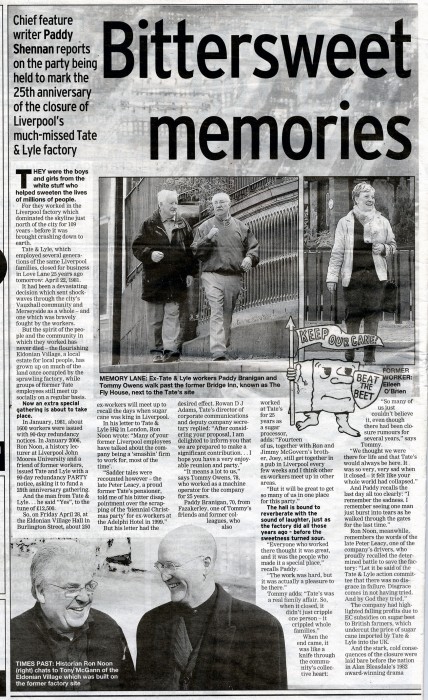
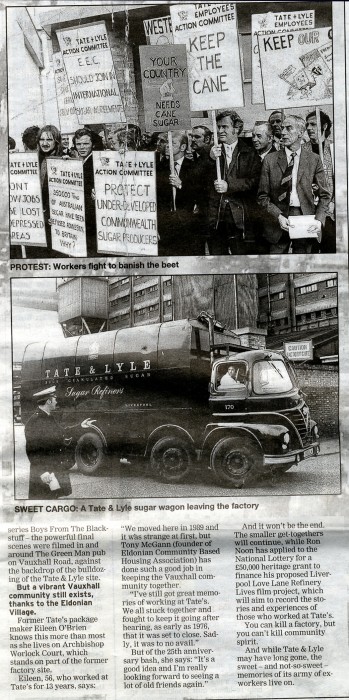
We’ll never forget you Paddy.
Liverpool, the Bajan sugar Revolution and the era of the Sugar Standard
Written by Ron Noon at 10:37 on Monday, December 29th 2008
“The reawakening of Liverpool at the end of the 17th century is partly due to the prosperity of our sugar trade with the West Indies, and partly to the profits made in the slave trade.”
In the middle of the seventeenth century a small tropical island in the Caribbean became the site of a revolution in the production and trade of a commodity that although now ubiquitous, was then an exotic luxury for which Europe had an insatiable demand. Mankind had done without sugar for millennia but the concertinaed changes on Barbados, an island smaller than the Isle of Wight, had ripple effects reaching from the Caribbean across the Atlantic to a small insignificant fishing village in the North West of England. For over four centuries after King John’s Charter of Incorporation in 1207, Liverpool had failed to reverse the trading dominance of nearby Chester.
Sugar’s rate of diffusion from Papua New Guinea where the cane was first cultivated 9000 years ago, was unimpressive and Henry Hobhouse summed up its commercial travelling before Barbados, as “a mere pinch per head for the whole of history”. By the 16th century however, this addictive condiment was a main marker and emulator of wealth and conspicuous consumption. In the post Columban era it became known as “white gold”, the basis of one of the first truly international industries. The “Sugar Revolution” in Barbados and the Caribbean in the middle of the seventeenth century and the “proto-agri-business” of plantation production, increased output to satiate the Old World’s seemingly insatiable demand for a product that rapidly moved along the value added chain, from medicine, spice and condiment, to decorative substance, preservative, sweetener and eventually the food that changed the world of diet!
“The era of the ‘sugar standard’ lasted only 200 years, two centuries in which millions of human beings were sacrificed in its cause, far more of them, and more spectacularly, than those who died in the cause of the gold standard.” In terms of causation it can be seen that “the slave trade was the indispensable handmaid of the sugar industry”, and “the problem of organizing a regular and reliable supply of slaves became a major preoccupation of governments”. The voracious demand for slaves was exacerbated by the obvious failure of slave populations to reproduce themselves because of the appalling conditions in cane fields and plantation sugar mills. “Negroes were constantly required, and the difficult, dangerous and speculative business of importing them across four thousand miles of ocean became a trade second only in importance to that of sugar itself.” Hobhouse “guestimates” that “perhaps three quarters of all the Africans transported across the Atlantic, possibly as many as 15 million out of a total of 20 million enslaved in Africa, must be debited to sugar”.
So the superstructure of Europe’s sweet life was increasingly predicated on notorious plantations not beehives. They were the new cornucopias of fabulous wealth and fortune that yoked agricultural field and industrial mill together, and according to Professor Ralph Davis, my old university lecturer back in ’68 their expansion “bears a striking similarity to the technological revolution, which getting under way a century later, developed new consumption habits in English and foreign populations, with the cheap product of the machine”. Davis was not saying that sugar plantations were the same as steam driven textile mills, but in consumption terms there is evidence that they shared similar features.
Mintz in 1985 provided convincing evidence that this colonial proto-industry preceded the metropolitan variant but had not been accredited the importance it merited. “Scholars interested in the history of western industry quite predictably began with the artisans and craftsmen of Europe and the putting out shops that followed them, rather than with overseas ventures. It followed naturally that plantations were seen as by-products of European endeavour rather than as an integral part of the growth from shop to factory. But it is not clear why such preconceptions should interfere with a recognition of the industrial aspects of plantation development. It may seem a topsy-turvey view of the West to find its factories elsewhere at so early a period. But the sugar-cane plantation is gradually winning recognition as an unusual combination of agricultural and industrial forms, and I believe it was probably the closest thing to industry that was typical of the seventeenth century.” It certainly was but it was also irredeemably tainted by the blood of those African slaves.
Jane Longmore noted that “two voyages to Barbados in 1666 probably led to the establishment of the first sugar refinery” in Liverpool the following year, “by merchants who had reputedly left London after the Plague and Great Fire”. Metropolitan refineries in London, Bristol and Liverpool were the value added end of the sugar chain and the final means by which tropical sunshine was converted into “white gold”! That separation between mill and refinery reflected the technological and economic asymmetry between “core and periphery” and is still evident in the international sugar economy today.
“Establishing refineries in London, Liverpool, Rotterdam or New York, rather than in Jamaica or Mauritius” had advantages for the metropolitan centre that stopped slightly short of winner takes all! “Sugar-cane factories work for only a few months in the year – after the harvest – and refineries dependent on local factories for supplies of raw sugar might find themselves idle for much of the time. They need large supplies of coal or other fuel and plenty of water neither of which is usually available in cane-growing areas.” Port refineries like Love Lane were sourced year round with cane supplies and unlike sugar beet production as it developed in Britain in the twentieth century, it was never seasonal. What went on in the Lane was a highly sophisticated laundering, purging and refining process with considerable investment in fixed plant and equipment. Metropolitan refineries according to Aykroyd were “temples of applied science” with very little that could be termed “natural” about their production processes.
Sucrose is still made of blood
Written by Ron Noon at 22:31 on Friday, December 26th 2008
This was written in August 2007
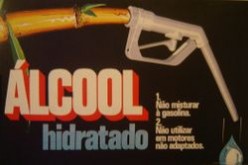
Contained in prosaic packets of sugar is a history tainted not only by the blood of African slaves but the blood of Haitians in the Dominican Republic today and Brazilians in the land of Lula da Silva. Sugar cane is an annually re-generable crop whose end product, (just like beet, the inferior and uglier alternative sucrose source), not only hooks billions to its saccharine food uses but car engines to its non-food usages. It has always been an intensely political product and now into its seventh century of global expansion, it makes oil seem a relatively new kid on the politics block.
But on the first of June when the Guardian published an essay by the Brazilian Prime Minister entitled “The wonder of sugar cane” my thoughts as an inveterate sugar buster were that hype had gone too far and lessons from history were being ignored. Lula da Silva extolled “energy cane”, the exciting bio-fuel that drives flex-fuel cars in Brazil, but camouflaged the neo-slavery conditions under which it is produced in some parts of that vast country. My lecture notes will now have added contemporary resonance on Slavery Remembrance Day not simply because of the bicentennial of the abolition of the British trade in human cargo.
Slavery in the era of the “Sugar Standard” was the indispensible handmaid of the latter which tragically is being produced in conditions that evoke the sounds of the Mayordomo’s whip. According to historian Henry Hobbhouse, perhaps three quarters of all the Africans transported across the Atlantic, “possibly as many as 15 millions out of a total of 20 million enslaved in Africa, must be debited to sugar”. Unsurprisingly Con sangre se hace Azucar was a phrase used by Cuban planters in the 19th century but the past ought to be another country and that phrase little more than an evocative museum mantra today.
What is still happening in Brazil and the recent experiences of a Belgian priest on the island where Toussaint L’Overture led a successful slave revolt against the mighty French Empire at the end of the 18th century, deny historical closure. Having vociferously spoken out against the proprietors of the sugar refineries in the Dominican Republic, Pedro Ruquoy was relocated by the church in 2005 for his own safety.
“For more than 10 years I have had the opportunity to share the life of the cutters of sugar cane who live like slaves in the huts strewn among the fields of sugar cane. My last months in the fields were very extreme: my face appeared daily on national television where I was presented as public enemy number one of the Dominican homeland, I was the object of an unprecedented slanderous campaign and the churches where I celebrated the Eucharist were attacked. All because I made the suffering of the sugar cane workers known, making known to the world that Jesus is still dying among the gentle reeds.”
That reed, which Pliny the Elder described as producing the taste of honey without the intervention of the bees, may be the most efficient collector of solar energy on the planet making the ugly mangel wurzel sugar beet precisely that, but its cultivation in many tropical cane growing areas is still blood stained. In Brazil President Lula was criticized earlier on this year for calling Brazil’s ethanol producers “national and world heroes”. On the very day Lula praised Brazil’s non-soccer playing world heroes the Labour Ministry accused a cane field owner of violating labour codes, of denying workers proper safety equipment, safe water and bathrooms as they toiled under the hot sun.
Sugar has long been the darling of the fast food and soft drinks industries because it aids overeating and “globesity”, but supremely ironic and profitable for Brazil is the added publicity about its potential, to assuage our fossil fuel addiction in the battle to arrest global meltdown. As world leader in this alternative energy source we have a lot more to learn from Lula’s eulogy to cane than technological transfers! The news that a plantation in the North of Brazil was recently raided and “ethanol slaves” released, suggests that history has a habit of not just repeating itself as farce.
Wealth not health has been the recurring theme throughout sugar’s infamous past and the bitter sweet song of fabulous wealth for “producers” and misery and sometimes death for cane workers in the field is a timely reminder for the 23rd of August that slavery like its quintessential crop are tragically not just historical topics!
A bitter sweet Christmas Story from the last millennium
Written by Ron Noon at 16:45 on Monday, December 22nd 2008
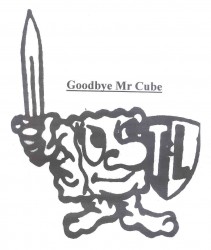
MR CUBE’S CHRISTMAS CAROL
This is a bitter sweet story about Tate & Lyle’s Liverpool pensioners. They were eagerly anticipating, the 1999 company supported “biennial” Christmas party, in the Britannia Adelphi hotel, only to be shocked and saddened by the contents of a letter from John Walker, the Managing Director of the Sugar Giant’s European Division. It announced that “regrettably, this reunion will be the last one held”. The final sentence, hanging ominously over the famous animated company cartoon of fifty years young, sword and shield brandishing Mr Cube, stressed how “this has been an extremely difficult decision to take but I hope you will understand that the company has to continually review and reduce its costs”.
Albert E Sloane, a sweet fightin’ man who had figured prominently in the ten year struggle to prevent the closure of the comically misnamed Love Lane refinery, the mother plant in Henry Tate’s sugar dynasty, was clearly very angry with this attempted “rationalisation”. He’d never lived his working life as a cost of production and yet History appeared to be repeating itself as another Tate & Lyle sponsored domestic tragedy for the feisty 77 year old. These thoughts flicked through his mind as he and the surviving boys and girls from the whitestuff assembled for their last Christmas Party, beneath resplendent streamers strung across the banqueting hall of a once quite magisterial hotel. Cold business logic was matched by the weather outside on Thursday December 2nd, and even when wrapped up in sugar coated management rhetoric the perception by the majority, who like Albert had devoted most of their working lives to this company, was of nothing less than scrooge like meanness of spirit. Smile it’s Tate & Lyle. No thankyou. This is Liverpool.
The closure in April 1981, not only obliterated a prominent landmark which had dominated the Vauxhall and Scotland Road communities just north of the city centre, but also the job prospects of Albert and so many others in that ageing labour force, who would never work again. That had not prevented them partying every other Christmas in the Adelphi, re-living their memories and stories of the world of work and increasingly friends that they had lost. Albert’s close mate John Maclean, wryly commented that not only did “Christmas come round every two years with Tates”, but “each time, absent friends meant that it got cheaper. We never thought they’d scrap it altogether”. Deja Vu. They never thought that the giant sugar refinery on the site of a former Maidens and ladies walkway, which at one time employed over three and a half thousand workers, would be scrapped. Unhappily on the threshold of the Twenty First century, the removal of company backing has irrevocably scuppered the vicarious but vitally important associational needs that the biennial Christmas bash made formal provision for.
Katie Moran, an eighty four year old former shop steward who had struggled alongside Albert and John in the campaign to save the Liverpool refinery, made a valedictory comment out of an entreating question. “But this is the parting of the ways, is n’t it, the last supper?” Katie who had been awarded the British Empire Medal for services to charity and trade unionism was clearly savouring the enjoyment of this last chinwag opportunity with her old pals. The sadness was tangible and an invisible funeral pall seemed to drape over the main hall as they trooped disconsolately out after their “last supper”. Later on that evening I sat in the pub opposite, listening to many of these wonderful workers reminiscing their very real history of Love Lane, a living history that surely deserves much more than tape recorders and sympathetic academics. The Tate’s pensioners packed “chocablock” into the Beehhive on Mount Pleasant St, evoked many images of warmer climes to help dispel the gloom and cold outside. The giant fibrous reeds of sugar cane that sway in the tropical breezes and sunshine of African, Caribbean, and Pacific, countries were once processed, refined and packaged by these scousers. “They knew each other when they were young, packing the bags which sweetened the nation’s tea. And they were sad that this was their final party together.”
Strange to reflect that at the beginning of the millennium sucrose was very much a new kid on the sweetener block compared with honey. In an even earlier biblical epoch it was a land of milk and honey and decidedly not sugar and spice. Eventually it was discovered that the “crystallised sunlight” from the cane produced its own taste of honey and without any intervention from bees it would develop into an agro-industrial process. The transformation from giant reeds to white sucrose which is now part of the “natural” architecture of processed foods even when demand for sugar packets is in relative decline, required a boiling, laundering, purging, and refining process that is quintessentially industrial. It had entailed the refined interference of the boys and girls in the Beehive that once worked in the romantically named Love Lane, and were now in this final gathering place in Mount Pleasant.
This public house provides a marvellously convivial atmosphere in a cosmopolitan city of the sea where skeins of interconnectedness have never stopped at the waters edge and where global relations and historic waves of inward and outward migration helped shape a distinct culture and way of life many years before the “isation” was tagged on to global to become the dominant metaphor of these so called post-modern times. “Strange that an article so sweet and necessary for human existence should have occasioned such crimes and bloodshed” was the valediction of Dr Eric Williams, Oxford don and one time Prime Minister of Trinidad. (Capitalism and Slavery 1944) His reminder of the moral stain on a taken for granted everyday commodity was conditioned by its association with the most infamous of all trades and Liverpool was stained by the fact that in the eighteenth century it rose to become the capital of the slave trade. That nefarious aspect of Liverpool’s history and its role in the African Diaspora ended 65 years before Henry Tate set up his then state of the art Sugar refinery in Love Lane.
On this party night towards the end of the long Twentieth Century there was no shortage of liquid means of sweetening the imagination and memory, including the obligatory tots of demarrarah rum. The best stuff to an afficionado of “rumbullion” is produced in the exotic Antilles, not in wet Fenland England where it’s actually impossible to produce rum from the ugly “mangel wurzel” sugar beet and its extracted molasses that stink of ammonia. Predictably the mood shifted and became one of terminal nostalgia. “We don’t need the Adelphi, just any old venue with a few pies and sausage rolls thrown in so we can continue to meet”, was the unanimous sentiment being expressed. But even in this buzzing and hospitable pub with the best old time juke box in the port, it would be an impossible stretching of imagination and catering to accommodate over 400 ex sugar cane workers.
As a partisan local labour historian committed to writing a history from below of the vainglorious struggle to keep Love Lane open, my subjectivity is partially eclipsed by what most decent outsiders would view as the crass insensitivity of Mr Cube’s company. This is after all a world leader in sugar and sweeteners, a transnational that not only started its life in Liverpool but always claimed to encourage a “family spirit” with its loyal employees. The recruitment policy had been that children followed parents into the “sugar mill” and so parallel to the Tate & Lyle dynasties were “hereditary” employees families where sometimes three generations would be working at the company stove. Today’s mismatch between company representation and perceived realities is not just the obvious fact that this decision is patently out of synch with seasonal festivities, but also with its own history of public relations and friendly Mr Cube image?
How ironic that exactly fifty years ago in December 1949, the animated sugar lump was reaching his apotheosis. The “disembodied, impertinent cartoon figure…with his huge eyes and a face able to depict any kind of emotion” was created by a former cartoonist with the Daily Express, St John Cooper. His creation in August was sponsored by Tate & Lyle and Aims of Industry, an organisation that worked steadfastly to help the company resist the much exaggerated threat of sugar industry nationalisation. By the end of the year the circulation and sales of millions of sugar packets containing Mr Cube’s messages and slogans was such that this sugar lump was a household name. Armed with a sword and shield to resist the socialist hydra, and with cold war sound bites that made Government ministers, especially Herbert Morrison, almost apoplectic with rage, the company’s brand image was transformed out of all proportion. “Mr Cube says ‘state control will make a hole in your pocket and my packet’”, and “Mr Cube says of nationalisation ‘Oh dear, dear! - Dearer’”, but the simplest and most effective was “Tate not State”.
All of this “propaganda” was amplified by newspaper column inches of free coverage! There was 1800 column inches recorded in the National press that end of year, as opposed to 200 in August. Intriguingly the question of how much a 1949 scale of national exposure would cost today, is not merely one of arithmetic and monetary adjustment. That sly insidious “if” world may be appropriate here, because Albert Sloane’s suggestion is of a cantankerous Mr Cube stripped of his sword and shield, wearing Scrooge hat and matching ball and chain!
It was all so different half a century ago both for the family firm of the merged Tate & Lyles, formed in 1921, and for a young shop steward working in the oppressive heat of the historic mother plant. After registering his vote for Clem Atlee’s Labour in India the proudly working class Mr Sloane returned to Britain to follow his father’s footsteps into a job which was recognised in the local community as “a job for life”. Working conditions did not stand out as particularly good, indeed the purging, processing and refining of raw sugar cane was always an unrelentingly hard taskmaster. Nevertheless the zeitgeist in the Lane was paternalistic, and by constantly promoting the culture of a ‘family like company spirit’ Tates was perceived outside as actually being very proud of its reputation of looking after its workers. Before the era of faceless accountants and outsiders in the boardroom, “wannabee family executives” had to experience going through the sugar mill and learning the production side of things alongside ordinary employees before they could advance their careers.
An amusing cameo scene set in Love Lane at the time of the nationalisation threat when the company was exhorting employees throughout the country to come up with suggestions to add spice to Mr Cube’s campaign centred around the witty and irreverent Mr Sloane. The man who thirty years later was one of the most prominent in the struggle to keep the plant open suggested that “Tate & Lyle have made a pile, give it to the rank and file”.
Frank Till who joined the company in 1941 and rejoined in 1947, after service in the RAF, expressed it this way. “The people who run Tate & Lyle now are just names to us. Previously we knew them - Saxon Tate, Colin Lyle, Nicholas Tate, we knew them all, but not now. They are unidentifiable people and of course we are unidentifiable to them.” In fifty years there has clearly been a transformation from family firm and one time imperial sugar company possessing sugar plantations in the Caribbean and Africa, to a Giant services and consultancy transnational. Although core refining activities were downsized in the seventies so as to expand into “speculative” commodity transactions and new profit areas, including even an ill timed venture into skateboards, Tate & Lyle is now a Group well equipped to capitalise on the growth potential of a global industry of sweeteners and starches. Demographics and expanding food and non food uses will continue a global success story of at least six centuries that makes the products of Bill Gates seem pre-pubescent. Except in one sense. Tate & Lyle made a pre-tax profit of only £223m in the 12 months to last September but having now reviewed and eliminated the drain on finances caused by the Liverpool biennial Christmas bash Mr Cube is emblematic of a Group much better positioned to face the new challenges and profit potential offered by the coming Millennium.
By Christmas of 1949 Tate & Lyle had clearly perfected the arts of Public Relations and much to the chagrin of Clem Atlee, Mr Cube successfully dominated the anti-nationalisation campaign. His spiritual “father” was the President of the Group, the charismatic Lord Lyle, a close friend of the Opposition leader, Winston Churchill, and nicknamed by journalists as “Lord Cube”. The metamorphosis from a family firm into the financial community of transnationals has inexorably witnessed a withering away of local roots and loyalties.
Global perspectives and significant organisational and personnel shifts, have seriously compromised the Sugar Giant’s paternalistic image, at least in Liverpool. Up until this month though, the end of sugar cane time in April 1981, and the subsequent blighting of that inner city community, was viewed as the most dramatic consequence. But now it seems Henry Tate the wealthy entrepreneur and philanthropist has unintentionally bequeathed to the world a soulless global corporation that has now scrapped Christmas in his former sugar capital. The company decision to continue the tradition of delivering a Christmas hamper to its non-executive employees was the last vestigial relic of what had once been a local family firm. But as the barman in the Beehive called out the very last orders from the partying but increasingly dejected looking pensioners, that token gesture looked about as substantial as the froth on Albert’s pint of bitter.
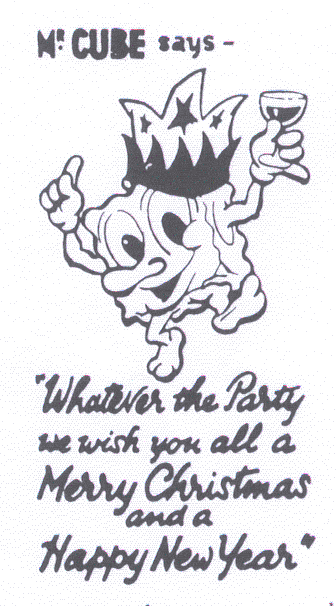
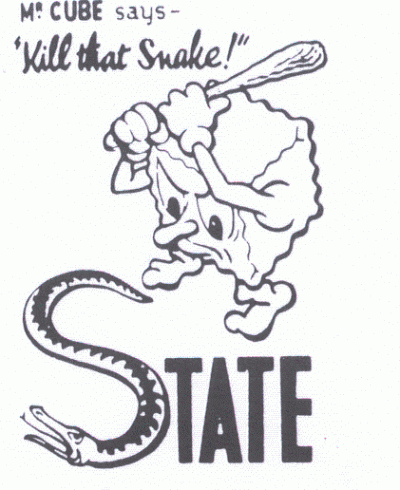
More pictures and interviews for 09 as well as a controversial conclusion about closure.
Written by Ron Noon at 11:16 on Saturday, December 20th 2008
I forgot in that summary to mention that the most exciting development will be the contributions of the children in terms of the work that they undertook earlier on this year and the drama that they produced on April 23rd called the Boys and Girls from the Whitestuff. That has been filmed and reported by the Liverpool Daily Post and it is a great credit to the teaching staff of Trinity. We will have that film and more about their school project on sugar and slaves on line. In the meantime I will blog on.
What financed those redundant refinery lives when Love Lane closed down on April 22nd 1981? Regional Aid and Ship Sales!
We have interviewed many who think Tates “was a great firm to work for” and the local management was often in the dark and very much on the receiving end of decision making from London headquarters. For many “down there” what was happening became little more than Merseyside’s local sideshow. Their brief was the international sugar economy and profit potential in any of five continents the Sugar Giant operated in.
From the reading and research I have undertaken there are two incontrovertible facts which have shaped my conclusions about closure. The first piece of evidence is that Tate & Lyle were the major recipients of regional aid between 1975 and 1981. That attention grabbing detail is verified by a document from the Planning Officer of the City Council, issued a few days after the 90 day redundancy notices had been issued and in the records that Albert and John gave to the Museum.
“Tate and Lyle have been aware of the problems of their refining operations for some time, and have successfully diversified into warehousing, commodity trading, distribution, shipping and speciality chemicals, inter alia. They were the largest recipient of regional aid in Liverpool over the period 1975/76 to 1979/80, receiving £3.95 million in Regional Development Grant and Regional Selective Financial Assistance.”
The second and equally incontrovertible evidence is that a couple of months after the closure of Love Lane the Lex Column in the Financial Times explained how “ship sales will cover the Liverpool redundancy costs”! Down to 1976 when trading was reorganised and “Albion Ltd” was dissolved, “profits made by the Bermuda subsidiary” of Tates Canadian subsidiary Redpath, “were reinvested to buy ships rented to a British subsidiary”! For a company that denied internal transfer pricing that is evidence of a pretty sophisticated financial policy and one that enabled ships that were originally bought through Bermuda based subsidiaries to be sold to help finance a massive closure in what the Merseyside Socialist Research Group described in the opening section of MERSEYSIDE IN CRISIS (1980) as “the Bermuda triangle of British capitalism”! Funny old sugar world innit? Anyway “transfer pricing” needs explanation but only after I’ve been into town to buy a few presents.
What is sugar?
Written by Ron Noon at 08:31 on Wednesday, December 17th 2008
“Our wish for sweetness runs old and strong. Bitter experience perhaps taught primitive man that sweet things were mostly safe to eat - but the instinct which preserved him in the jungle is slowly killing his modern descendants.” Hannah Wright ‘White Gold’ - and black consequences New Statesman 19.9.1980
It is now 28 years since that essay was published and what has changed in the crazy world of sucrose?
WHAT IS SUGAR? All edible plants contain in varying proportions, fibre, protein, fat, starch and sugar. All vegetarian and omnivorous animals including man, convert fibre and starch into sugar by bio-chemical means. Sugar is then made available in the bloodstream as a source of energy. Starch and sugar (in the form of fructose) occur in all fruit and vegetables and before the arrival of industrial cane and beet sugar, mankind managed well enough without refined sugar, which is pure or nearly pure sucrose. With the latter the stomach has less work to do and energy is assembled and used in a sudden sugar rush rather than slowly. The production of starch and fibre converting enzymes is inhibited once the body habitually gets its sugar requirements directly from sucrose, so the stomach finds it difficult to digest any accompanying starch and fibre. – The food processors take advantage of this and low fibre foods abound. This is the basis of what I call a “crowding out” thesis which can lead to vitamin and mineral deficiency. If you eat enough dietary fibre then there is no craving for sugar. “If”, as Graham Swift reminds us in Waterland is a sly insidious word!
The whole point about the history of “industrial” sugar is that wealth not health requirements have conditioned its growth and in fact the more recent PUBLIC HEALTH debate is the most serious threat to those hitherto guaranteed profits. The debate about sugar and health is ironically the biggest threat to the financial health of the powerful sugar lobby both here and in America. It is not going to lie down. Comments by “food faddists” prompt massive PR and dissimulation exercises to suggest that sugar will always be part of a healthy “balanced” diet! We even have a variation on that old theme of “s/he who pays the piper calls the tune”. It’s now called Affiliation Biased Science or ABS which has nothing to do with your braking systems.
ABS might also be conditioned by the need for “dissimulation” so that the total amount of SUGARS in foods is never known written in invisible ink! “If” people really knew the sweetener world that extends beyond sucrose then they’d not just talk about sugar but SUGARS.
IF you are scouring the ingredients list for added sugars, look out for the following:
• corn syrup - derived from maize (corn) starch. It’s known as High Fructose Corn Syrup or HFCS
• brown sugar
• dextrose - derived from sucrose
• fructose - found in fruits, but can also be made industrially from corn starch
• fruit syrups/concentrates - derived from fruit
• glucose
• glucose derived syrup - a mixture of sucrose and more complex carbohydrates
• golden syrup - made from evaporated sugar cane juice
• honey - a mix of glucose and fructose
• invert sugar - a mix of glucose and fructose
• lactose - derived from milk
• maltose - derived from barley
• maple syrup - produced from the sap of maple trees
• molasses - virtually unrefined sugar from sugar cane, with useful traces of vitamins and minerals
• sucrose - the chemical term for sugar
• treacle - less refined sucrose, with some traces of minerals.
OK NOW WE KNOW THAT THE QUESTION IS ABOUT SUGAR/S BUT WHAT ABOUT THIS FOR DISINGENUOUSNESS?
“Sucrose is a basic carbohydrate and has occupied a central position in human food for centuries. Sugar contributes to the pleasant taste and physical structure of many foods. The history of cane and beet sugar development and processing…show that sucrose has been an important agricultural commodity and food for centuries. Although the number of specific sugar products is more numerous in today’s world, refined sucrose is essentially the same today as in past centuries. From its formation during photosynthesis through its refinement to a high quality product, sugar is an essential ingredient in a wide range of foods and an important source of food energy.” Neil L Pennington & Charles W Baker (Eds) Sugar: A Users Guide to Sucrose 1990
“Gerry Hagelberg one of the world’s leading experts on sucrose economics describes what the “industrial” process of refining is about. “Though we speak of sugar factories, what actually takes place there is not a manufacturing process but a series of liquid-solid operations to isolate the sucrose made by nature in the plant.”
Sidney Mintz’s 1985 book Sweetness and Power:The Place of Sugar in Modern History is a magnificent read. He’s an anthropologist who went over to Puerto Rico in January 1948 to start this amazing study of a grass that has changed the world. “All the time I was in Barrio Jauca, I felt as if we were on an island, floating in a sea of cane. My work there took me into the fields regularly, especially but not only during the harvest (zafra). At that time most of the work was still done by human effort alone, without machines; cutting ‘seed’, seeding, planting, cultivating, spreading fertilizer, ditching, irrigating, cutting and loading cane - it had to be loaded and unloaded twice before being ground - were all manual tasks. I would sometimes stand by the line of cutters who were working in intense heat and under great pressure, while the foreman stood (and the mayordomo rode) at their backs. If one had read about the history of Puerto Rico and of sugar, then the lowing of the animals, the shouts of the mayordomo, the grunting of the men as they swung their machetes, the sweat and dust and din easily conjured up an earlier island era. Only the sound of the whip was missing.”
When we reflect on the sugar bateyes in the Dominican Republic today and the two films that have aroused so much controversy and conflict in the last 18 months, THE PRICE OF SUGAR narrated by Paul Newman, and THE SUGAR BABIES produced and directed by Amy Serrano, “only the sound of the whip” is missing!
Anyway back to the script: Sidney Mintz sums up the story of sugar in a few sentences.
‘In 1000 AD few Europeans knew of the existence of sucrose, or cane sugar. But soon afterward they learned about it; by 1650, in England the nobility and the wealthy had become inveterate sugar eaters, and sugar figured in their medicine, literary imagery, and displays of rank. By no later than 1800, sugar had become a necessity - albeit a costly and rare one - in the diet of every English person; by 1900, it was supplying nearly one-fifth of the calories in the English diet.’
There are several types of sugar. The ubiquitous “natural” product comes from a diversity of plants, and in the wider world of artificial sweeteners there is an extended variety of molecules and laboratories involved in commercial production. Historically sugar cane and sugar beet represent the two most important commercial members of the sugar and sweeteners family despite the recent easing of their hegemonic grip. They are however very different plants with distinct histories and temporalities although after processing and refining, the sugar produced from both is actually identical.
The cane thrives in tropical or semi-tropical climates, predominantly in the Third World, whereas sugar beet can only be grown in the world’s temperate and largely First world zones. “Sugar cane is a grass of the genus Saccharum which grows in the tropics, roughly between latitudes 35 N and 35 S. In certain places it grows outside that belt, but it is usually found within the area where palm trees grow.” Ironically, sweetening tea or coffee from a bowl on the table without knowledge of the packet it was in, would make it impossible to know where the granules had originated from. They could have originated in the exotic sounding Lesser Antilles islands where Christopher Columbus introduced the crop on his second journey to the Caribbean, or in East Anglia; from the sugar cane brandishing “its sword like leaves in the tropical sunshine” or the drab “mangel-wurzel” sugar beet in wet Fenland England. Beet sugar processing has now been around for nearly two centuries. Import substitution of the beet for the cane was given a major boost by the British blockade of trade with France during the Napoleonic Wars. Its production grew rapidly then throughout Europe in the nineteenth century. According to Mintz (and this is a key point when we reflect on the world of sugar today) it represented “the first important seizure by temperate agriculture of what were previously the productive capacities of a tropical region”. Despite advances in the wet milling of maize and the production of HFCS, (High Fructose Corn Syrup) the basic business fact remains that cane and its rival, beet sugar, are still the two most important sources of sweetness today.
So to repeat a recurring theme in these blogs, mankind did without this refined empty calorie for millennia. There is no biological need for a pure chemical that contains no protein, minerals or vitamins.
Mother nature’s laboratories continue that wonderful experiment in photosynthesis which unlike the Temples of Applied Science sponsored by the various sugar “associations” reflecting the Producer interests, provide natural sugar in combination with fibre and starches. As every nutritionist and concerned parent know however, fruit and vegetables are not sexy and unlike the achingly addictive “white stuff” come up against the very finite limits of their children’s stomachs. Perhaps this is another reason why the Cuban anthropologist, Fernando Ortez described sugar as “the favoured child of capitalism”?
Albert (Tod) Sloane: Sweet Fighter extraordinaire!
Written by Ron Noon at 10:26 on Monday, December 15th 2008

Albert is on the left of the photograph with his leather coat and fag in hand! John is on the far right (not his politics) looking up at the banner headline.
ALBERT E SLOANE
When I first met Albert I was faced with a formidable guy who was not sure where the four eyed, “Bamber Gascoigne”, university teacher, was coming from. Reassured by my roots and devotion to Everton FC, I quickly gained his confidence and more important than anything else, his lasting friendship. Nobody can fail to be impressed by this sweet fightin’ man. Some of his Anglo-Saxon embroidery of the English language may have to be tailored to the particular audiences, but “Tod” Sloane, as he is known, epitomises the free born scouser, the man who is as good as anybody else, and who nobody is better than. Mixed into this remarkable 86 year olds personality are the full range of emotions, the bitterness, anger, defiance and determination of a life long socialist to secure justice for the underdog, but also the sentimental man with a generosity of spirit and feel for those who are less equipped or prepared to stick up for themselves. His scouse humour and irreverence is infectious and easily explains why the machine minder from B shift who registered his first vote for Clem Atlee’s Labour in 1945, became the main focus of leadership and determined opposition to Tate & Lyle’s closure plans.
One of many cameo scenes that I’ve documented involving Albert was in the Liverpool Town Hall in February 1981. A meeting of workers representatives, Merseyside MPs, city and county councillors, and local Church leaders, had been called to the “blackamoored and elephanted” Town Hall to help organise resistance to the closure. Hailed subsequently as the “Congress of Merseyside” David Sheppard the Anglican Bishop of Liverpool described the mood of everyone involved in the struggle to keep Love Lane open. “There were moments when Archbishop Warlock and I were invited to go to meetings at the Town Hall and there seemed the greatest solidarity of all Liverpool interests in fighting to stave off this closure. There was a very good common feeling at this time.”
Albert as Chairman of the Action Committee was waiting on that cold February morning in the foyer of the Town Hall to welcome the invited dignitaries “as its dirty big fire blazed away”. One of the lads asked him how he was going to address such people of consequence when they arrived, and Albert’s retort, was “mind yer own business”! He recalls with affection and devilish humour what happened after most of the dignitaries had arrived, except Archbishop Warlock and the Anglican leader Bishop Sheppard.
“Ye see they’re all inside and the ones we’re waitin for is Sheppard and Warlock. I did n’t know what to call them like. But ye see me Ron, I speak from here, (me ‘art!), and ye have to take what ye get as the truth. Anyway he came into the building with a big procession, the monsooer like, yenno the fellah with the big mace, and I shouted, (bellows out laughing), ‘Hello Arch where’s the Bish’?”
The startled “Arch”, looked behind to the revolving doors, and apologetically explained, “oh sorry Albert, The Bish is following on soon”. Witty and irreverent, respectful but never deferential, these were some of the qualities that made Albert a natural rank and file leader. Merseyside despite Bleasdale’s efforts was still in the early 80s as factory after factory was closing down, the place, where “if you don’t laugh, you only cry” was a vernacular cliché. Albert was as fed up with that caricature as Bleasdale, and determined that everyone should see the tracks of the unemployed workers tears.
Albert’s an extraordinary “ordinary” man that will defiantly deny that he was more important in the organised resistance than all the others threatened by the sack and a longer dole queue. In one sense he is right. His story like that of so many other exceptional “ordinary” boys and girls from the whitestuff, that gave Tate & Lyle such loyalty and dedicated service has to be rescued from the “enormous condescension” of those who write British history with the majority of the Brits, and scousers, left out!
........................................................................................................................................................................................
Here’s a picture (or two) of Albert’s pal John on the 20th annniversary of Love Lane’s closure.
